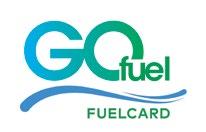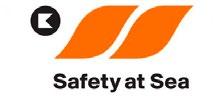INSIDE: AMERICA'S CUP
+ JO ALEH + CONRAD COLMAN + MOTH WORLD CHAMPS + STOCKING YOUR GALLEY + WHAT'S IN A BOAT NAME? + HOW TO HOST A BIG REGATTA

INSIDE: AMERICA'S CUP
+ JO ALEH + CONRAD COLMAN + MOTH WORLD CHAMPS + STOCKING YOUR GALLEY + WHAT'S IN A BOAT NAME? + HOW TO HOST A BIG REGATTA
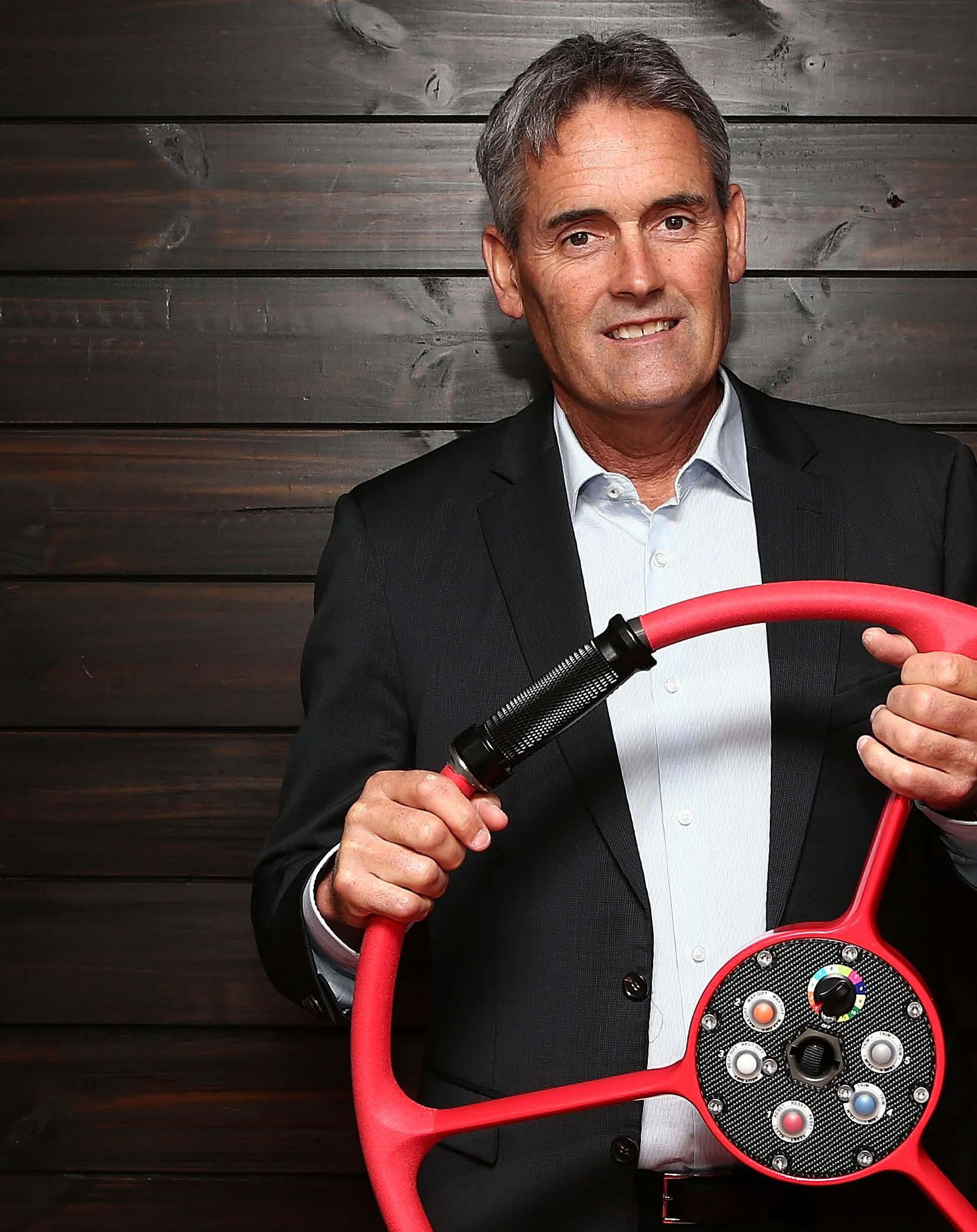
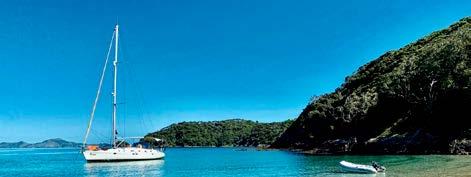
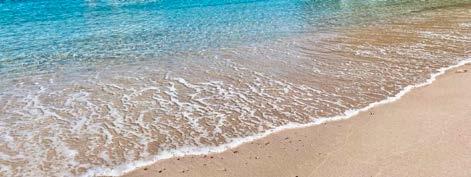

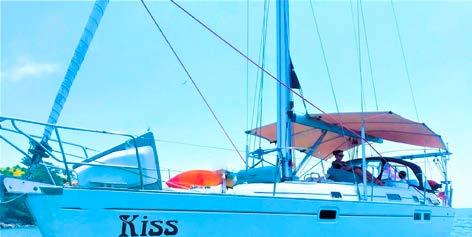

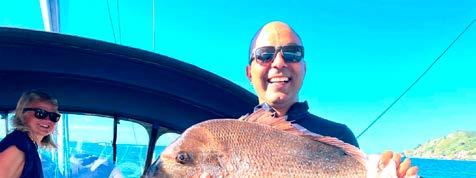



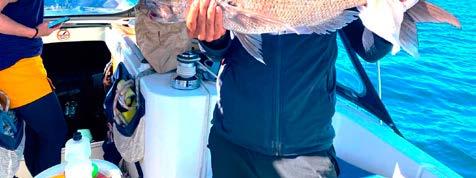
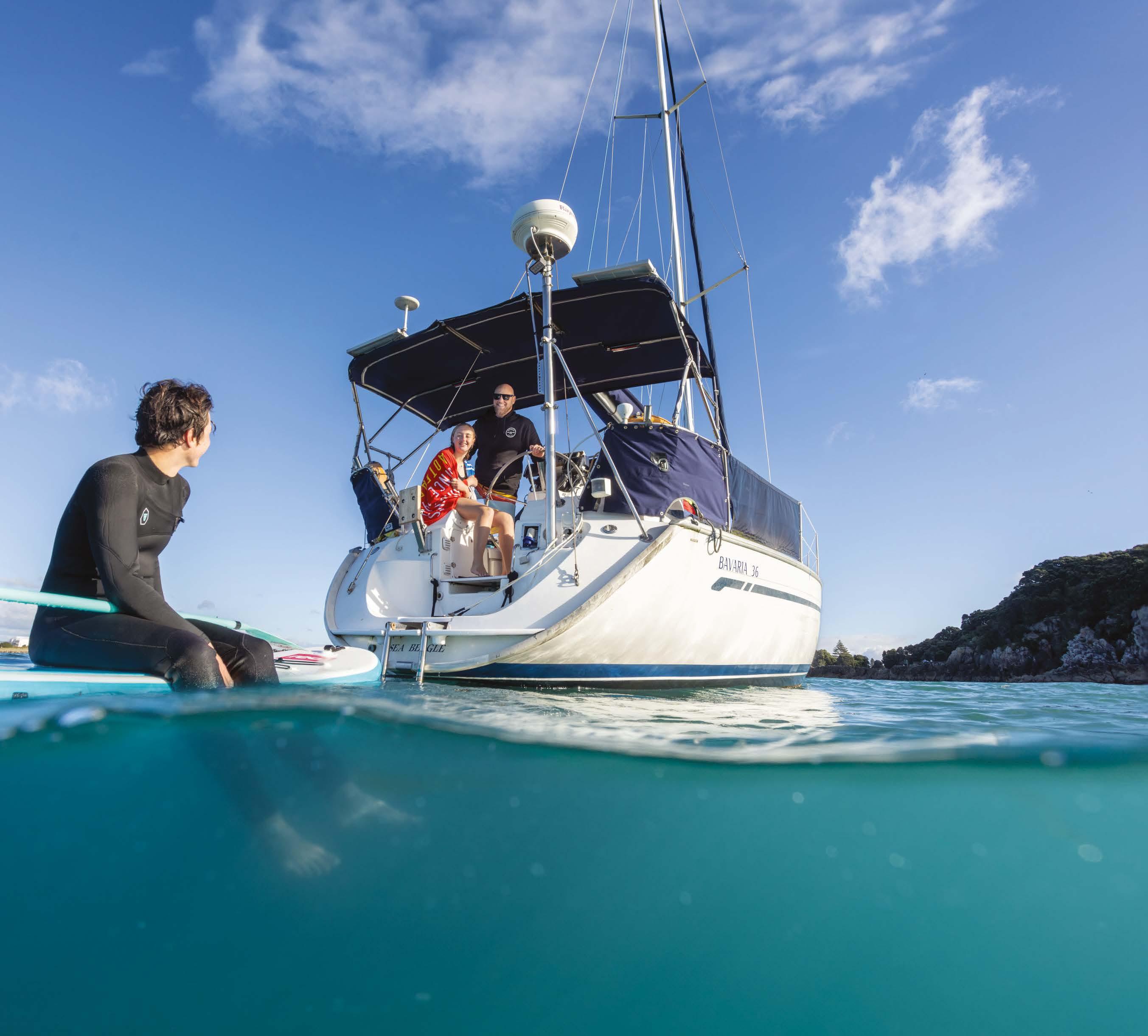

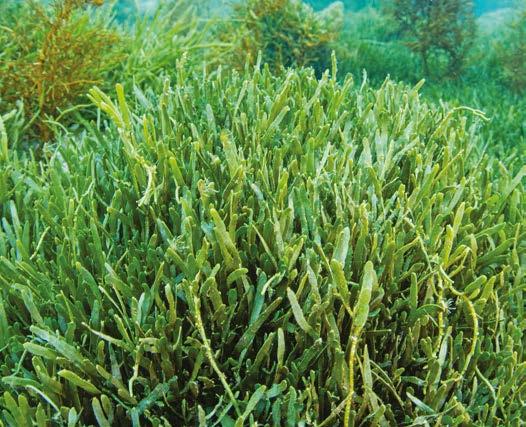
Exotic caulerpa – check your gear and anchor
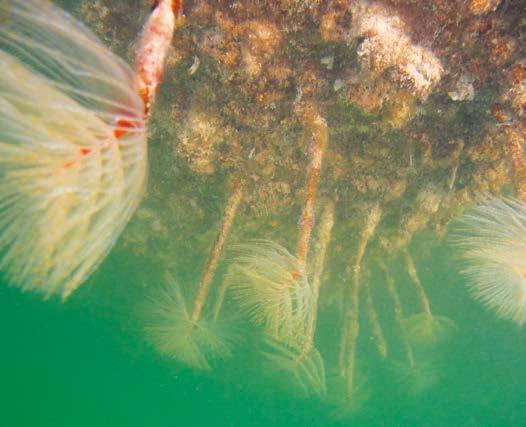
Mediterranean fanworm – keep your hull clean
Several invasive marine species get spread when boaties accidentally shift them. We know this from spread patterns.
Over the years there’s been a lot of talk about hull fouling – and that’s still something that needs to be managed to keep your boat moving well and avoid spreading invasive species like the clubbed tunicate and Mediterranean fanworm.
But the arrival of exotic caulerpa in northern waters has highlighted the threat of invasive seaweeds that can spread as fragments.
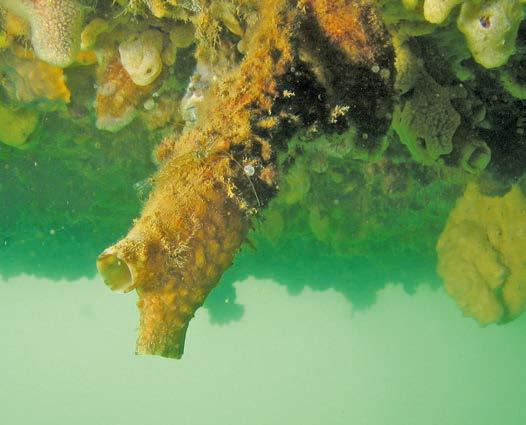
Clubbed tunicate – keep your hull clean
These get caught up on your anchor, anchor chain or any gear that goes down near the seabed, like fishing or dive gear. So now we’re asking, before you move during a trip, please check your gear and anchor for any attached seaweed. Remove it, contain it (possibly bag it) and dispose of it in the rubbish onshore.
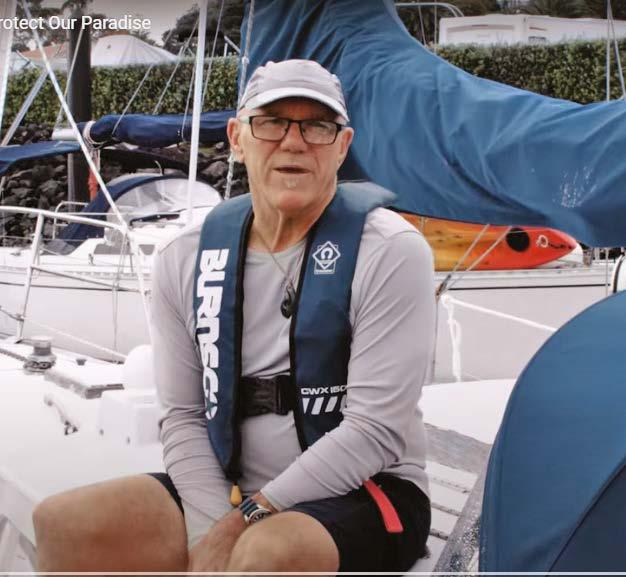
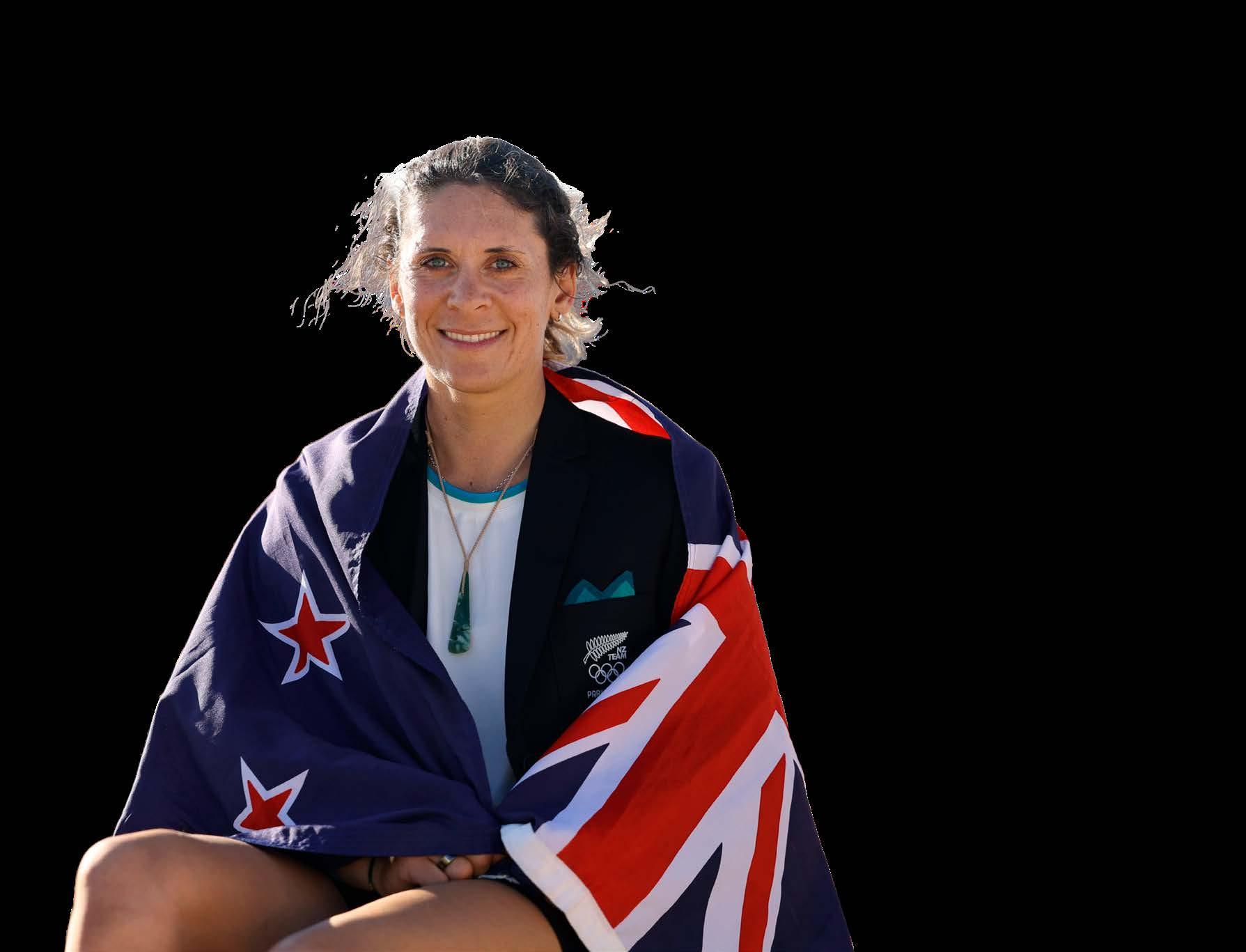
Next generation of 49er stars
Jo Aleh’s Olympic swansong
37th America’s Cup: How Auld Mug was won
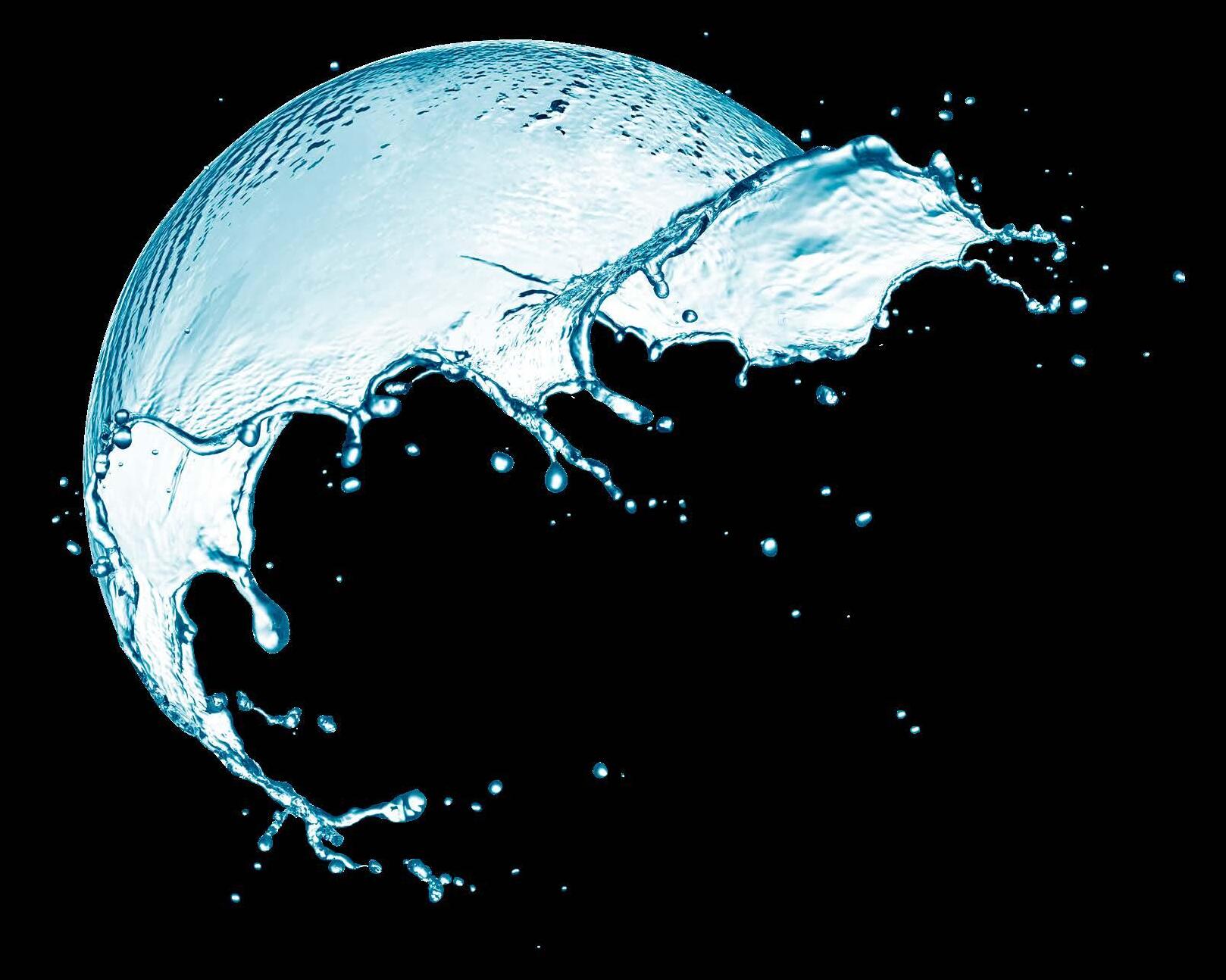
Games boost for young talent
Kiwi’s world record jump
2024 Moth world championships
Globetrotter: Conrad Colman
From the sail loft: Josh Tucker
Data driving our champions
Family affair in Barcelona
Inside the Mackay Moth
NZL Sailing online shop
Performance on a plate
How to stock your galley
Radix Nutrition

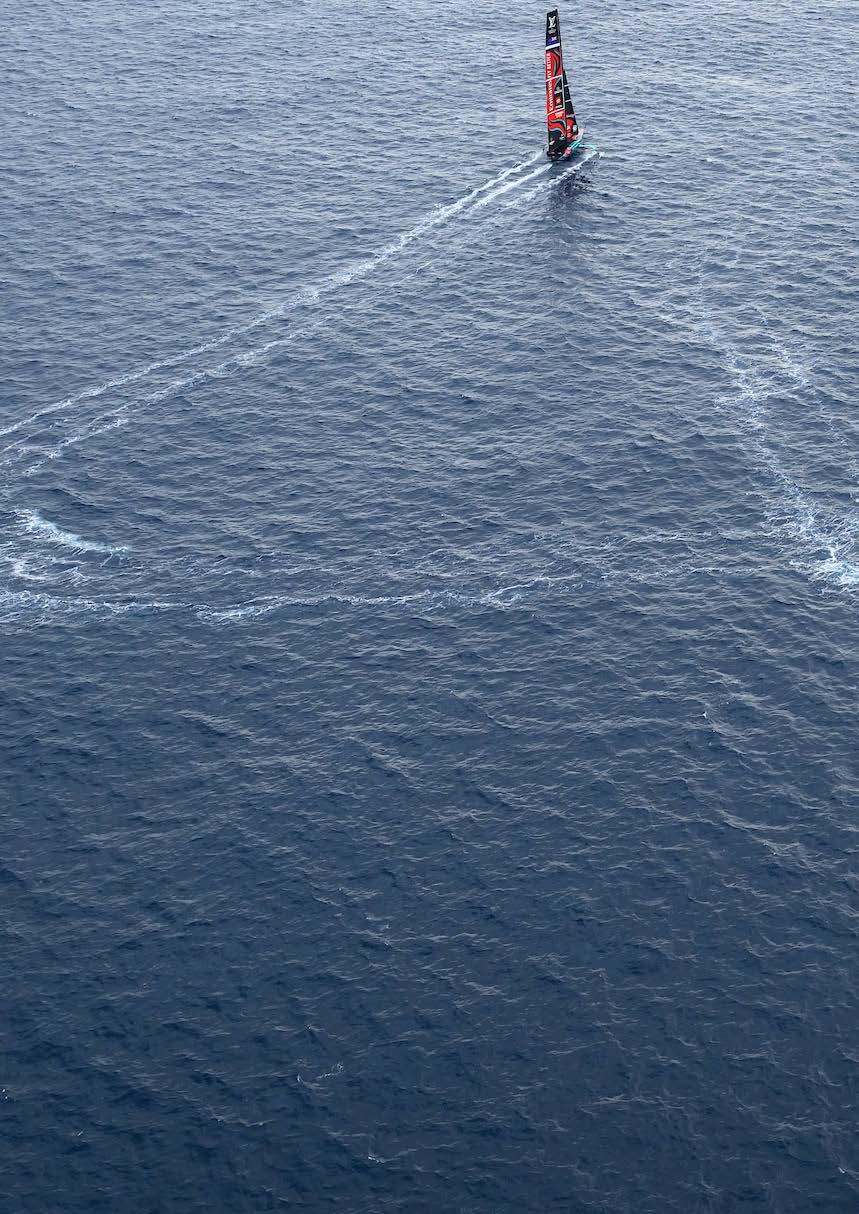
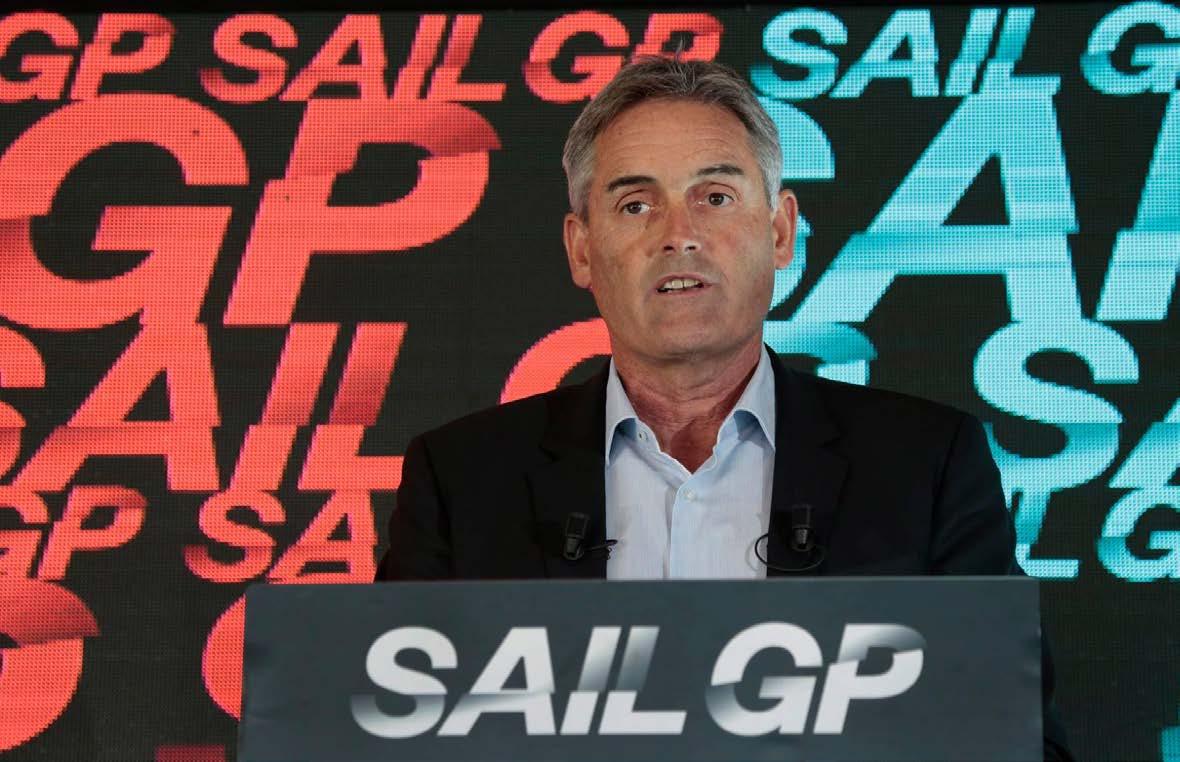
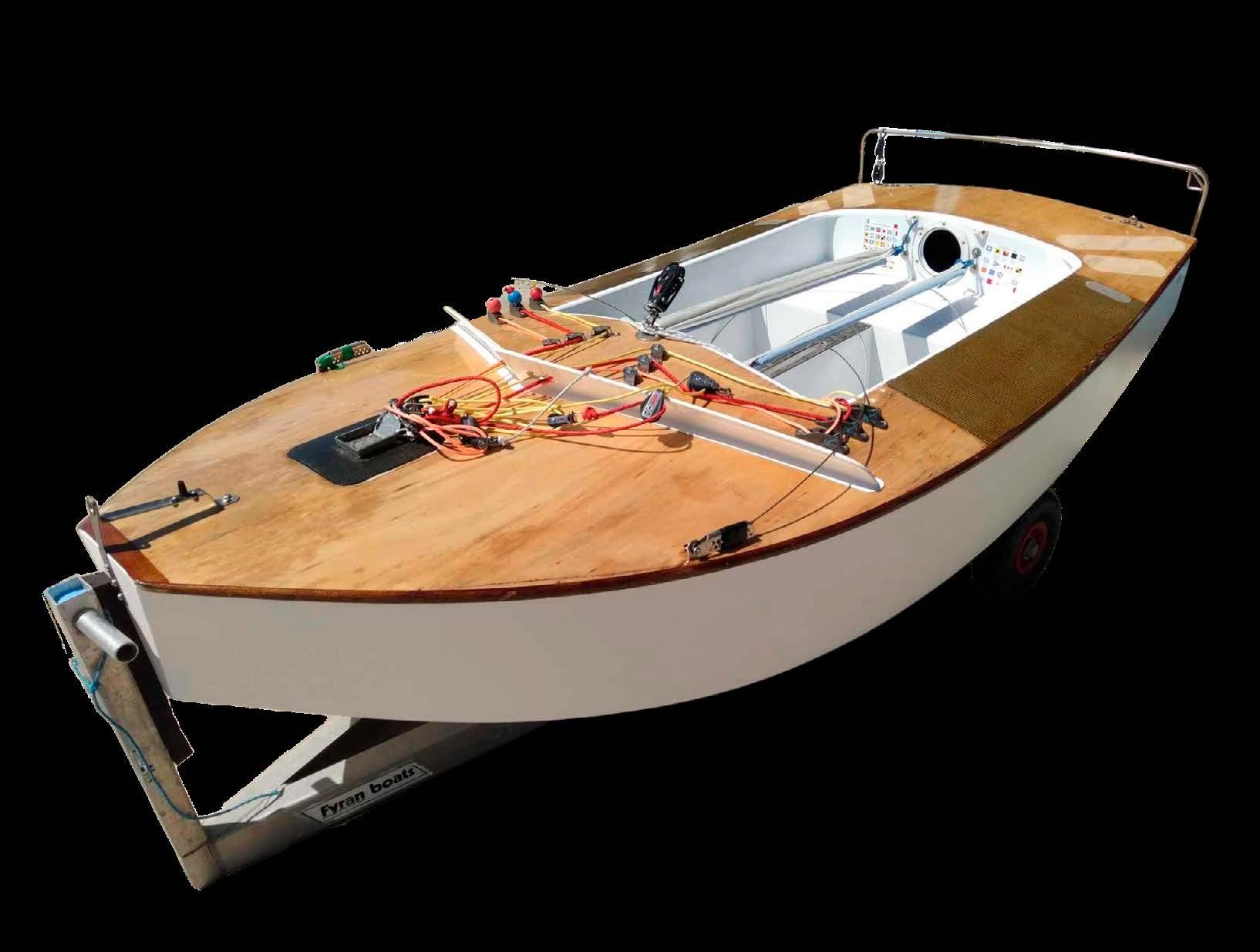

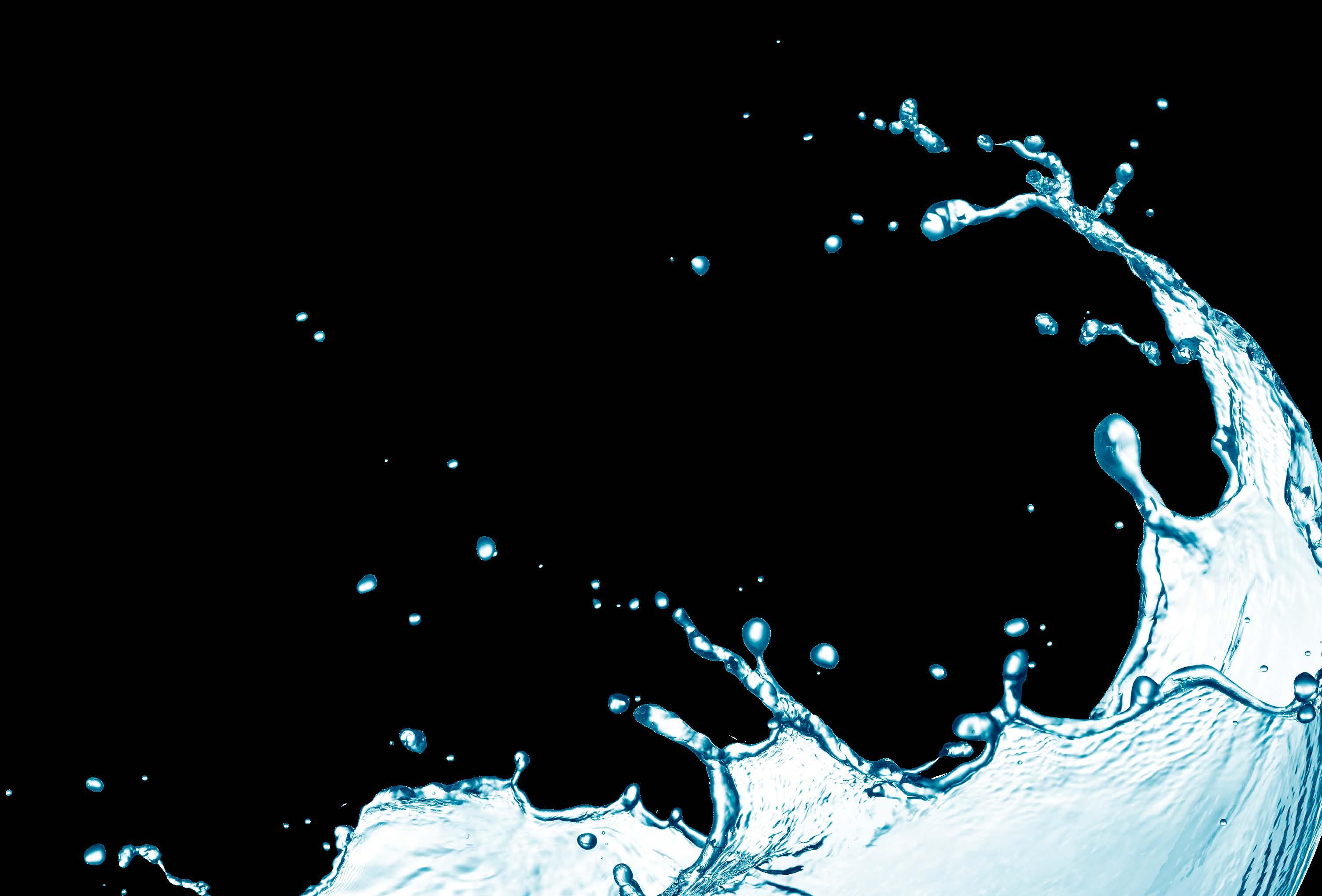

EDITOR
@YachtingNewZealand
@YachtingNewZealand
CONTRIBUTORS
Niall Anderson, Kathy Catton, Erica Dawson, Ian Gardiner, Wayne Holdt, Suzanne McFadden, Kirsten Moratz, Kelly Mulcahy, Ian Stewart, Josh Tucker, Hayden Whitburn.
EDITORIAL
Eduan Roos
eduan@yachtingnz.org.nz
ADVERTISING
Angela Jordan angela@yachtingnz.org.nz
YACHTING NEW ZEALAND
4 Fred Thomas Drive, Takapuna, Auckland 0622
YBQ is published quarterly by Yachting New Zealand.
Cover photo: Getty Images
Few people in New Zealand sport have divided opinion more than Sir Russell Coutts, but there’s no denying his SailGP has revolutionised the industry.
One of New Zealand’s most decorated sailors, he has rarely flinched at a challenge – he was chastised for leaving Team New Zealand to sail for America’s Cup competitor Alinghi in 2000, only to win the Auld Mug with the Swiss syndicate three years later.
Since its debut season in 2019, SailGP – the brainchild of Coutts and American businessman Larry Ellison – offered something unique. A grand prix-style sailing competition, using one-design F50 foiling catamarans in a mix of fleet and match races, it openly shared technology among competitors, held regattas across the world, and has had spectacular wing collapses, flashy grand finals and milliondollar prize money.
Yes, other sailing events stop the nation: the America’s Cup, through its unrivalled history, continues to capture the imagination of the sailing world, as it did again over the last few months.
Emirates Team New Zealand has established itself as a leading sporting brand, and the team’s three-peat in Barcelona will go down in Kiwi lore as one of our finest moments. There is also the Olympic Games, for many sailors the pinnacle of the sport, and it was remarkable to witness how Kiwis again rallied around the New Zealand Olympic team in France in July and August and celebrated our double medal success.
But these events happen only every three to four years, while SailGP has managed to wow fans – sailing and non-sailing, ticketed or following on television – in a way that was almost unimaginable five years ago.
It has ensured our sport remains part of the conversation year-round and has provided another pathway to professional sailing for many New Zealanders.
As Coutts explains in the cover story (p.58), much of the series’ success is down to deliberate efforts to put the fan at the centre of decision-making – making sailing more appealing in a market brimming with fast-paced edge-of-yourseat entertainment. In the interview, he also canvasses a wide range of other topics, including the challenges and opportunities for many of our yacht clubs.
These challenges and opportunities are also a key focus of Yachting New Zealand’s strategic priorities for the next four years, which chief executive David Abercrombie and national sport development director Raynor Haagh have been sharing during club visits across NZ over the last months.
These visits follow a few months after the results of the latest Voice of the Participant survey again highlighted the importance of yacht clubs in their wider communities.
This edition of YBQ has many examples of this – like the history of Nelson Yacht Club’s RŪNĀ journey (p.76), club members’ testimonials of the great work done by our NZCT regional development managers (p.62), and Kathy Catton’s piece on family dinghies (p.70).
There is plenty more to get stuck into, including features on Jo Aleh (p.16), Conrad Colman (p.36), and columns by renowned sailmaker Josh Tucker (p.42) and Erica Dawson (p.54), one of our newest Olympic medallists.
They are stars in their fields, who all share a love of sailing and a journey that started at a healthy, vibrant yacht club.
I hope you enjoy the read as much as the team did putting it together.
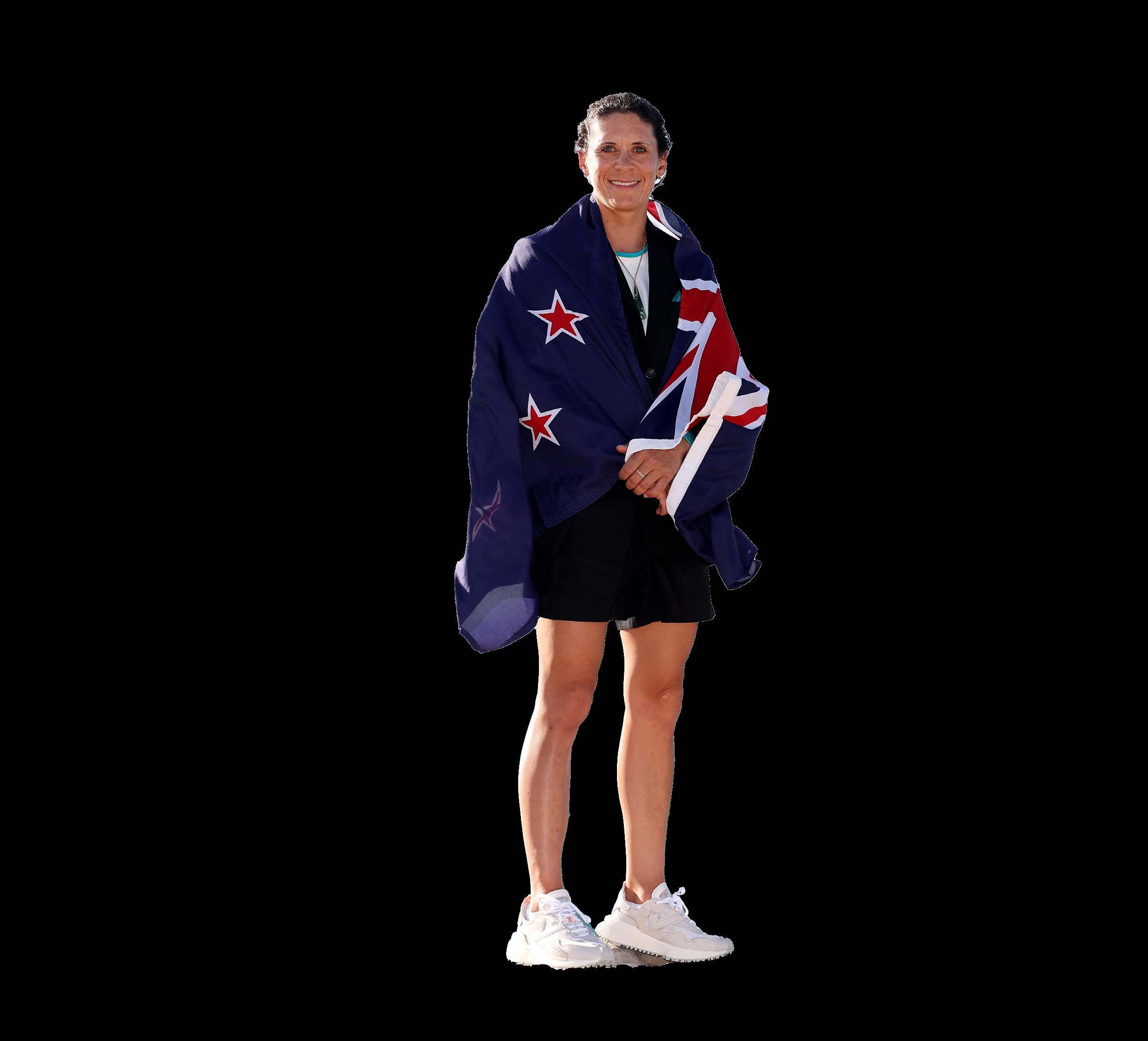
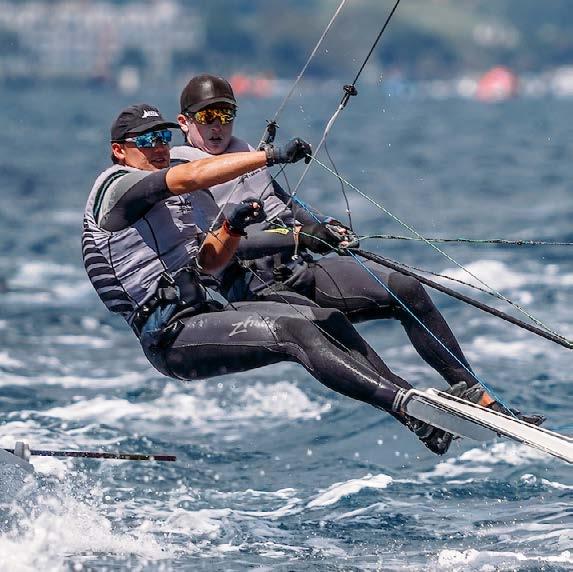
Meet our next generation 49er crews 14
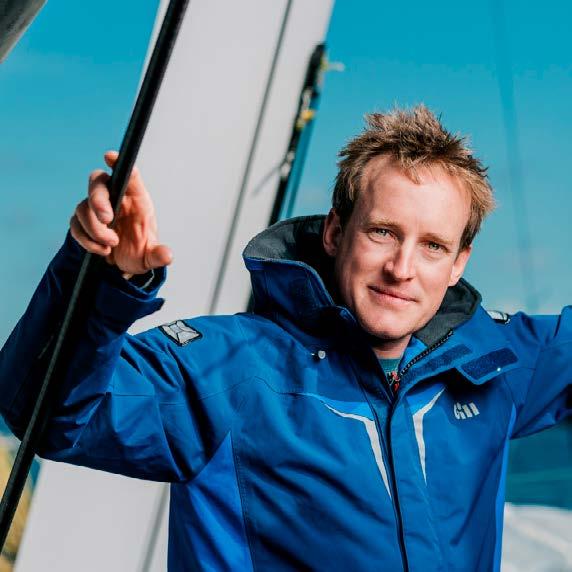
GOING IT ALONE
Conrad Colman in Vendée encore 32
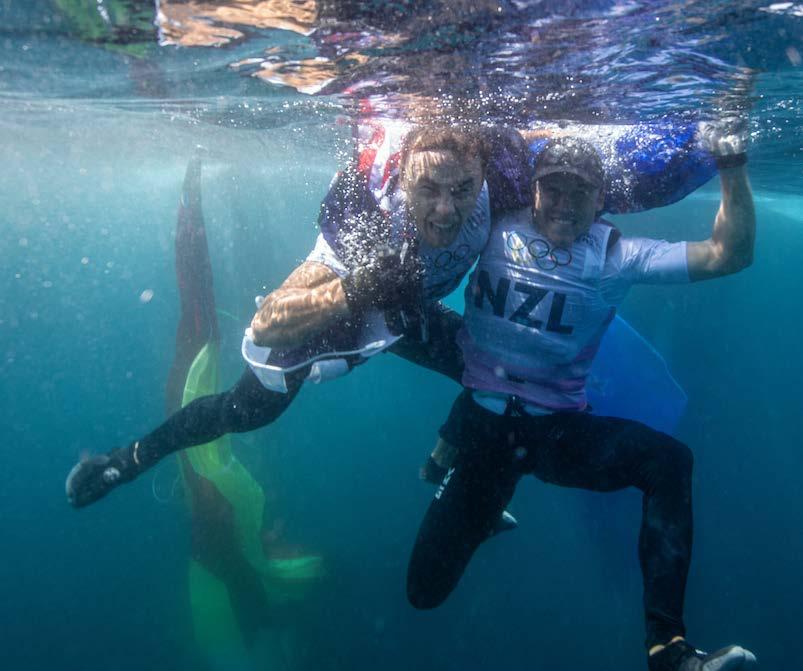
We take an inside look into how four Kiwis made history – and their childhood dreams come true – with their medal triumph at the Olympic Games in France.
Adream that began with an exchange of messages between two young Auckland sailors seven years ago came true on the waters off the Marseille coast in early August when Isaac McHardie and Will McKenzie won an Olympic medal for New Zealand.
The pair crossed the finish line in the men's skiff (49er) medal race in third place to claim silver, with teammates Micah
Wilkinson and Erica Dawson winning bronze in the mixed multihull (Nacra 17) six days later.
It capped a successful Olympics for New Zealand, improving by one on the medal count from Tokyo in 2021.
The NZL Sailing Team achieved four further top-10 results – from Josh Armit (fourth, men' s windsurfing), Tom Saunders (seventh, men's dinghy), Jo Aleh and Molly Meech (seventh, women's skiff), and Veerle ten Have (10th, women's windsurfing).
The “McKiwis”, as McHardie and McKenzie have been dubbed, started the double-points race in the bronze medal position with seven teams in the hunt for gold. They had two attempts at the medal race abandoned the day before due to light breeze – once while in the gold-medal position.
They eventually finished behind Spain's Diego Botin and Florian Trittel overall and though it wasn't the top prize they had aimed for at the start of the day, they were understandably delighted.
"It feels amazing. We always knew we could achieve it, but there were so many good teams out there. To win a medal for New Zealand is a dream come true. We've both been dreaming of this since we were little kids. We're just so stoked," McHardie said.
They got off to a good start in a nervy finale, trailing the Spanish for most of it before surrendering a spot to the Dutch late.
"To start with, I was pretty calm, but at the last top mark, that's where I started to think, 'let's just get this boat through the finish line without any drama,'" McHardie said.

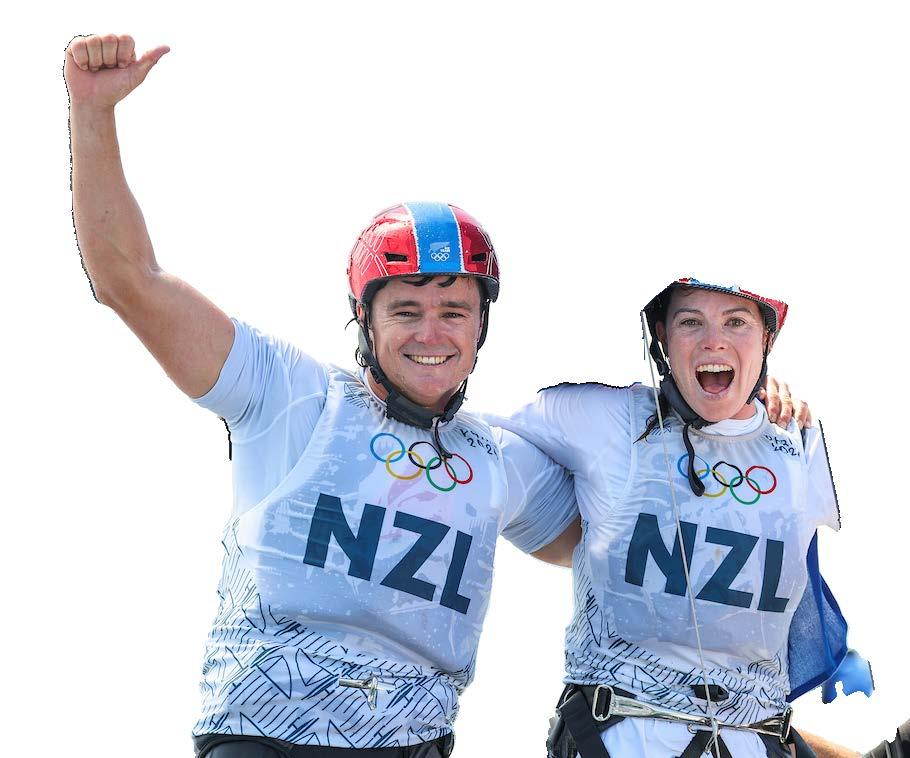
"We didn't want to get too far ahead of ourselves. We were just trying to sail a clean, well-executed race. The Spanish got away, but we knew there was plenty of work to be done, so we just kept chipping away. By the second top mark, we probably could have stayed ahead of the Dutch, but we knew the numbers and we just wanted to keep out of trouble and secure the silver," McKenzie added.
The pair celebrated by jumping off their boat and celebrating in the water with the gold medallists.
Soon after, they were greeted by the rest of the New Zealand sailing team on the beach – something they agreed "will stick in the memory for a long, long time".
"Will and I started sailing together about seven years ago when we had both just split from our crews at the time. We exchanged a few messages and then decided to give it
a crack. The rest is history," McHardie said. "We've been working on this for seven years, and to now bring home a silver medal for our country is incredible. We've both wanted this for a long time."
Their success means New Zealand has now won a medal in the men's skiff event for the last four Olympics, with Peter Burling and Blair Tuke winning silver in London in 2012, gold in Rio de Janeiro
four years later, and silver again in Tokyo.
They've been a big influence on the careers of McHardie and McKenzie, with Tuke one of the first to congratulate them with a phone call from Barcelona, where he and Burling were preparing to defend the 37th America's Cup.
"Pete and Blair have been incredible role models for us, and they have been happy to share information and advice whenever we've needed it," McHardie said. "They've been the benchmark for 49er sailing for the past decade, and to be able to build on their legacy is an honour. To have them in our corner is incredibly special. They've been a big part of our process."
McKenzie said the entire team appreciated the support of Kiwis in Marseille and back home.
"Isaac and I can take the glory, but there are so many people behind us who have
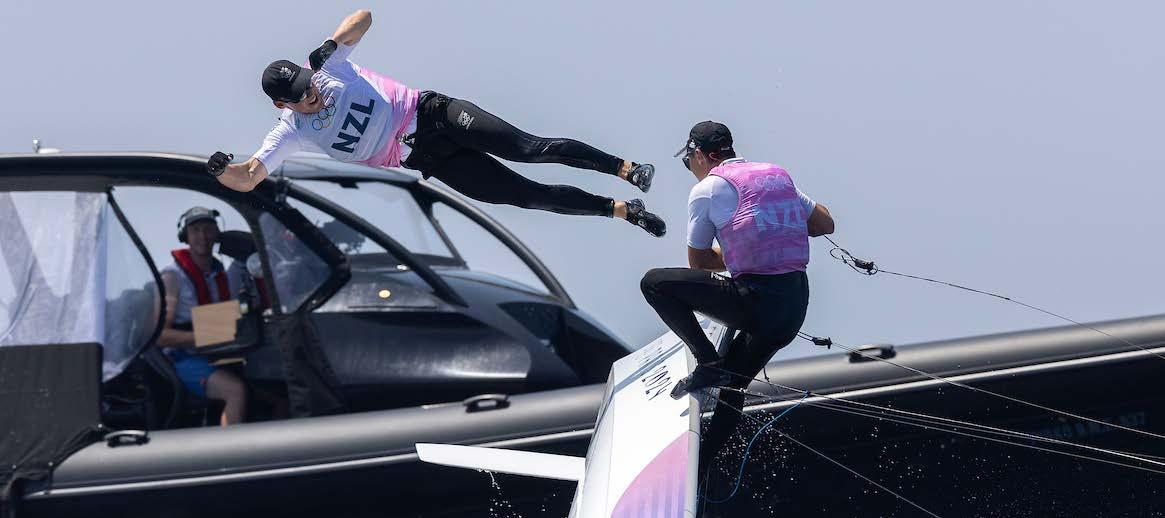
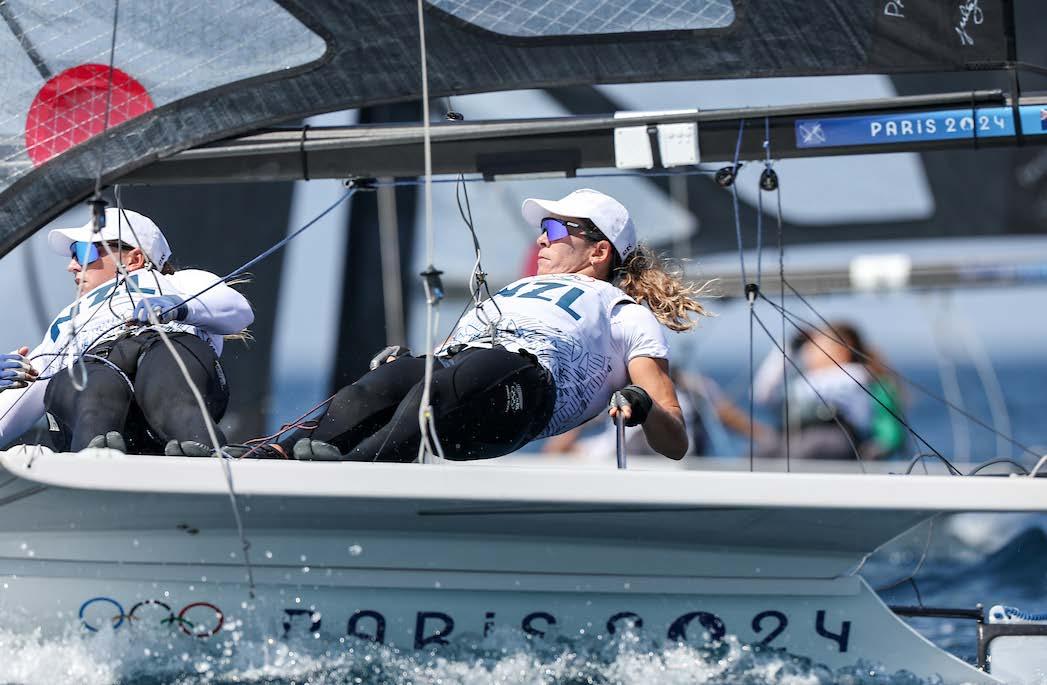
played a big part in our success – especially our coach Matt Steven, who's done huge things.
"To everyone who supported us, thank you. We couldn't have done this without you."
Wilkinson's and Dawson's medal, meanwhile, broke a 36-year drought – and while it didn't happen in quite the way they had hoped, securing the coveted silverware only a few months after their campaign seemed to be running out of puff faster than the Marseille summer made their achievement more special than they had ever imagined.
The crew finished third overall, crossing the finish line in eighth place in their medal race, which was sailed in marginal conditions.
Yet what the race lacked in breeze, it more than made up for in drama.
The Kiwis, who were fourth overall heading into the double-points final, needed to beat the British crew of John Gimson and Anna Burnet to win bronze,
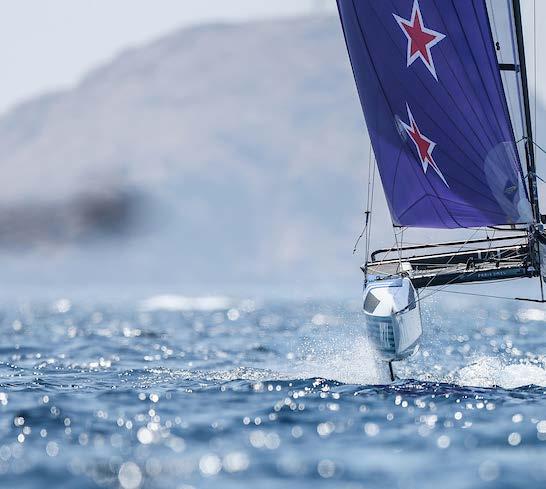
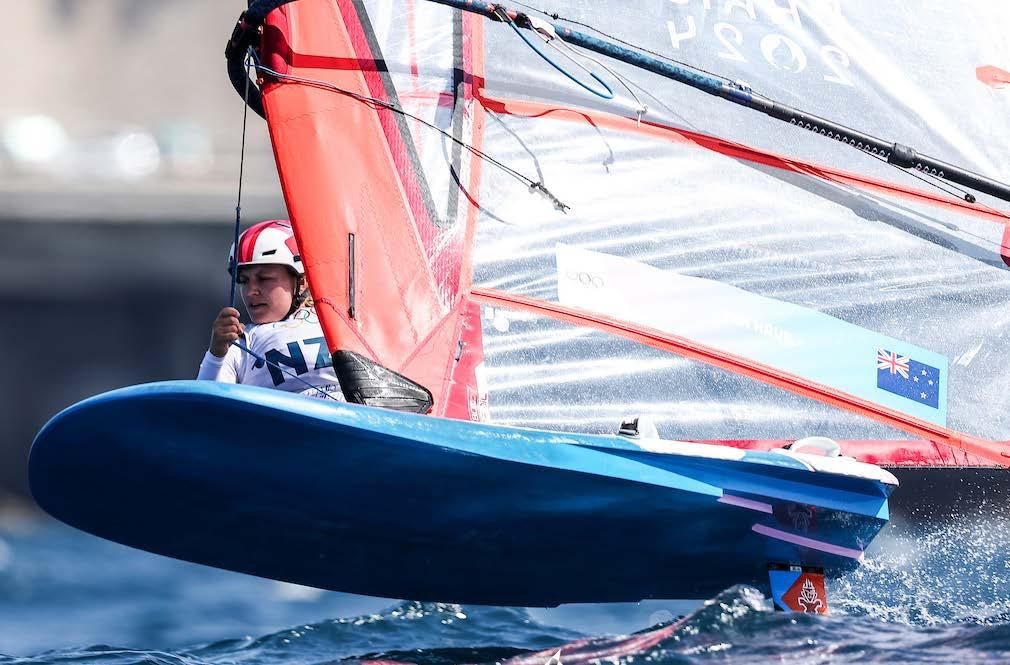
and finish at least three boats ahead of Argentina's Mateo Majdalani and Eugenia Bosco for silver. However, the focus of the race changed sensationally when Gimson and Burnet were disqualified for a premature start.
"We saw the British being sent back halfway down the first beat, and while there was a very brief moment of relief, our attention quickly turned to making sure we finished the race in time," Wilkinson said.
With the wind barely reaching 5 knots
'Not even making the medal race at the worlds hurt, and we really wanted to be a strong team throughout the Olympic regatta. I am most proud of the way we put it together – I don't think we've ever sailed better.'
Erica Dawson
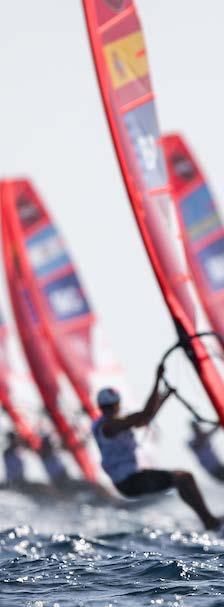
and a time limit of 40 minutes to complete the race, there was a real chance of a restart.
"We knew we were up against the clock, so we just had to stay focused on making it to the end. We knew the breeze in Marseille is extremely unpredictable. We'd had a race abandoned, and other fleets had plenty of races abandoned – so we just wanted to keep our heads in the game, not get ahead of ourselves, and finish the race," Wilkinson said.
"We still wanted to beat the Argentinians for silver, and we fought hard for it, but we just weren't good enough. It wasn't pretty, but when we crossed the line and knew we had that medal... we were just so happy."
The disappointment of missing out on a top-10 spot at the world championships in La Grande Motte in May, as well as the silver success of teammates McHardie and McKenzie, fuelled their performance, Dawson said.
"Not even making the medal race at the worlds hurt, and we really wanted to be a strong team throughout the Olympic
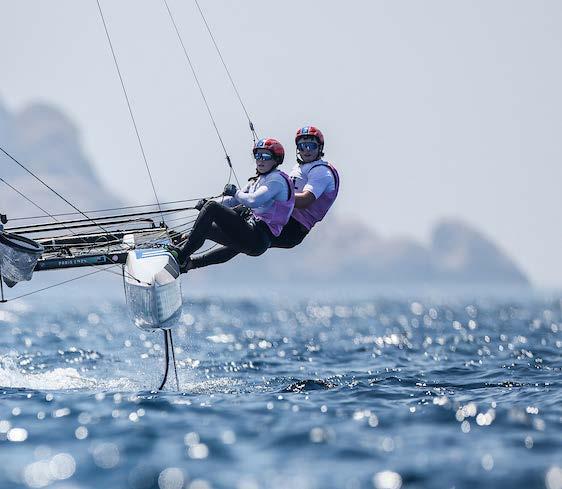
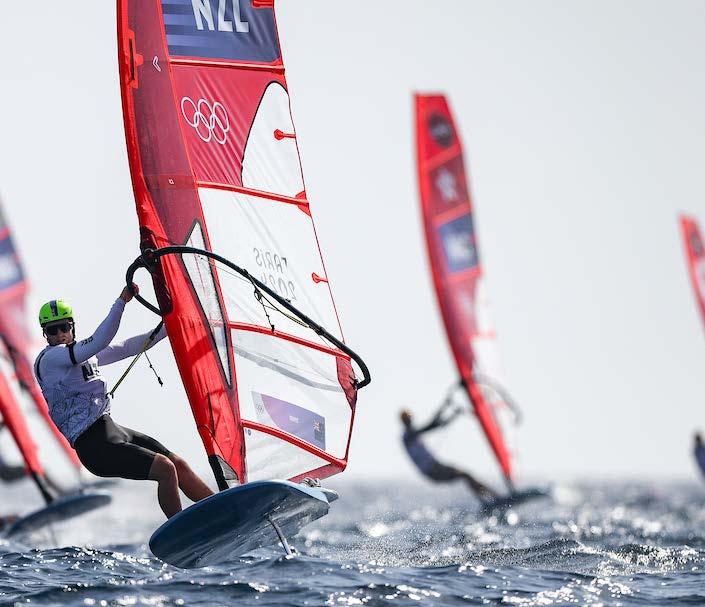
regatta. I am most proud of the way we put it together – I don't think we've ever sailed better. Seeing the boys (McHardie and McKenzie) win silver also gave us that extra little boost and made us believe it was possible."
The bronze is the second medal the team has achieved on the international stage, with silver at the European championships in 2022 being their only other podium finish.
It is also the first time since Rex Sellers and Chris Timms in Seoul in 1988 that a Kiwi crew managed to win an Olympic medal in the catamaran class.
Wilkinson and Dawson finished 12th at the Tokyo Games after a build-up derailed by injury when Dawson broke her leg in a training accident only a month before the start of the competition.
"This time was a lot smoother, and to win a medal meant so much to us, especially after what happened in Tokyo. We've put so much hard work into it, along with our incredible coach Anton [Paz], and for it all to just come together at the right time... we're so happy," Dawson said.

When Micah Wilkinson and Erica Dawson crossed the finish line in their tense medal race in Marseille just over three months ago, it marked the conclusion of a successful Olympic Games for our young NZL Sailing Team.
It signalled the end of a shortened Olympic cycle with many challenges but one, I believe, the team passed with flying colours.
This Olympic campaign was very different from Tokyo, which had been postponed due to the Covid-19 pandemic.
With a shorter, three-year cycle, and a younger team, we had less preparation time.
The makeup of the team saw several experienced sailors, including Peter Burling, Blair Tuke, Josh Junior, Andy Maloney, Sam Meech, Alex Maloney, Paul SnowHansen,
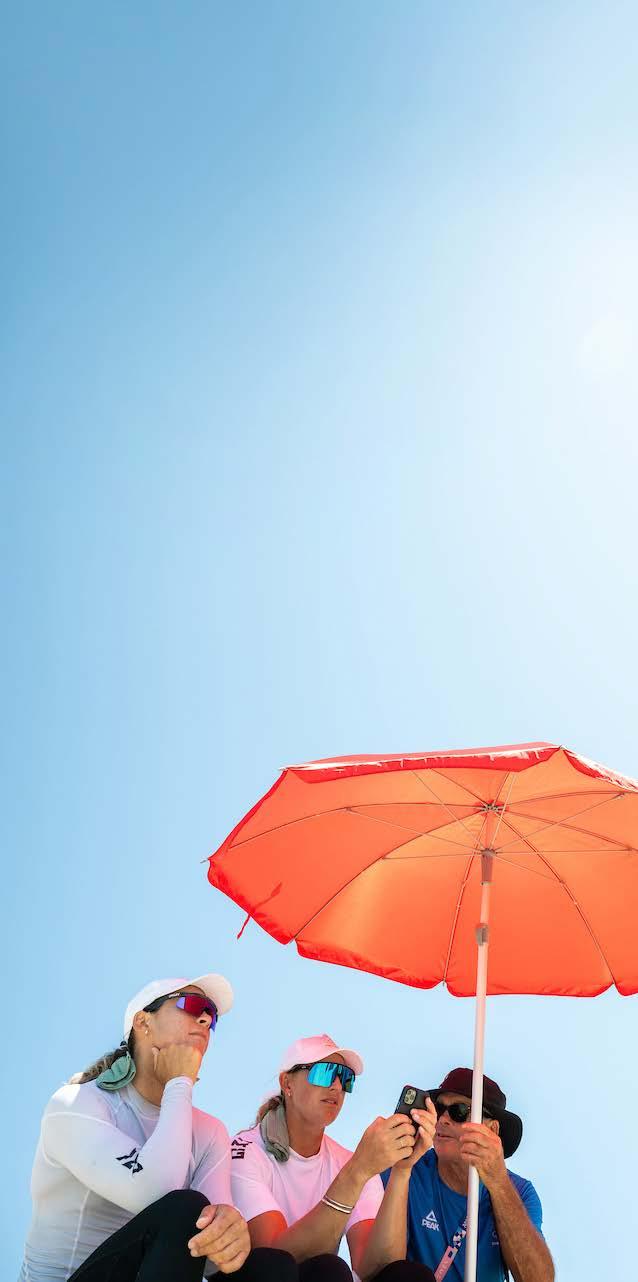
and Dan Willcox, all stepping away from Olympic sailing at different times.
As a result, we arrived in France with a relatively inexperienced Olympic squad – only Jo Aleh, Molly Meech, Micah, and Erica had prior Olympic experience.
Jo and Molly were also new teammates in the 49er FX class, having only started sailing together in 2022. Reflecting on the past three years, there's a strong sense of both pride and accomplishment.
I’m particularly proud of the sailors, coaches, and the Yachting New Zealand team for their dedication, and of how our team in Marseille came together, embraced the Olympics and truly had each other’s backs.
The pressure of performing at major events, like the Olympics, is what makes great athletes and teams.
To help our team thrive under such
Continued on p12
Continued from p11
conditions, we worked with world-class performance psychiatrist Dr Ceri Evans over the past three years.
Ceri's help was significant, particularly building our sailors' capabilities with communication and decision-making under pressure.
We also placed a lot of emphasis on fostering a strong team environment, working closely with performance consultants James Parsons and Roger Mortimer in the lead-up to the event in France.
Bringing together individual teams to form a cohesive unit is always a challenge, but the groundwork we put into our shared identity as an Olympic team and a wider NZL programme team played a crucial role in our overall success.
Competing in Europe was always going to mean home advantage to those nations and they were able to train in Marseille regularly and return home on weekends.
Our sailors are quite robust, having to spend long stretches away from New Zealand each year, and they embraced our local base La Pointe-Rouge in Marseille as a home away from home.
Despite the challenges, our team’s achievements – winning two medals, coming within one race of getting a third, and securing three more top 10 results –made it all worthwhile.
Particularly encouraging was the performance of our younger sailors, like windfoilers Josh Armit
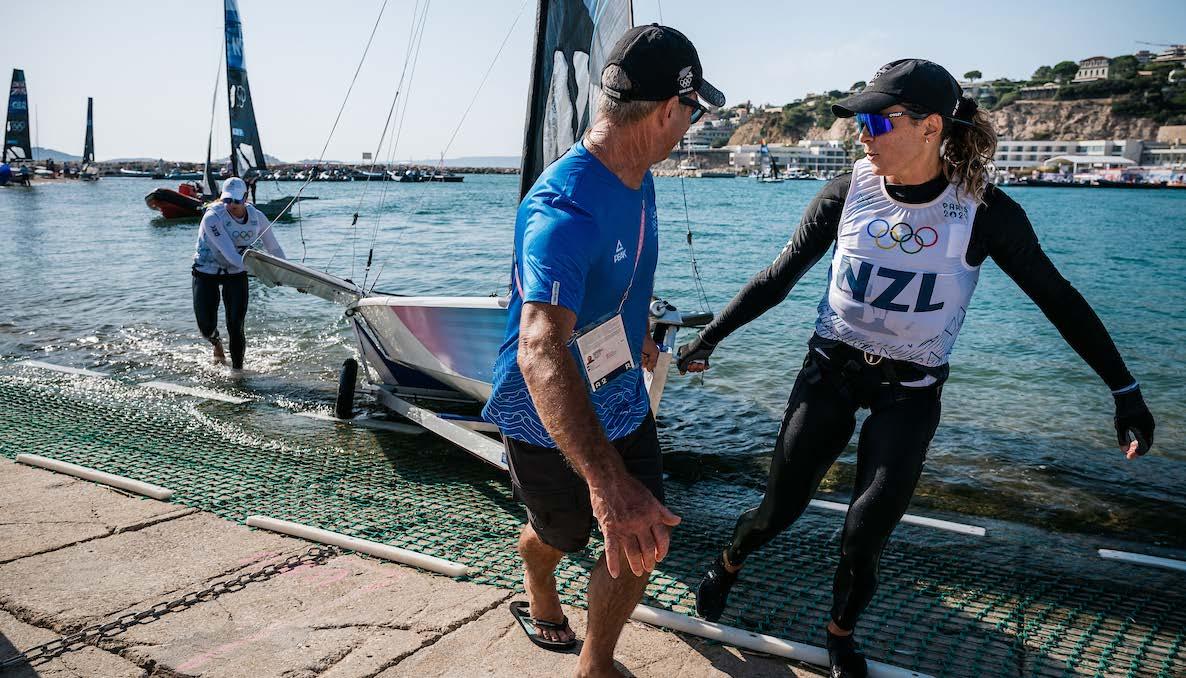
and Veerle ten Have, and ILCA 6 sailor Greta Pilkington.
They showed great promise and could be medal contenders in the future.
As we now turn our focus to Los Angeles 2028, we’re already reviewing our performances in and preparation for Marseille, as we do after every Games
There are always areas where we could have been more efficient or approached things differently, but there were also many factors that contributed to our success this cycle.
Securing a training base in Marseille early on was vital, allowing our sailors to become familiar with the venue and racecourses. Our coaching staff worked seamlessly, and our venue development
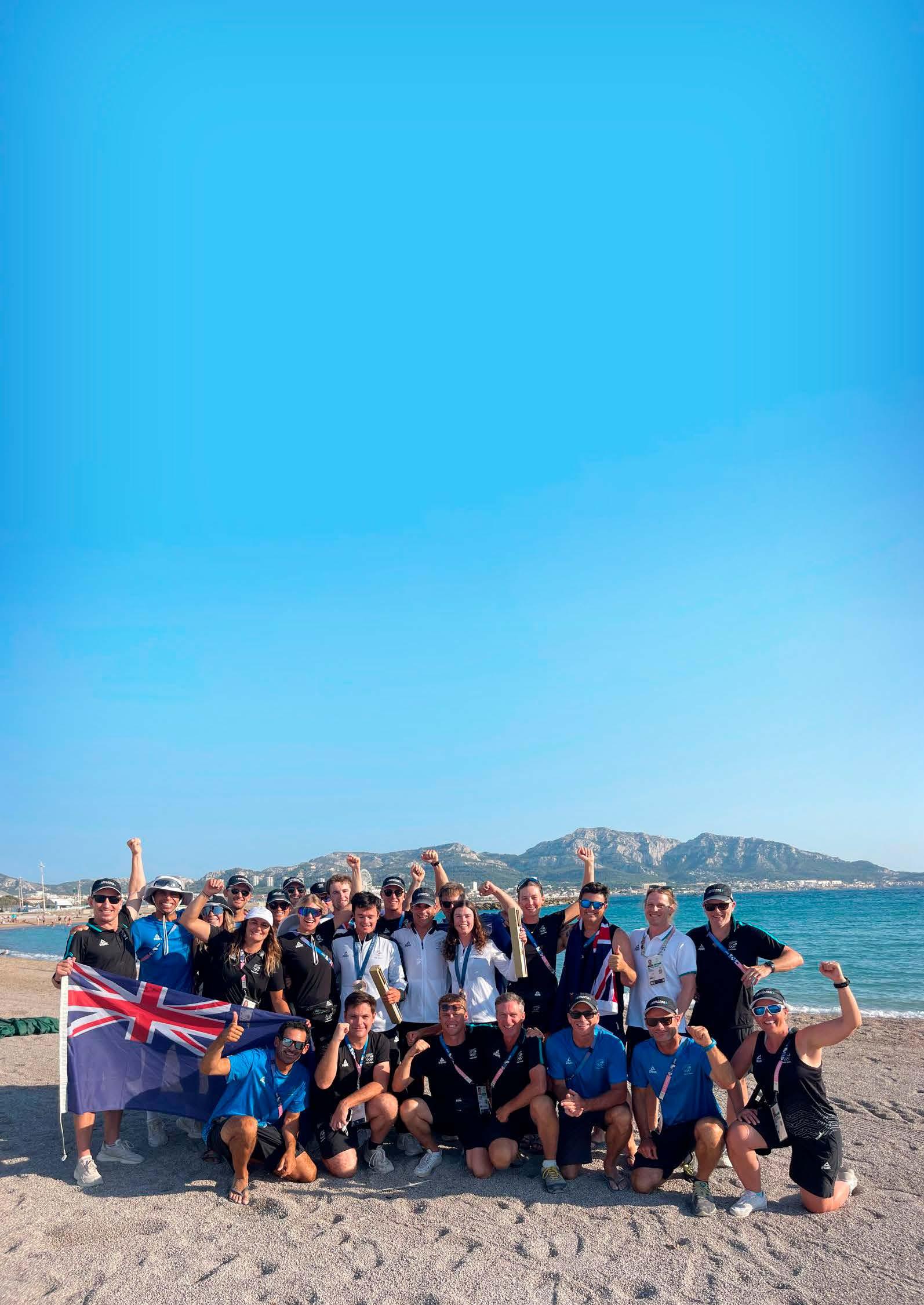
and analysis was top-notch.
The systems put in place will serve us well in future regattas.
Opting to stay in local AirBnB accommodations rather than the official Olympic hotels helped the team feel more at home and we also had a solid support team, covering logistics, shore support, and athlete health, with a dedicated doctor, physio, and chefs ensuring everyone was well taken care of.
We competed in nine of the 10 available Olympic classes, with an equal gender split among our 12 sailors. Our emphasis on building a shared identity and being part of the wider New Zealand Olympic team played a significant role in making these Paris Games truly special.
MODEL: WINDCHASER
SIZE LENS SIZE HINGE TO HINGE GENDER SHAPE M 5-BASE 141MM UNISEX HALF-RIM SHIELD
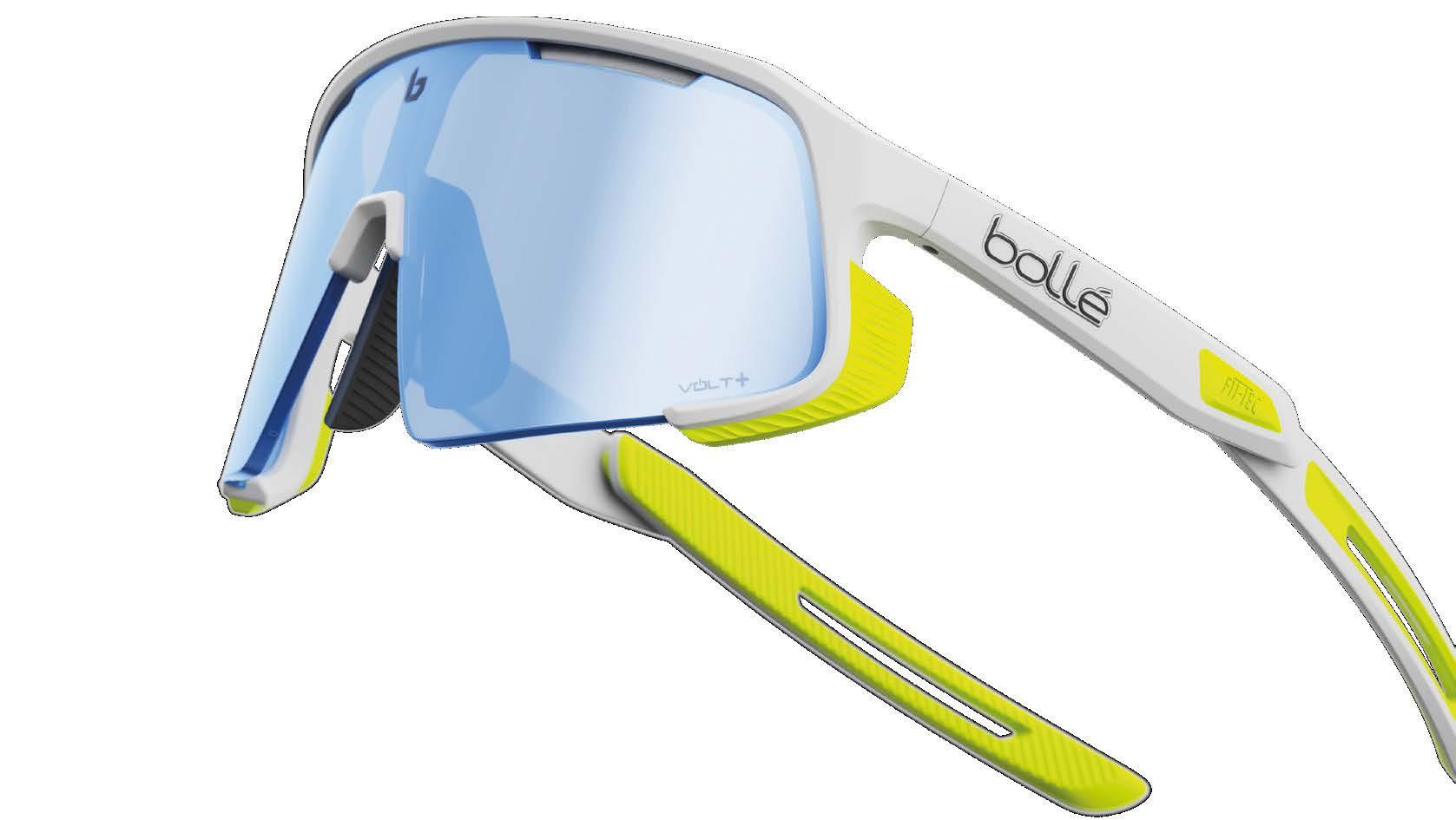
WITH EXCLUSIVE TEMPLE
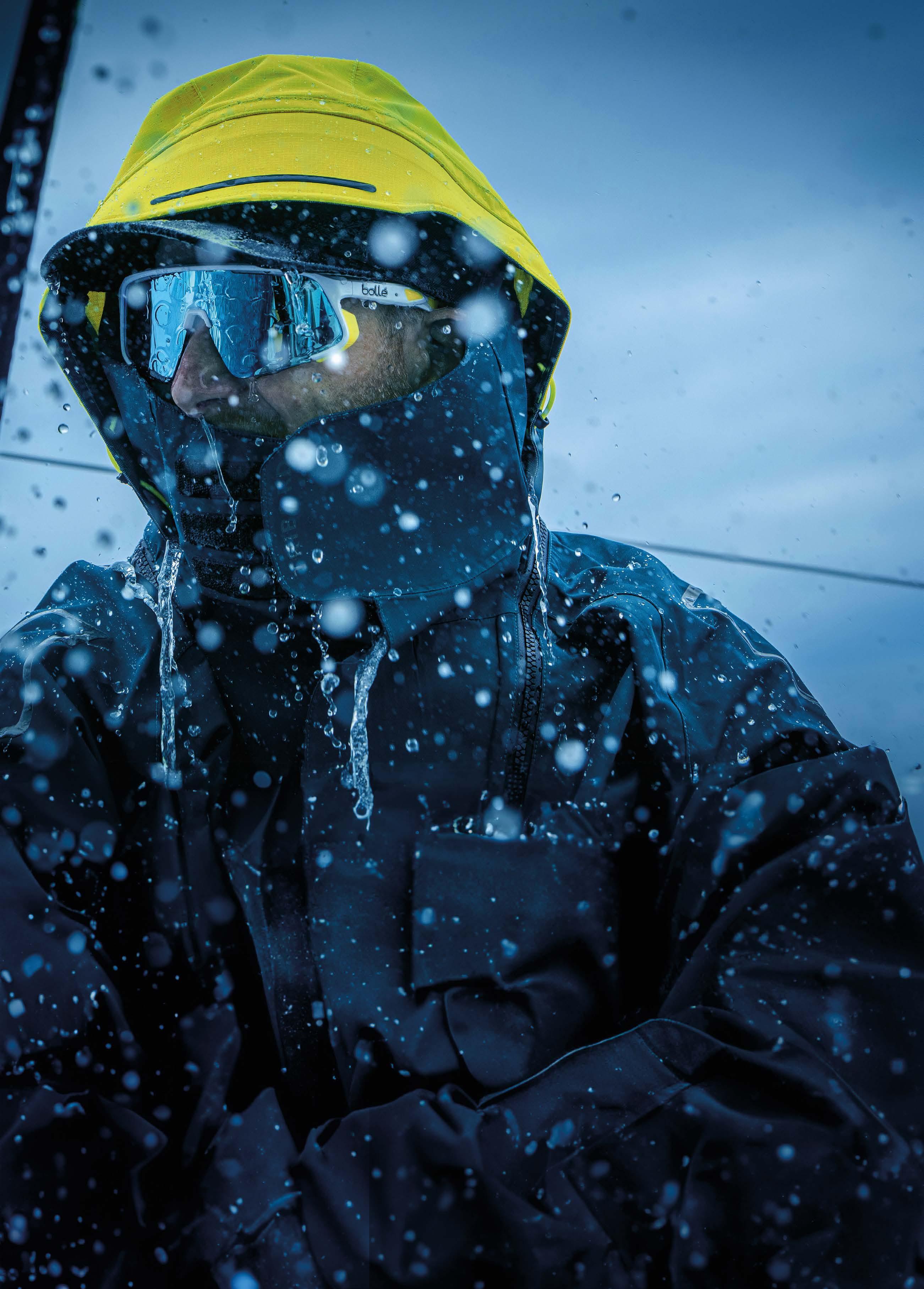
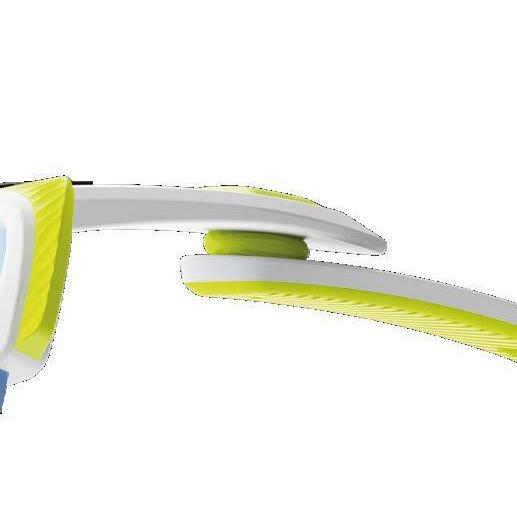
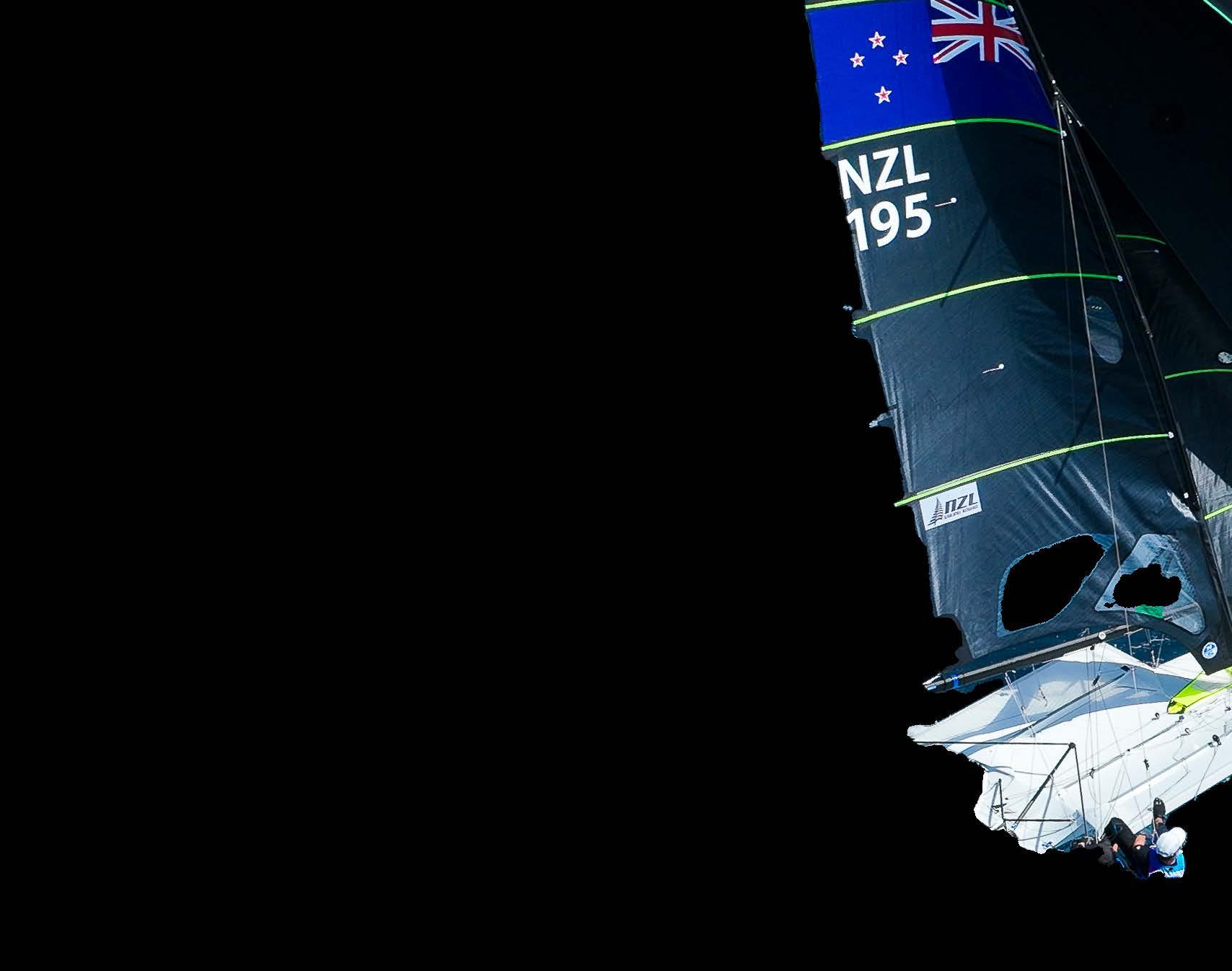
The Olympic success of Isaac McHardie and Will McKenzie will further inspire a talented group of young 49er sailors, setting the stage for an exciting year for the next generation of Kiwi skiff talent.
That’s according to Markus Sommerville, Yachting New Zealand’s development coach, who alongside youth development manager.
And, says Somerville, judging by performances in 2024, there is much to look forward to next season.
Francesco Kayrouz and Hamish McLaren stole the spotlight in July when they won the silver medal at the junior world championships in Spain. Fellow Kiwis Seb Menzies and George Lee Rush finished fourth, after leading in the early stages of the regatta. Menzies and Rush also narrowly missed out on the gold fleet at the 2024 European championships at La Grande Motte International Regatta, where rising crew Campbell Stanton and Will Shapland finished an impressive
25th.
Mattias Coutts and Henry Haslett had an excellent Princess Sofia Regatta this year, making the gold fleet, while new pairing Sam Bacon and Blake McGlashan are also set to make their debut on the international stage in the coming season.
McHardie and McKenzie’s silver medal at the Paris Olympics has added extra motivation for the squad, Somerville said.
“The guys definitely draw inspiration from these previous successes, especially having worked closely with them,” he said.
“Will and Campbell were lucky enough to be Isaac and Will’s training partners in Marseille before the Games, and you could sense their determination to achieve something similar in the next cycle.”
Asked what has contributed to the country’s success in the 49er class – New Zealand has now secured a podium finish in the class at the last four Games – Sommerville said it is an exciting class
and sailors are naturally attracted to it with the direction the sport is taking.
“We also have excellent role models who’ve excelled in the skiff classes, both men and women. The 29er is a fantastic feeder class where we have excellent coaching and IP that helps sailors step in to the 49er and FX,” he said.
“Drawing on the knowledge we have in New Zealand and the quality domestic racing and training has been critical to fast-tracking their sailing.”
While the squad spends extensive time on the water, the off-water work has been crucial in establishing both quality and depth.

“It’s been a steep learning curve since we started with the development squad shortly after the Tokyo Games,” Sommerville explained. “Initially, we focused on fundamentals — balancing sailing with university or work commitments and teaching them how to properly manage a campaign. When you’re 18, you often don’t know how to
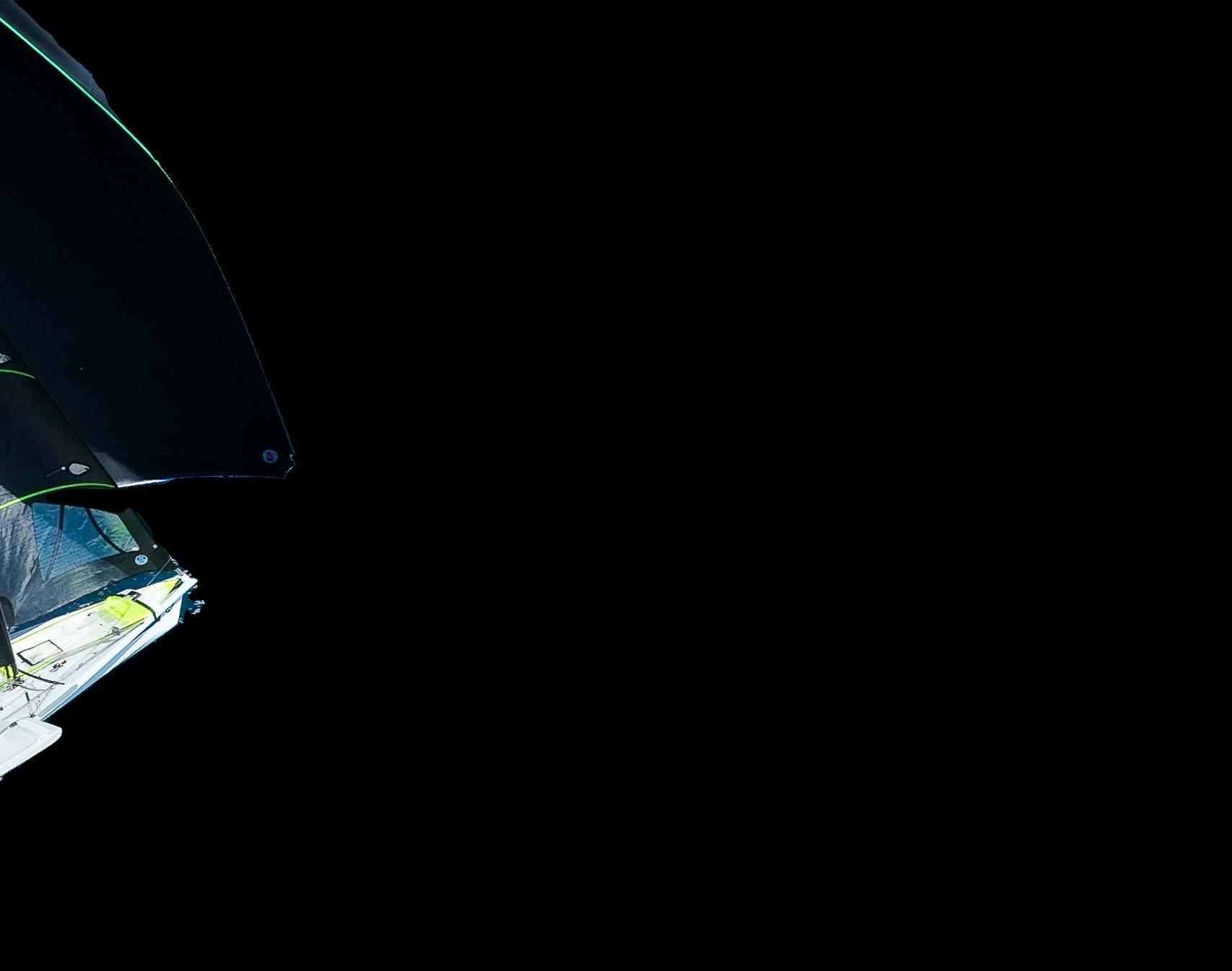
book accommodation abroad, let alone ensure it has a washer and dryer! Our campaign blueprint focuses on how planning enhances performance, and we break down every aspect of a campaign for analysis.”
Yachting New Zealand has also been focused on building a shared identity within its performance squads over the last year, outlining goals and values that will guide them.
“On the water, the boys are fiercely competitive, but once ashore, they’re mates who can have a laugh together.”
The five teams will have their first opportunity to prove themselves at World Cup events in Palma de Mallorca and Hyères early next year.
Somerville believes top 25 and even top 10 finishes are within reach.
“There is a lot of hard work to put in to set them up to be competitive at the world champ in Cagliari, Italy next October,” he said. “I’m excited about the year ahead.”
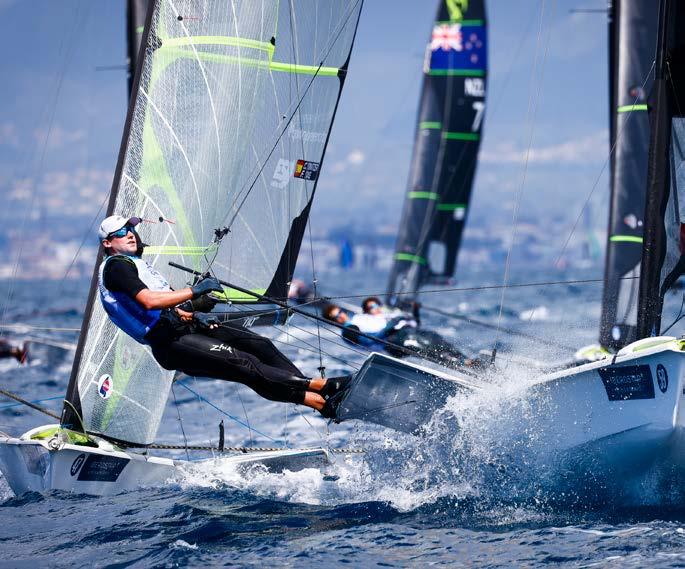
perfectly. Campbell is excitable, while I call Will ‘The Iceman’ because he’s always so calm. They’re both highly intelligent and fast in a range of conditions. In fact, when they’re on, they’re one of the fastest teams in the world. Their biggest challenge this year will be figuring out how to bring it all together on the racecourse.”
Sam Bacon and Blake McGlashan
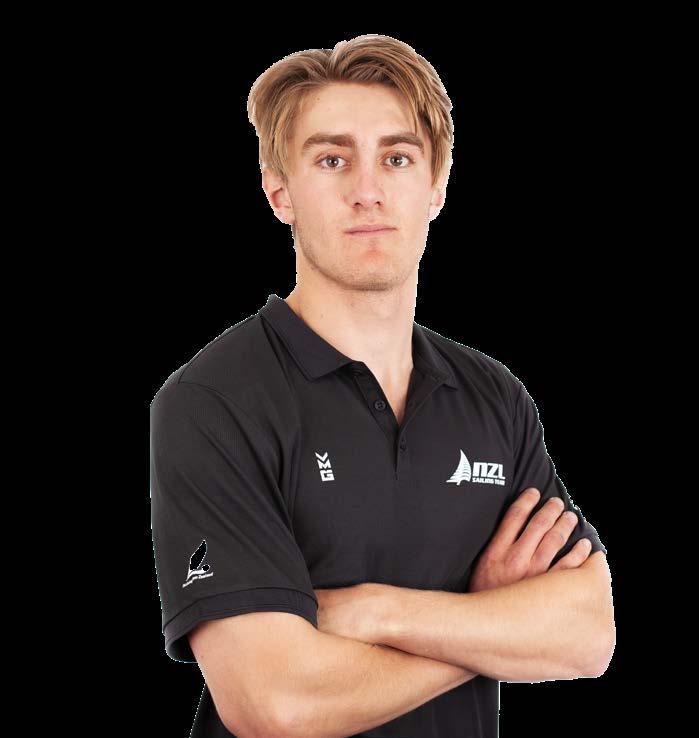
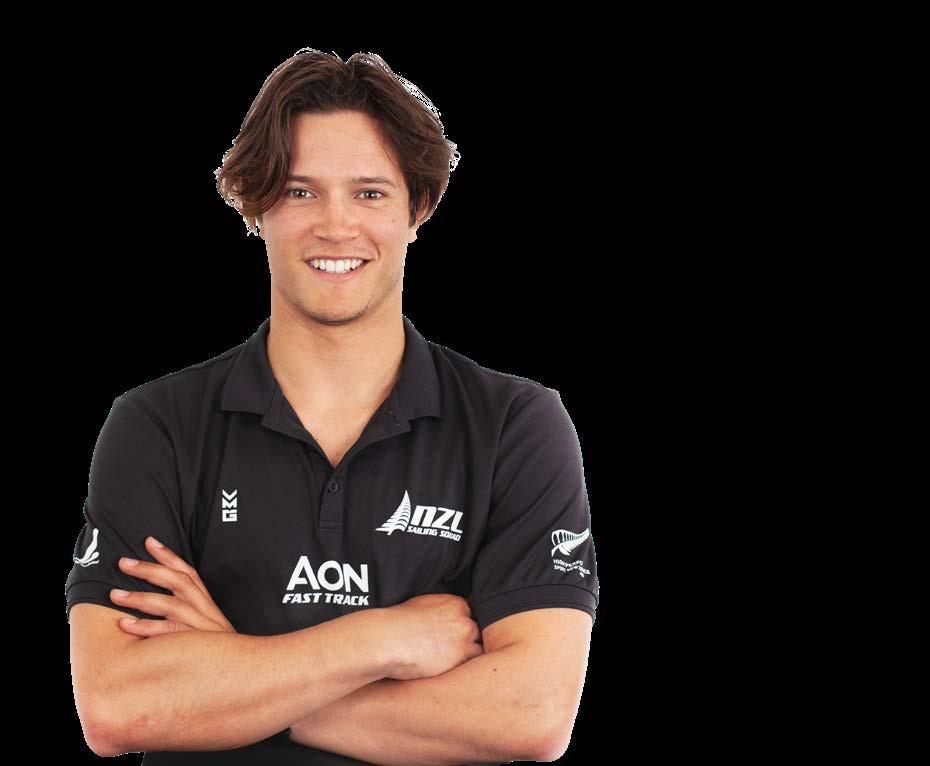
“Although they’re a new pairing, Sam and Blake clicked almost immediately. Their boat handling is exceptional and they’ve been pulling off manoeuvres in strong winds that I don’t think many Olympians could manage. They haven’t yet competed internationally as a team, but I’m excited to see what they do.”

and Henry Haslett
“Mattias and Henry haven’t had a lot of time in the class together but got an amazing result in

The glittering Olympic career of one of NZ's brightest sailing stars ended in Marseille. She talks to Suzanne McFadden about her next steps and her hopes for the sport.
After sailing in four Olympics – and coaching at another – Jo Aleh has called time on a glittering Games career that’s spanned 16 years.
The 38-year-old Olympic gold and silver medallist doesn’t yet know where life will take her next, after wrapping up an historic America’s Cup campaign in Barcelona. But she’s pretty confident her future will still involve sailing.
And that could be making a difference in the sport with a seat at the top table of World Sailing.
Although Aleh didn't get the result she was after in her Olympic swansong in Marseille – finishing seventh in the 49er FX with Molly Meech – she calls this her favourite Games experience.
And her most humbling – having been chosen with track cyclist Aaron Gate as the Ngā Pou Hapai (flagbearers) leading the New Zealand team at a unique opening ceremony in Paris (fittingly on a boat).
On the water, these Olympics were a very different experience for Aleh, after a short two-and-a-half-year build-up once she decided to partner with Meech, in a boat she'd never sailed before. But she's always been an athlete who thrives on a challenge.
"It was more of an adventure than any of my previous Games. It was a lot tougher in many ways – with a new boat for me, jumping in the deep end – but it was really enjoyable overall," she says.
"I love the FX. It's definitely the most fun thing I've sailed. It challenging and athletic, and it can definitely punish you if you get it wrong.
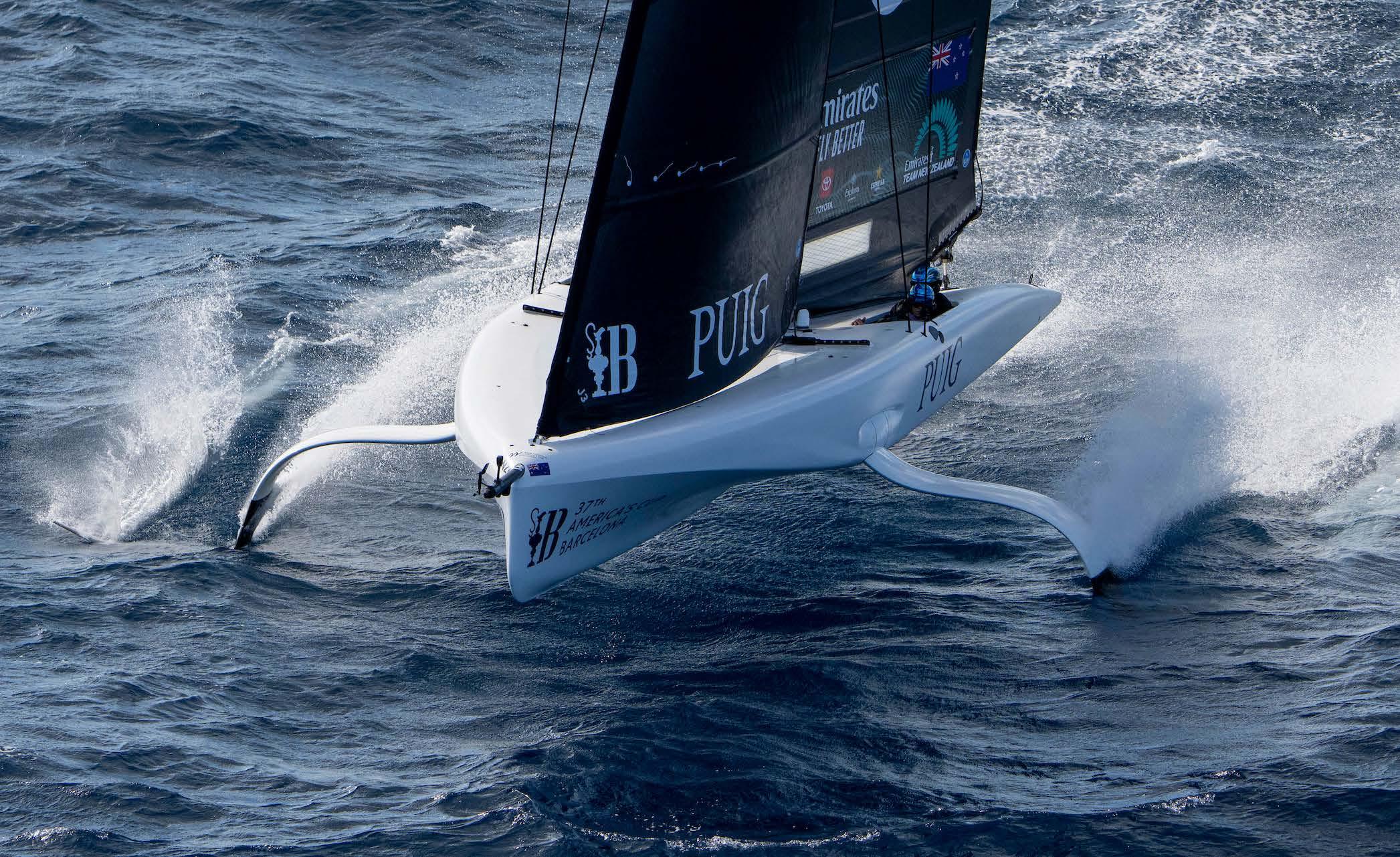
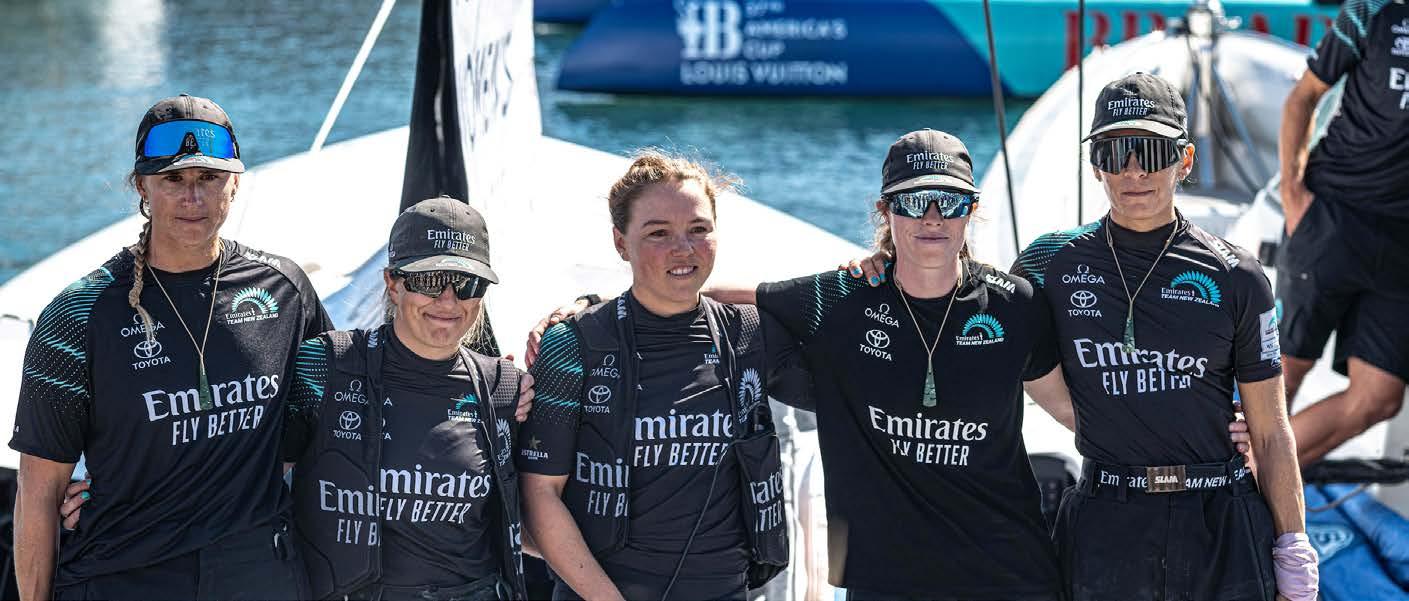
"We didn't get any real breeze at the Games, after we'd spent most of the leadup learning how to get around the course in breeze – we were pretty confident in that.
"Even though the end result wasn't what we wanted, it was an awesome experience trying to do something that was always going to be super-hard. It was definitely a
lot of fun."
In a way, Aleh's Olympic career has come full circle. At 19, she was the youngest New Zealand sailor chosen for the Beijing 2008 Olympics in the Laser Radial (now ILCA 6), where she also finished seventh. She followed that up with gold in the 470 with Polly Powrie in London 2012,
and four years later, they returned to the podium again, this time with silver in Rio.
At this year's Olympics, Aleh found herself "on the sidelines" – off the podium –for the first time since 2008.
"As an athlete, you can judge yourself pretty harshly. But I think that was something quite nice that came out of these Olympics," she says. "While I was pretty gutted about some of the races we sailed, I was still really proud of what we achieved."
And the supportive team atmosphere in Marseille added a new dimension to her
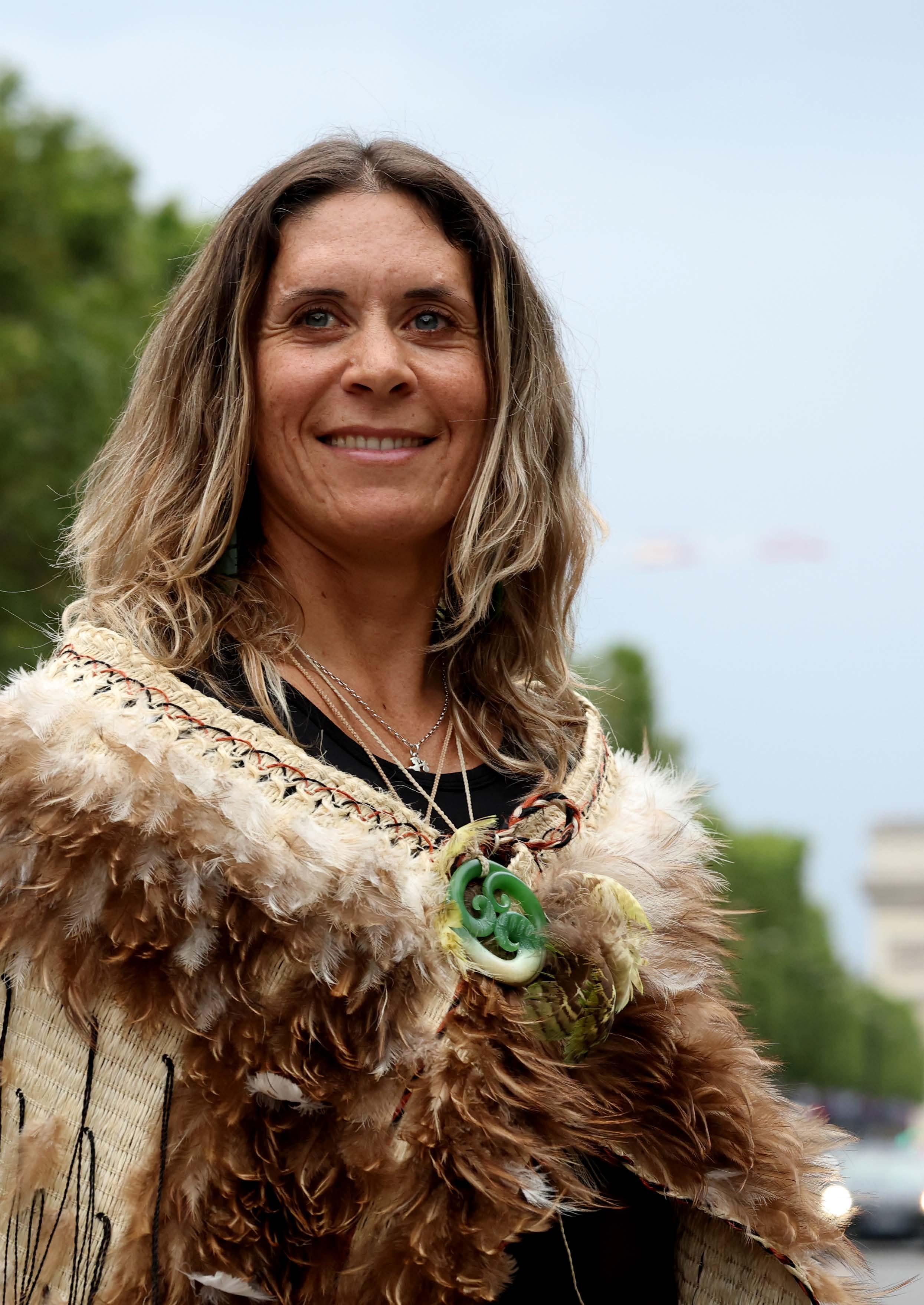
Continued from p17
Olympic chapter.
"Of all the Olympics I've been part of, I think this was my favourite. We had such a great team on the ground. We had a lot of newbies and only four of us had Games experience. But there were some amazing close-to-podium performances," Aleh says.
"When you win a medal, you don't see the tears on the sideline, because you're dragged off into this other crazy world of media and celebrations; you're in this little bubble.
"So I loved being there with the whole team on the beach, with the flags, the hugs and the cheers. No matter where anyone finished, we were all there for each other. It was great to be a part of that."
Carrying the New Zealand flag on board the barge that meandered along the Seine was a memory Aleh will hold right up there with her Olympic medals. She was shocked when New Zealand team chef de mission, Nigel Avery, phoned her and invited her to take on the role at the opening ceremony.
"It was something I never considered I'd get the chance to do. It's such a huge honour," she says. "I looked at the list of people who carried the flag before us, and I asked Nigel, 'Really? Are you sure?'"
It wasn't a problem Aleh had to fly back to Marseille the following morning and be on the water sailing by 2pm: "I have a lot
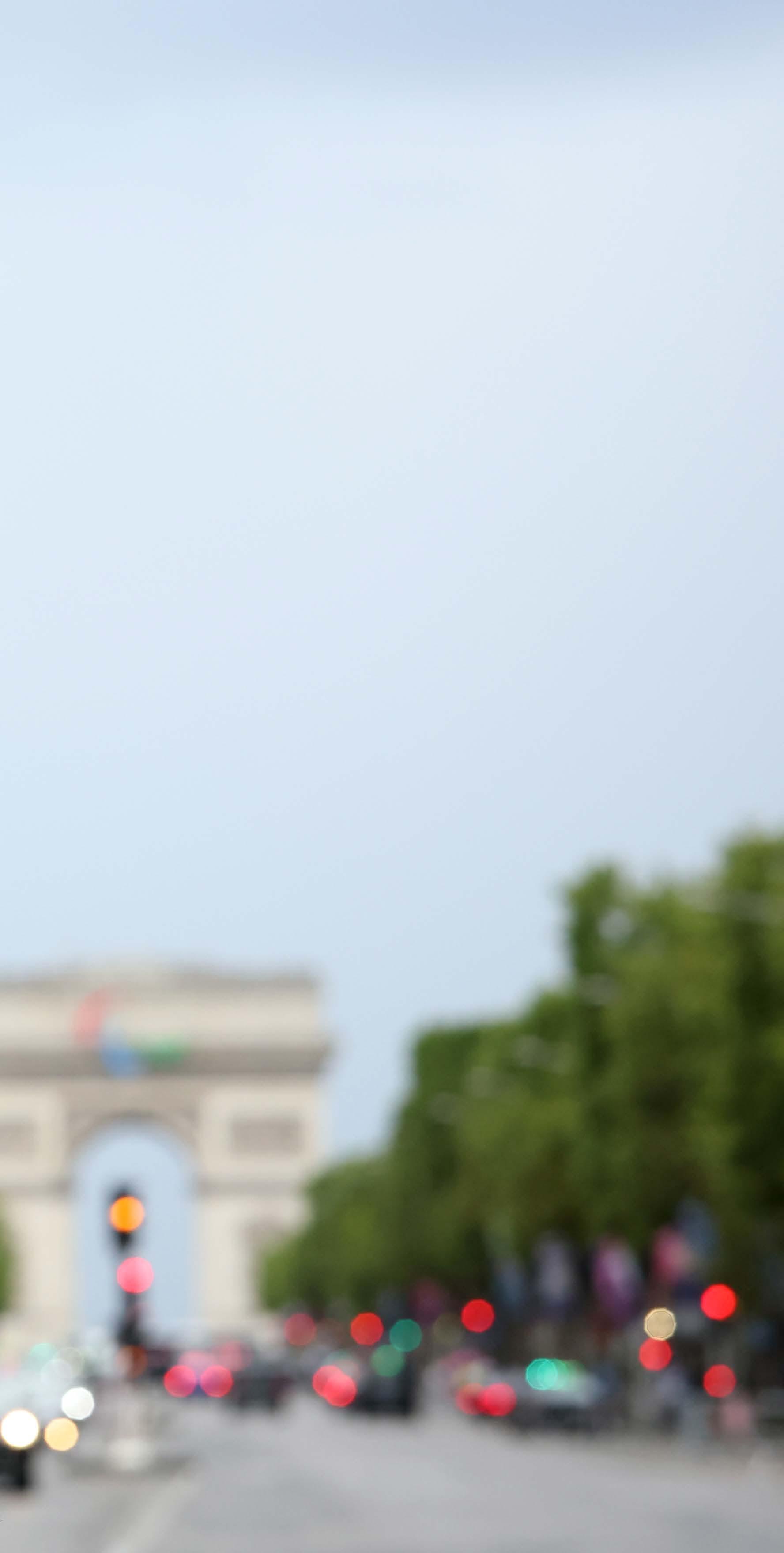
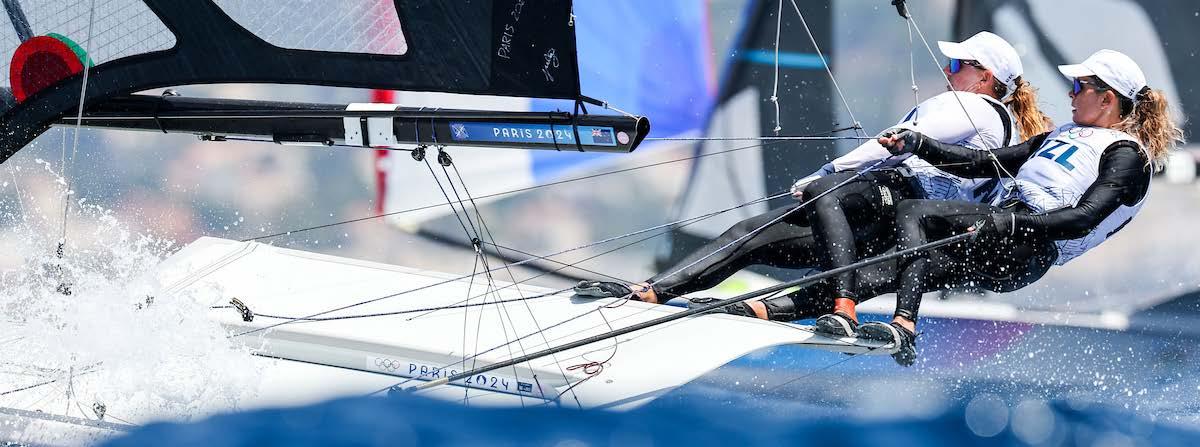
of energy, generally, so to burn some of that off, then arrive back chill to go sailing was quite a good thing."
Aleh can't see herself returning to the Olympics as a sailing coach, having worked with Erica Dawson and Micah Wilkinson in the Nacra 17 three years ago.
"Coaching Erica and Micah in Tokyo was amazing. Then to see them win bronze at these Olympics was so awesome, knowing the battles those two have been through," she says. "Coaching definitely kept me in the sport, and involved in the Olympics. And it made me realise what I love about them.
"But I also realised coaching for me is a lot like sailing – without the fun part. The same programme, hours and travel but you're watching and supporting. For some people, that's what they want to do. I'd like a supporting role, but not a full-time supporting role."
Heading straight from Paris to Barcelona for the first Women's America's Cup was another career pinnacle for Aleh. Not only making history, but being part of the much larger Emirates Team New Zealand campaign.
"It's amazing when you see people put everything into it – the search for performance on so many levels, like technology and development, as well as sailing," she says.
"I hope this is just the start of a women's series, or something that can continue. A consistent Women's America's Cup, with a set of events leading into it like the guys do. It would be a shame to start the ball rolling
and then just let it fade away."
Aleh has no ambition to return to corporate life and work in an office again, after working for professional services firm Ernst & Young, in performance improvement (through the company's global campaign to help athletes transition into the workforce).
"It's good that I've tried a few things, but I definitely struggle with the everyday
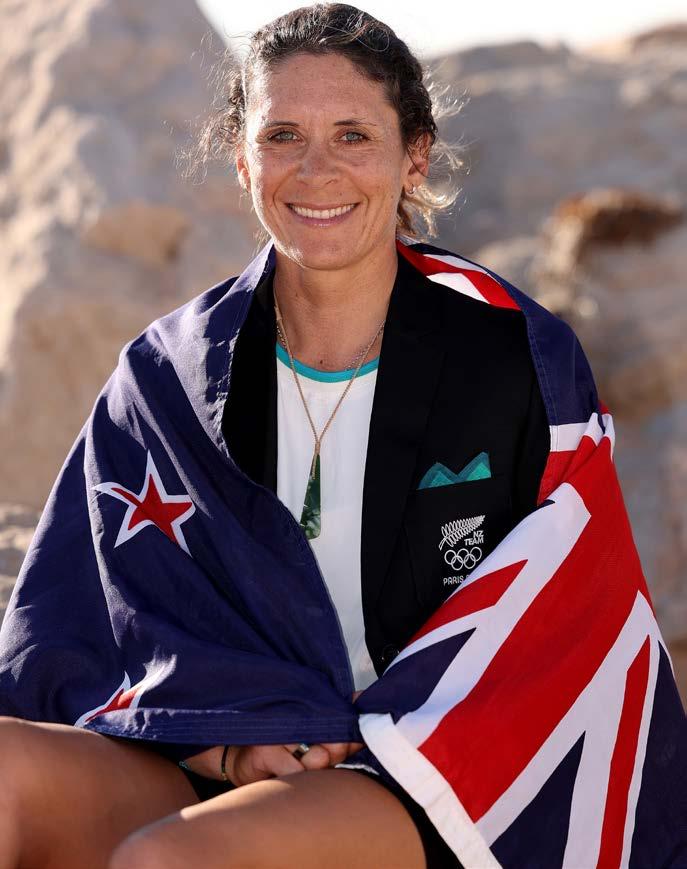
'I looked at the list of people who carried the flag before us, and I asked Nigel, 'Really? Are you sure?'' Jo Aleh
office life. I'm an outdoor person," she says. "I really enjoy the performance aspect –and that seems a lot harder to find outside sport."
She doubts she will have another shot at offshore sailing, having trialled for the 2017 Volvo Ocean Race, with Team Brunel.
"I didn't enjoy that too much. Honestly, I'm just too small and not strong enough, and it's a different type of performance – it just keeps going. If I want to do endurance sport, I'll do that for fun," says Aleh, who recently took up running and wants to do an endurance event.
Wingfoiling, another passion, has helped her finally figure out she doesn't have to be competitive in everything she does.
Aleh heads to Singapore this month for the World Sailing General Assembly, where she'll finish her four-year term as the chair of the Athletes' Commission. She's also put forward her nomination for Vice President of the World Sailing Board.
"Sailing is a complicated sport, and there are a lot of things to juggle and balance," she says. "But I always think it's better to be involved and try to have some impact, rather than being on the sidelines to complain about it, which is what most people seem to do.
"I'm a little younger than your average board member in sports administration and a bit more directly involved having been a recent Olympic athlete and sailed in the America's Cup. It will be interesting to see where the sport goes next."
And where Aleh goes next, too.

A first for Kiwis with America’s Cup threepeat in Barcelona.
The America’s Cup is still New Zealand’s Cup as Peter Burling and his Emirates Team New Zealand ensured the Auld Mug remains in Kiwi hands for a record third consecutive campaign.
The New Zealand syndicate, co-helmed by Burling and Nathan Outteridge, completed one of the most successful America’s Cup campaigns in history, securing the three-peat with a commanding 7-2 win over INEOS Britannia in the Cup Match held in Barcelona this October.
In doing so, they became the first team to win the America’s Cup three times in a row, having also defeated Luna Rossa Prada Pirelli in Auckland in 2021 and Oracle Team USA in Bermuda in 2017.
The Kiwis cemented their place in the record books as one of the finest sporting teams in history. Their only setback was two race defeats on the third day of competition, a minor blip in an otherwise flawless defence.
They retained the world’s oldest sporting trophy with a decisive victory in the final race, overcoming a fiercely competitive British team led by Sir Ben Ainslie.
“What an incredible day, an incredible campaign, and just seeing it all come
together in such a tight race – it’s something we’re incredibly proud of,” Burling said before hoisting the trophy.
“I’m just incredibly proud of what we’ve accomplished. The America’s Cup is one of the hardest sporting trophies to win. So many elements have to come together, and to have done that three times in a row is incredibly special.”
This triumph marks the end of a threeyear campaign to retain the Auld Mug, with Burling – also a three-time Olympic medallist – becoming the most successful
Continued on p22

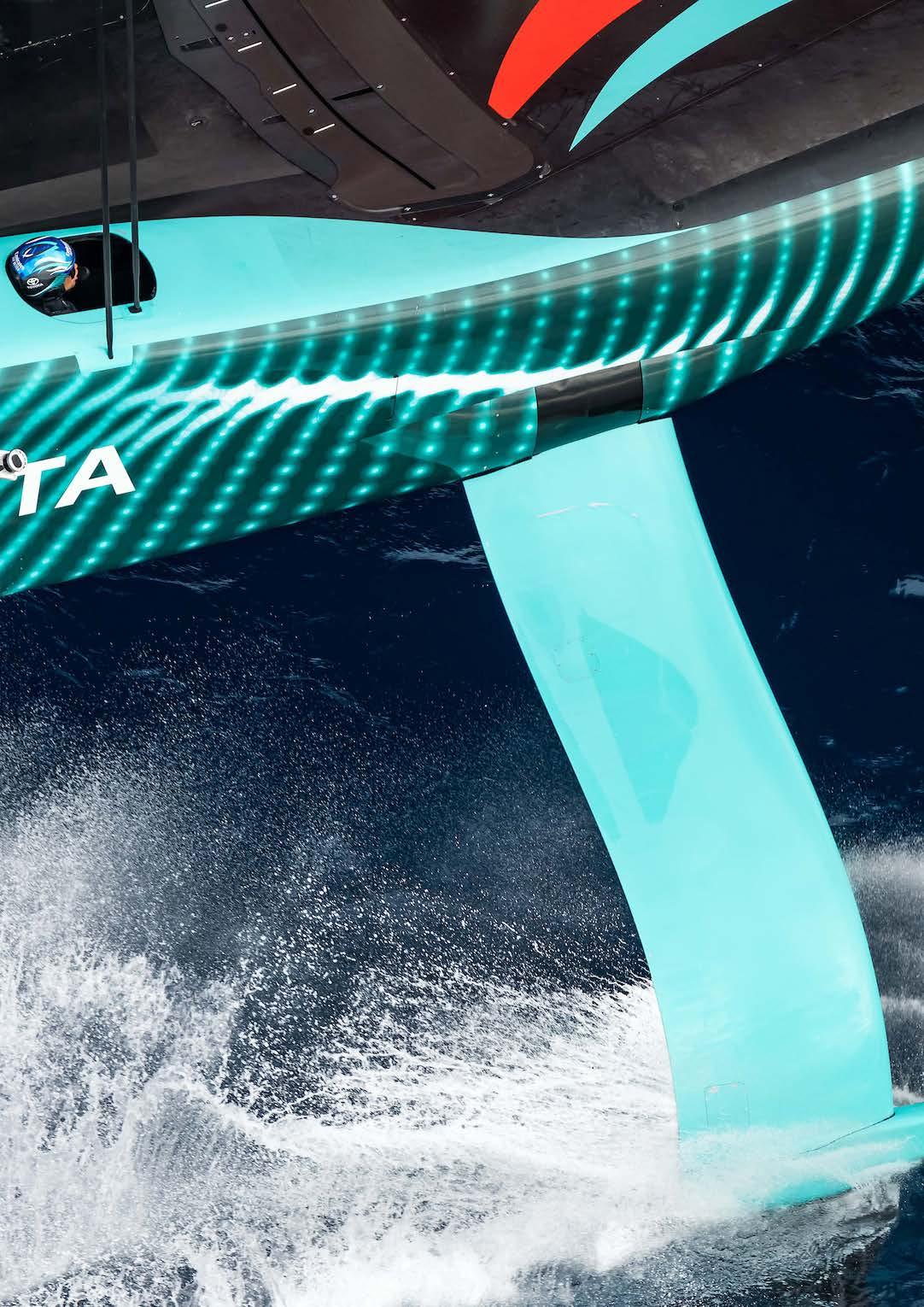
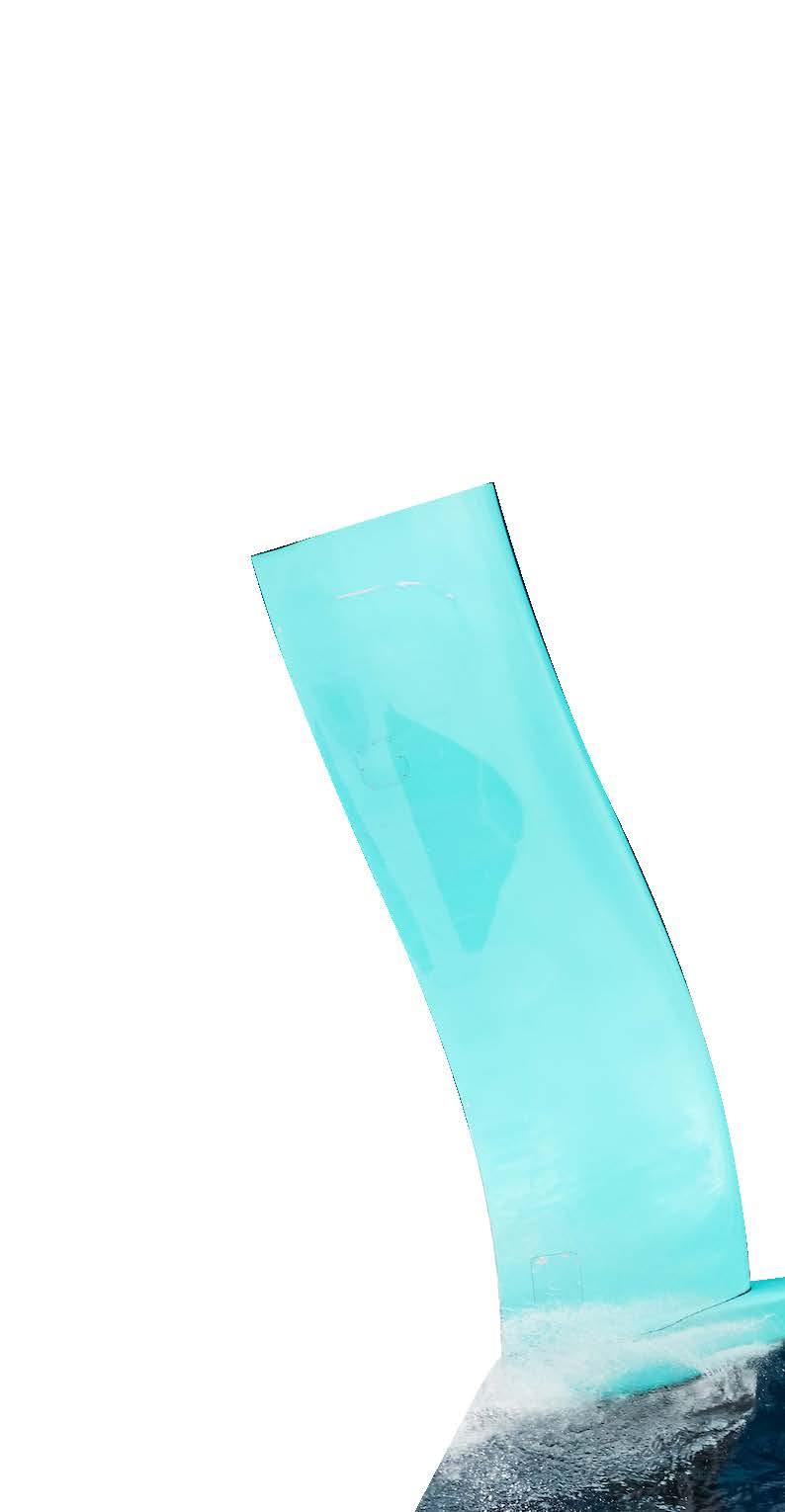
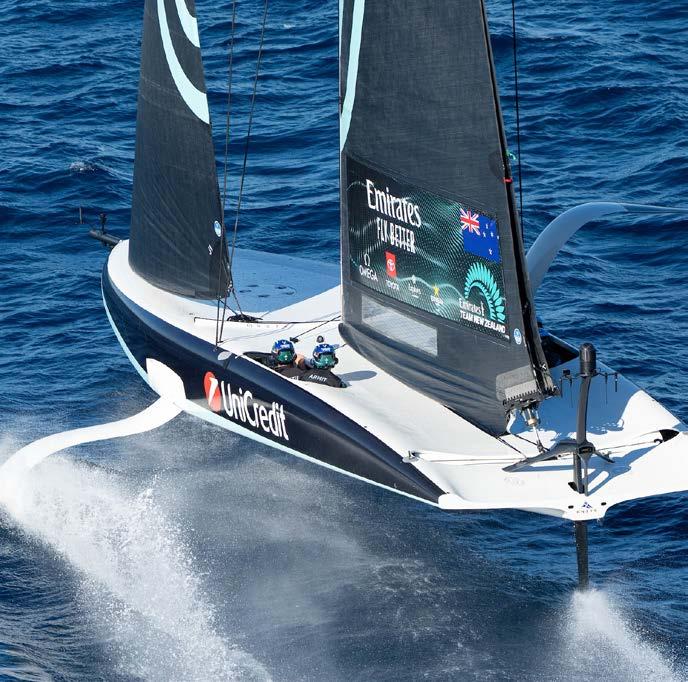
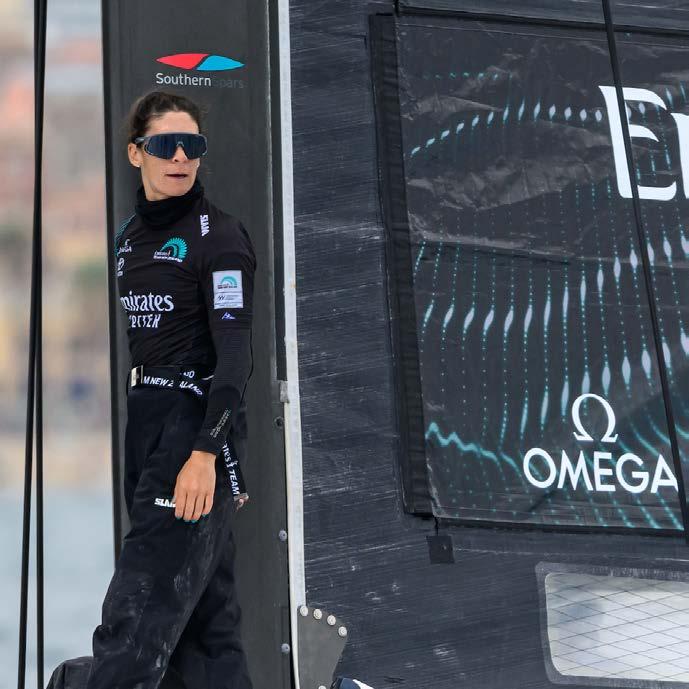

A disappointed Ainslie acknowledged the Kiwis’ supremacy, calling them the best America’s Cup team ever after his third attempt at winning Britain’s first Cup ended in defeat.
INEOS Britannia had reached the final for the first time in 60 years, having defeated Luna Rossa Prada Pirelli in the Louis Vuitton series.
“You’ve got to give credit where it’s due,” Ainslie said. “Falling short at the final hurdle is tough, but we were up against one of the greatest teams in America’s Cup history – if not the best. We’ll take this on the chin, and I think the team has done a brilliant job throughout the campaign. As one very plucky Brit said, it’s the courage to continue that counts, and that’s what we’re up for.”
Ainslie confirmed that the British team


would be the Challenger of Record for the next America’s Cup but would not commit to remaining at the helm, stating only that he would “do what’s best for the team”.
Emirates Team New Zealand CEO Grant Dalton, when asked about the future of the event, said the aim was to “continue the growth we’ve seen since we first won the America’s Cup in 2017”.
This year’s event attracted 2.56 million attendees between 22 August and 19 October 2024.
Over the 59 days of the event, initial indicators suggested a 50 per cent increase in total broadcast and media audience compared to the 2021 competition.
“The Louis Vuitton 37th America’s Cup has confirmed the event as one of the most unique properties in international sport, so our objective is to build on
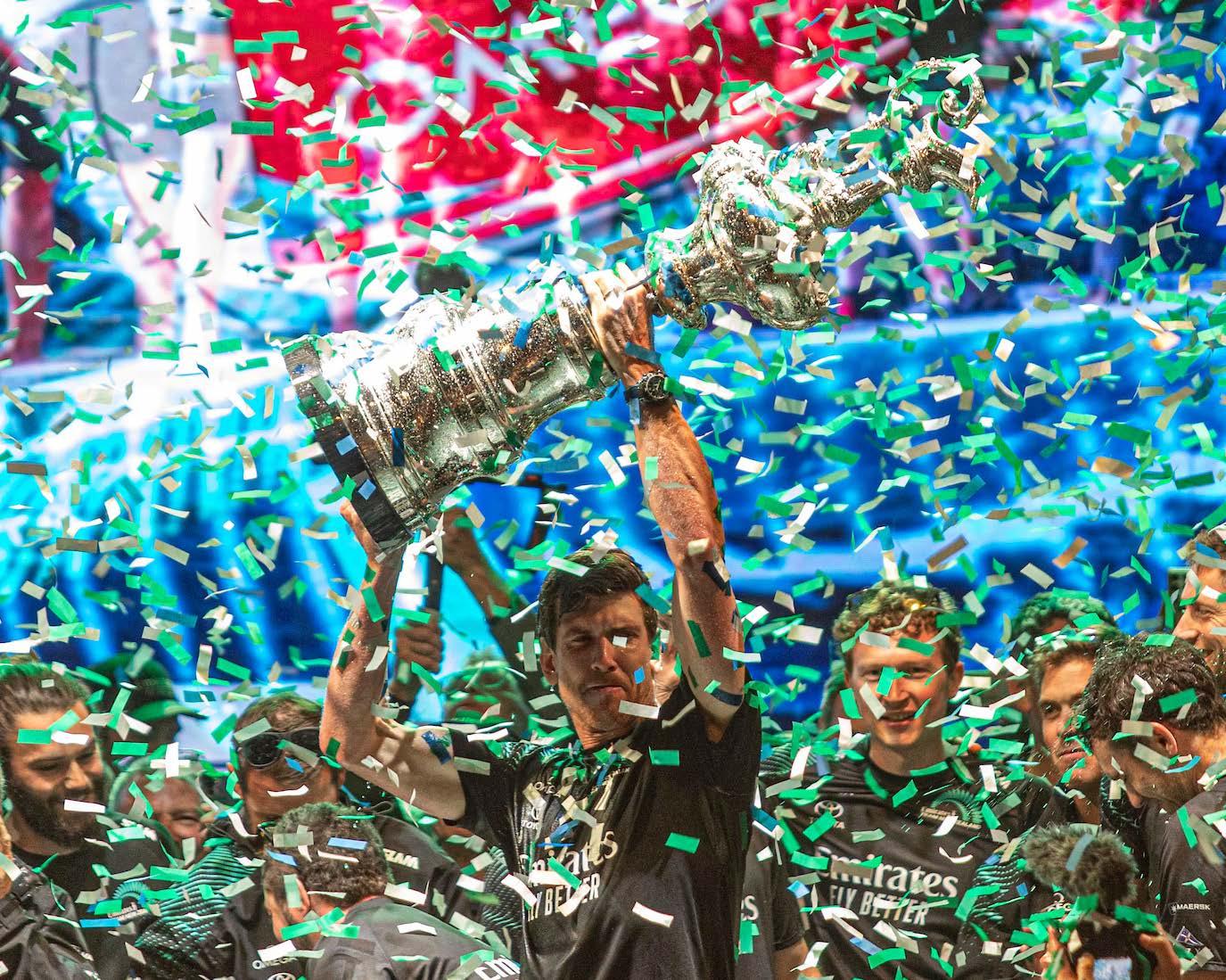
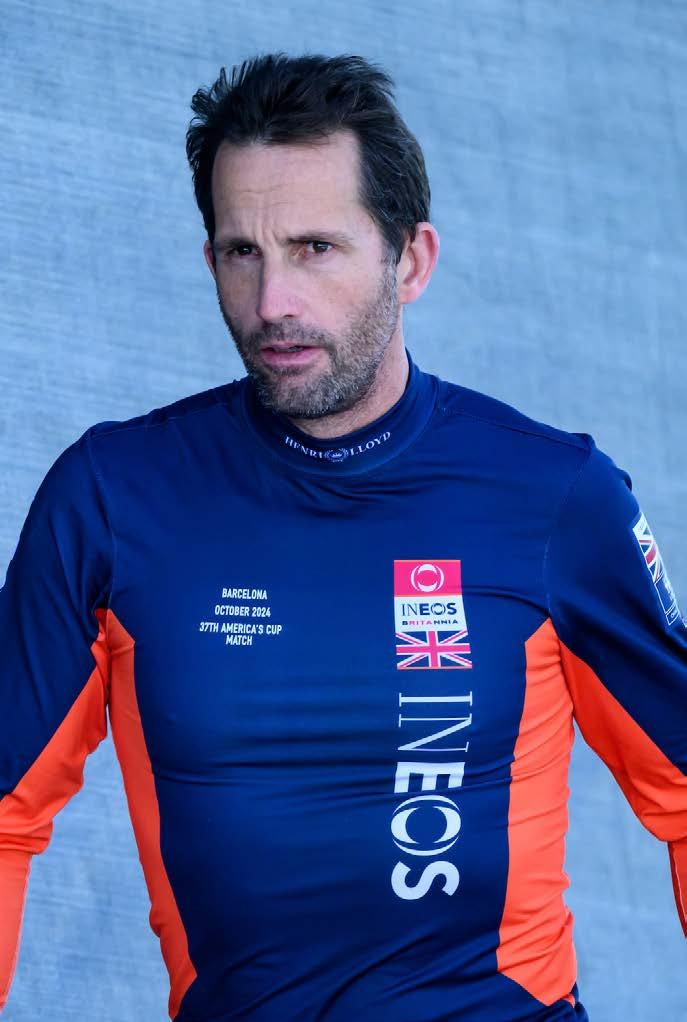
this success. We’re looking to increase audience and engagement across different regions, territories, and demographics,” Dalton said.
The hosting of the event in Barcelona also drove significant growth across various fronts, with successes in the Puig Women’s America’s Cup, the Unicredit Youth America’s Cup, and the AC Sailing E-Sport World Championship.
Luna Rossi Prada Pirelli won the inaugural women’s event, defeating Britain’s Athena Pathway in the final.
Emirates Team New Zealand –represented by Jo Aleh, Liv Mackay, Molly Meech, Gemma Jones and Erica Dawson – were eliminated at the semifinal stage, finishing fifth overall.
The Italians also triumphed in the match race final of the youth competition
against NYYC American Magic after the Kiwi crew of Seb Menzies, Leonard Takahashi, Josh Armit, Oscar Gunn and Veerle ten Have failed to make the sixteam semifinals.
“As a result of these successes, we now have several valuable properties that we wish to continue developing. We’re keeping an open mind about how best to achieve this, whether with a single venue or multiple venues, to supercharge the 38th America’s Cup with a broader global footprint, more teams, and expanded opportunities,” Dalton added. “It would be difficult to expand the number of teams based on the available infrastructure in Barcelona.”
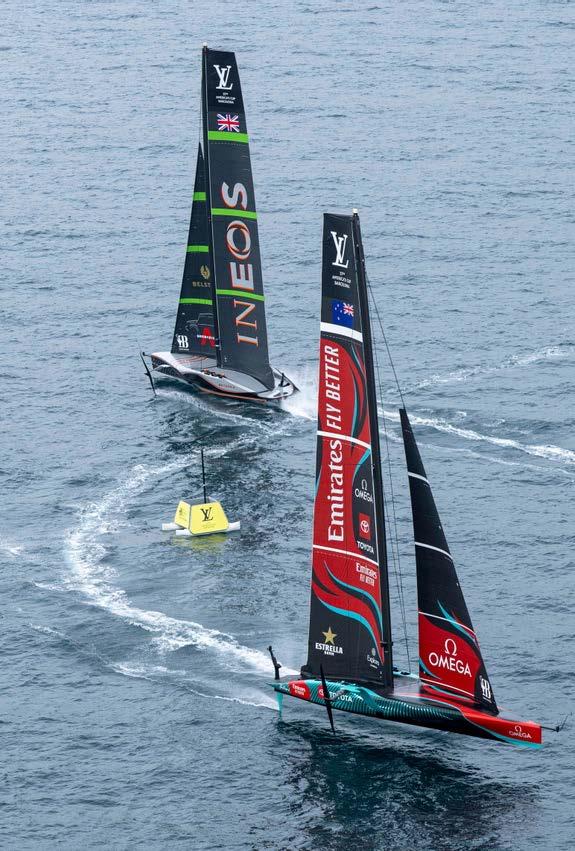
The British were late to the start box, entering with a minute to go and were faced with a determined Kiwi team doing their level best to disrupt airflow, positioning and the ultimate lead back to the line. Emirates Team New Zealand started fast to leeward with separation, leaping forward off the line and by the first tack back had established a lead they would never lose over the next six legs of the course. Showing manoeuvre execution of the highest order, the Kiwis were 24 seconds up at the first mark and despite some spirited downwind comebacks from INEOS Britannia, they extended on every leg and rounded the final windward mark 56 seconds ahead before winning by 41 seconds.
Emirates Team New Zealand 1 INEOS Britannia 0
A fired-up Challenger started with more determination and accuracy but were greeted by an aggressive ETNZ at the start. Tacking right on the starboard marker, the Kiwis headed to the right boundary and a fascinating duel ensued with lead changes aplenty. On a shorter-legged course and more laps (eight in total), manoeuvre execution was tested and the third beat proved decisive, as ETNZ stepped out on INEOS who had been gambling to the right side of the course. The Kiwis bounced the British relentlessly right and bore away. By the finish, they were reading the puffs masterfully and sailing supremely with pitchperfect flight control and smooth execution of their tacks and gybes and eventually crossed the line 27 seconds ahead.
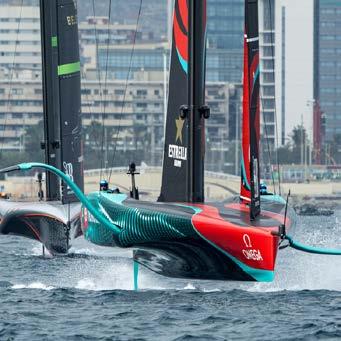
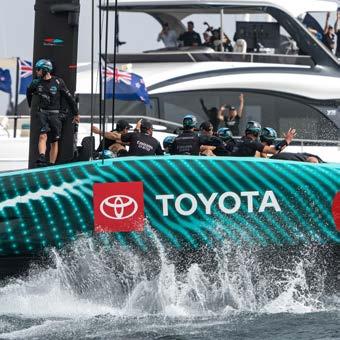
Adopting a different pre-start game plan, INEOS elected to disengage from any potential penalty-inducing close calls and instead trusted the outright speed of their yacht to try to outmuscle the Kiwis in a straight line. It was a tactic that yielded an early lead before they allowed ETNZ to duck and head to the right of the course at the next convergence. The Kiwis eked their way back level before tacking to block the Challenger’s route to the windward gate. What followed was expert frontrunning from Burling and Co., as they made marginal gains at every opportunity and defended tenaciously. ETNZ rounded the final gate 23 seconds ahead before an assured downwind leg saw them triumph by the same time.
Emirates Team New Zealand 2
INEOS Britannia 0
A well-practised move saw ETNZ force a ‘get-back’ penalty of 75 metres on INEOS in the pre-start and it proved to be a hard race to get back into for Sir Ben Ainslie and his team. Try as they might, the British were allowed no leverage as the Kiwis covered tenaciously throughout the three laps of the 27-minute battle. The Defender showed all the assuredness of a champion team at the top of their game, gaining on every leg, and picking the wind pressure beautifully across a tricky easterly facing course that was peppered with pressure patches. Despite showing impressive straight-line speed, INEOS couldn’t recover and as the wind dropped to around seven knots, ETNZ claimed victory by 52 seconds.
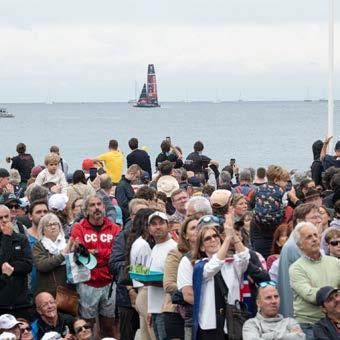
Emirates Team New Zealand 4
INEOS Britannia 0
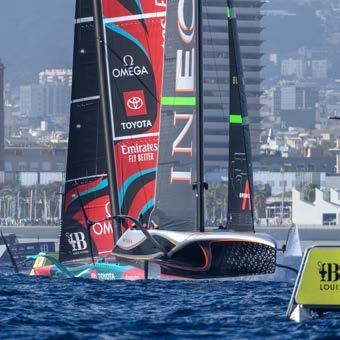
A lumpy sea state and light breeze made it challenging to keep the AC75s flying consistently and ETNZ dialled into the starting box from the port end but without the speed to comfortably cross INEOS’ starboard gybe entry. Their onboard decision to gybe around saw Taihoro drop into displacement mode and the INEOS crew shot out to a lead of over 1,700m before the Kiwis finally got on the foils. The British coaxed and cajoled their boat around the next six legs and by the time they bore away at the final windward mark, they led by over half a leg. They nailed three gybes on the final downwind leg to take their first win by one minute and 18 seconds.
Emirates Team New Zealand 3 INEOS Britannia 0
Emirates Team New Zealand 4
INEOS Britannia 1
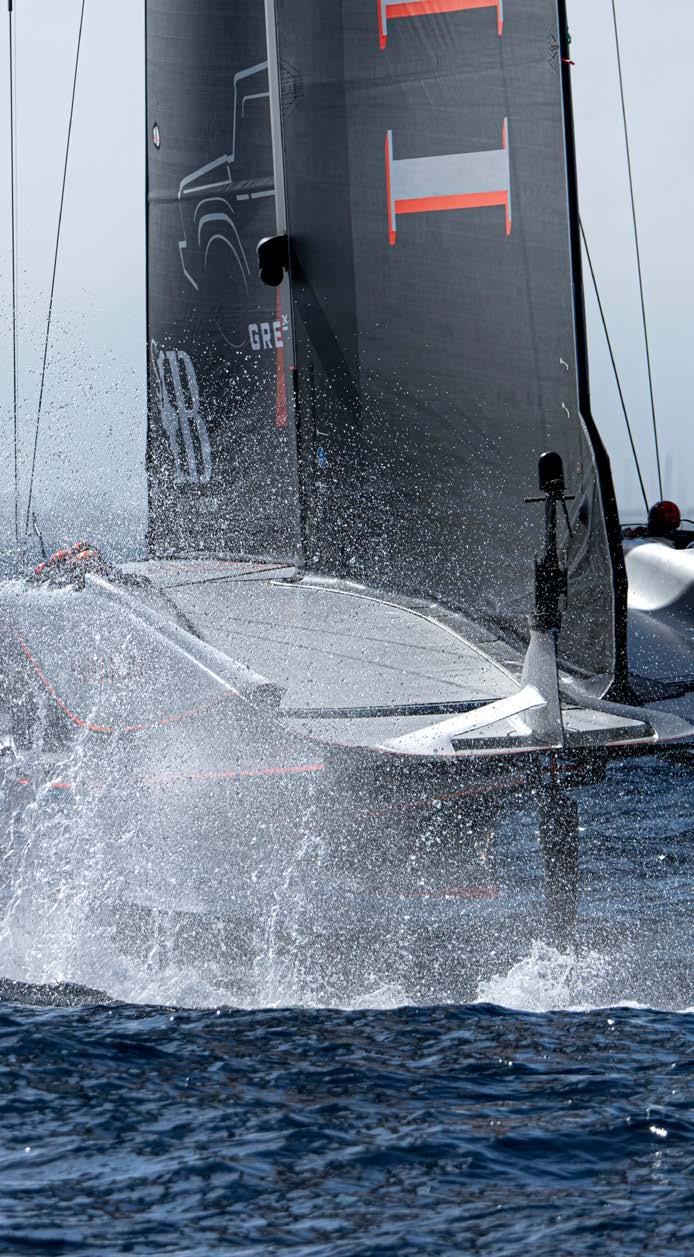
Buoyed by their opening victory, INEOS opted for a high-speed pin-end start and grabbed an early positional advantage. The Kiwis, meanwhile, applied maximum pressure throughout, keeping the delta down to no more than 16 seconds at any gate rounding. An uncharacteristic mistake in the final approaches to the leeward gate cost ETNZ valuable time and distance and made passing difficult. Despite slipping up with one poor touchdown gybe and a couple of slow tacks, the British sailed a textbook match race, minimising their manoeuvres for a hard-fought sevensecond victory. It was the first time since 1934 that they won two races in an America’s Cup Match and halted the Kiwi’s early-series momentum – at least temporarily.
Emirates Team New Zealand 4
INEOS Britannia 2
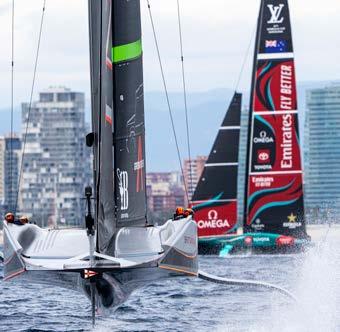
In smoother conditions, Taihoro looked like a different boat, employing a consistent ride height and fast manoeuvres. Sharp turns and fine execution from both teams yielded a fascinating lead-back to the line with the British making the better time-on-distance. Crucially, ETNZ held the windward position and immediately adopted a high mode with a smaller J3 jib. Determined to hold the right, the Kiwis defended hard, first tacking on the bow of Britannia and forcing them left before ignoring the British and heading hard right into a big left shift that secured a lead that was almost insurmountable by the first mark. ETNZ sailed supremely – gaining at each turning gate to cross the finish line one minute and 13 seconds ahead.
Emirates Team New Zealand 5
INEOS Britannia 2
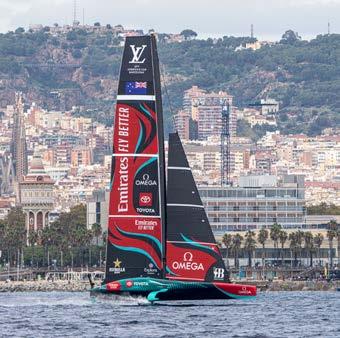
After a pre-start where the New Zealanders maintained a controlling leeward position throughout, Burling nailed the final approach to the line – starting just one metre back at a speed of 38 knots. INEOS, to windward, was first to tack away, but the Kiwis ignored the chance to immediately cover, clicking into more pressure and digging into it before tacking back to the right side. The gain was immediate and by the first gate, they were 15 seconds up and looking imperious. A near-perfect seventh leg, the last upwind, saw ETNZ extend their lead to over 50 seconds and from there they gybed consistently on the pressure builds to record a resounding 55-second victory and move to match point in the Cup Match.
Emirates Team New Zealand 6
INEOS Britannia 2
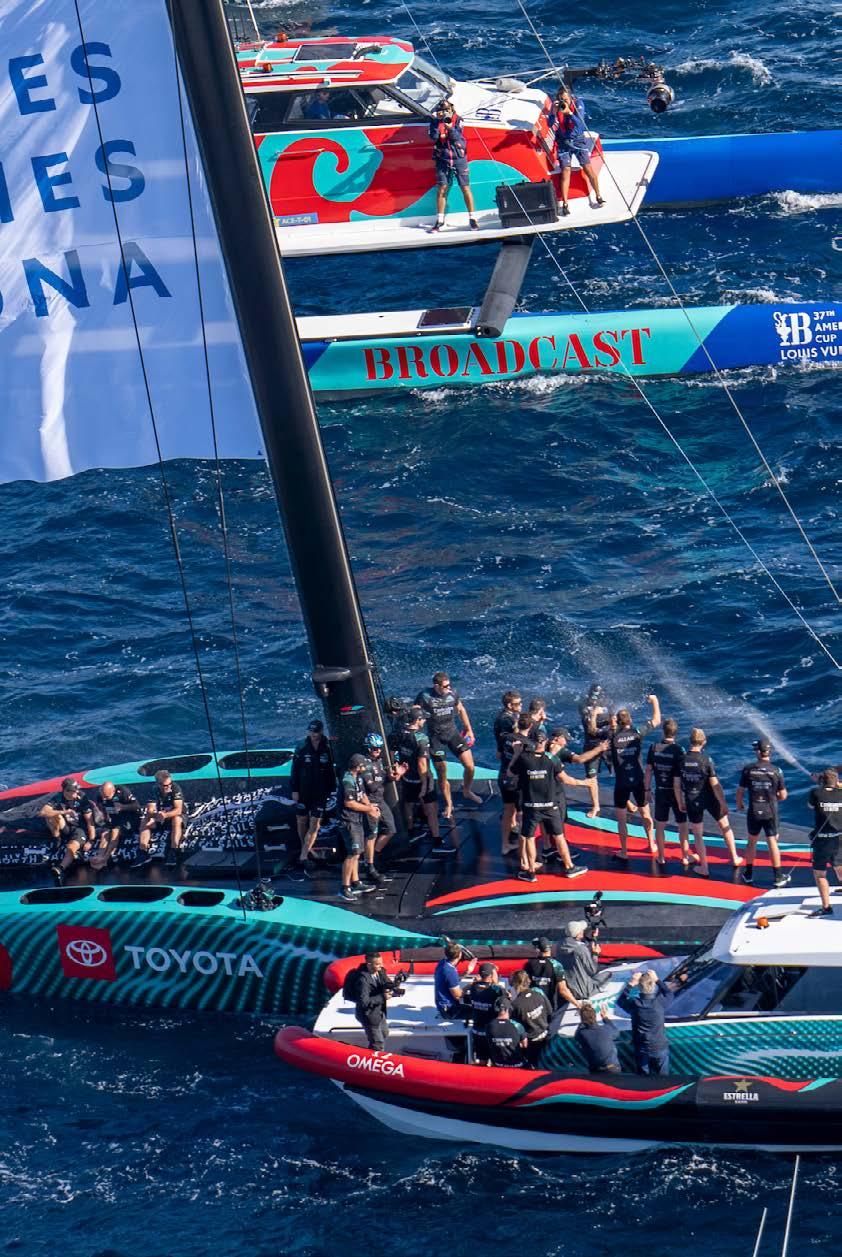
Ignoring the chance to tack immediately after the start and cover INEOS, the canny Kiwi afterguard held on straight, sailing into increased pressure and a favourable shift. A rare miscalculation on the second windward leg saw INEOS draw level before ETNZ came scorching across on port gybe to regain the advantage. Having seen their lead evaporate once, they were in no mood to give it up again and on the final beat, they played it conservatively up the right side, tacking on the British where necessary. It was brilliance combined with boat speed, and after a final downwind leg to the finish, the Kiwis flew down the course before a final gybe on the port layline angled them into the finish line and the history books.
Emirates Team New Zealand win the America’s Cup Match 7-2
Hydraulink has again helped to power Emirates Team New Zealand to America’s Cup glory.
When Taihoro crossed the finish line, 37 seconds ahead of INEOS Britannia in the final race of the America’s Cup Match last month, the record-breaking Emirates Team New Zealand AC75 had Kiwi expertise coursing through its veins.
The New Zealand syndicate rewrote the record books by becoming the first continuous team to win the America’s Cup three times in a row, defeating the British 7-2, and impressing as much with their boat’s speed and performance as they did with their tactical and strategic prowess.
This victory not only ensured that the Auld Mug remained in Kiwi hands but also added another chapter to a decades-long story of successful partnership between two industry leaders.
Kiwi-owned hydraulic hose specialist Hydraulink has supported Emirates Team New Zealand for eight America’s Cup campaigns and helped to power them to victory in Barcelona by providing the “fluid arteries” that ensured the smooth operation of the control systems crucial to their boat’s high-speed manoeuvres. Hydraulink has been supplying hydraulic hoses, components, and fittings to Emirates Team New Zealand
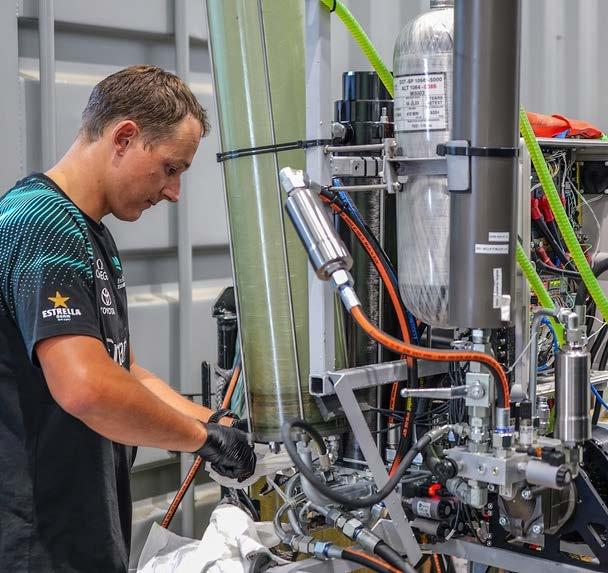
since 1995 and this partnership continued in Barcelona with the supply of all the hydraulic components onboard Taihoro.
It also provided the hoses and fittings for the one-design foil canting systems used on all the AC75s, the AC40s sailed in the Youth and Women’s America’s Cups, and the regattas’ hydrogen-powered chase boats _ totalling over 2000 assemblies during the campaign.
The foil canting systems are essential to raising and lowering the yachts’ massive 1.5-ton foils in under three seconds. The hydraulic power, generated through pedalpowered cyclors, controls crucial functions, including the twin-skinned mainsail and rudder systems. This technology was first introduced by Emirates Team New Zealand in 2017 and has been central to their ongoing success.
Explaining the expertise and innovation required to power these cutting-edge boats, Director of Hydraulink Fluid Connectors Lee Short said: “We are constantly challenged to deliver the lightest, most
powerful, and responsive hydraulic systems to ensure peak performance.
“People see the boats skimming the water at speeds exceeding 50 knots, but inside, it’s a combination of exceptional engineering and local expertise that drives that performance. The hydraulic systems in these boats are on par with the technology found in Formula One cars.”
These are engineering principles shared across several industries supported by Hydraulink - from racing high-performance yachts to heavy industrial equipment, Short said.
“Whether powering a boat, a crane, or earthmoving equipment, the goal is the same – to deliver optimal hydraulic power for maximum efficiency and performance. In competitive environments, there is no room for error.”
Click here to discover more about Hydraulink.
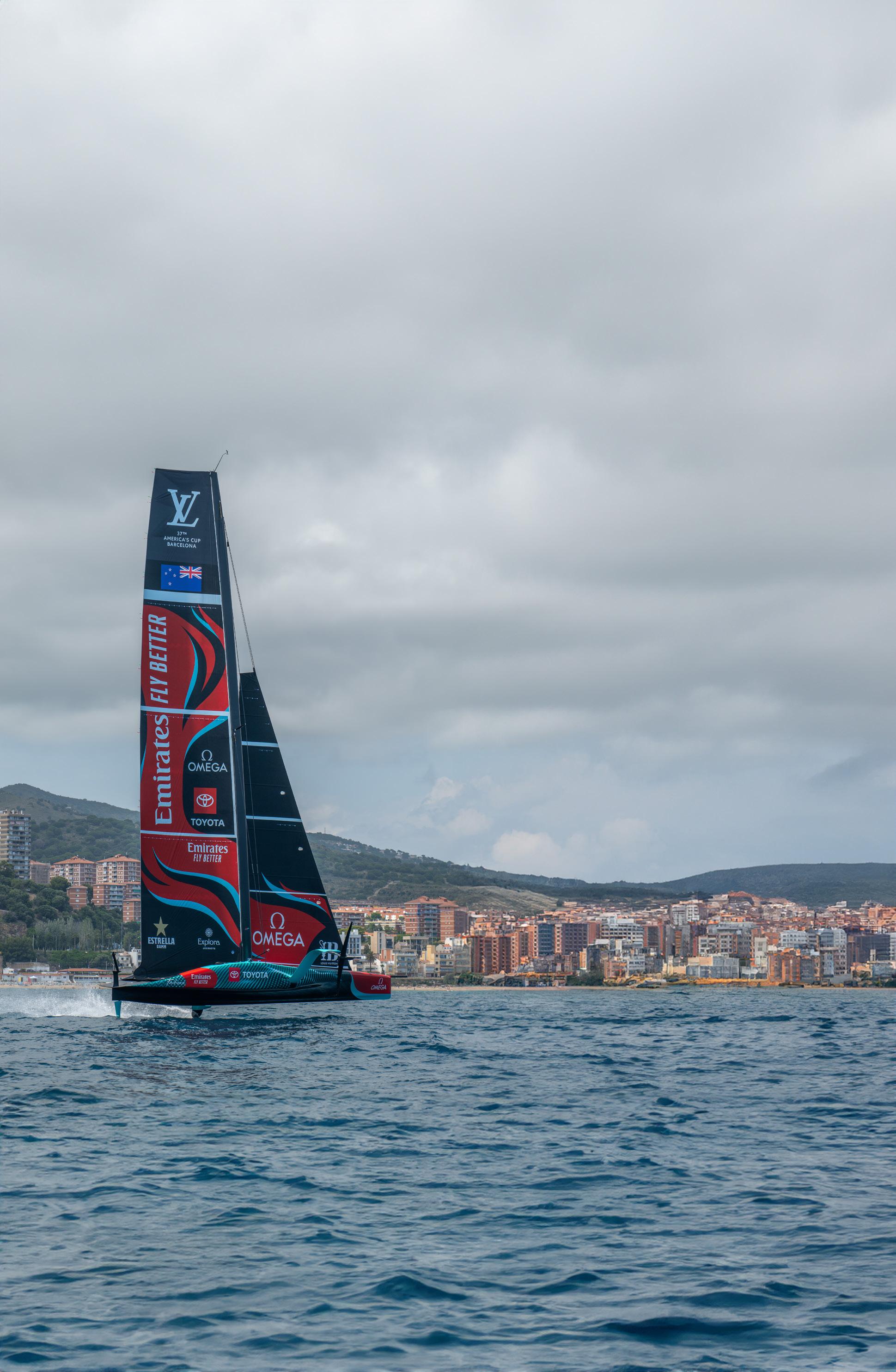




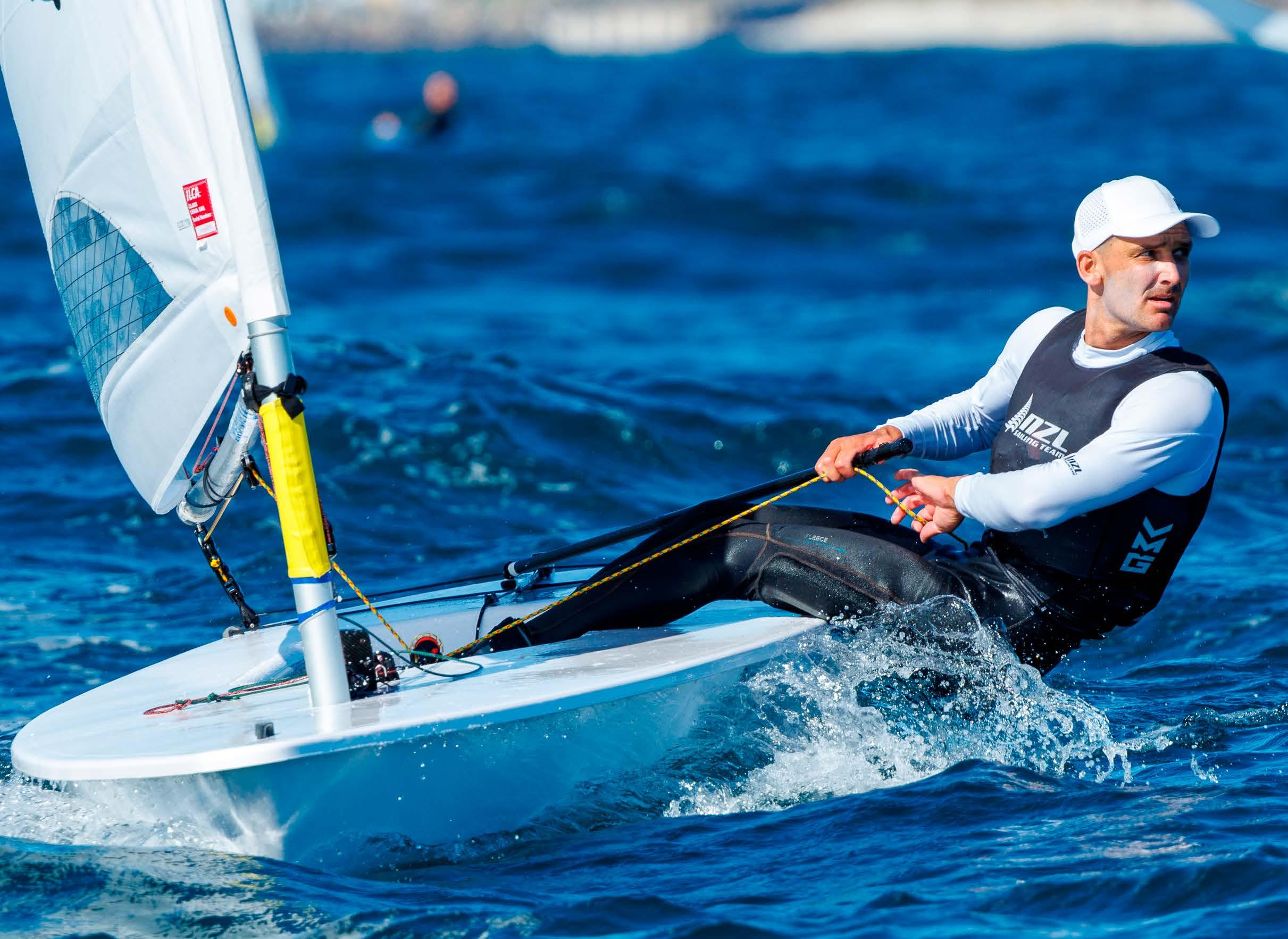
Stars of Paris 2024 share their expertise with the next generation as Yachting New Zealand looks to the future.
The country’s top young sailors have received an Olympic boost through a series of coaching clinics held across New Zealand over the past months, with members of the NZL Sailing Team, who excelled in France earlier this year, sharing their expertise.
These clinics are a key component of Yachting New Zealand’s renewed focus on youth sailing for the upcoming season, building on the excitement generated during the Paris 2024 Olympic Games.
Geoff Woolley, Yachting New Zealand’s talent development manager, said several areas for improvement have been identified to enhance results in youth classes, especially after two consecutive youth
sailing world championships without any medals.
Zach Stibbe was the standout performer at this year’s youth worlds, held at Lake Garda, Italy, in July, finishing fifth in the boys’ ILCA 6. Stibbe was in contention for a medal until the final race, and several other sailors in the 13-strong NZL Sailing Foundation youth team also delivered impressive individual performances.
Notable finishes included boys’ kitefoiler Hugo Wigglesworth (seventh) and Will Leech and Sean Kensington (boys’ 29er, 10th), who all placed in the top 10 in their respective classes.
In the girls’ events, Bella Jenkins and Nicola Hume placed 12th in the 29er, while Tessa Clinton and Jess Handley finished 14th in the 420.
Cam Brown and Alex Norman ended 17th in
Geoff Woolley, Yachting New Zealand’s talent development manager

the boys’ 420. Chloe Turner (girls’ ILCA 6), Jack Parr (boys’ windfoil), and Sofia Currie (girls’ windfoil) all finished just outside the top 20.
“The youth worlds were an unforgettable experience for the sailors and a significant milestone in their sailing careers,”
Woolley said. “Unfortunately, the usual Garda breezes were inconsistent, with uncharacteristically light and shifty winds of under 12 knots throughout. While the results weren’t what we hoped for, many of the younger team members performed at or above expectations, showing great potential for the next two years.”
Woolley commended Stibbe’s efforts. The 18-year-old from Dunedin had also secured a silver medal at Kiel Week in Germany just two weeks before the youth worlds.
“Zach has worked hard over the past two years with a wellstructured training
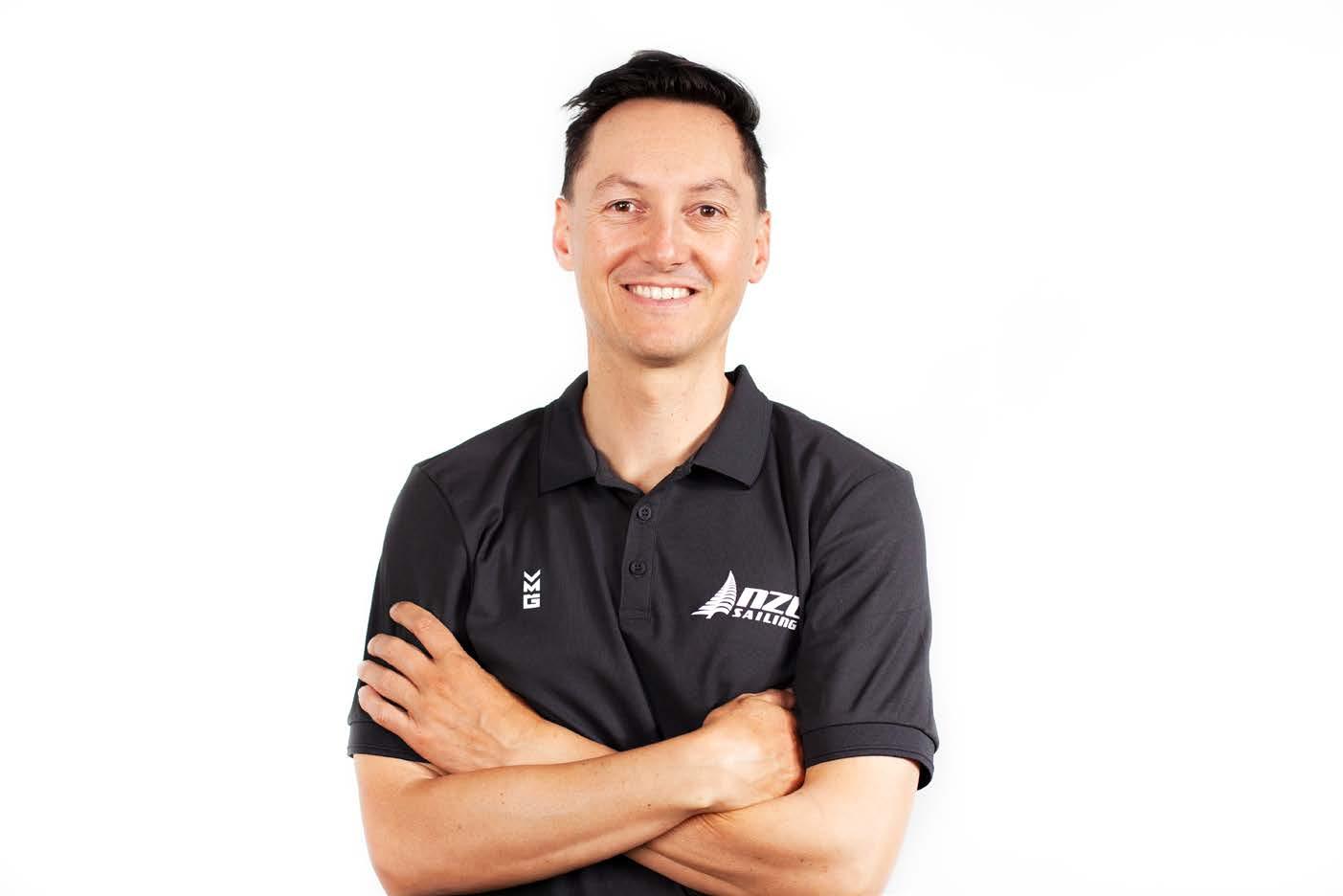
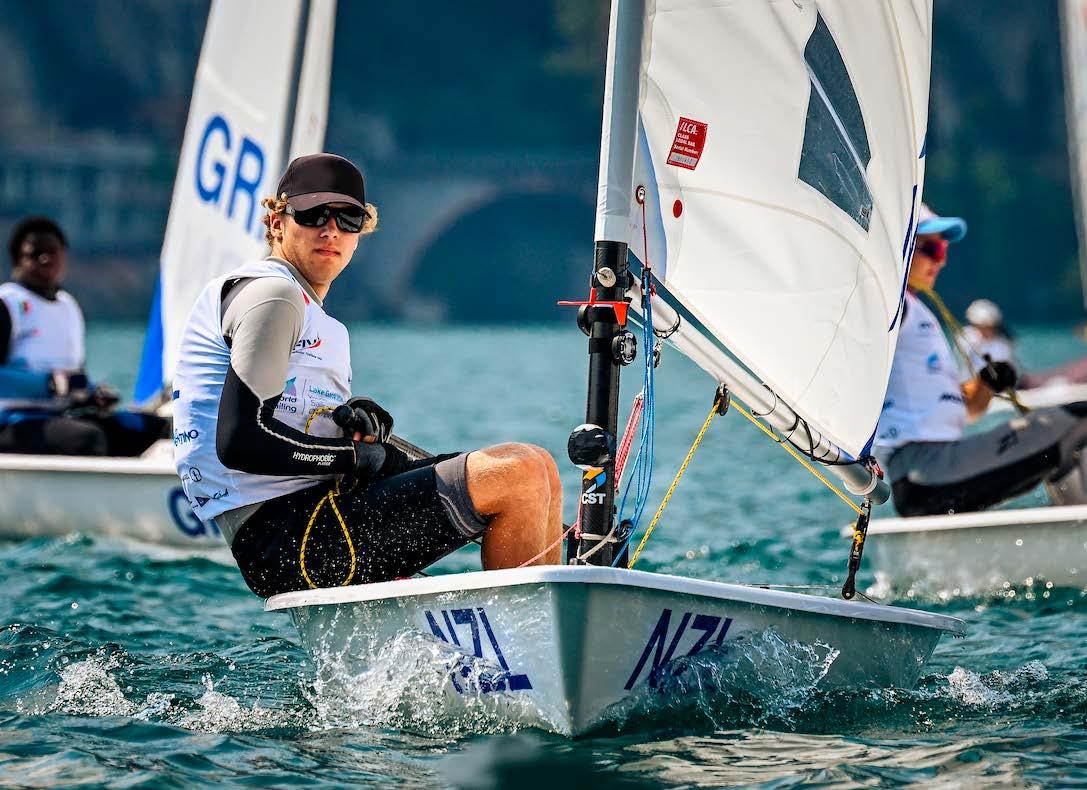
programme and gained valuable experience in Europe at high-quality warm-up events,” Woolley said. “He also received excellent support in New Zealand, training with the ILCA 6 squad under the guidance of Andrew Murdoch, Tom Saunders, and George Gautrey.”
Turner, who is only 15 and began sailing the ILCA 6 earlier this year, is showing strong progress. Clinton and Handley, along with Jenkins and Hume, have also demonstrated promise, given their limited time together in the boat.
“There are 14 months until the next youth worlds, and a lot of hard work lies ahead. We’re looking forward to a busy domestic season and putting in the hours on the water. We have a group of worldclass coaches in place, many with recent Olympic experience from the Paris 2024 cycle,” Woolley said.
“We’ve seen a good group of Optimist and O’pen Skiff sailors competing and achieving excellent results internationally. We look forward to seeing them transition into the youth classes over the next year.”
Preparations are already underway
for next year’s youth world champs in Vilamoura, Portugal, including a series of coaching clinics in Auckland and Christchurch over recent weeks.
The most recent session, part of Yachting New Zealand’s Starling Girls Accelerator Programme, took place at Murrays Bay Sailing Club, with 14 young female sailors participating. Led by Jenny Armstrong, Yachting New Zealand’s women’s sailing manager and ILCA 6 programme lead, the clinic built on the first session held at Royal Akarana Yacht Club in May. The programme focuses on goal setting, fitness, boat setup, tuning and race debriefs, aiming to fast-track development in the single-handed dinghy class and prepare sailors for the Aon national youth programme.
Armstrong, an Olympic gold medallist, was joined by Saunders, who finished seventh in the ILCA 7 class in Marseille in August, and Greta Pilkington, who made her Olympic debut in the ILCA 6 class in France, all of whom shared valuable insights with the young sailors.
Armstrong, along with Woolley, Paul
Snow-Hansen, Markus Somerville, and Sam Mackay, also conducted try-outs for the 420 and 29er classes at Murrays Bay last month, followed by similar sessions for the 49erFX and 470 classes at Royal Akarana Yacht Club. Armstrong and Saunders further hosted a 420 and ILCA 6 clinic at Naval Point Club Lyttelton, while Paris 2024 Olympic medallists Isaac McHardie and Micah Wilkinson spent time with young sailors at several Christchurch clubs.
“The try-outs were a big success, with over 30 junior and youth sailors, including more than 20 girls, participating,” Woolley said. “These sailors are exploring their next steps in double-handed sailing, whether in youth or Olympic classes.”
Woolley added that the try-outs provided an excellent opportunity for sailors to experiment with different boats and roles, as well as sail alongside experienced sailors.
“A key focus is supporting sailors as they transition through various classes and levels, and we plan to hold more of these events in the future,” he said.
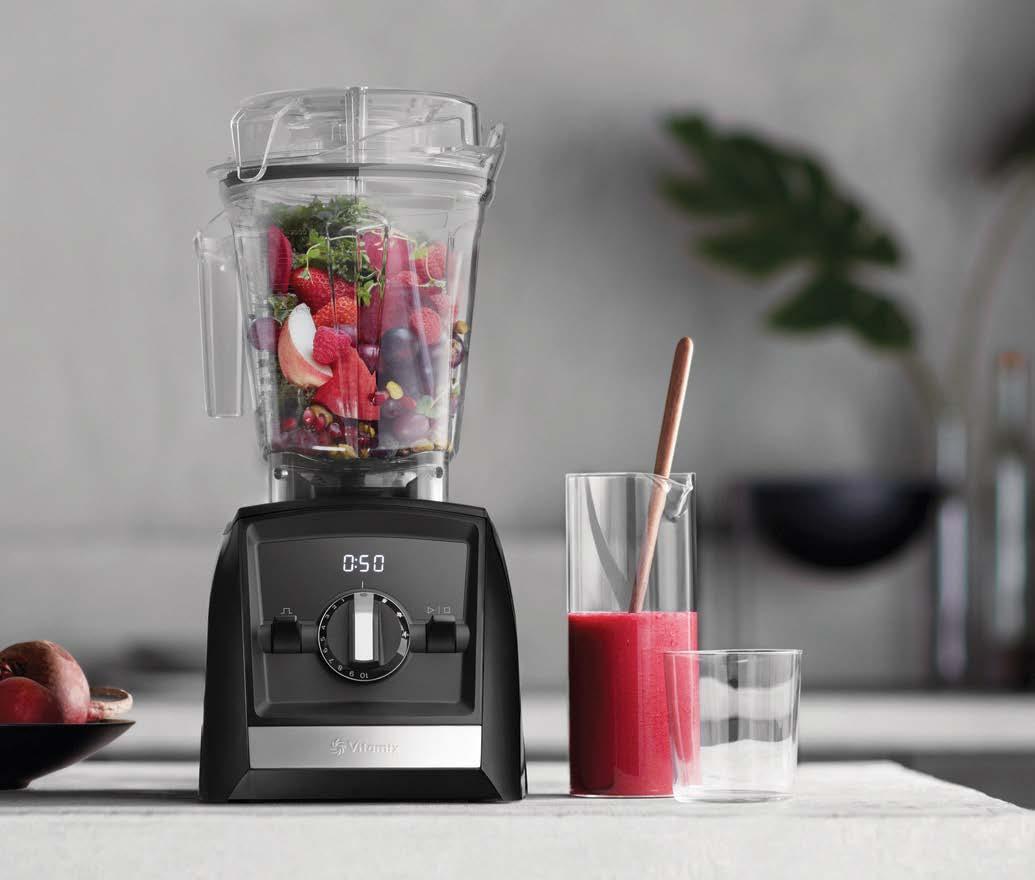

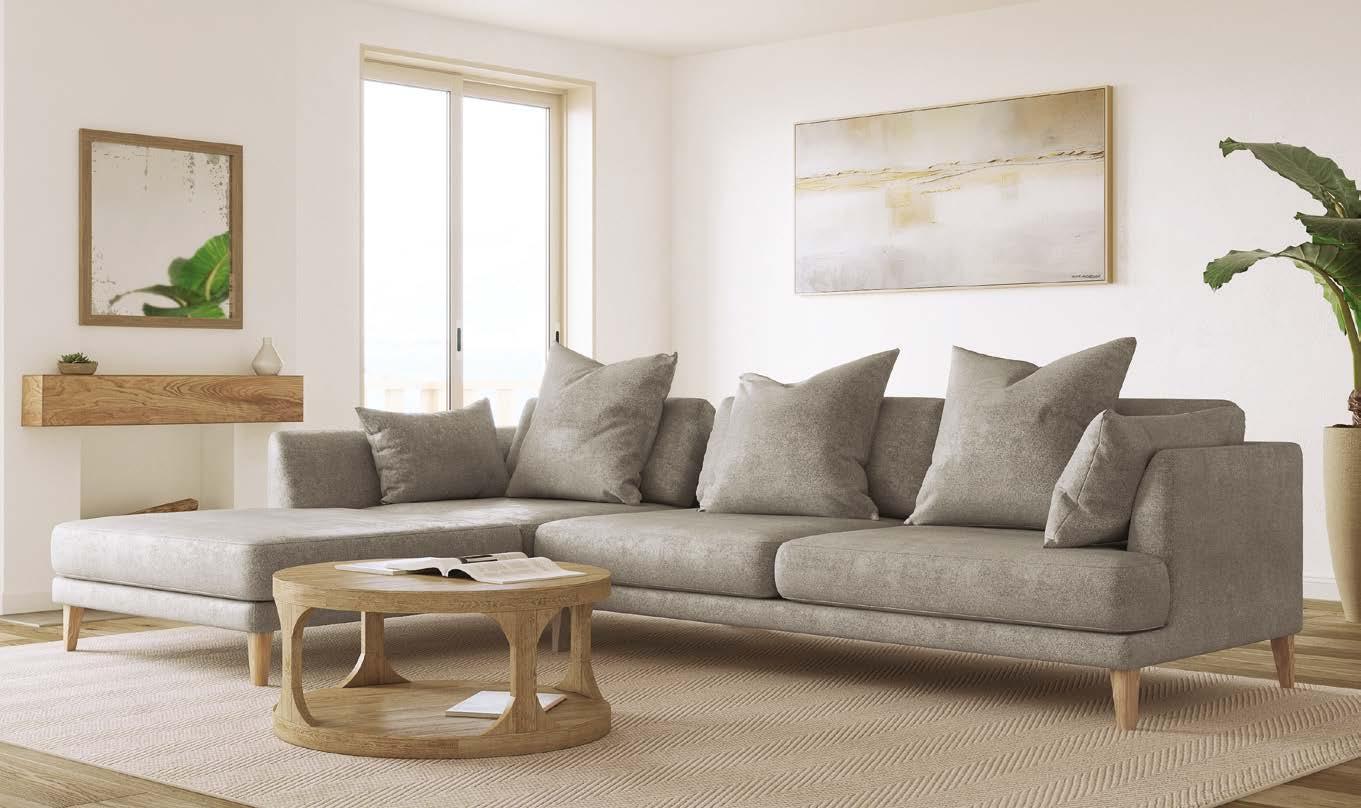

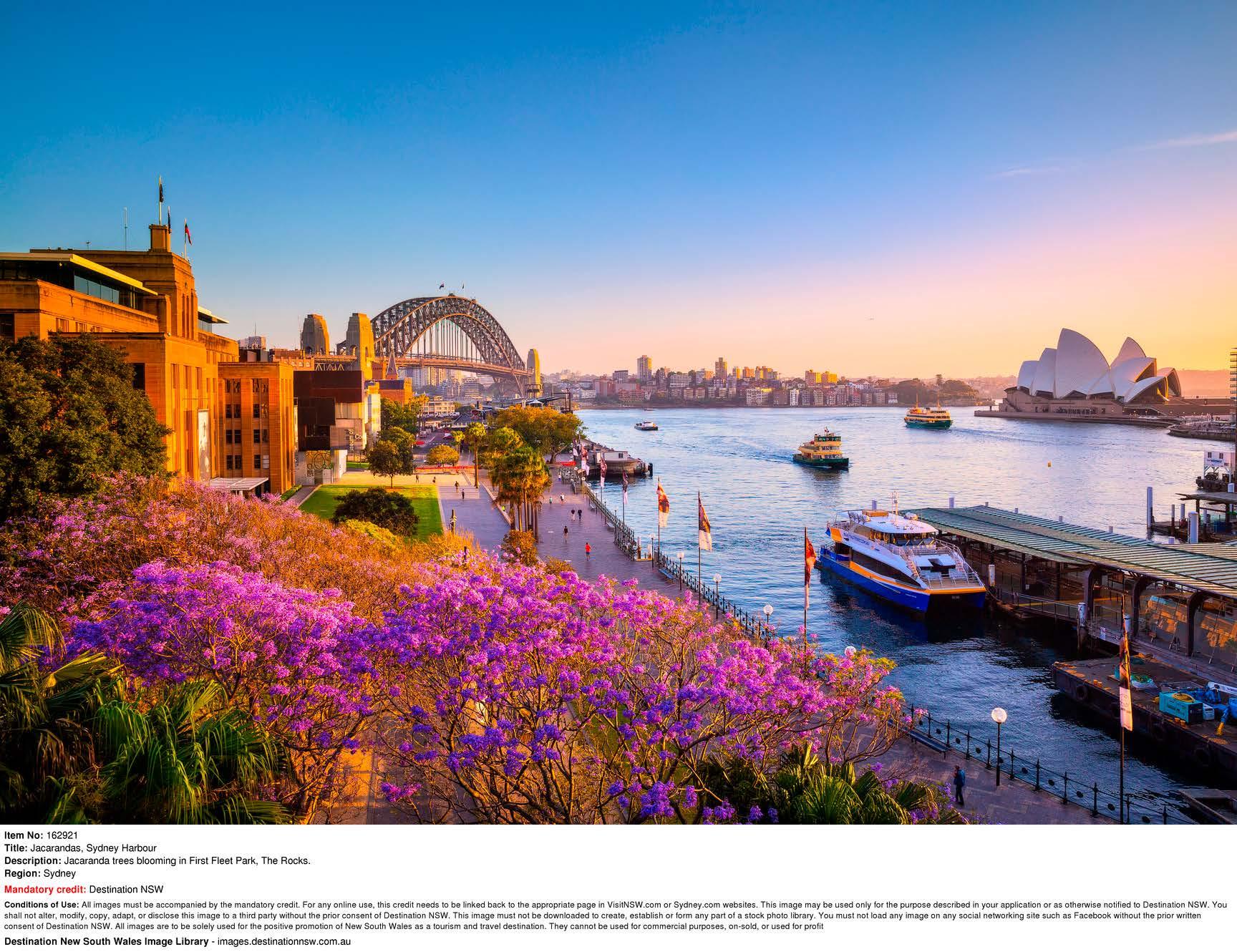
Our dedicated team can tailor-make an unforgettable holiday experience just for you! Whether you’re looking for a family holiday, a city break or a European adventure our experienced consultants can make your personal holidays even better! Speak to one of our advisers ‘face2face’ with our free video consultant services. Our team of globe-trotting gurus can meet you vitually at a time, place and space that works for you



Gavin has a passion for exploring the world He has over 40 years of experience in the travel industry and is committed to making clients travel dreams a reality. He has travelled to South Africa, Indonesia, China, India, Nepal, Malaysia, Maldives, Singapore, Sri Lanka, Vietnam, Australia, UAE, Qatar, Canada, Hawai`i, USA, Fiji, New Caledonia, Austria, Belgium, Germany, England, France, Italy, Netherlands, Scotland and Switzerland.
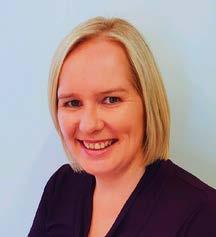
PENNI MCDONALD CRUISE SPECIALIST
Monica loves to help plan her clients travel ensuring to suit their needs She uses some of her personal experiences to enhance her clients travel as well Monica enjoys listening to her clients trip highlights to understand them better and enhance their next travel too Monica has travelled to USA, India, Africa Italy, Greece Hawai`i, Fiji, Australia and Malta

Silvana has worked in the travel industry since 1999 She was born in Brazil and moved to New Zealand in 2004 She enjoys turning holiday dreams into reality assisting clients to create their perfect holiday. Her passion for travel is reflected in her own journeys by travelling to China, Australia, UAE, the Caribbean, Hawai`i, Fiji, Cook Islands, Samoa, Tahiti, Vanuatu, Spain/Portugal, Ireland, England, France and Italy
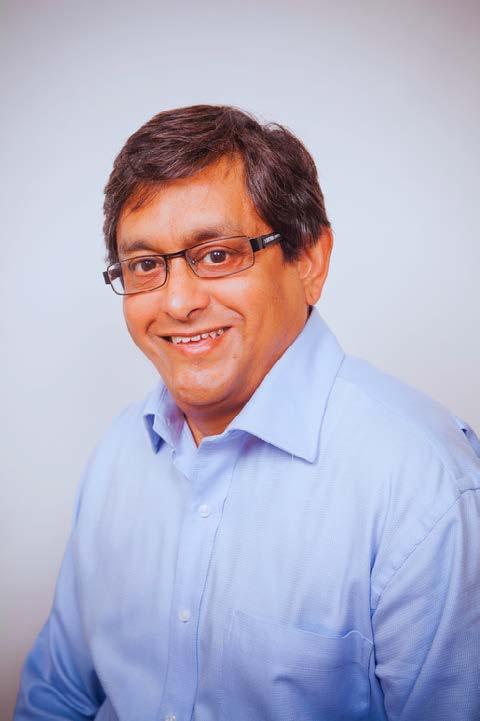
Penni is the resident cruise specialist with 11 cruises and inspections of a further 20 ships She specialises in river cruises on the Nile, Danube and Rhone and ocean cruises in the South Pacific, Caribbean and NZ Her favourite way to travel is by ship Penni has travelled to Singapore, Australia, UAE, Egypt, Hawai`i, USA, Fiji, New Caledonia, Samoa, Austria, Czech Republic, Germany, England, France and Scotland
MONICA SAWANT RETAIL MANAGER
Bring your ideas in to House of Travel and we’ll help you get there!


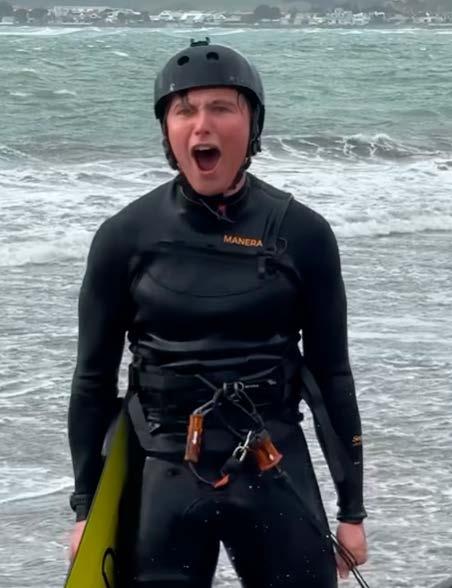
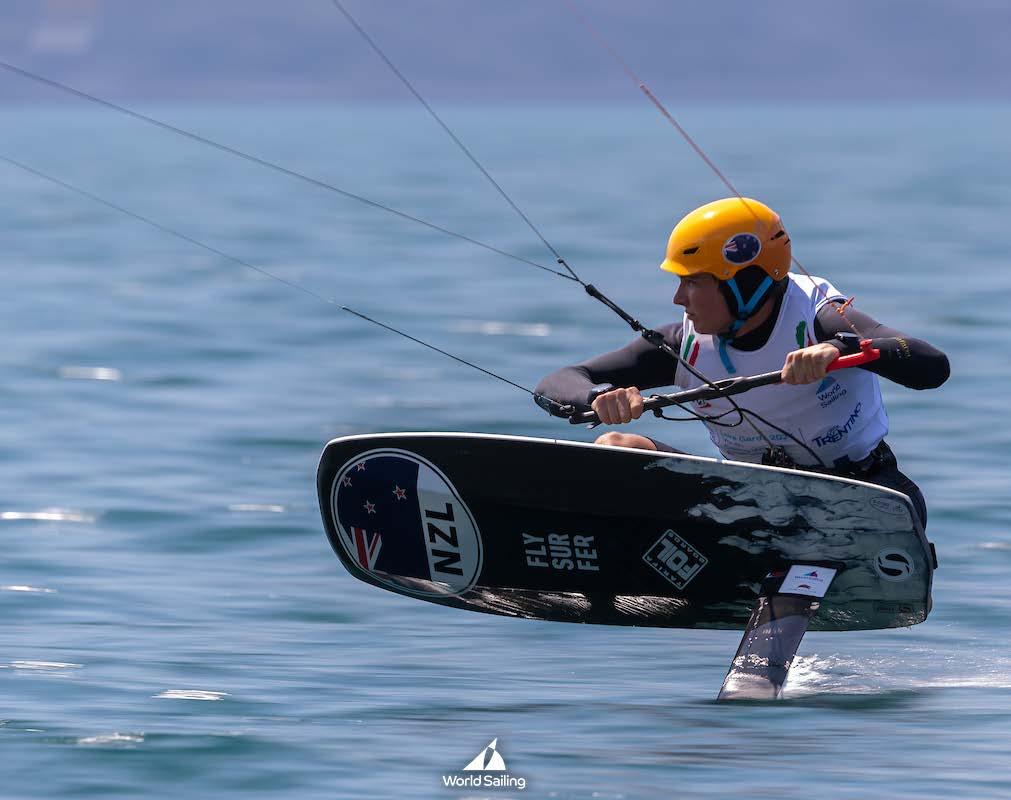


New Zealand’s budding sailors will once again have the chance to rub shoulders with the best in the world when SailGP makes its Auckland debut early next year.
Dozens of RS Feva sailors will be part of the latest instalment of the award-winning SailGP Inspire programme, returning for the ITM New Zealand SailGP Auckland event from January 16-19.
Launched in SailGP’s inaugural season in 2019, Inspire is the league’s community, education, and outreach initiative. Delivered at venues worldwide, the programme has engaged nearly 20,000 young people to date. The first New Zealand event, hosted in Christchurch in 2023, highlighted the programme’s local impact, with 665 young people from the Canterbury region taking part.
Last year, Feva sailors from local clubs were selected to compete at the event,
alongside competitors in the Waszp and wingfoiling classes. Wānaka Yacht Club’s Mabel North and Madison Smith were crowned overall winners after beating Tom Peters and Josh Dixon (Royal Akarana Yacht Club, second) and Ben Catton and Caleb Perano (Charteris Bay Yacht Club, third). The races took place on the same course used by New Zealand SailGP’s Peter Burling and his teammates aboard their flying F50s.
Participants in the programme must be 16 or younger and selected athletes will race on the F50 course in front of packed home crowds in Auckland.
set to be announced soon. Four days of action-packed racing, hosted by the Royal Akarana Yacht Club, await the lucky competitors.

Entries for the 2025 event have just closed, with the final lineup of 50 crews
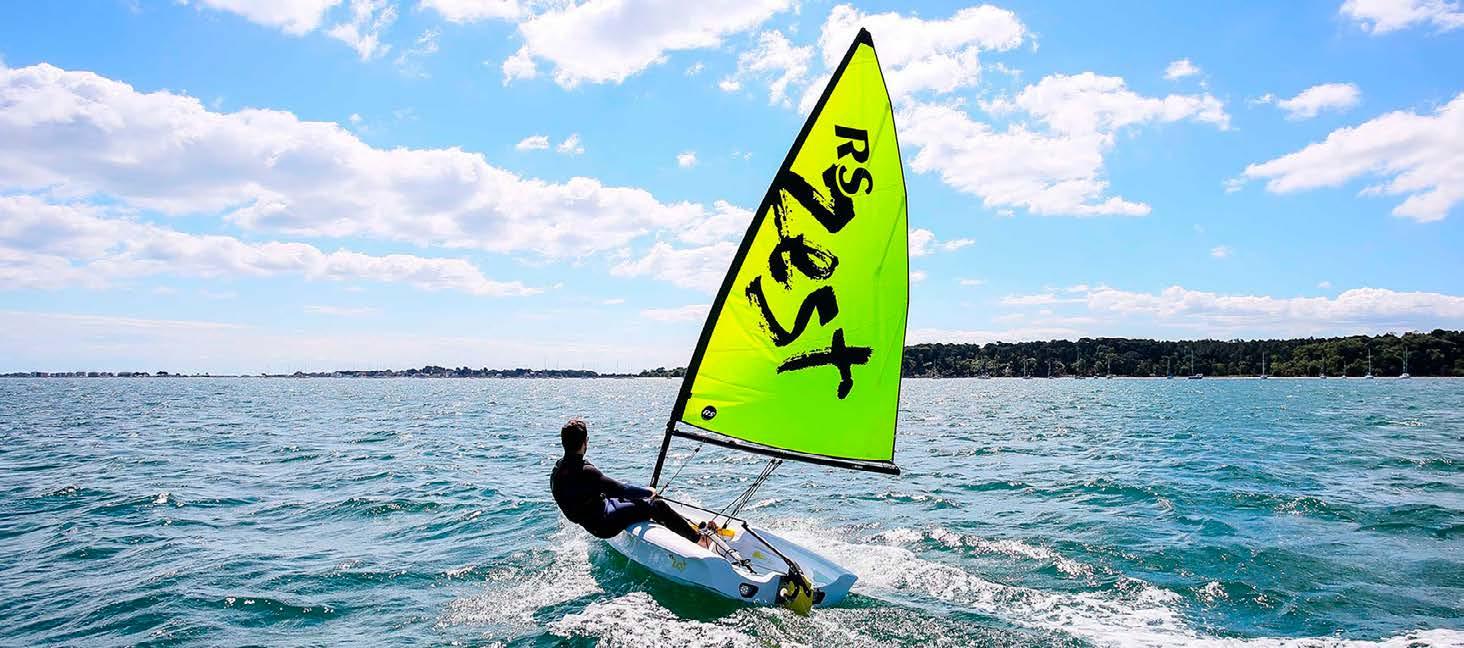

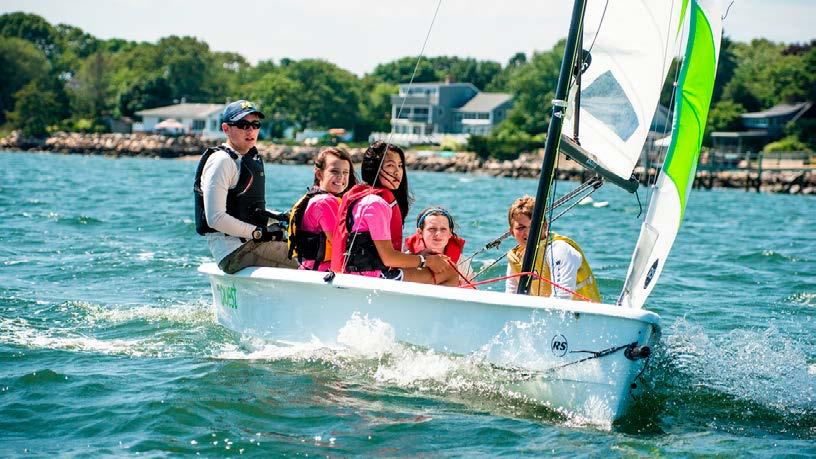
The event will also provide excellent build-up for the class national championships to be hosted by Murrays Bay Sailing Club on May 10-11.
The RS Feva is the world’s leading double handed dinghy for youngsters and parent/ child teams and is an international class with events around the globe. It is fast-growing in most developed sailing nations and expanding into others every year.
Its modern styling and practical features has made it the boat of choice for thousands around the globe.

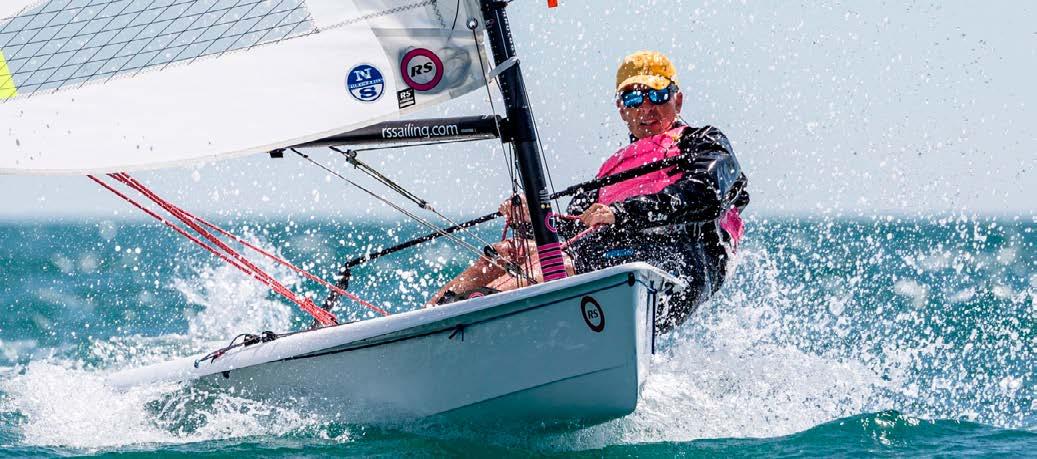
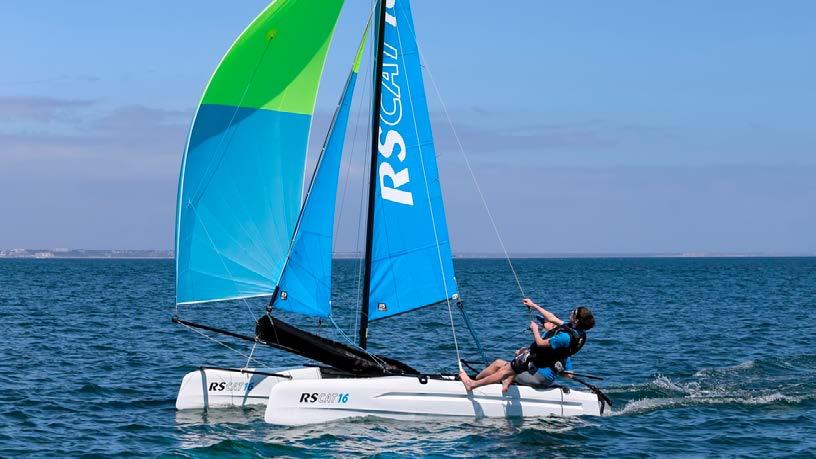
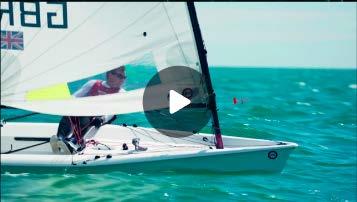
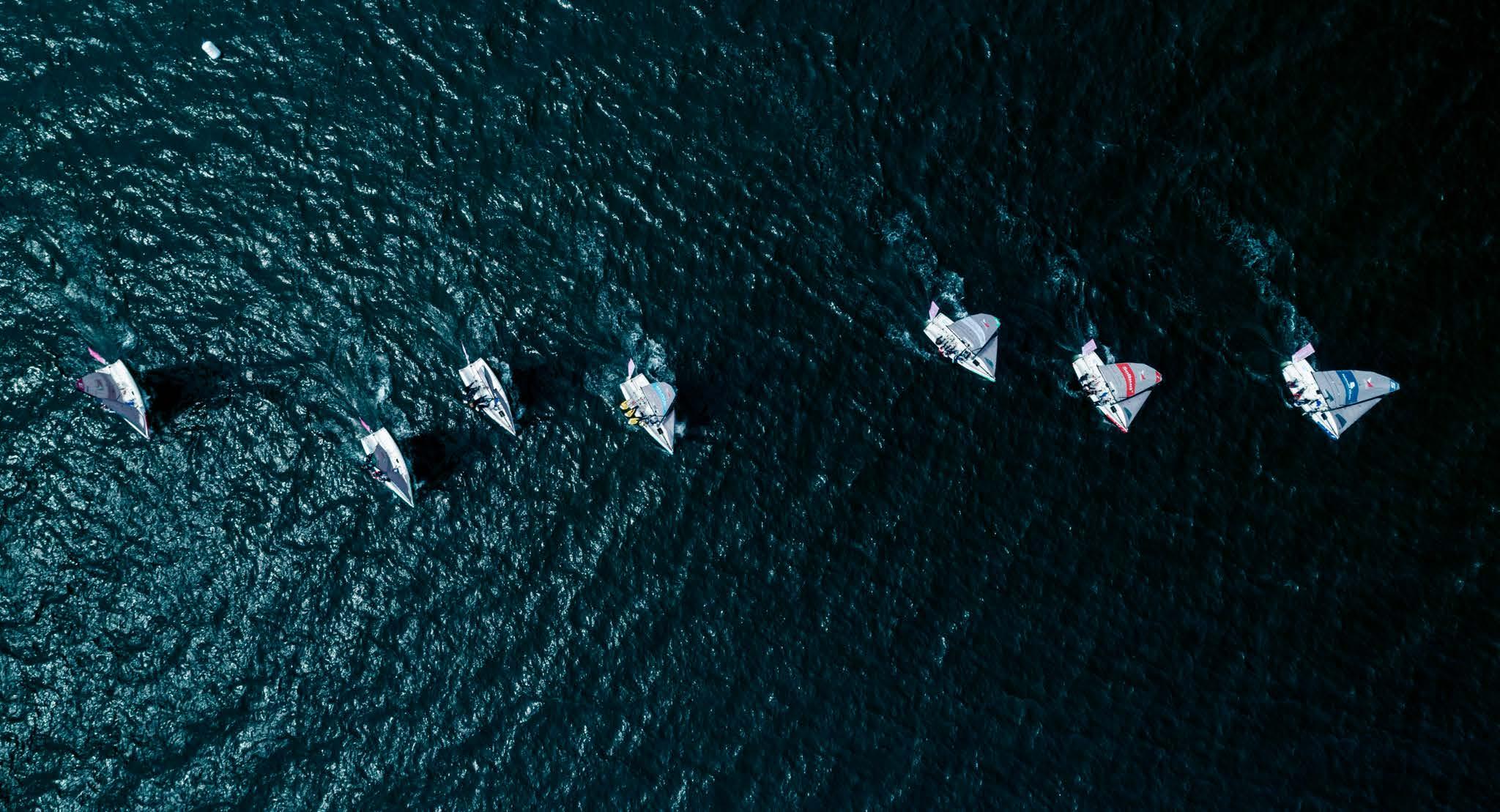

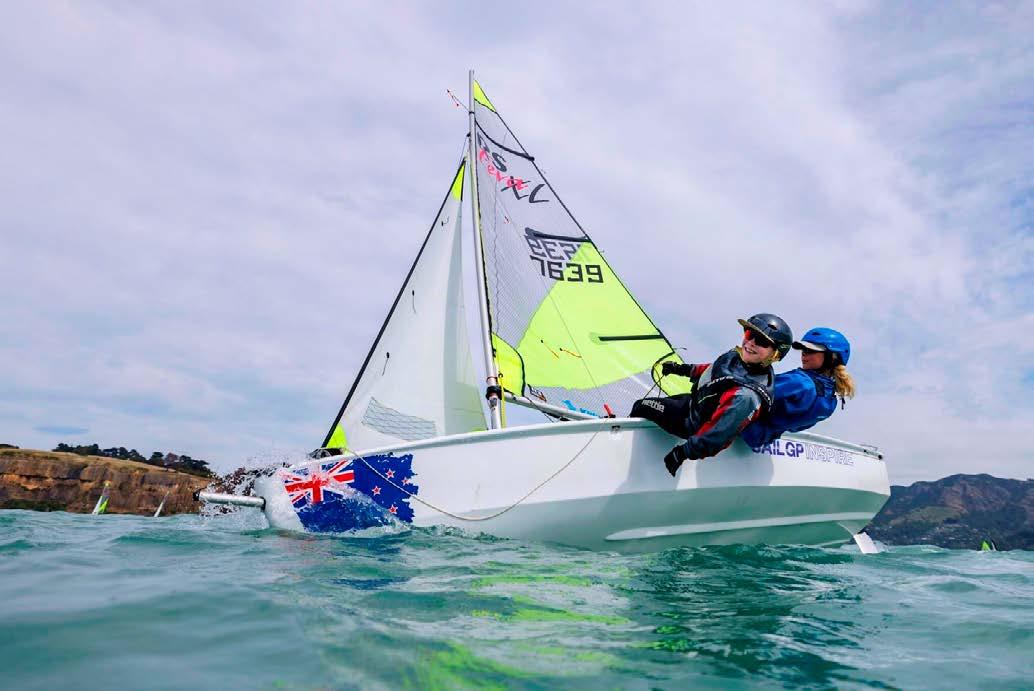
18 months after being denied the title of Moth world champion, Jake Pye finally gets another chance.
By the time the 2024 Moth world championships arrive, Jake Pye will have waited 18 months for another shot at the title.
And he plans to make it well worth the wait.
The 19-year-old Manly Sailing Club sailor will be one of the favourites for the world championships, held at his home club in late December and early January, after being thwarted by Mother Nature at the 2023 event.
Pye was leading after two races at the Weymouth and Portland National Sailing Academy last June before light winds
caused the regatta to be abandoned without an official result.
He had been in dominant form leading into the event, having won the International Moth UK open championships – the preworlds – at the same venue just days earlier.
Now, as one of around 80 confirmed entries for the 2024 edition, Pye has spent the past year-and-a-half working to improve his chances.
In January, he successfully defended his title at the Moth national championships, also held at Manly – the crown he first claimed a year earlier by winning 13 out of 18 races against a fleet packed with international talent.
This time, he held off a strong challenge from Manly teammate Mattias Coutts, who finished second by just one point.
A week after lifting the trophy, Pye found himself helming the Shaw 750F Animal Biscuits in the Bay of Islands Sailing Week –his first taste of big-boat racing.
He stepped in for owner and regular skipper Craig Partridge, and, alongside Craig Gurnell and Matt Randall, sailed Animal Biscuits in the 13-strong sports boats division, winning all but one of the races.
"I've spent most of this year training in the Moth and doing a bit of wingfoil testing for North Foils," Pye said.
"Over the past couple of months, I've really upped the tempo, and I'm sailing the Moth every chance I get, mostly with the core group at Manly."
Ensuring his equipment will be competitive when racing starts on December 30 has also been a key focus for Pye.
"I've been making sure the boat is up to scratch with the latest equipment, and that all the systems are working well and are durable. Alongside my sailing training, I'm also doing a lot of physical training – body conditioning to allow me to perform and
6 to watch
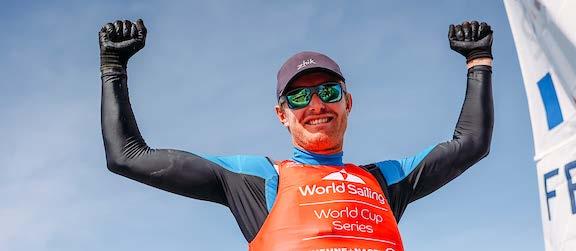
Jean-Baptiste Bernaz
Five-time Olympian and ILCA 7 world champion. Second to Jake Pye at the 2023 Moth world champs.
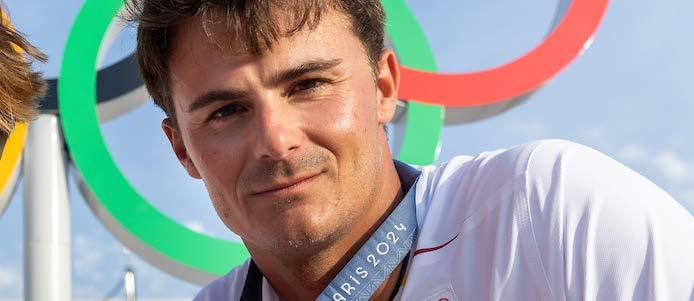
Diego Botin
Olympic gold medallist in the 49er at Paris 2024, and a driver for the Spain SailGP team.
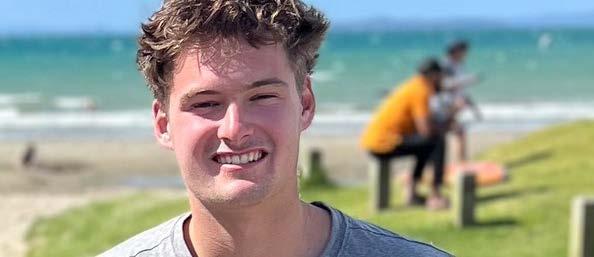
Mattias Coutts
A rising star in NZ sailing and the runner-up at the 2024 Moth national championships.

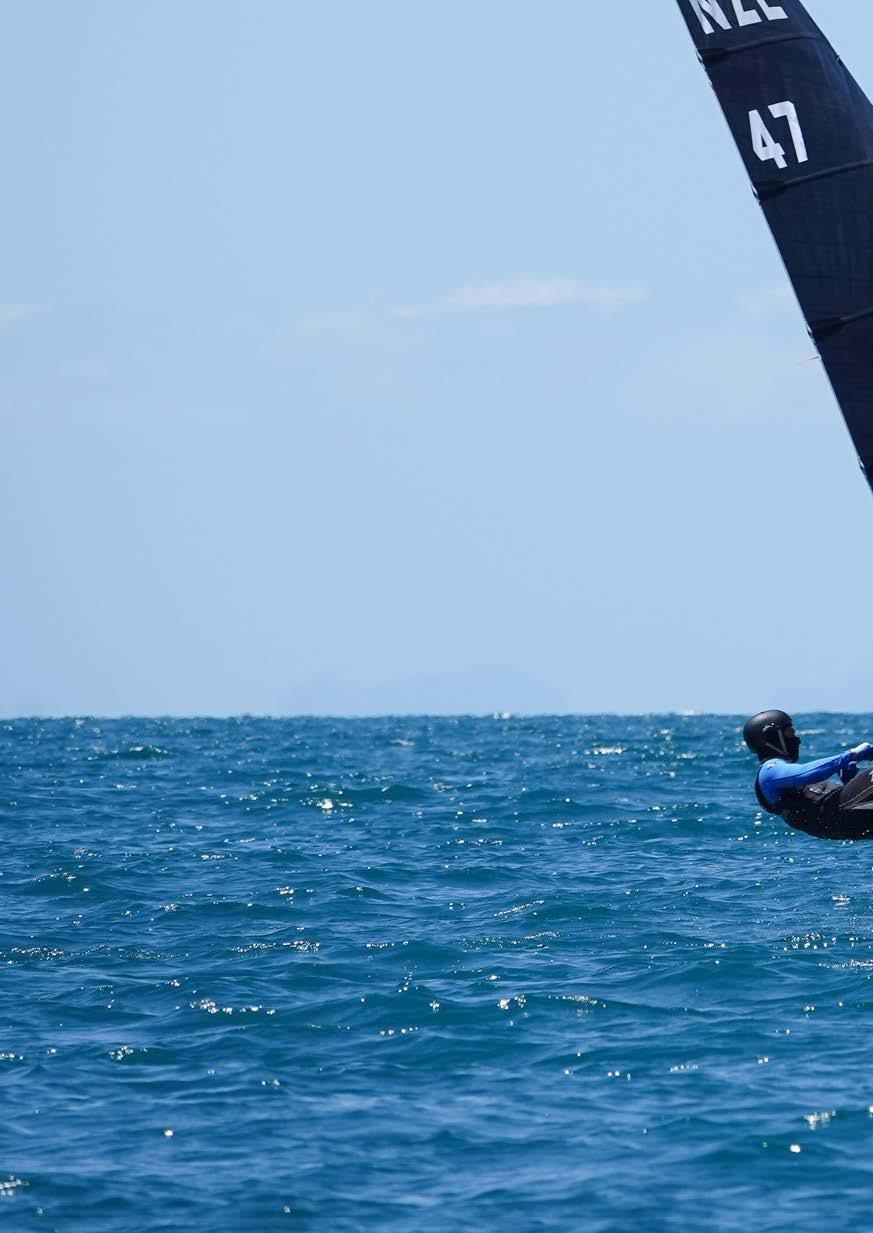
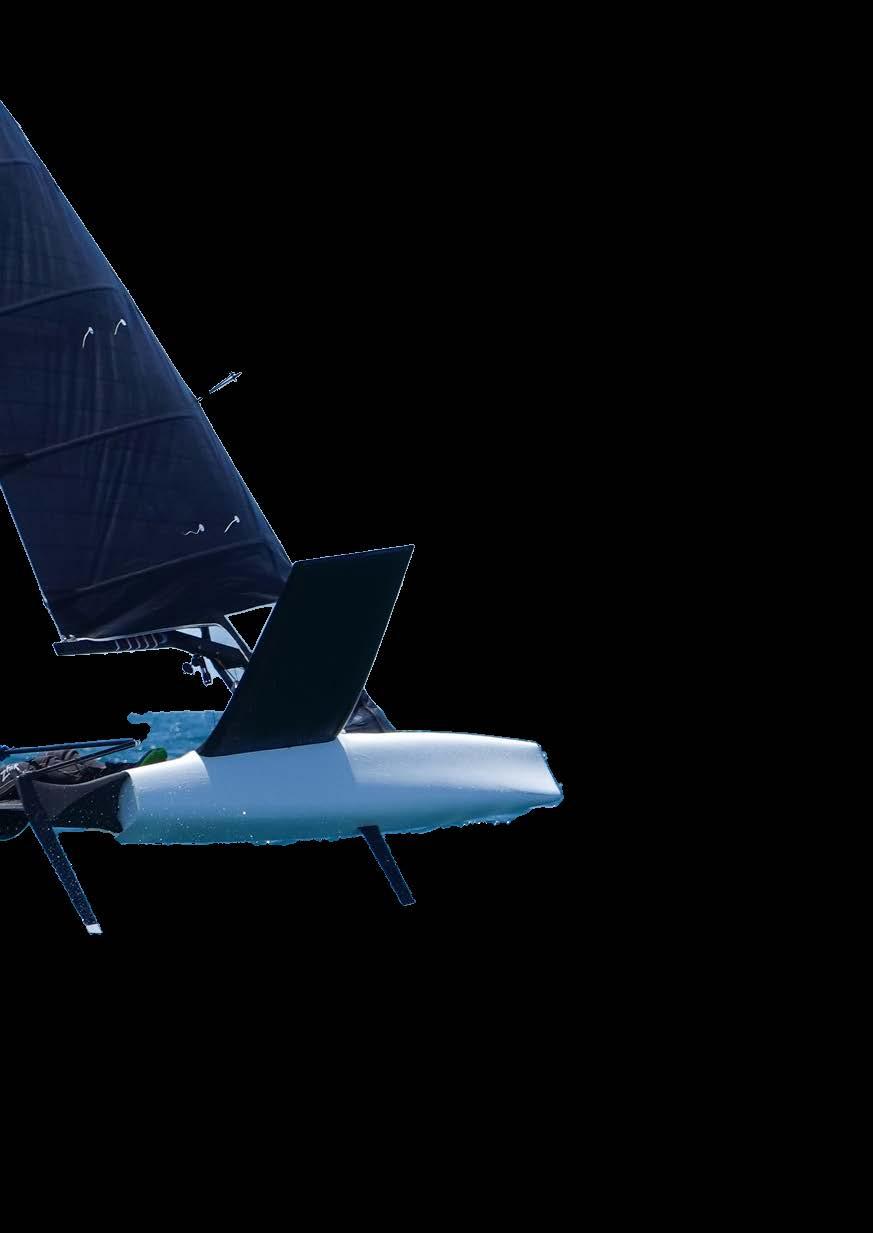
After nearly paying the ultimate price in the 2016 Vendée Globe, Kiwi Conrad Colman is back for more.
Eight years ago, Conrad Colman was in grave danger.
The Kiwi sailor was participating in the prestigious Vendée Globe, the non-stop solo round the world yacht race which is one of the world’s most extreme sporting challenges. An event that takes years of preparation, it requires intense mental fortitude, and a complete sailor versed in every facet of the sport to even make the start line, let alone finish the gruelling race.
And didn’t Colman know it. Here he was, bobbing along in the Atlantic Ocean in a boat whose mast had been destroyed, still several days away from land, and with a grand total of two biscuits to survive on.
Colman, who was endeavouring to become the first sailor to complete the
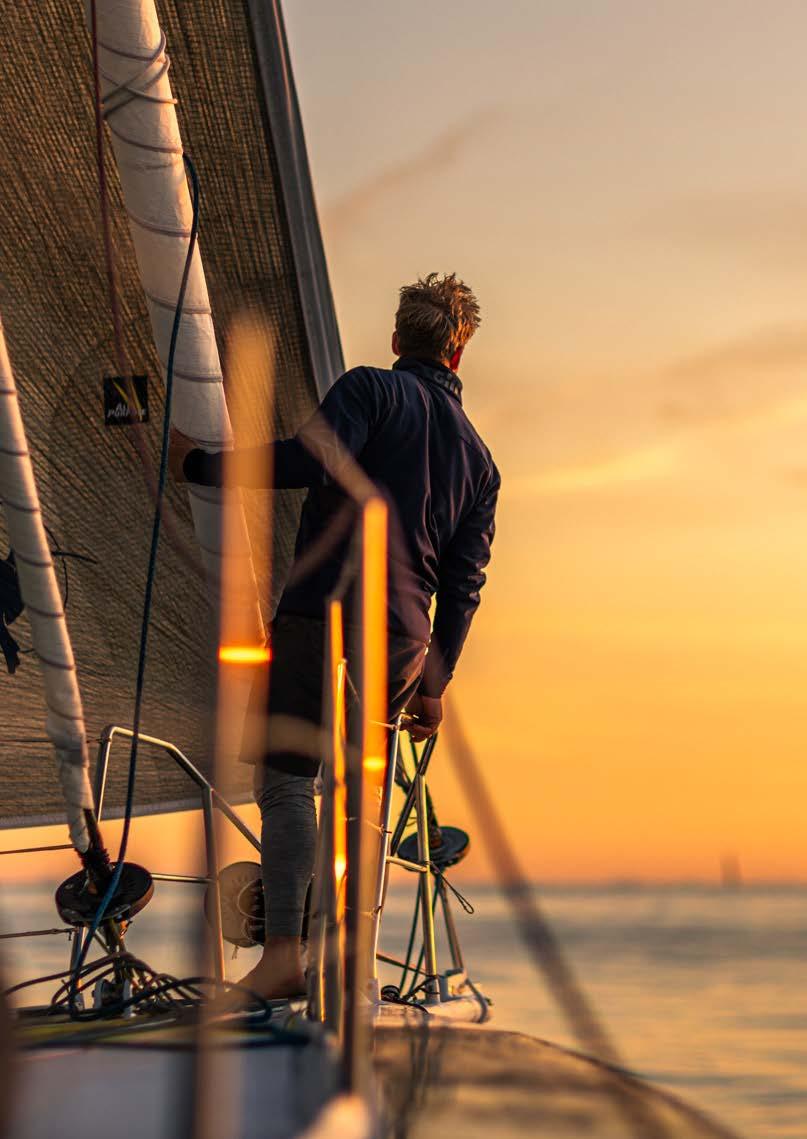
famous race without using fossil fuels, had set off with high hopes, but faced some tough times on his 27,000-nautical mile journey, having to frantically put out an electrical fire and seeing the brutal conditions battering his sails, leading to one particularly taxing 12-hour period where he had to climb his mast three times.
But if that wasn’t hard enough, just as he was heading for shore and the prize of the finish line, disaster struck. With 740 miles to go, Colman’s mast snapped, forcing him to construct a remarkable jury rig in order to continue. With his speed having plummeted as a result, what should have been a three-day jaunt to the finish line turned into a two-week slog, with the committed Kiwi having to resort to rationing survival food from his life raft.
But, fuelled on by a biscuit per day diet that powered his last few days of sailing, Colman made it to the finish line after 110 days, making history after an overwhelming journey that saw him dice with death on several occasions; a journey that tested every conceivable sailing skill, and, most importantly, his inner strength and resolve.
Now, eight years on, it’s time to do it all again.

The Vendée Globe is raced every four years, with the 2024 edition – the 10th – starting and finishing in Les Sablesd’Olonne, France.
Forty skippers are set to take to the start line on November 10, with Colman’s return coming after he missed the 2020 race –an understandable decision, one might suggest, given the harrowing experiences of the 2016 edition.
Well, not quite.
“Even before I finished the last race, I was already dreaming about doing the next one,” says Colman, who, if you haven’t
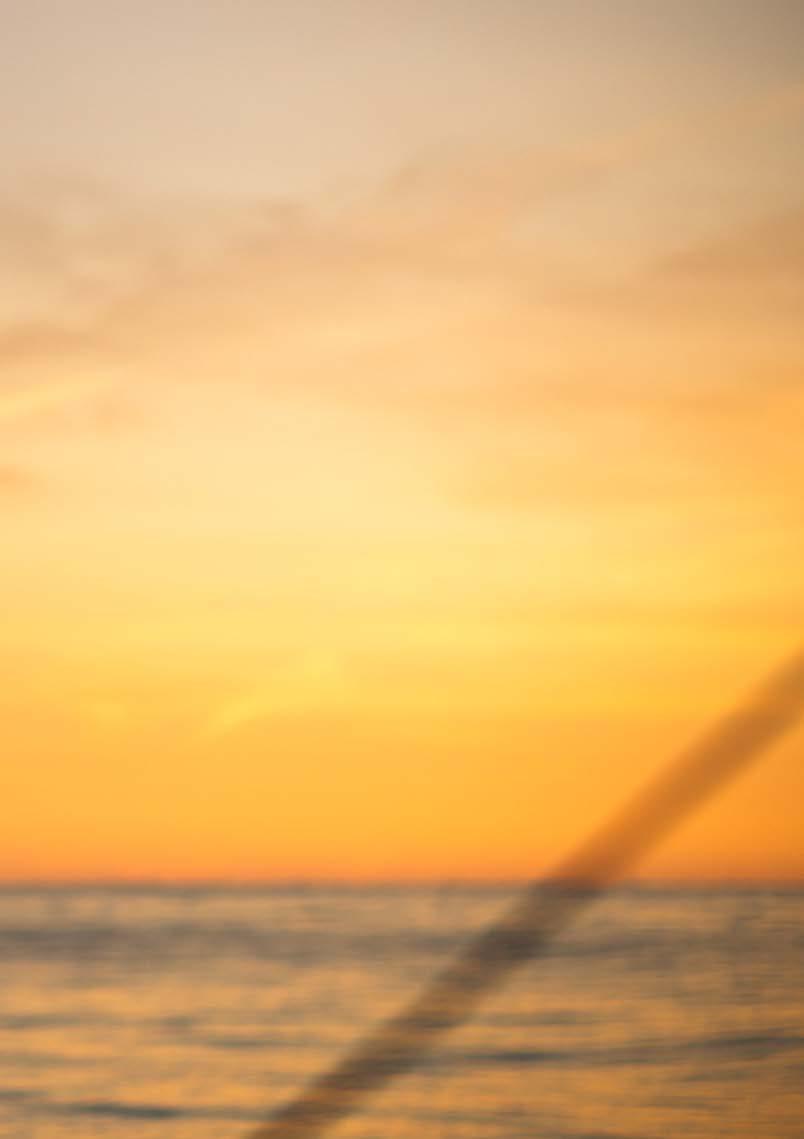
gathered by now, is not your traditional sailor.
His reasons for skipping an edition were not because of broken masts, fires, or massive waves, but perhaps an even more scary proposition – finances.
“I couldn’t quite get the full budget together. When Covid came I was super close to signing a budget that was necessary, but with the uncertainty relating to Covid it all went up in smoke, so that was a shame.”
Indeed, the near-death experiences and intense difficulty of the nearly four-month
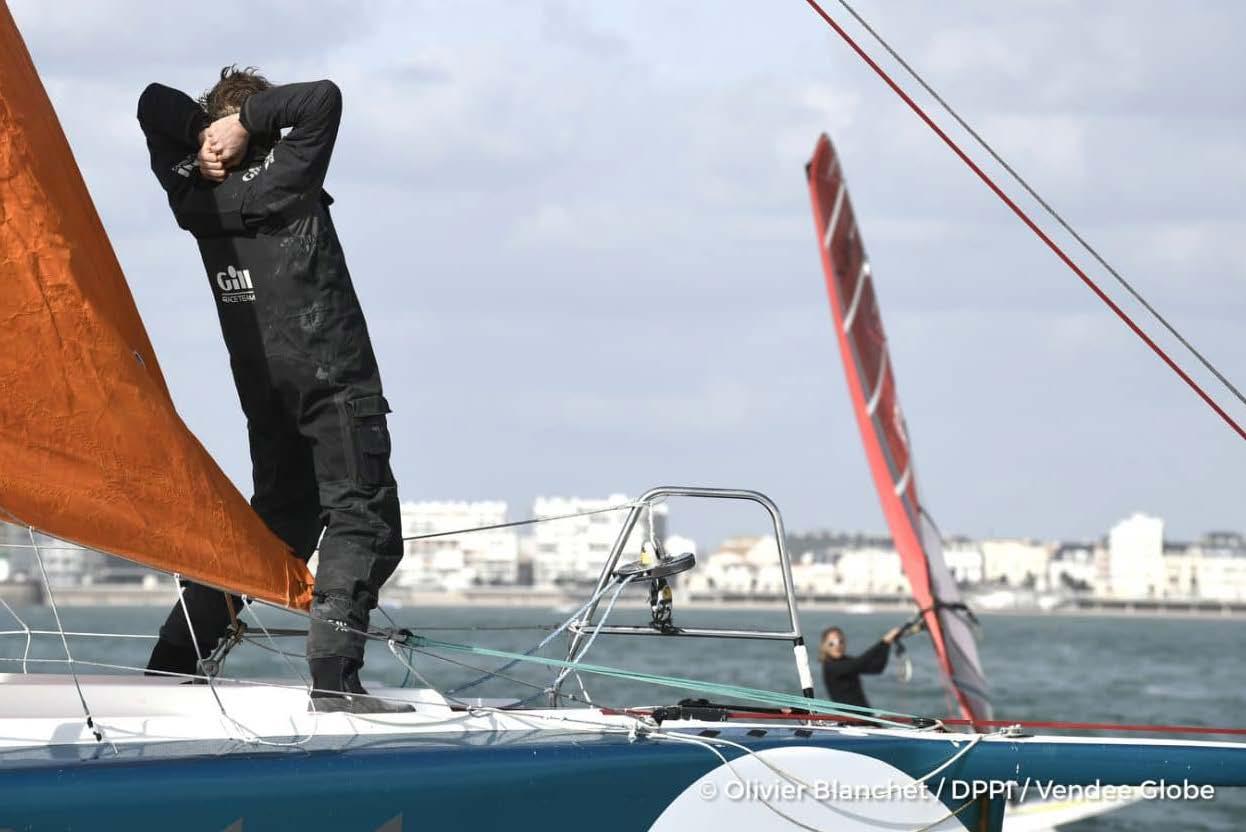
journey was far from a deterrent, instead, in some ways, it’s the reason Colman wants to compete.
“I felt I had a lot of unfinished business with the race. The dismasting and running out of food were the easy part, there was also the fire and the big knockdown and lots of damage in the Southern Ocean that took me days to get back up on my feet. So I really felt like I hadn’t been able to fully express myself as a competitor in that race, as I was just trying to keep the boat in one piece and myself alive.
“In many ways that’s part of the adventure – that’s what allows this race to be so much more than just a yacht race.”
And for Colman, his journey is much more difficult than the average sailor in the fleet, planning to once again complete the race with just solar and hydro power, a decision made as a result of his personal values.
“It’s pretty easy to flip a switch and start an engine and get all the power that you need,” Colman says, which is why he has no intention of using the diesel engine, which he had ripped out of his boat in 2016 but is forced by organisers to have on board in 2024.
“The class has changed the rule a little bit and won’t allow me to do the same mix of technology that I used in the last one. They’ve said the diesel engine is a safety
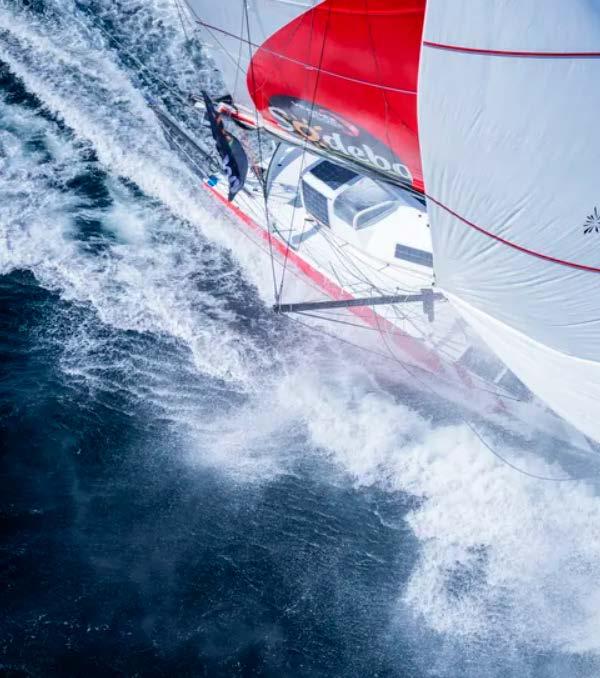

device, and everyone has to have one, so I’m going to put a seal on the engine so hopefully it shows that it doesn’t turn and I never used it during the race to charge the batteries.”
Colman’s boat has a similarly bumpy history with the Vendée, with the IMOCA 60 class yacht having taken part in the race four times, but only reaching the finish once.
It also has a history with New Zealand – in the 2016 Vendée, the boat almost broke in half in the South Tasman Sea, with skipper Thomas Ruyant bringing it into Bluff to abandon the race. The boat was rebuilt in New Zealand and re-entered the Vendée fleet in 2020, racing to 10th place under the helm of Maxime Sorel.
It came into Colman’s possession three years ago, and since then he has done “a stupid amount of work” on the boat, including adding reinforcing layers of
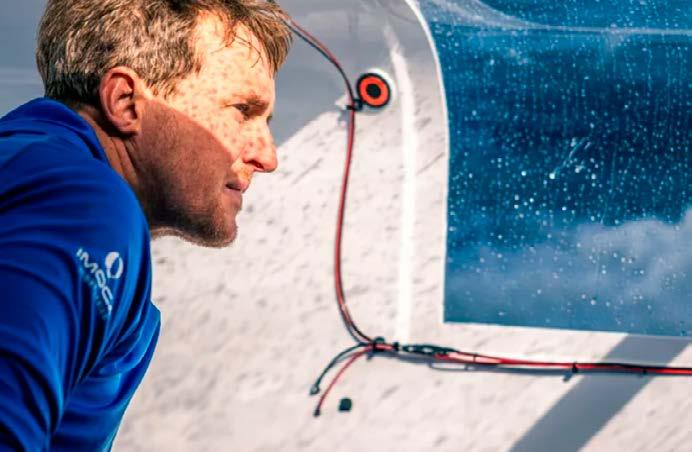
carbon fibre, laminating new structural beams, cutting off the roof to make better protection for the cockpit, and rewiring the boat with new electrical systems.
It will be called the MS Amlin, with the insurance company stepping up to provide title sponsorship and help Colman reach the start line.
“It’s absolutely thanks to them that I’m able to do what I do, they’ve really stepped up this year because they were a minor partner, then when they saw I wasn’t finding a title sponsor they combined two years of budget into one to get me to the start line.
“I’m able to do this on a low budget because I’ve got such a great series of technical partners,” Colman says, which also includes Italian company One Sails, who provided recyclable sails for his journey.
“When I wanted the project to be a better reflection of my own values, I went out hunting for suppliers and subcontractors that could help me fulfil that vision and they’ve been really great.”
Colman is especially appreciative of his sponsors given the financial constraints he works under.
“It’s part of Kiwi sailing lore that we have to do things on a shoestring and I’m definitely following in some well-trodden steps. There was an article in a French
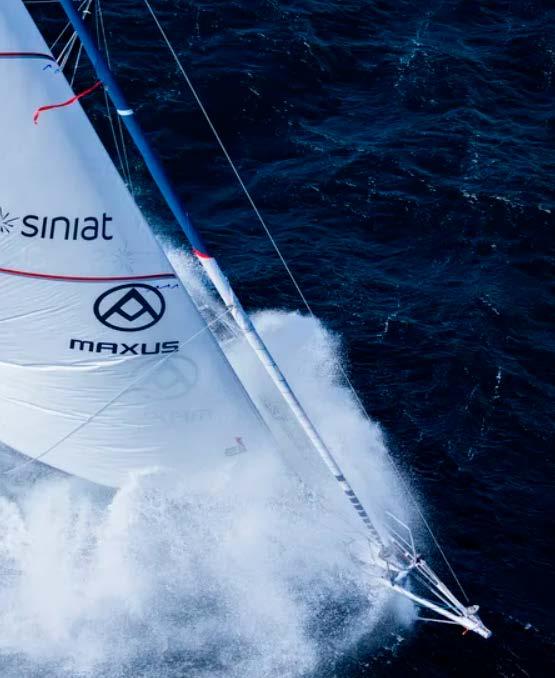
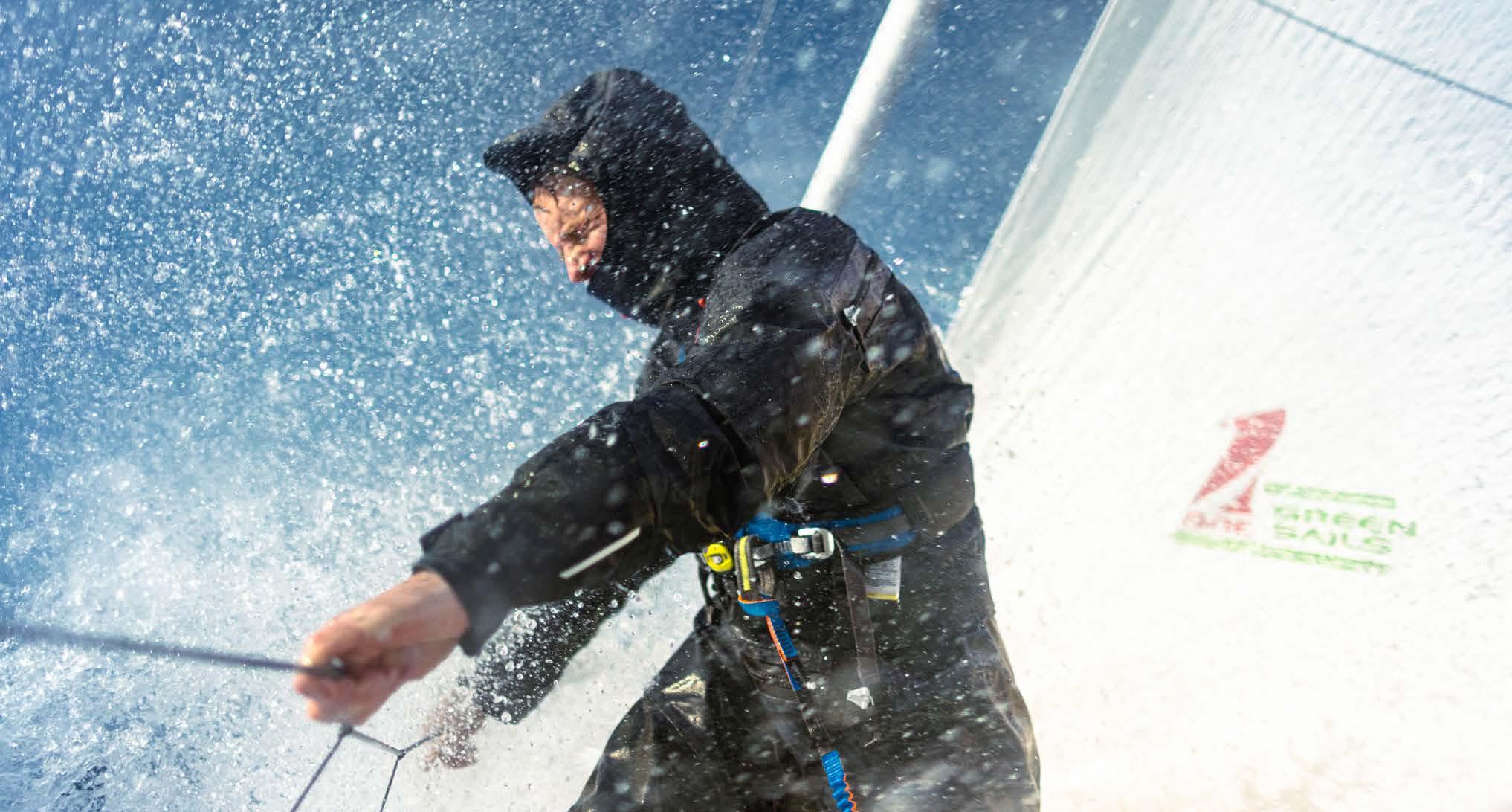
sailing magazine that ranked the budgets of all the teams and I was right at the very bottom.”
According to Colman, some of the top teams in the race will have a running budget of €2-3 million per year, with boats that can cost up to €7m.
“At the other end of it, I’ve got a big old bank loan that I’m servicing, and I’m operating at €400,000 per year. Which is still a big chunk of change, but it goes very quickly.
“I’m up against teams who have got 25 to 30 people in them, I have one full-time employee and a bunch of independent contractors who come in and do missions, so I am definitely wearing the hat of skipper, team manager, technical director, and as it happens, the accountant.”
It makes for a daily schedule that consists of so much more than just sailing a boat, with Colman managing to cram a wide array of tasks into a jam-packed day which still has plenty of time for wife Clara, 6-year-old daughter Ella and 4-year-old son Leo.
“I do the full-time job of whatever is required that day running the boat, and then I come home, turn off my phone and spend time with them for a couple of hours, then once everyone falls asleep I get up and look for sponsors and make presentations and pay the bills and do
office work until stupid hours, until my son wakes me up at 6.30 in the morning, then it all happens again.”
While Colman is now based in France, his Kiwi ingenuity, drive and spirit comes from the memory of a famous Kiwi round-the-world sailor.
“I throw myself into it both on the boat and on land in the years preceding with absolutely everything that I have, and that’s because I grew up listening to snippets of Peter Blake’s voice on the nightly news on Channel One, and that planted something deep inside me. When he was describing what was going on when they were doing the Whitbread and going around Cape Horn, that absolutely lit a fire inside of me and it’s a privilege to follow in those footsteps.
“It’s an epic adventure even for those just chasing the victory, but for everyone along the way it is absolutely a yacht race.
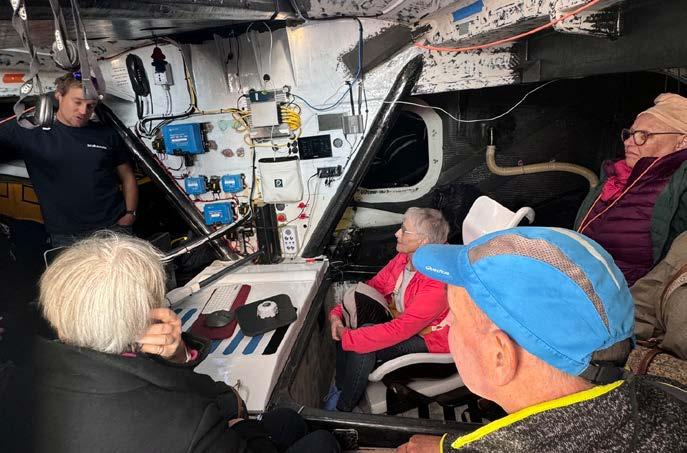
1. Antoine Cornic (Fra)
2. Sébastien Marsset (Fra)
3. Louis Duc (Fra)
4. Manuel Cousin (Fra)
5. Violette Dorange (Fra)
6. Guirec Soudée (Fra)
7. Jingkun Xu (Chn)
8. Fabrice Amedeo (Fra)
9. Isabelle Joschke (Ger)
10. Conrad Colman (NZ)
11. Szabolcs Weroës (Hun)
12. Tanguy Le Turquais (Fra)
13. Oliver Heer (Sui)
14. Arnaud Boissières (Fra)
15. Benjamin Ferré (Fra)
16. Denis Van Weynbergh (Bel)
17. Damien Seguin (Fra)
18. Pip Hare (GBR)
19. Romain Attanasio (Fra)
20. Benjamin Dutreux (Fra)
21. Giancarlo Pedote (Ita)
22. Justine Mettraux (Sui)
23. Alan Roura (Sui)
24. Clarisse Crémer (Fra)
25. Sam Goodchild (GBR)
26. Kojiro Shiraishi (Jpn)
27. Louis Burton (Fra)
28. Sébastien Simon (Fra)
29. Nicolas Lunven (Fra)
30. Maxime Sorel (Fra)
31. Jérémie Beyou (Fra)
32. Boris Herrmann (Ger)
33. Samantha Davies (GBR)
34. Yannick Bestaven (Fra)
35. Paul Meilhat (Fra)
36. Thomas Ruyant (Fra)
37. Yoann Richomme (Fra)
38. Éric Bellion (Fra)
39. Charlie Dalin (Fra)
40. Jean Le Cam (Fra)
It’s almost 30,000 nautical miles and I will be fighting for every single inch of those.”
All of those inches will be taken on without fossil fuels by a man on a mission, who carries a personal motto to live by as a sailor.
“I feel very strongly that as sailors, we have not only the opportunity, but I would argue the obligation to become the greenest mechanical sport that’s out there.
“We’re pushed by the wind, so we should be charged by the sun.”
But when it comes to Conrad Colman and the Vendée, there needs to be one slight alteration.
The wind, the sun, and a whole lot of heart.
Click here, here or here to follow Conrad Colman’s journey.
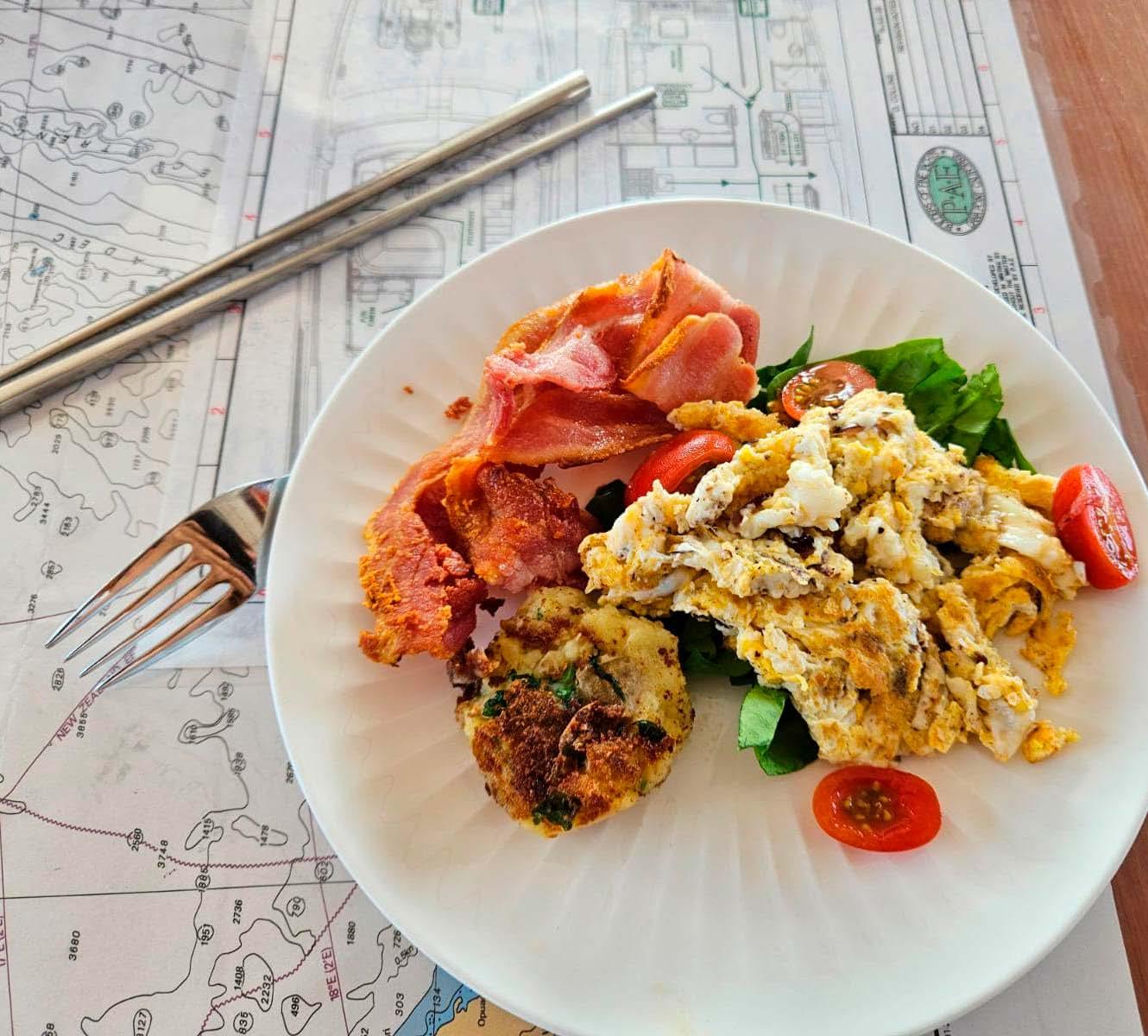
Stocking the galley for your next voyage
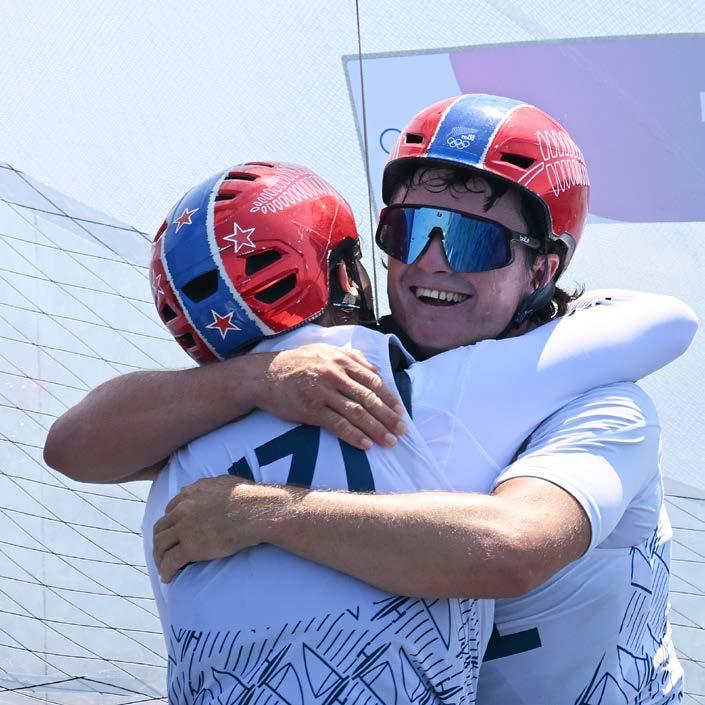
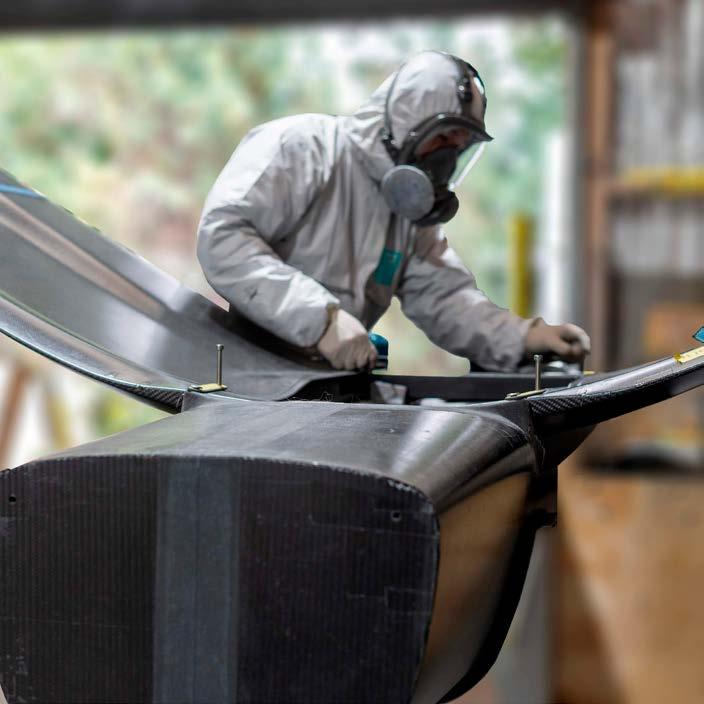
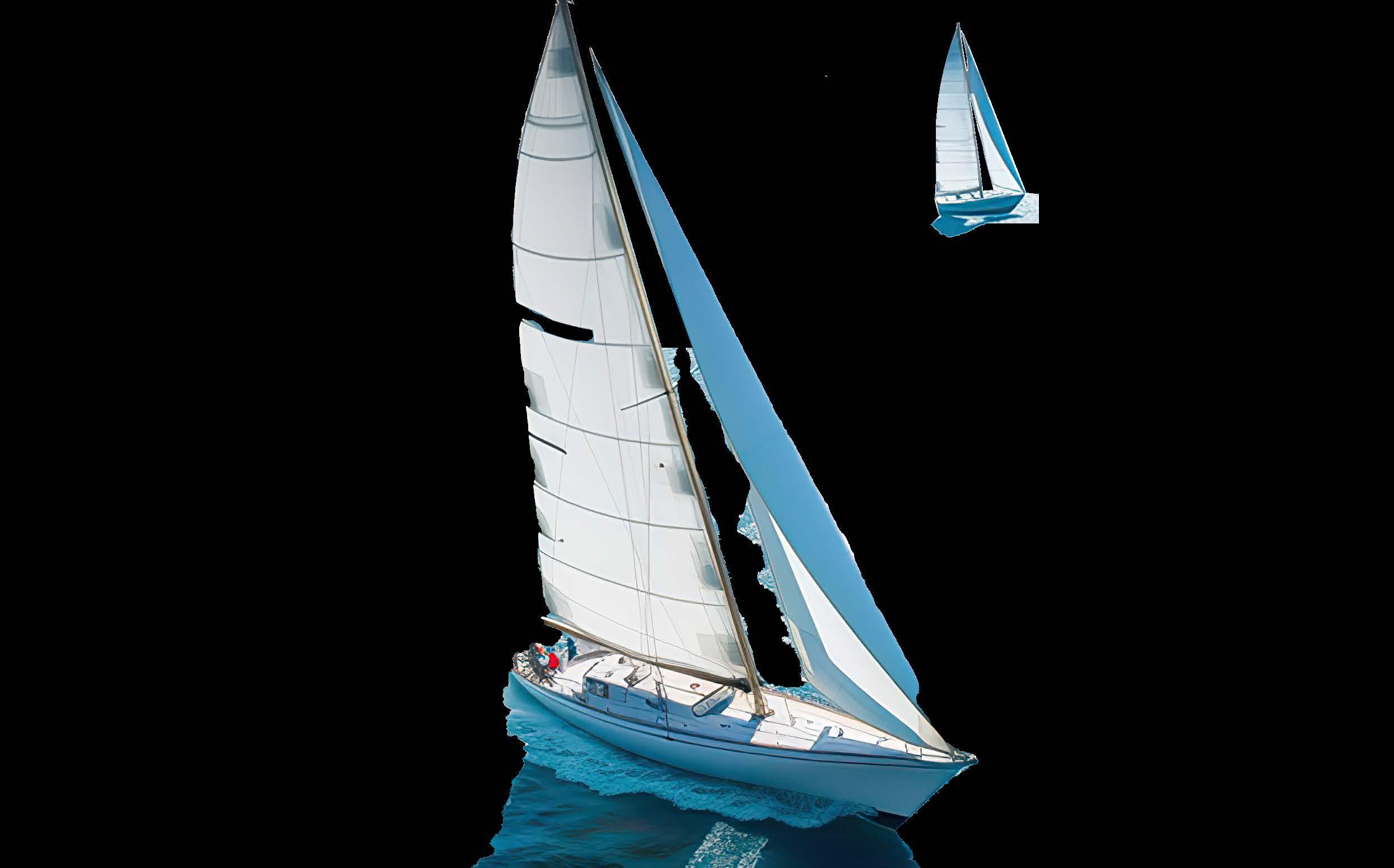
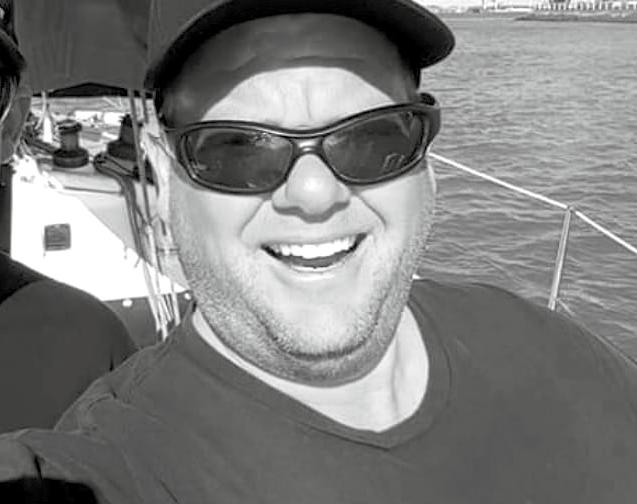
When choosing your next sail, it helps to know how they are made and how it affects performance.
They say lightning never strikes twice, but for me, it did – in 1995. That year, I met my wife, Sara, in the Royal New Zealand Yacht Squadron’s youth training programme, and it was also when my sailmaking journey began.
Fast forward 29 years, and Sara and I have had many adventures, from cruising remote parts of the world with our three kids to a season spent in the Alaskan ice.
During this time, I’ve sailed over 150,000 nautical miles offshore, racing at the highest levels on everything from one-design sports boats to Supermaxis. I’ve worked for many of the world’s biggest sailmaking lofts, and I’ve been fortunate to win national championships, offshore races, and even sailed around Cape Horn under jury rig on the Open 60 Hugo Boss.
In this quarterly column for YBQ, I’d like to share my experience on a topic that can seem complicated, even overwhelming, and
to help you make an informed choice when purchasing your next set of sails.
For this edition, let’s dive into sailcloth fabrics and how to choose the right one for you. It may seem simple, but there are many varieties, each suited to different needs.
Many one-design classes of dinghies and keelboats have restrictions on what sailcloth or fibres you can use, mainly to control costs. There’s a significant price difference between woven fabric and carbon laminate. Racing sails prioritise being as light as possible with optimal shape-holding, whereas cruising sails focus on durability and handling. The challenge lies in finding the right balance.
Sail fabrics fall into three main categories: woven sailcloth, laminated sailcloth, and custom fibre layout sails.
Woven Dacron, made from polyester fibres woven together and coated with resin, is versatile and fits various purposes. The weave and coating vary widely. Woven fabrics are categorised into warp (fibres running along the roll) and fill (fibres running across the roll) orientations. Warp is used in tri-radial construction, while fill is for crosscut panels. Crosscut sails save on labour and reduce cloth waste, while triradial sails, though more labour-intensive, hold their shape better due to the fibres
being more aligned to the loads through the sail.
Finer fibres tightly woven are ideal for racing, as they experience less crimp (the path fibres take as they weave over and under each other). Offshore cruising sails, where durability is key, use larger fibres for better UV and chafe resistance.
Coatings also vary, from firm Polycote for racing sails to softer finishes for cruisers. The firm coating offers superior shape retention but can make the sail stiff and difficult to handle. Cruisers prefer softer finishes for better durability and ease of use, though the shape of these sails may deteriorate over time.
Woven Spectra is gaining popularity among world cruisers due to its excellent chafe and UV resistance, though it’s significantly more expensive than Dacron. Woven spinnaker fabrics follow similar principles but generally use nylon, valued for its stretch and tenacity.
Laminated fabrics consist of multiple layers of Mylar and fibres bonded together. These sails are often called “scrims” because of the visible gaps between the fibres. Laminates use materials like polyester, Spectra, Kevlar, or carbon fibre.
Racing laminates typically use Mylar

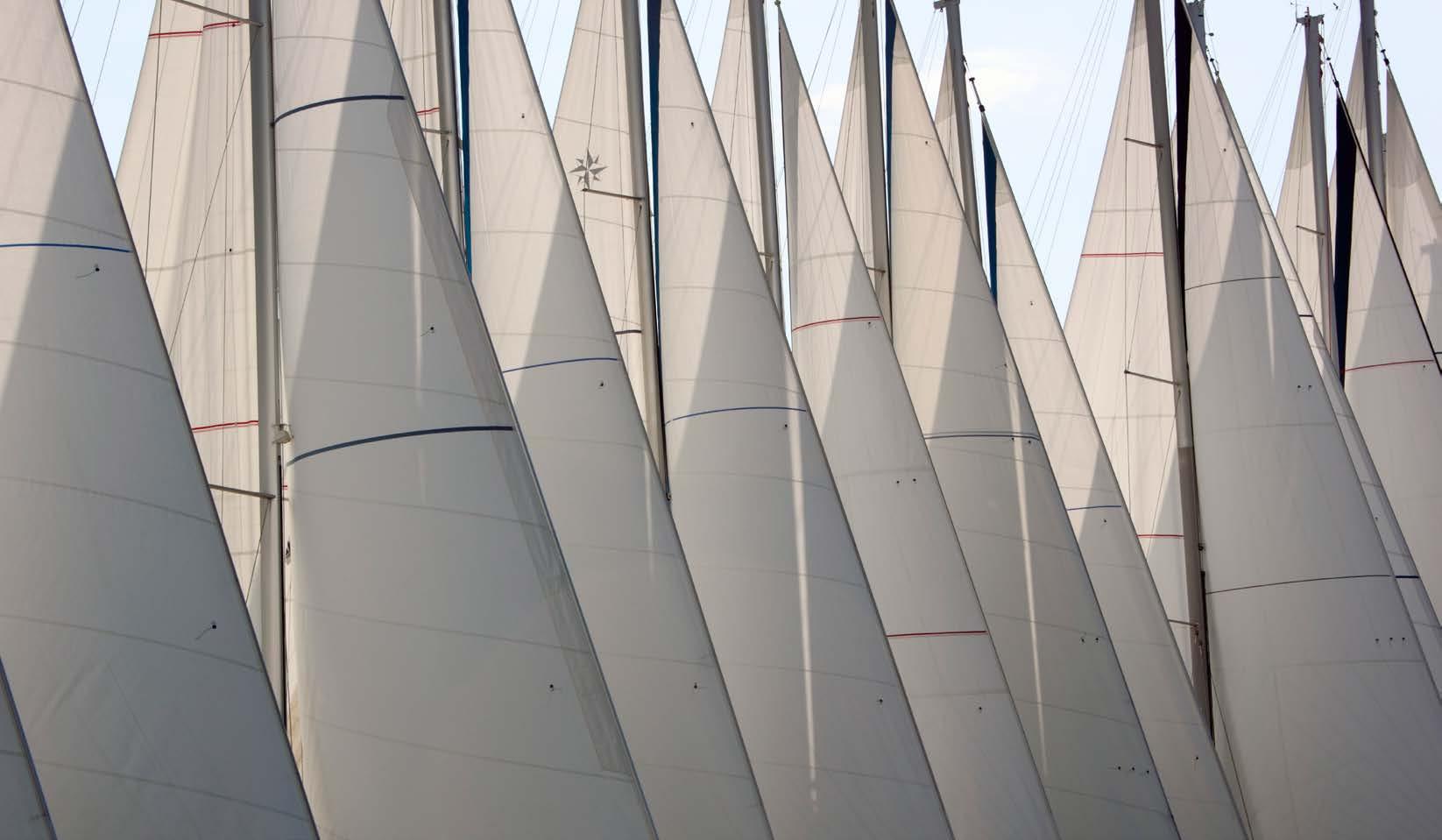
film for lightweight construction but have durability issues, particularly in highwear areas like the leech. To combat this, additional layers like Lite Skin or Taffeta can be applied. Lite Skin offers lightweight protection, while Taffeta provides more durability, extending the sail’s lifespan.
Cruising laminates are becoming more popular as sailors seek performance without frequent replacements. Laminates are available in both crosscut and tri-radial constructions, though tri-radial layouts are more common.
Custom fibre sails are a different category altogether. These are made by laying fibres or filaments along the sail’s load path rather than cutting panels from rolls of fabric. Typically laminated in one piece, either flat with the shape being added by broad seams across the sail, or laminated over a mold,
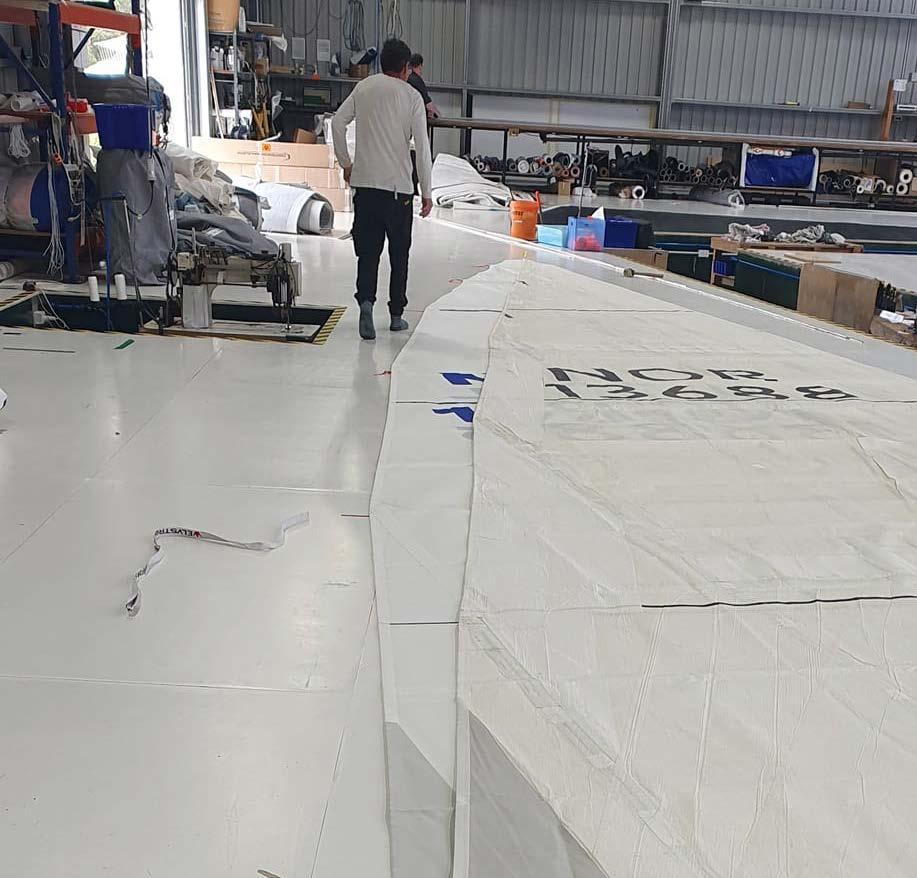
these sails offer unmatched performance.
The process involves placing fibres on a large floor with a machine that precisely aligns them. The sail is then vacuumed and heated to cure the glue. Though expensive, this method allows for more customisation, from batten pockets to reef reinforcements laminated directly into the sail.
The first decision in custom sails is choosing the fibre: polyester, ultra-highmolecular-weight polyethylene (like Spectra or Dyneema), aramids (like Kevlar), carbon, or a blend of these. Racing sails often use 100 per cent carbon, while cruising sails incorporate a mix, balancing performance with durability.
Next, you select the outer skin, balancing weight and durability. The result is a lighter sail with superior shape-holding compared to panelled sails.
We measure fibre in two ways – tenacity and modulus.
Tenacity is the resistance to breaking (like ployester and nylon which are ideal for cruises and downwind sails), whereas modulus is resistance to stretch (like carbon and aramid). Generally, the more modulus a fibre has, the less tenacity it has and vice versa.
Finding this balance is key to a good sail. If you have any questions, don’t hesitate to get in touch at josh@roguesails.co.nz
In the next columns, I’ll look at the different sail types and how they fit into your sail inventory, trimming and getting the best out of your sails, and maintenance tips. Until then, happy sailing!
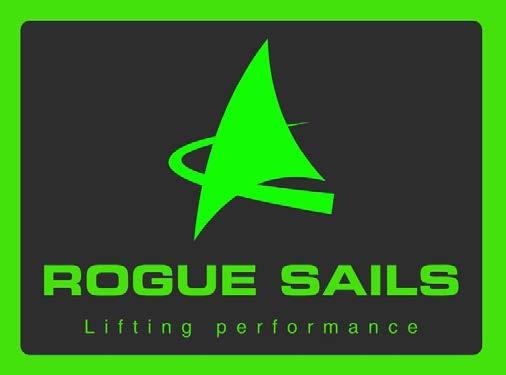
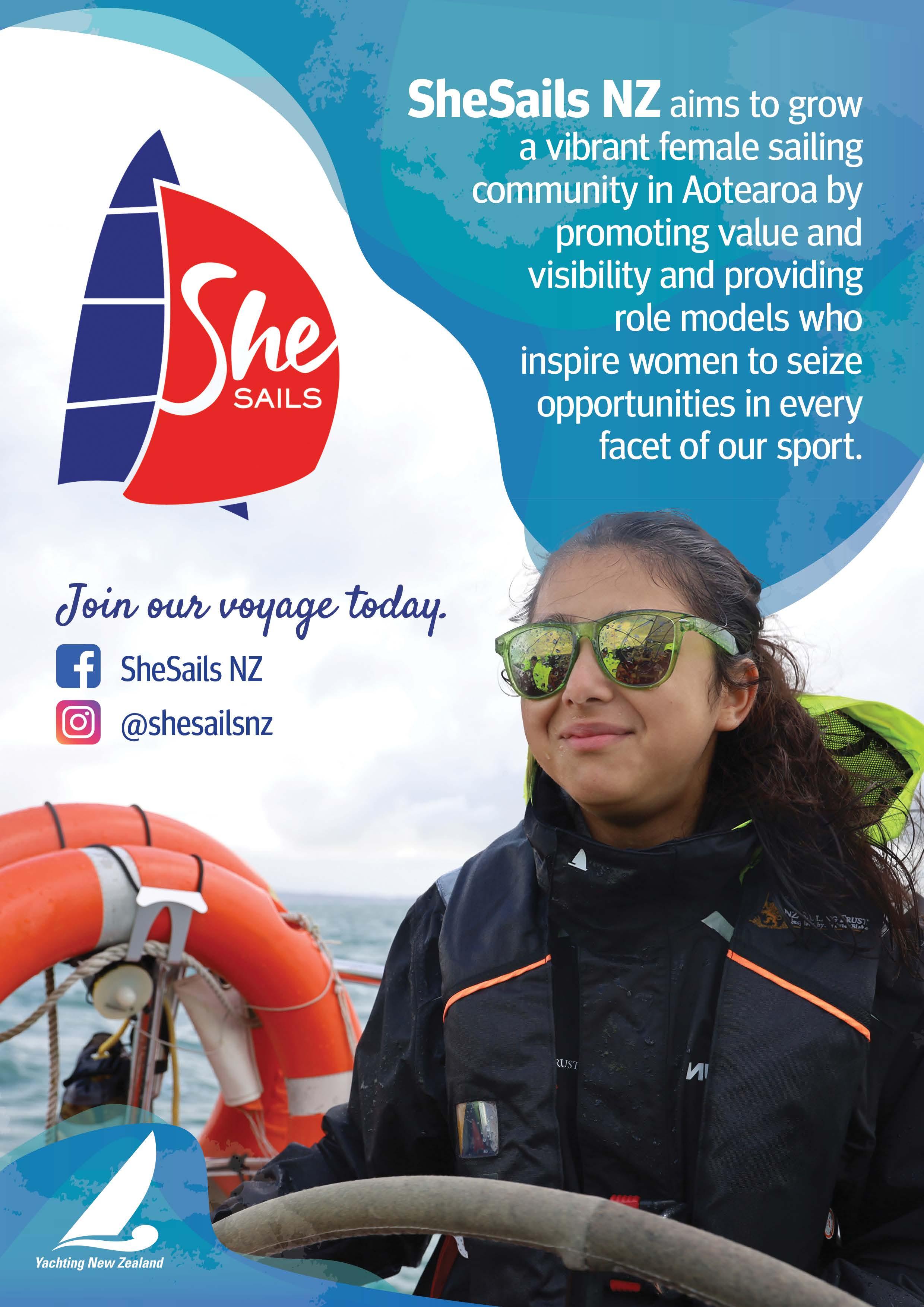
Sailing technology is forever evolving and, if used correctly, can mean the difference between winning and losing.
In a sport where the difference between success and failure often comes down to the smallest of margins, the search for a competitive advantage is never-ending.
Fortunately for the NZL Sailing Team, it has two of the best-equipped partners to help it achieve this edge.
Alex Anastasiou, a performance and technique analyst from High Performance Sport New Zealand, has been working with the country’s top Olympic sailors for the past few years.
The NZL Sailing Team has also been partnered with sailing technology giant B&G since 2022.
The results have been impressive, as underlined by the team’s recent Olympic success in France, where Isaac McHardie and Will McKenzie won silver in the men’s skiff (49er), and Micah Wilkinson and Erica Dawson claimed bronze in the mixed multihull (Nacra 17).
Anastasiou played a key role in the leadup to, and during, the event in Marseille, helping the team to understand the Olympic venue better.
He did this by implementing systems and processes to gather necessary information about the venue, using various data streams to help build a picture of what would be essential to winning boat races there.
“Like many other Olympic sports, the data available to us is extensive. I focus mainly on two key data streams: data from the sailors’ boats, such as GPS-based speed and distance metrics, and data from the coaches’ boats, which provides environmental insights like wind speed and direction,” Anastasiou said.
“The competitive advantage lies in synthesising this data into meaningful insights for our coaches and sailors, helping them make informed decisions to enhance their performance.”
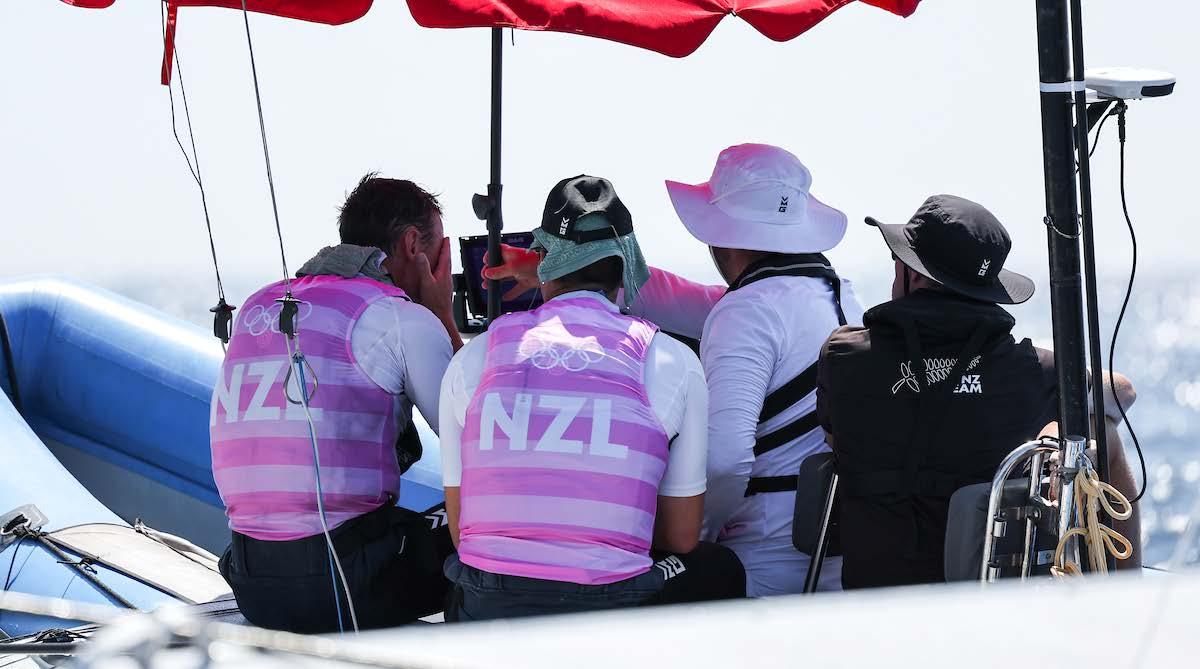
With New Zealand competing in nine of the 10 available classes at the Games, Anastasiou had quite a challenge on his hands.
“It’s about finding a balance – we need systems and processes that work across all Olympic classes while also meeting specific needs at an individual level,” he explained.
“The tools we use to capture data are generally the same, but the methods may vary. For example, we might use the same GPS device across classes, but how we mount it and the specific data we choose to analyse can differ based on each class’ requirements.”
Ensuring that the data being analysed is relevant is essential.
“There is no shortage of available data, which is likely similar across nations. It is therefore essential to ensure the data is relevant, aligned with the performance questions of our coaches and sailors, and applied meaningfully within the training and competition environment,” Anastasiou said.
“The technology available within Olympic sailing is evolving. Ensuring as a team we are keeping up with the latest advancements is crucial. Innovation within the sport has focused on increasing efficiency, precision, and ease of use. New developments have led to faster workflows and more streamlined processes.
“When used effectively, technology and data can enhance the chances of winning.
“Staying competitive means learning faster than the competition. With the right data, we can accelerate the learning process by providing objective insights into our sailors’ performance.”
The partnership with B&G is a critical component of the team’s success, according to Anastasiou.
The company, which has been at the forefront of sailing innovation for 50 years, develops world-leading navigation and instruments to help sailors go faster and safer. They supply Yachting New Zealand with high-tech wind gear and displays, which provide coaches and sailors with accurate and reliable information about what is happening on the water.
“B&G technology serves a consistent purpose in both training and racing scenarios: to provide objective insights into the environmental conditions that coaches and sailors experience on the water. For example, it allows coaches to monitor trends in wind speed and direction over time, helping them make informed decisions based on real-time data,”
Anastasiou said.
“For technology to be truly useful, it has to meet certain key criteria: reliability, validity, sensitivity, and feasibility. B&G gear excels in all these areas, meeting each standard at an exceptionally high level.”
For more information on B&G products, click here.
We all took a deep breath when the news came in that AC75 Taihoro had suffered damage during a haul-out in Barcelona. What immediately came to mind, however, was that MAST graduate Josh Vogels and his brother, apprentice Arnie Vogels, were ready to leap into action as part of Emirates Team New Zealand’s boatbuilding and shore crew stationed there for the 37th America’s Cup campaign.
Well-prepared for any scenario after months of rigorous training and handson experience as part of the Taihoro build team, the brothers have embraced every opportunity that comes their way, sharing a boatbuilding journey at the highest level.
Josh’s career started with the previous America’s Cup campaign, so this time around, he certainly knew what he was signing up for. He started and completed his composite boatbuilding
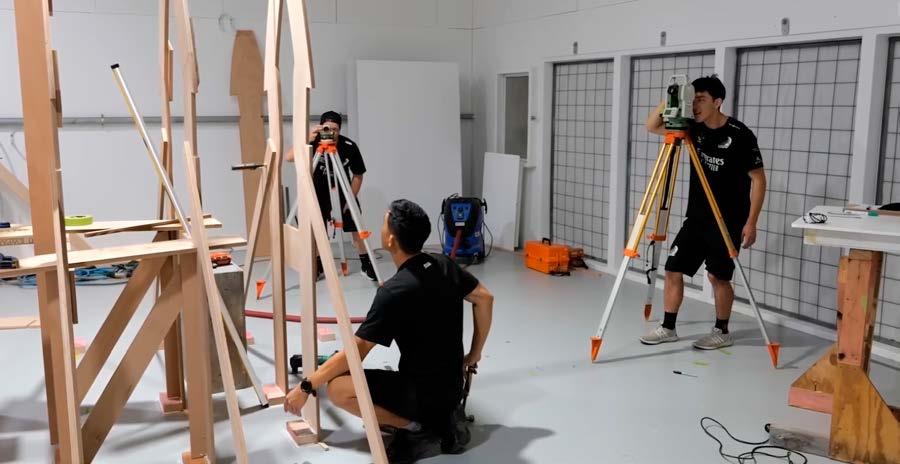
apprenticeship with Emirates Team New Zealand, giving him the experience and insight needed to tackle this campaign.
“From the ground up, starting with the mold, the length of the build – there’s a lot going on in a very short amount of time,” Josh said.
In 2023, younger brother Arnie was still at school and looking for his next step. After initial interest in diesel engines, he changed direction to boatbuilding through MAST Academy’s Launch it – School to Work programme. After securing an interview with Emirates Team New Zealand, he was hooked.
With 10 apprentices working on Taihoro, Arnie was one of four straight out of school, learning the ropes alongside seasoned professionals and his brother.
“Every part of the process was something new to me, so every day there was something new to learn,” Arnie said.
“Time was our worst enemy during the build, it was brutal. There are very few free
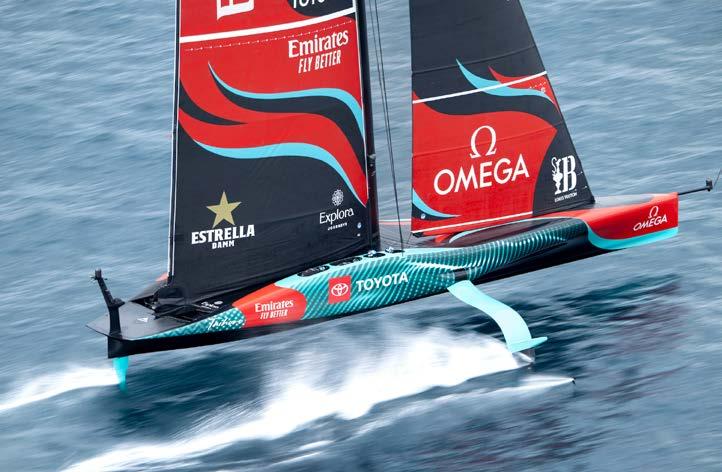
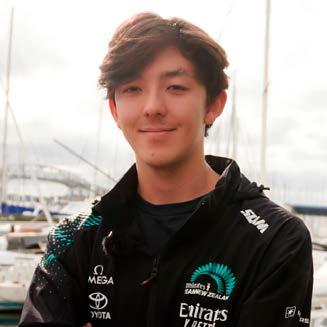
weekends, and each phase was another step up. The build is kept pretty secret, so having a familiar face around the shed and Josh to talk to after long hours made a huge difference.”
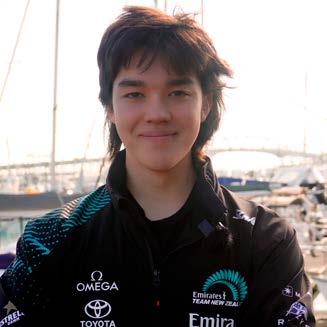
For Josh, the build represented a shared vision and required team endurance, leaving little time for anything outside of work.
“For all of us on the build team, it’s a massive passion project. It’s not just my work – it’s the work of 40 other designers and boatbuilders, all working together like one big cog.”
MAST Academy Training Advisor Mike Birdsall has high praise for the support provided by the Emirates Team New Zealand construction team.
“It’s an extraordinary opportunity for these young boat-builders, who will be able to look back on this as a highlight of their careers.”

Mackay Boats is set to break another record at the 2024 Moth world championships in December.
The Mackay Bieker Moth is no stranger to breaking records –and it is set to add another first to its impressive list even before the first starter gun is fired at this year’s Moth world championships.
The event, which will be hosted by Manly Sailing Club from December 30, is expected to attract around 100 competitors from across the world and, as one of the leading manufacturers of the one-person foiling dinghy in the world, the Mackay name is expected to be on as many as two-thirds of the boats at the event – the most seen at any Moth world champs to date.
The International Moth class rules have very few restrictions, mostly covering the hull’s length, width and sail area. Over the past 50 years, the hull has developed from scows to skiffs and into today’s fast foiling boat.
As a development class, it is continually challenging designers, boat builders and sailors who want to perfect racing high-performance foiling.
The Mackay Bieker Moth is one of many IMC boats available to sailors and is built by Mackay Boats in New Zealand.
Since its debut at the Australian Moth world championships in 2019, the Mackay Bieker has been on an impressive journey, setting new records with podium results and speeds, with the latest speed record clocking 38 knots. It is now in its third iteration – the first being the BM-V1 which was launched in 2019. The second was
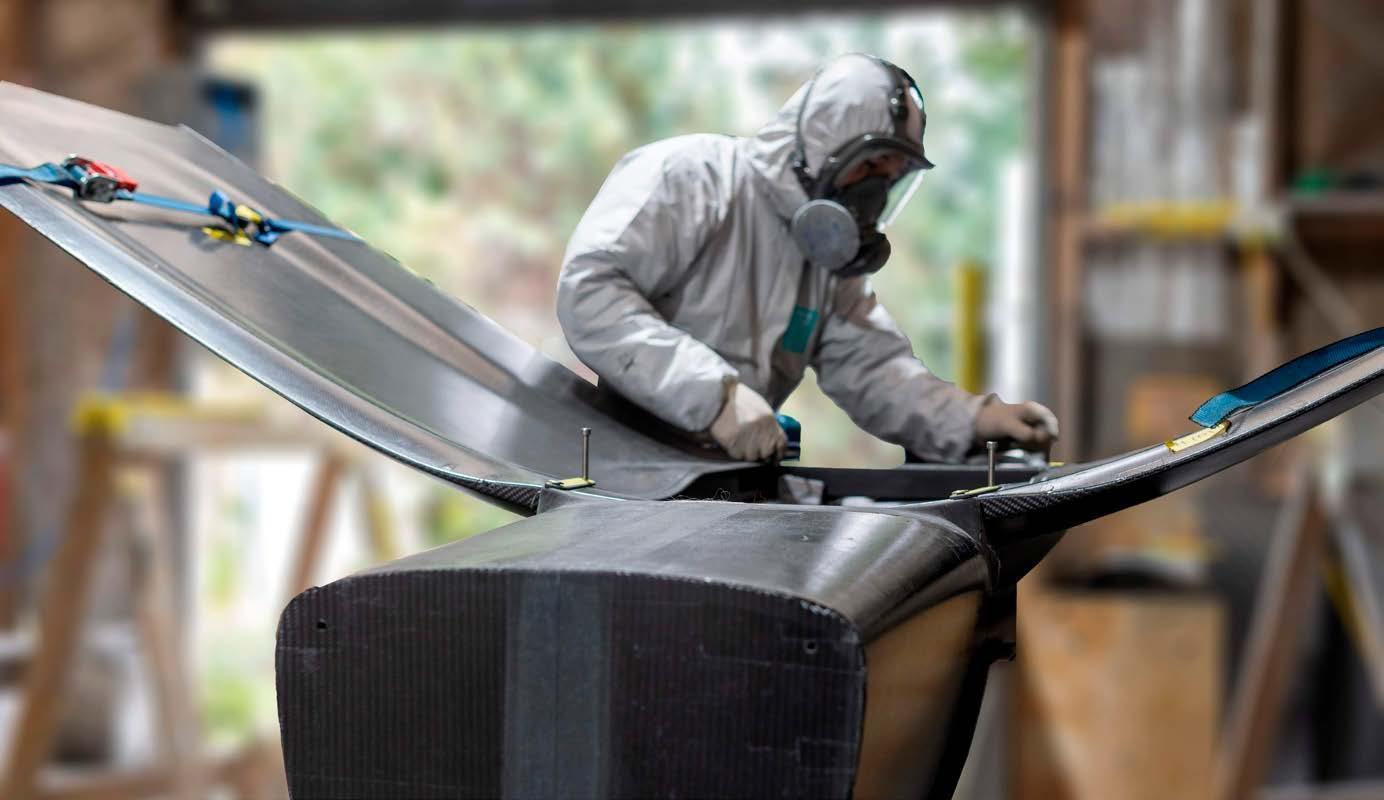
a refinement called the BM-V2 and the latest the BM-V3 was launched in July 2023 and is sailed by several of the world’s top Moth sailors, including the skipper of France’s Youth America’s Cup team Enzo Balanger, who also won this year’s Moth Foiling Week.
Mackay Boats director Dave McDiarmid said the company has been producing an average of one Bieker Moth per week since March in preparation for the world champs.
“Over 120 Mackay Biekers are now racing around the world with just over 40 of these being the latest BM-V3s. Most of these will race at the worlds,” he said.
“The BM-V3 is a blend of the BMV2 with some big new developments. It’s been a major undertaking in terms of design, production and customised carbon fittings. There is not one single millimetre of the Bieker Moth that has not been analysed for optimal aerodynamic, hydrodynamic or engineering performance to create the ultimate turbo-charged Moth.”
The team capitalises on a diverse background in high-performance boats – from the America’s Cupand Olympic Games to International 14s, foiling kites,
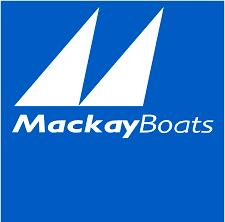
18ft Skiffs, and Moths.
According to McDiarmid, the total labour hours are up to four times higher when building a Moth compared to other boats.
“This is due to the many different parts that make up the boat, and the time needed to laminate and then cook each pre-preg (carbon fibre preimpregnated with resin) part, before assembling and joining everything together,” he said. “The boat is built with no compromise, utilising carbon pre-preg and honeycomb structures for the hull and ultra-high modulus pre-preg carbon under 6-bar pressurefor the foils.”
Every detail of the boat is engineered and custom-designed to achieve the best possible result with the latest available materials and technology.
“Our Moth build team has become highly specialised in carbon composite construction, including many customised carbon fittings that are used on the Mackay Bieker Moth. In fact, the only off-the-shelf parts on the new boat are the sheaves inside the custom deck turning blocks.”
VMG Clothing is the manufacturer of elegant, highperformance crew wear for the superyacht and marine industry and also the proud clothing partner for Yachting New Zealand. Now, for the first time, club members can access the exclusive VMG range of NZL Sailing -branded gear
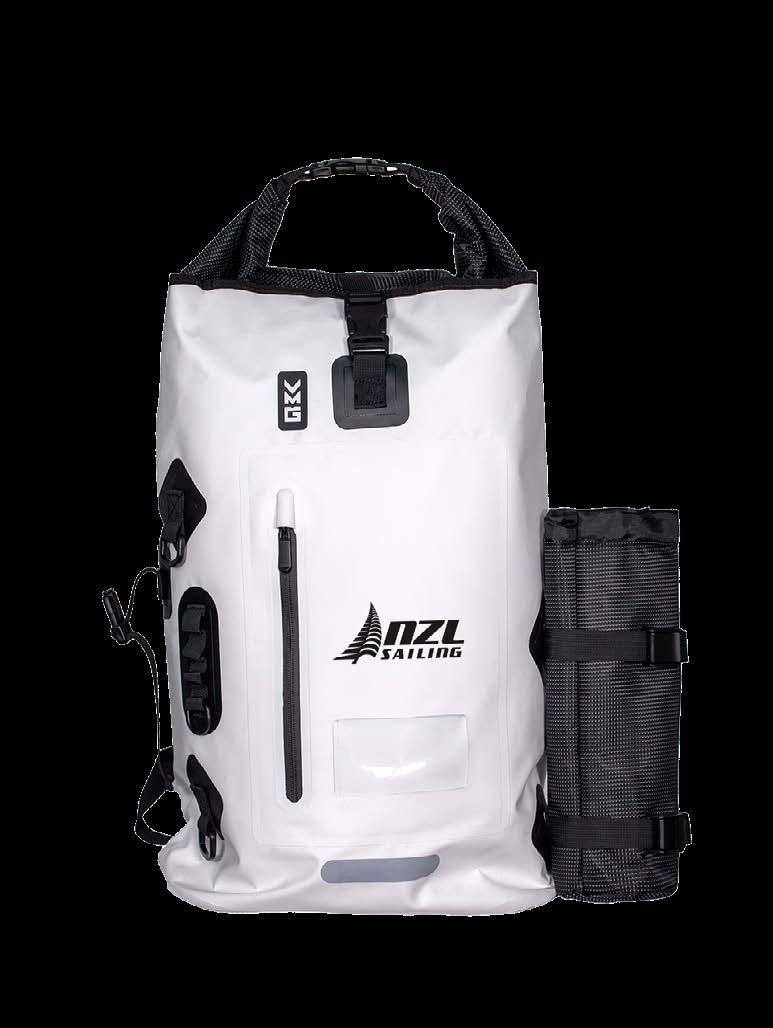
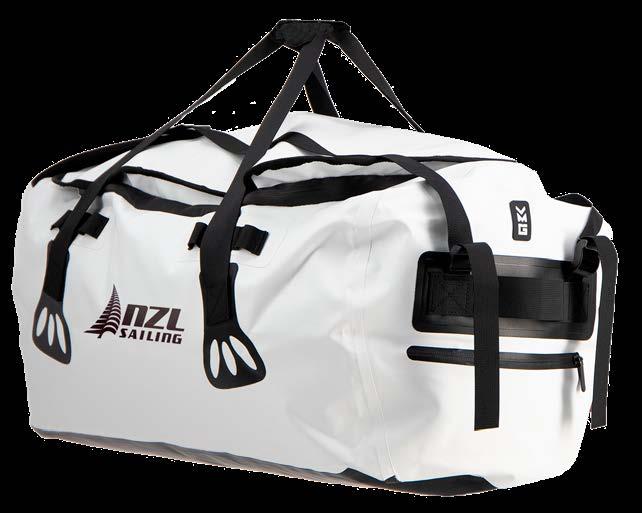
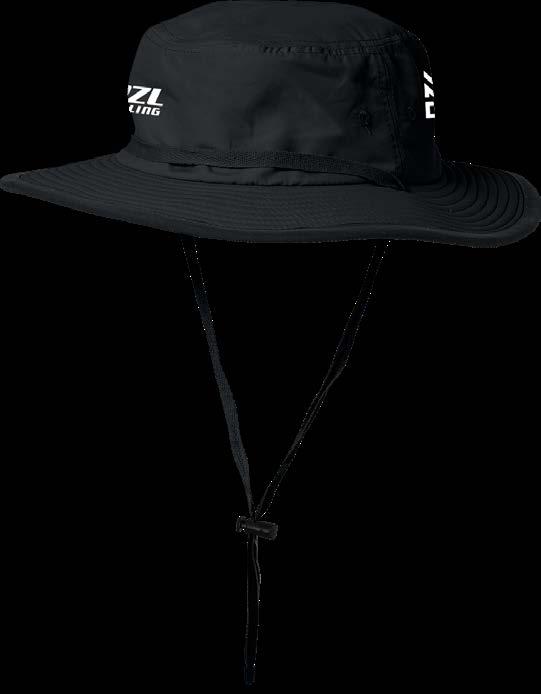


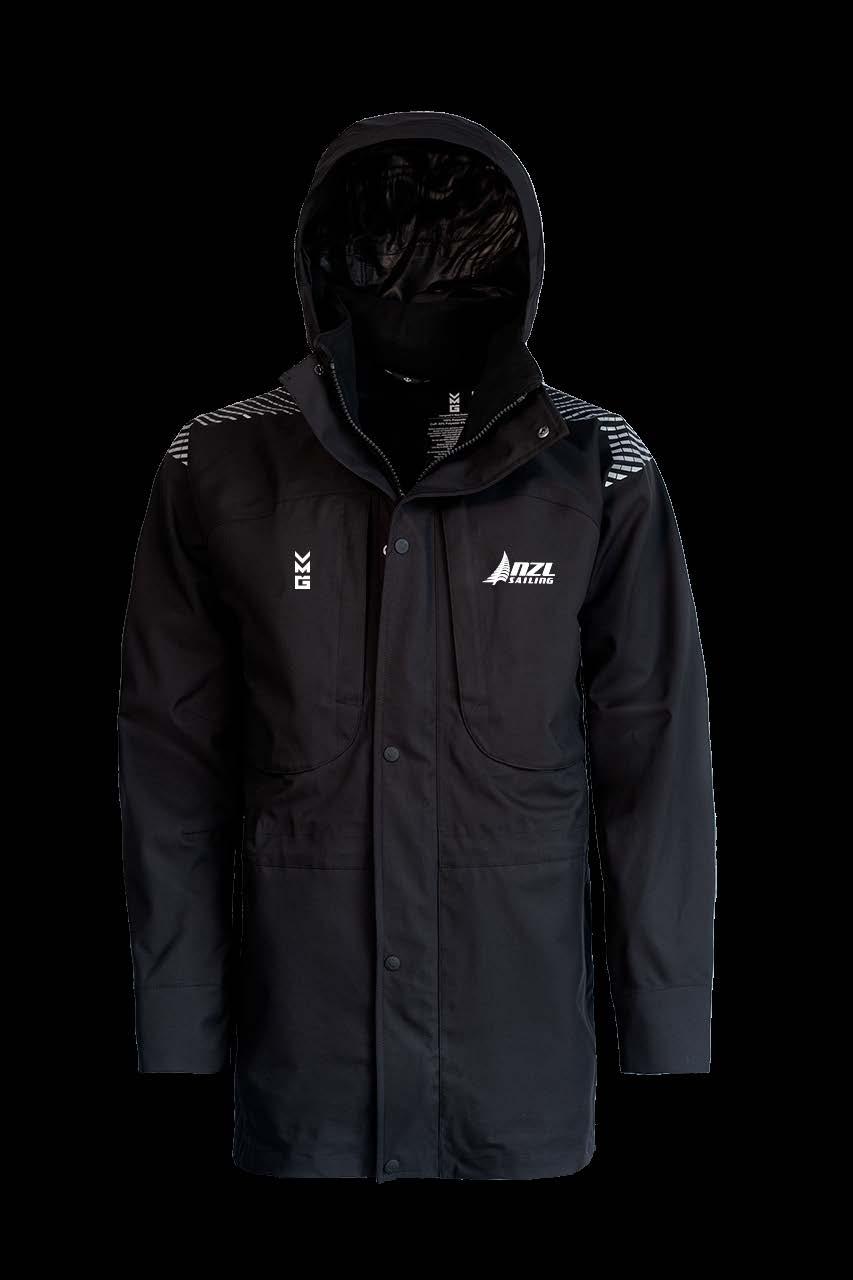
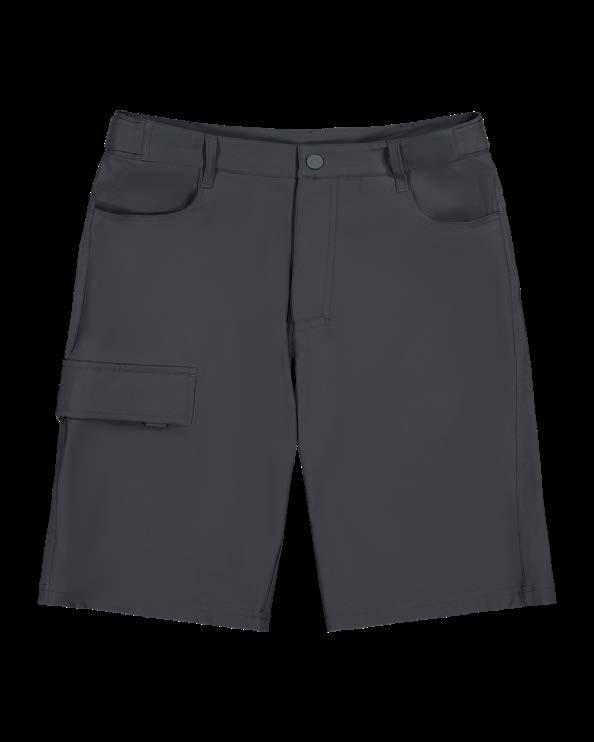
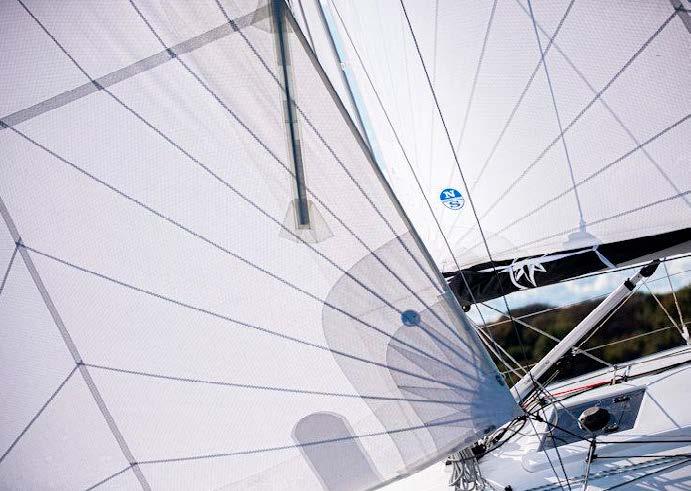
Chatham Backpack $145
Unisex (white)
25L volume waterproof backpack with adjustable straps, safety clasp and front zipper.
Chatham Gear Bag $169
Unisex (white)
65L volume waterproof gear bag with adjustable straps, safety clasp and front zipper.
Coaches Tech Jacket $395
Unisex (black)
Tested to withstand 40,000+mm of water over 24 hours with double seam-seal adjustable hood.
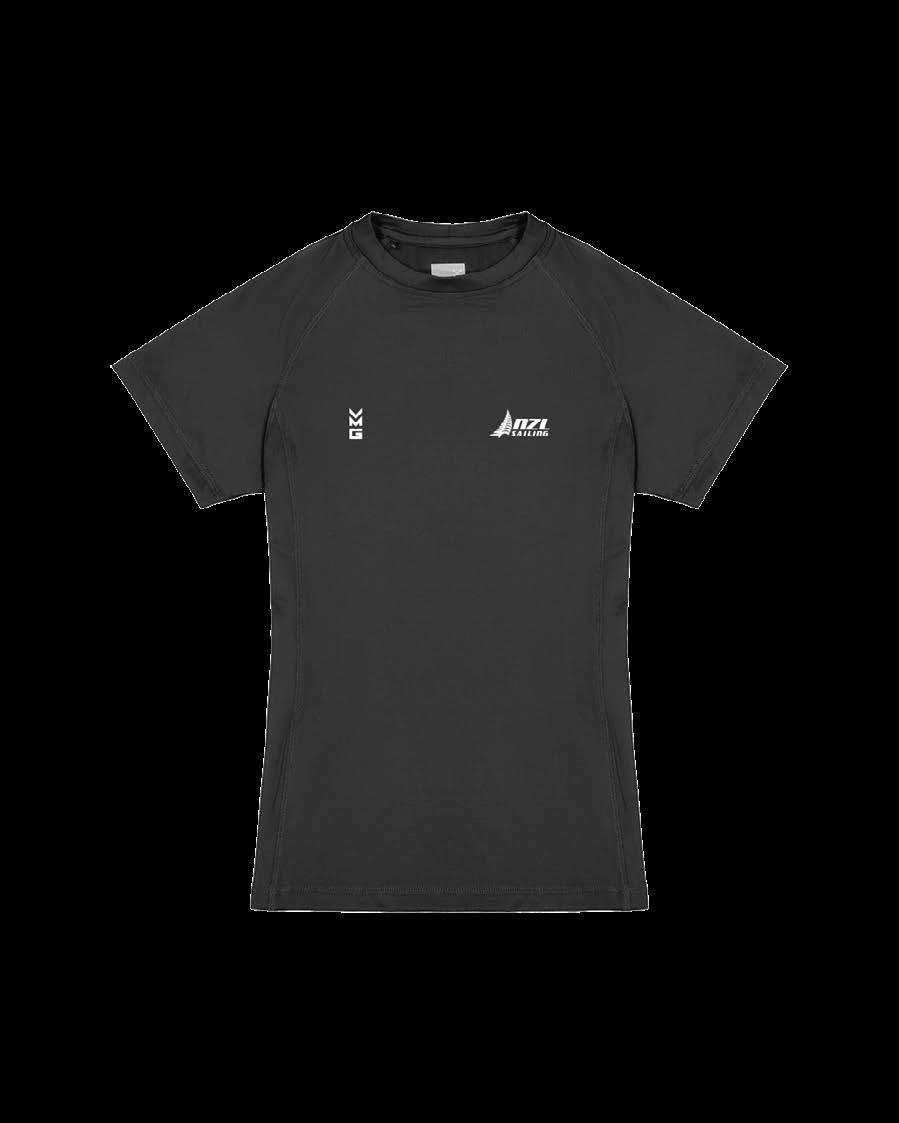

Tekapo Polo $85
Men’s and women’s (black/titanium)
Slim fit with moisture wicking and selffabric engineered collar with three-button placket. Recycled plastic fabric.
Moana SS Tee $76
Men’s and women’s (charcoal/white)
Lightweight, stretchy and breathable made from recycled plastic. Protects you from the sun and acts as a moisture-wicking layer.
Sandspit Hat $58
Unisex (black/white)
Wide brim sun hat with regular fit. Adjustable cord and sweatband lining.
Hauraki Shorts $133
Men’s (charcoal)
Quick-drying performance garment with stretch, made from recycled plastic, water-repellent fabric, adjustable waist and side cargo pocket.
8 Ozone Cap $26
Unisex (black/white)
Regular OSFA fit with crown peak cap, black Velcro strap and clip cord.
To view the full range and to make a purchase, click here
Yachting New Zealand’s latest webinar looks at optimising nutrition before, during and after racing.
Adequate nutrition is a critical, yet often overlooked, component of high-performance sport in general, and sailing in particular.
This was the key message from the “Nutrition: Fuelling for Sailing Performance” webinar, the latest in Yachting New Zealand’s popular online series.
As the title suggests, the webinar focused on optimising eating and drinking before, during, and after training and racing.
The session was presented by Kelsey Paterson, a performance nutritionist with High Performance Sport New Zealand, and was attended virtually by sailors from all classes and age groups.
6 class earlier this year in Marseille, and Jenny Armstrong, Yachting New Zealand’s women’s sailing lead.
“Sailing is such a complex sport that proper nutrition is absolutely critical,” said Paterson, who has been working with the NZL Sailing Team for the past two years.
“The first step is understanding why this is important – because not fuelling your brain well enough can significantly impact every aspect of your life, not just your sailing.”
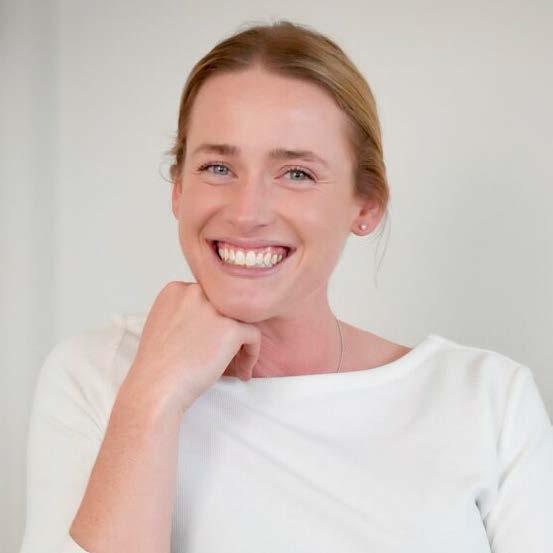
Kelsey Paterson
In her presentation, Paterson highlighted the “bread and butter” of nutrition, offering useful suggestions for pre- and posttraining nutrition, as well as what to eat during regattas. She also emphasised key indicators of poor nutrition, explained the four Rs of recovery nutrition – replenish, repair, rehydrate, and revitalise – and discussed recognising hunger and thirst cues, alongside safe supplement use.
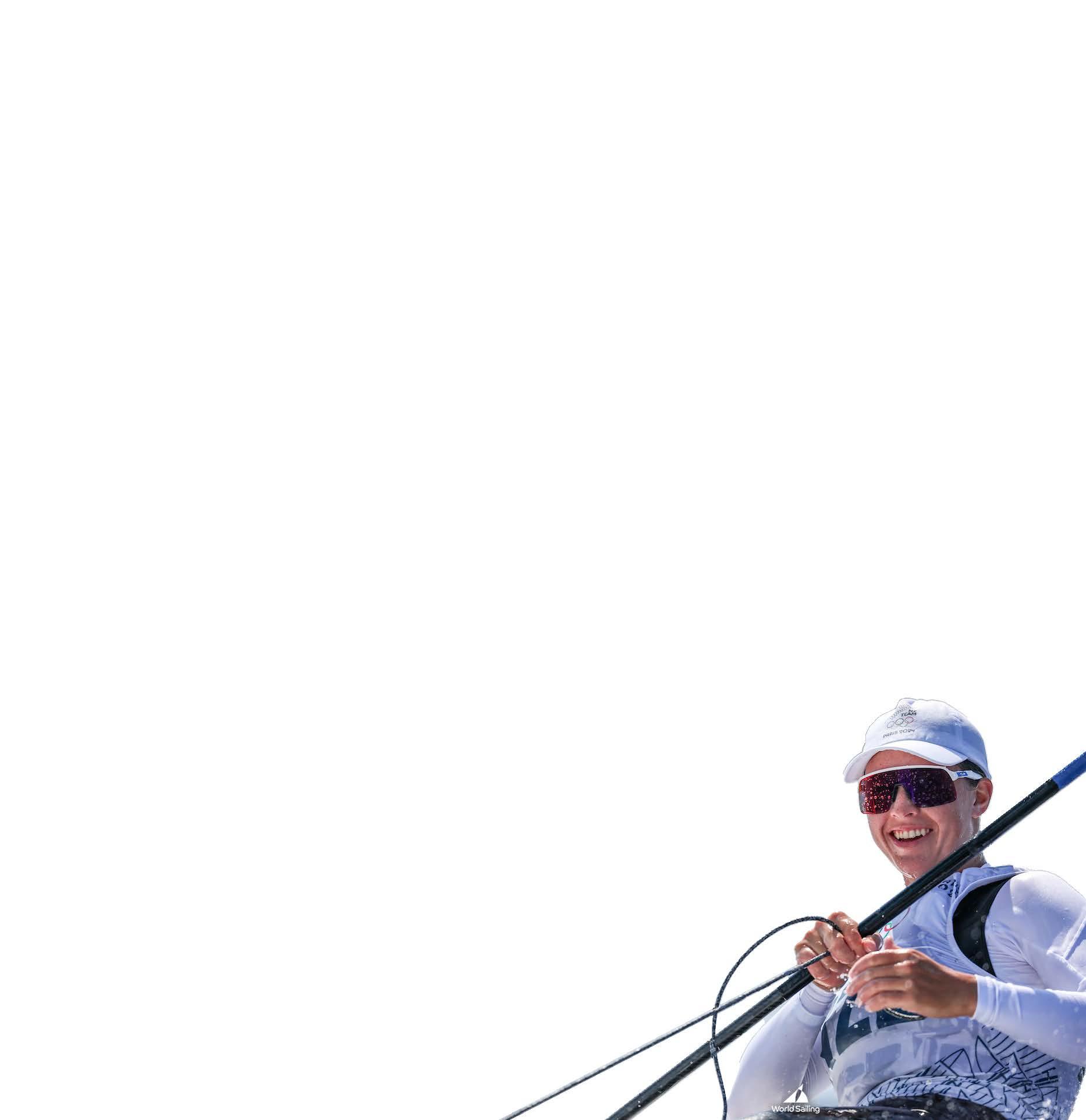
Paterson was joined by Greta Pilkington, who made her Olympic debut in the ILCA
• Before training: Eat foods high in carbohydrates.
• During training: Keep muesli bars, bananas, or jelly sweets in your life jacket while out on the water.
“Nutrition affects everything, from immune function and growth to performance, brain health, and decisionmaking,” she explained. “Yet, it is often
• After training: Have a recovery snack ready for when you come off the water – this should include both carbohydrates and protein.
• Plan ahead.
• Learn to cook.
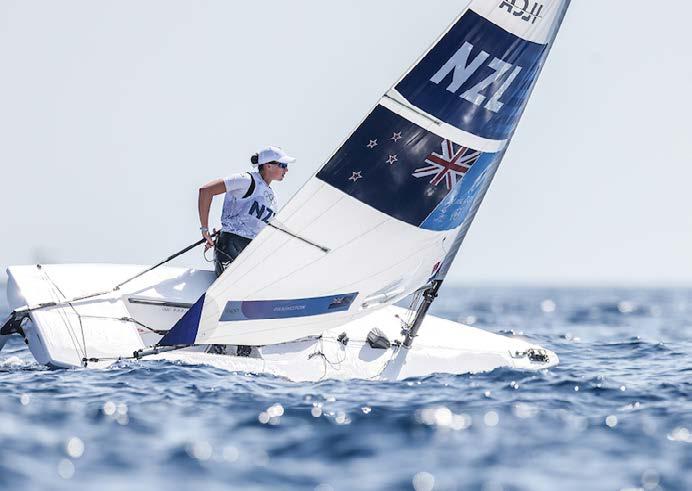
overlooked by many.
“Knowing how to cook and feeling comfortable in the kitchen is essential, especially when you start competing abroad and must prepare your own meals. A good tip is to learn how to make five or six core meals really well. This reduces the stress of meal planning.”
Pilkington, 21, shared several real-life examples of how nutrition has impacted her performance.
“I remember one year at Oceanbridge [Sail Auckland], we had a really long day on the water, and all I’d eaten was a muesli bar and some watermelon,” she said. “It ended up being a lot tougher out there than it needed to be. These days, I always have snacks on hand – in fact, my car resembles a mini grocery store!”
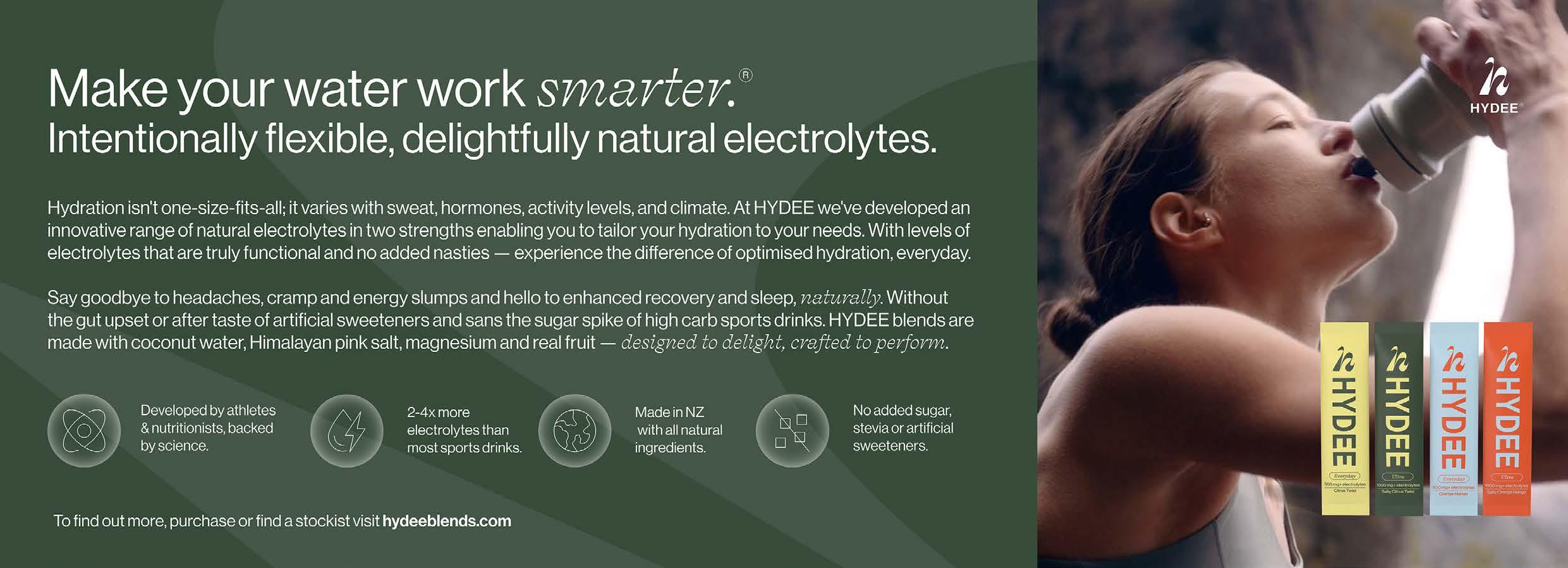
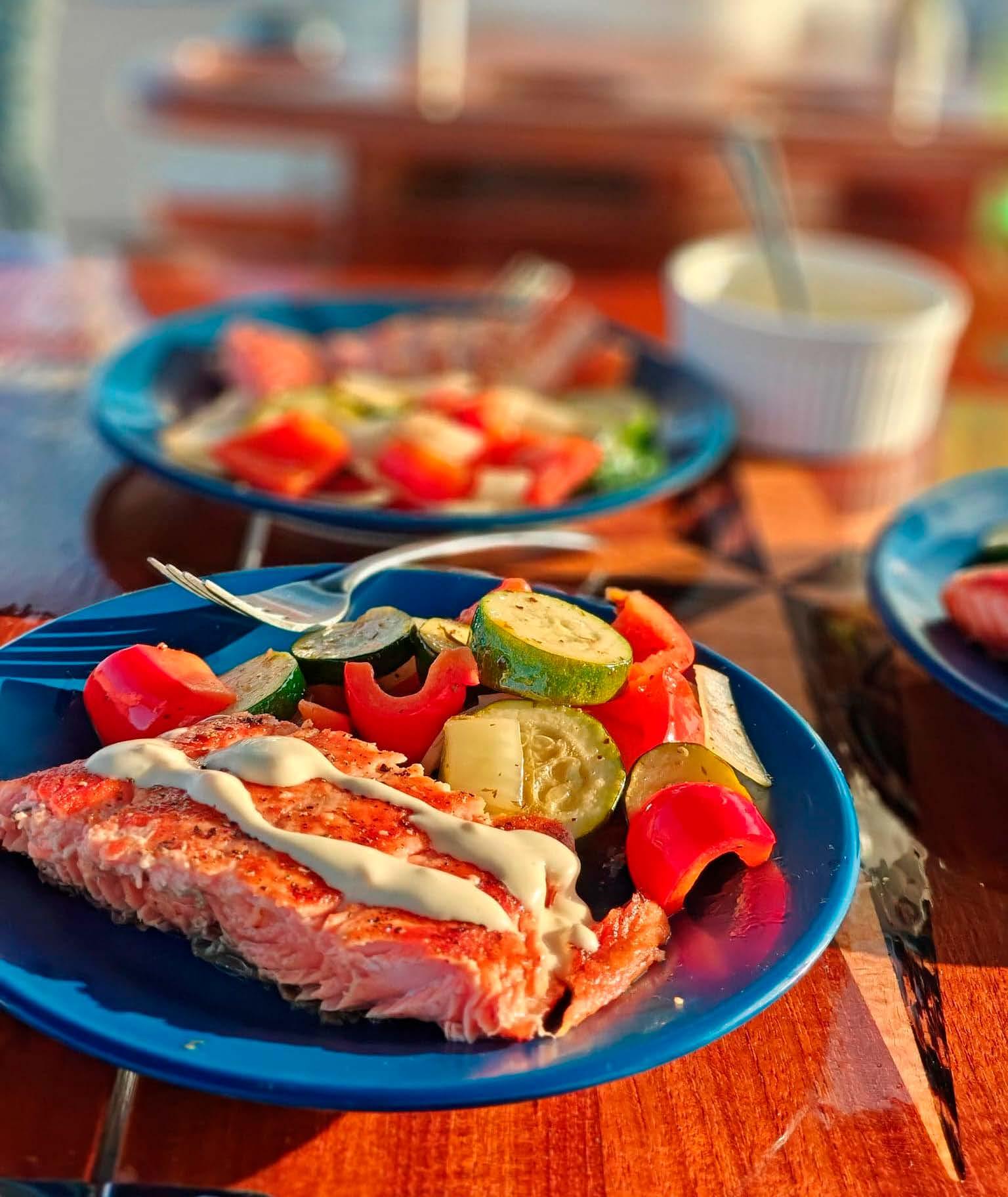
Setting sail for a long passage – or even a weekend of cruising – requires more than just plotting a course and hoisting the main. Proper provisioning can make or break a trip, writes Kathy Catton
Sailing is a physically demanding and mentally challenging sport and hobby. Add to this the fact that your fridge might only be the size of a small chilly bin, and your fresh water supply is limited and reliant on a pump, and eating and drinking can get complicated.
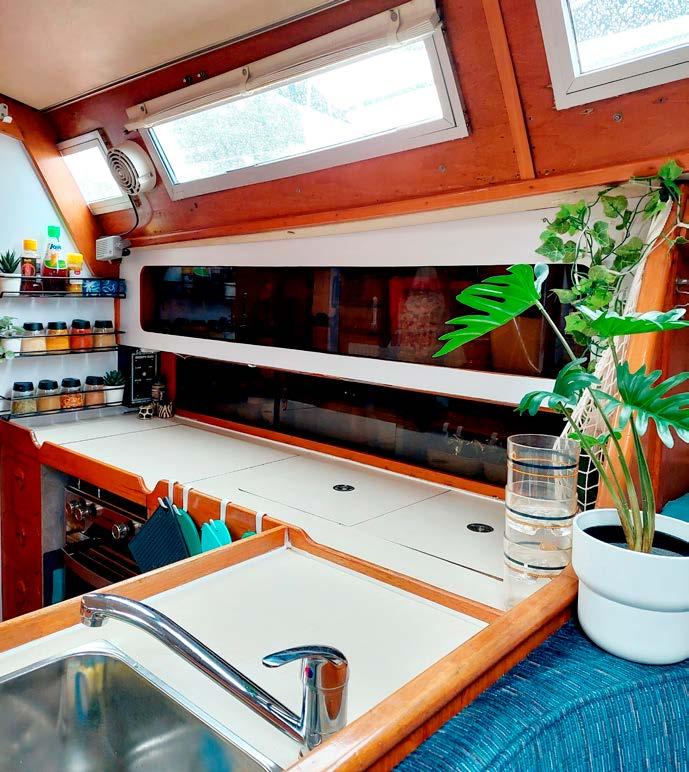
she approaches the essentials:
Balanced diet: Plan balanced meals that offer a mix of proteins, carbs and healthy fats to sustain energy, reduce inflammation and boost immunity. For instance, combine brown and white rice to provide you with both immediate and sustained energy. Incorporate a variety of foods to cover your nutritional bases.
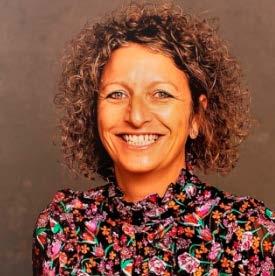
Unlike meals on land, your diet at sea needs to be tweaked to adapt to increased physical activity and potential stress. Carbohydrates become your quick energy fix, while proteins are crucial for muscle repair and immune function. Hydration also plays a vital role.
Effective provisioning starts with understanding your nutritional needs and meeting them within the confines of a galley. Sarah Powell Fowler is the founder of Small Vegan Kitchen. She’s also a sailor, certified coach and plantbased nutrition consultant specialising in helping cruisers implement greener, more sustainable galley operations. Here’s how
Transferable foods: Stock versatile items that can be used across different meals, whether you’re facing rough weather or calm seas. Avocados, nuts and chickpeas are great examples. Avocados can be eaten fresh, turned into guacamole, or used in salads, while nuts can serve as snacks or be blended into energy-dense pre-mixes. Preservation and storage: As space and refrigeration are often limited on a yacht, prioritise foods with a longer shelf life or those easy to store. Canned goods, dried fruits, and vacuum-sealed items are your friends here.
A well-organised galley can make meal preparation a breeze. Powell Fowler suggests using stackable containers and clear bins to keep ingredients organised.
“Label everything to minimise search time and confusion,” she says. “I also advise sailors to keep cooking tools to a minimum while making sure they cover all your needs. A sharp knife, a few pots and pans, stainless steel bowls and basic utensils should suffice. Multi-purpose tools can save space and
simplify cooking, especially if they stack compactly. A yoghurt maker and a pressure cooker have been game changers for us.”
Efficiency is key in a galley, especially in rough conditions. Prepare pre-mixed flavour spice blends for quick meal enhancements. A garlic and parsley mix, or pre-mixed spices, can transform simple dishes into flavourful meals with minimal effort.
Keeping food fresh at sea can be a challenge. Using freezer bags to prevent freezer burn and leaks
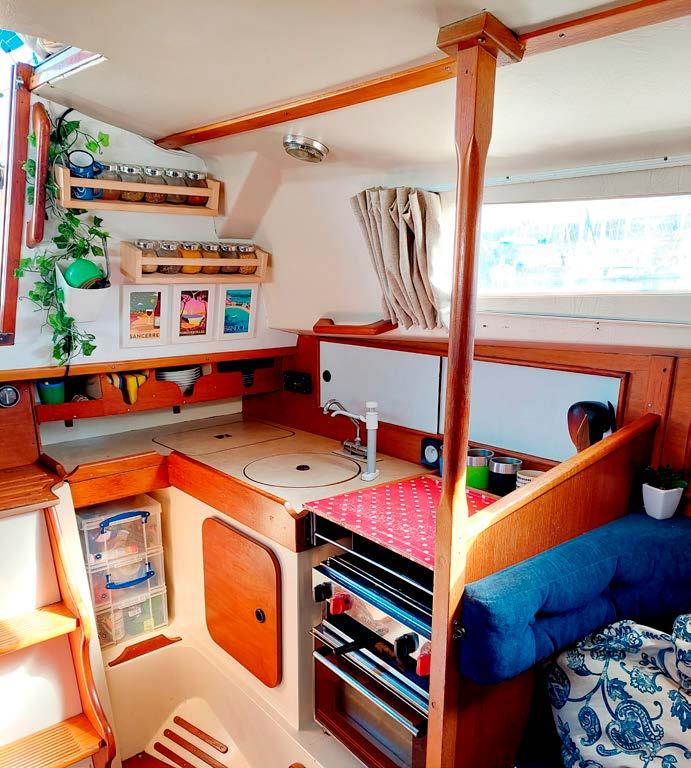
can help. She also recommends investing in a handheld vacuum sealer for longer passages.
“Removing air from packaging really helps prevent spoilage and keeps food fresh for longer,” she says. “It’s also crucial to maintain a consistent fridge temperature and avoid overloading it to ensure proper air circulation and efficiency. Simply rotating supplies will sometimes minimise waste and ensure your food goes further.”
We’ve all had those tough days of terrible weather or gruelling conditions. Planning ahead seems to be the advice here. Having a few go-to recipes and lots of snacks for these occasions can boost crew morale and provide a welcome break from the conditions.
“We prepare a grab bag with two days’ worth of essential items like muesli bars, chips, and pre-made wraps that is stored under the table in the cockpit,” Powell Fowler says.
Stocking up isn’t just about filling your galley; it’s about curating a balanced, nutrient-rich supply. Work out how long you’ll be at sea and add a couple of extra days (or weeks) to allow for bad weather or other dramas. Powell Fowler suggests the following categories when purchasing:
Carbohydrates: Opt for complex carbs like brown rice, wholegrain pasta, quinoa and sweet potatoes. They’re versatile and keep well.
Proteins: Include plant-based options such as lentils, chickpeas, beans and tofu. They’re nutritious and have a long shelf life. Our New Zealand peanut butters are also a big tick here.
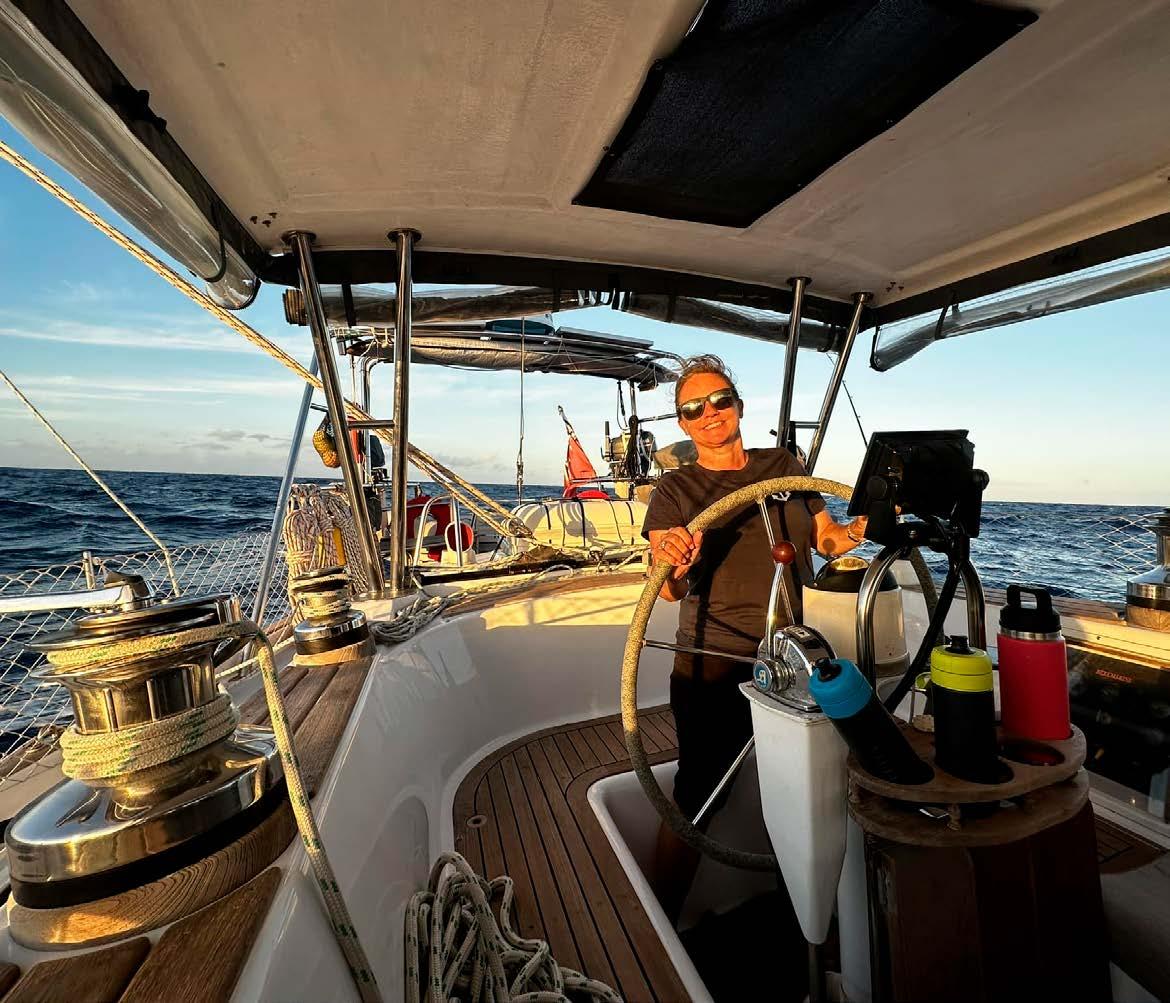
Healthy fats: Stock up on olive oil, avocados, nuts and seeds. These add flavour and provide essential calories and nutrients.
Fruits and vegetables: Prioritise seasonal produce for freshness, and supplement with canned or dried options. Buy local from farmers’ markets or fresh produce stores where you can.
Herbs, spices and superfoods: Enhance your meals with a diverse range of herbs and spices. Superfoods like garlic and ginger offer both flavour and health benefits.
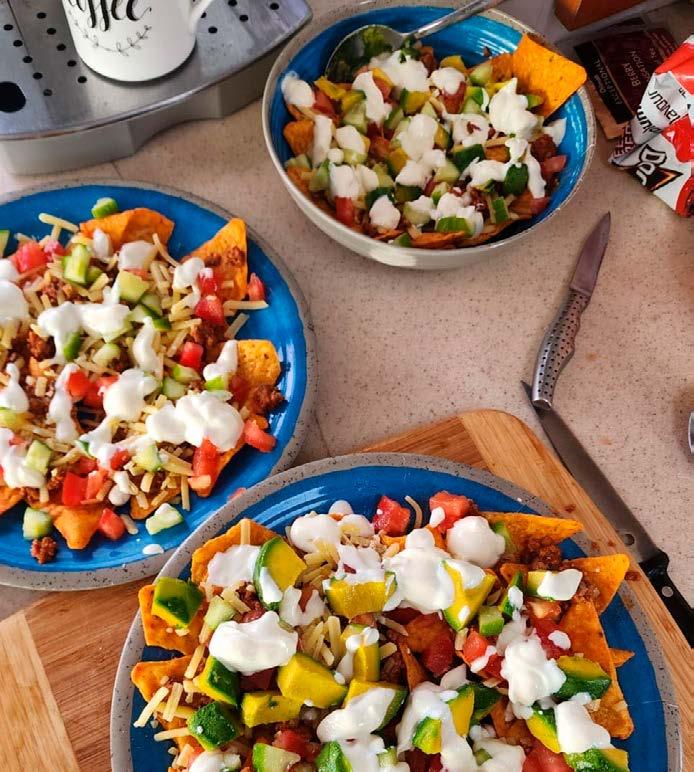
Baking essentials: If you enjoy baking, keep a stock of various flours and baking ingredients. Powdered eggs are great, too, and you could always pre-mix all the dry ingredients before you set sail.
Treats and comfort foods: Include indulgent items like chocolates and biscuits to boost morale during tough times.
“When setting off on a long passage make as many pre-prepared meals as you can so you can just heat and eat,” says Viki Moore, long-time cruiser and owner of Island Cruising NZ and Down Under Rally.
“My favourite is spaghetti Bolognese sandwiches! If you have a freezer, this makes life easier, too.”
Another tip is to have named drink bottles that can be easily stowed.
“This makes getting a drink easy for people on watch and there is no waste and cup washing. CamelBaks under the lifejacket is a winner, especially in the heat,” she says.
“Taste everything to make sure you like them before buying up loads of tins.
“Get yourself a decent stainless steel thermos flask, and whenever you boil the kettle, put the remaining hot water in the flask. This can then be used for washing the dishes, or hot drinks, soups and noodles in an instant – and it saves your precious gas, too.”
Recycling all the plastic and cardboard before you leave the dock to get rid of as much rubbish as you can before you set off, creates more space on board and saves costs of disposal when you arrive at your destination.
“Check and respect the biosecurity regulations in any countries you visit, so you don’t over provision on prohibited items.”
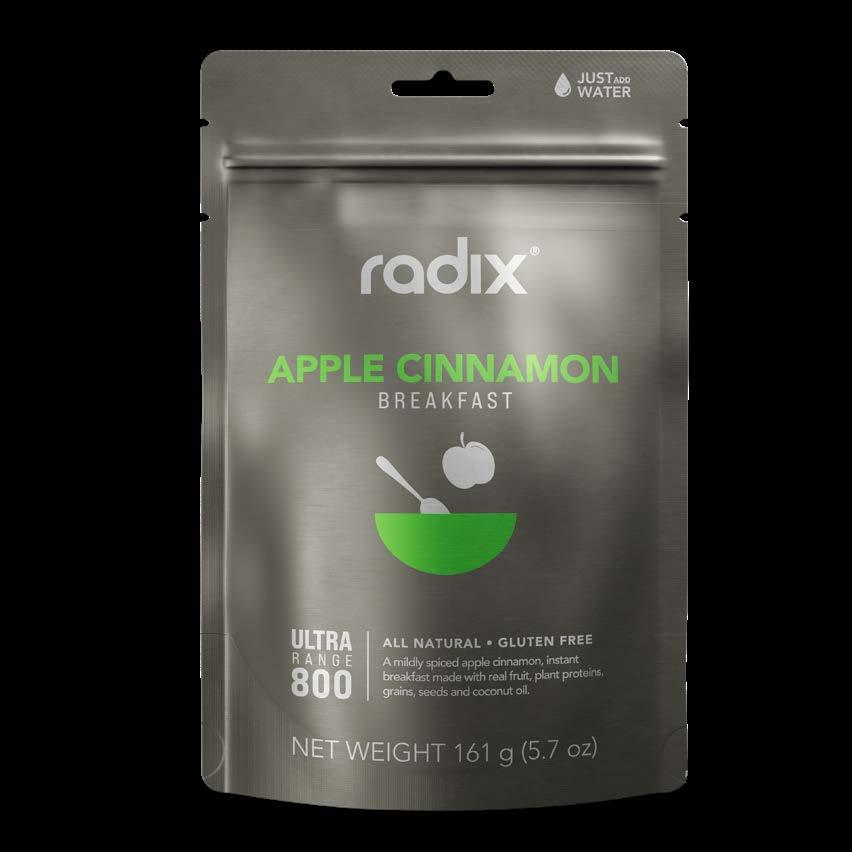
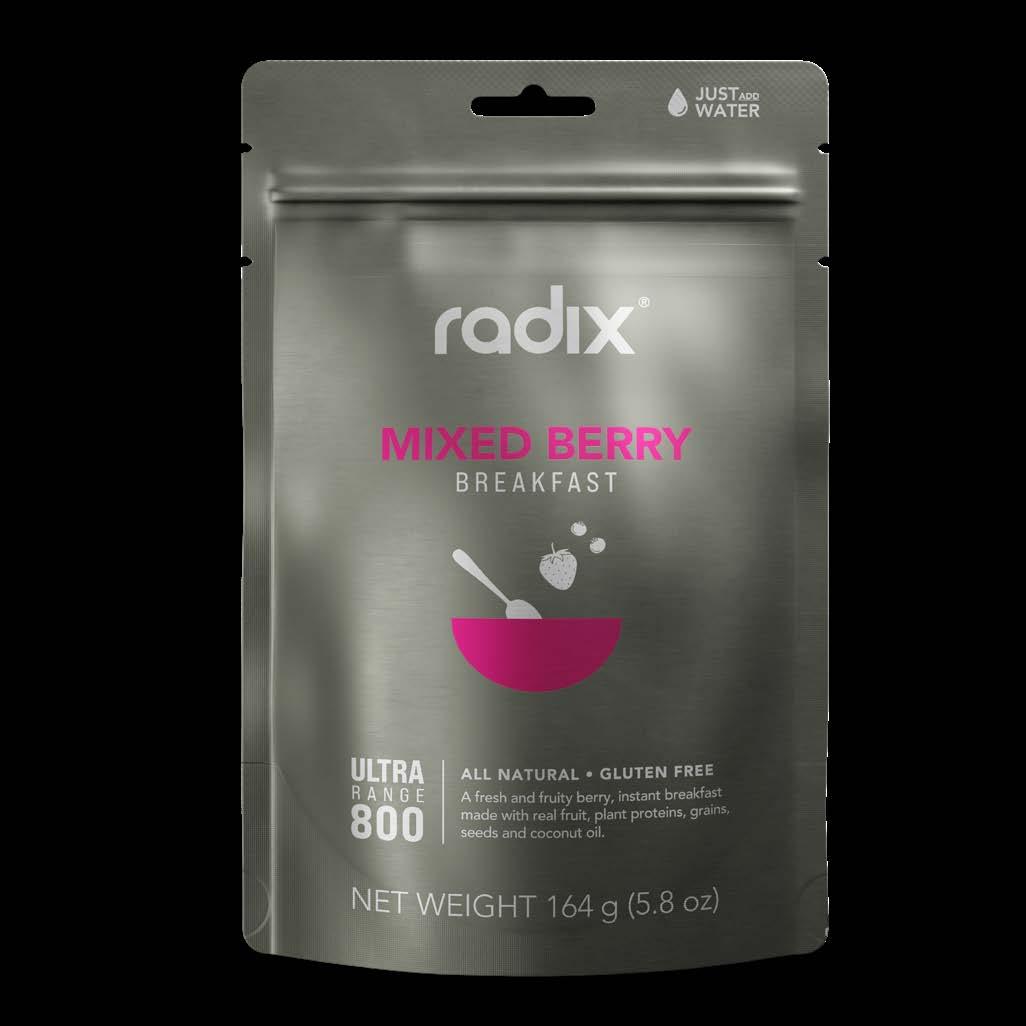
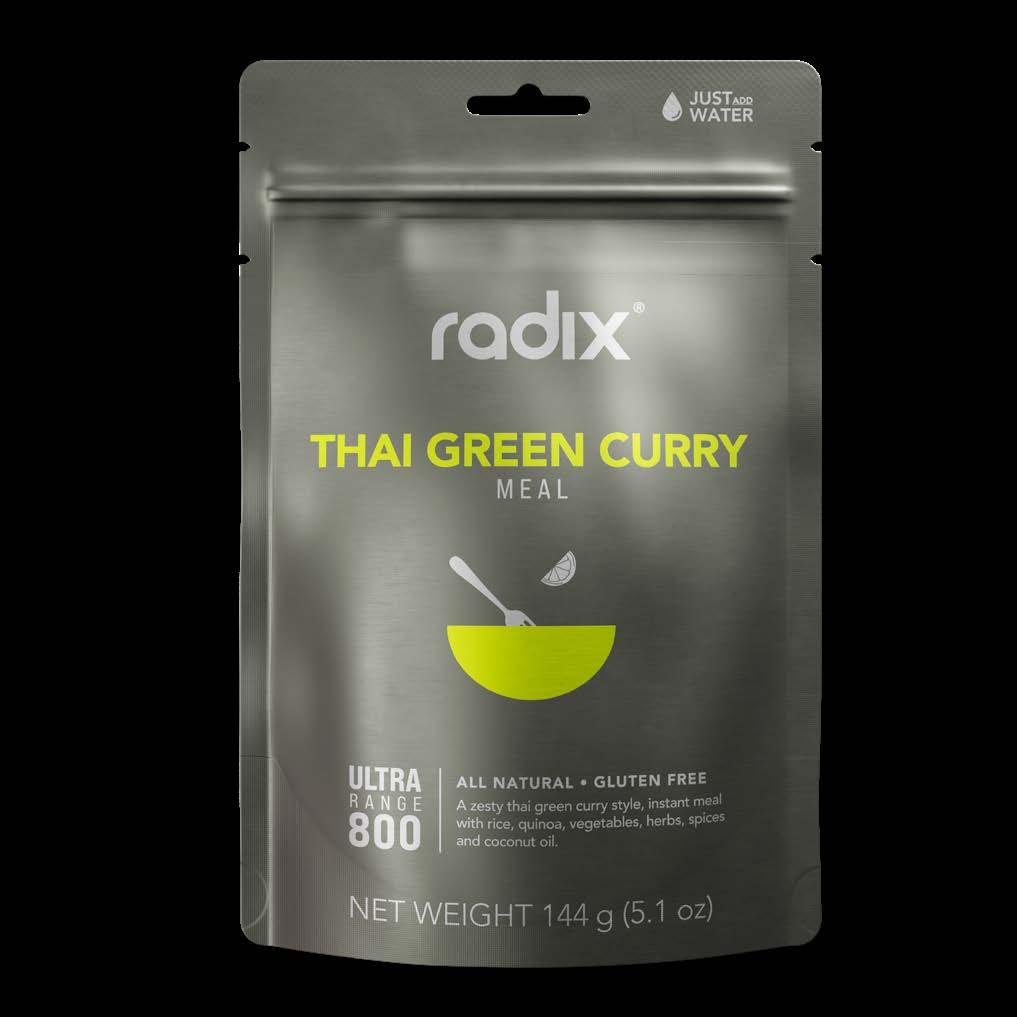
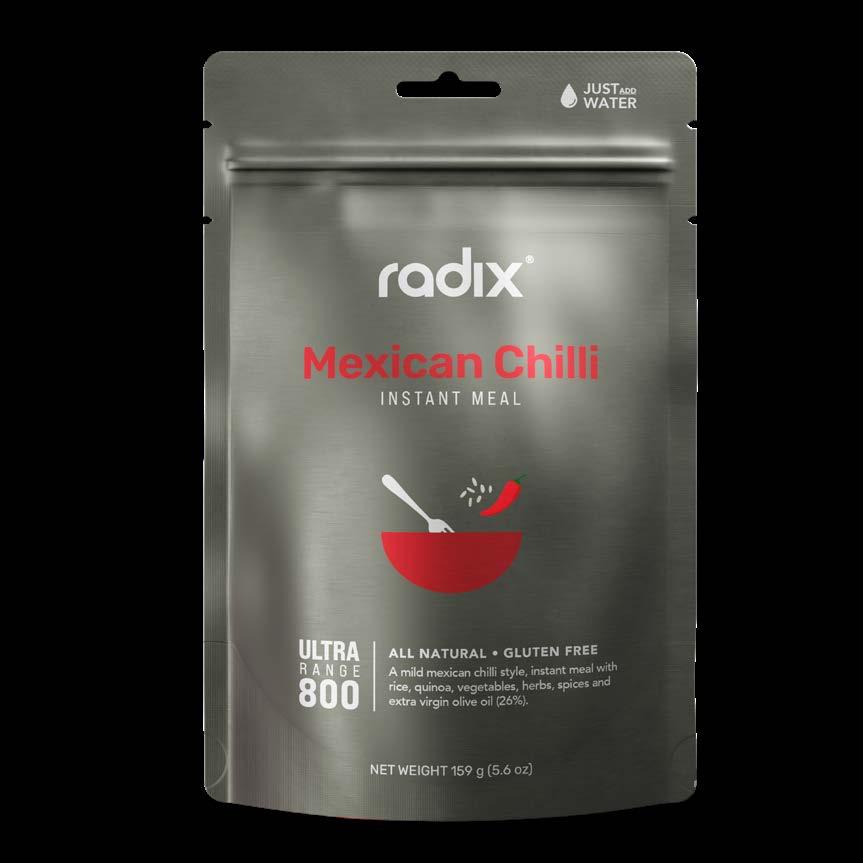
Reliable and nutritious, Radix offers a gamechanging solution for your next voyage.
Radix provides a game-changing solution for cruisers and offshore sailors, offering nutrient-dense, easy-to-prepare meals that ensure optimal energy and well-being during long voyages.
With a focus on natural ingredients, each Radix meal delivers a balanced blend of proteins, healthy fats, and essential vitamins to support stamina and focus when it’s needed most.
Apple Cinnamon breakfast
Ultra 800kcal range
Mildly spiced apple cinnamon instant breakfast made with real fruit, plant proteins, grains, seeds and coconut oil.
Mixed Berry breakfast
Ultra 800kcal range
Fresh and fruity berry instant breakfast made with real fruit, plant proteins, grains, seeds and coconut oil.
Thai Green Curry meal
Ultra 800kcal range
Zesty Thai green curry-style instant meal with rice, quinoa, vegetables, herbs, spices and coconut oil.
Mexican Chilli meal
Ultra 800kcal range
Mild Mexican chilli-style instant meal with rice, quinoa, vegetables, herbs, spices and extra virgin olive oil.
Berry and banana recovery smoothie
Whey or plant options
Our Ultimate Recovery Whey Smoothie adds micronutrient-dense superfoods and bioactive collagen to go beyond a regular recovery shake and give you complete recovery.
Lightweight, compact, and requiring minimal preparation, Radix meals are perfect for limited onboard storage and quick fuelling on rough seas.
Free from artificial additives and gluten,
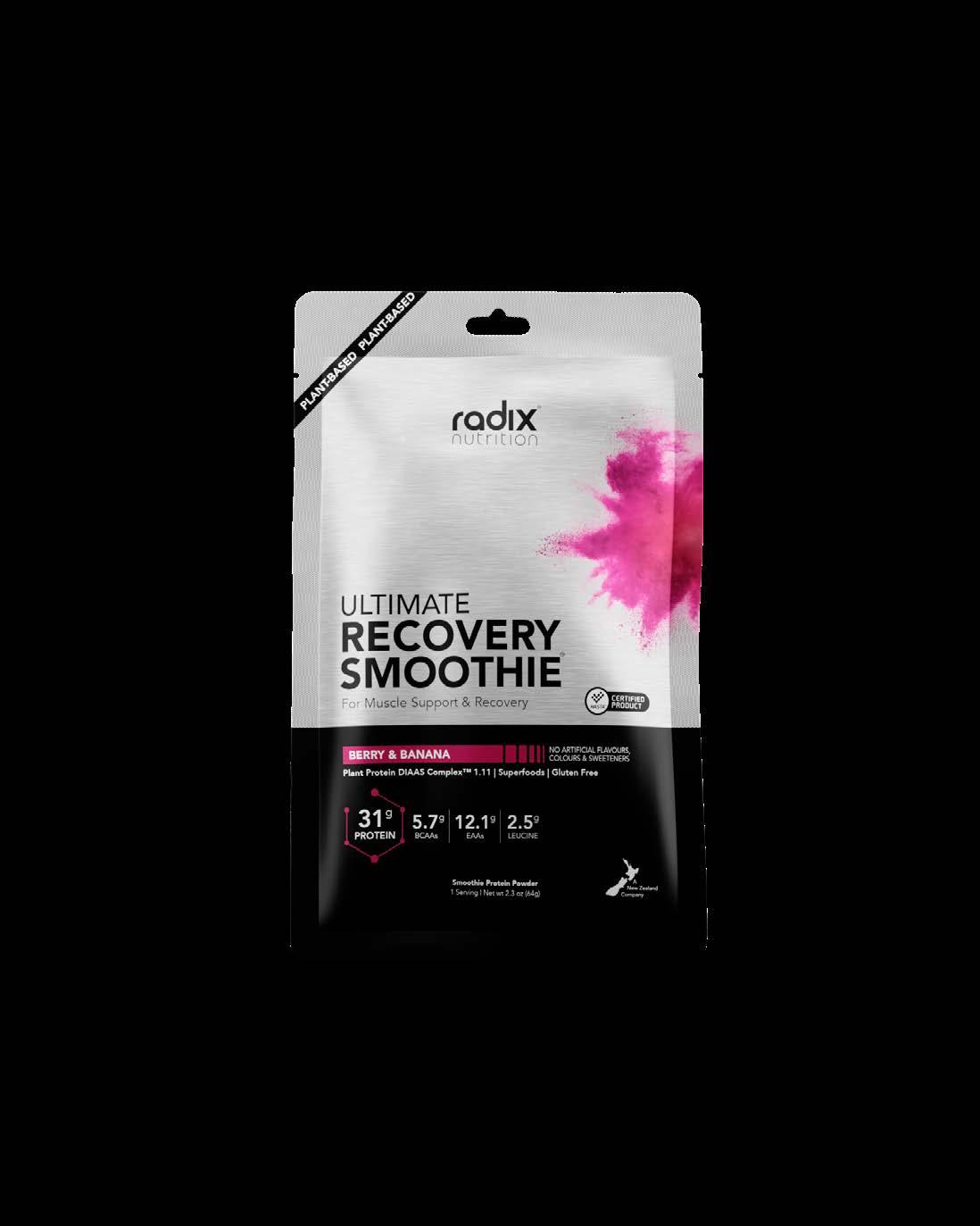
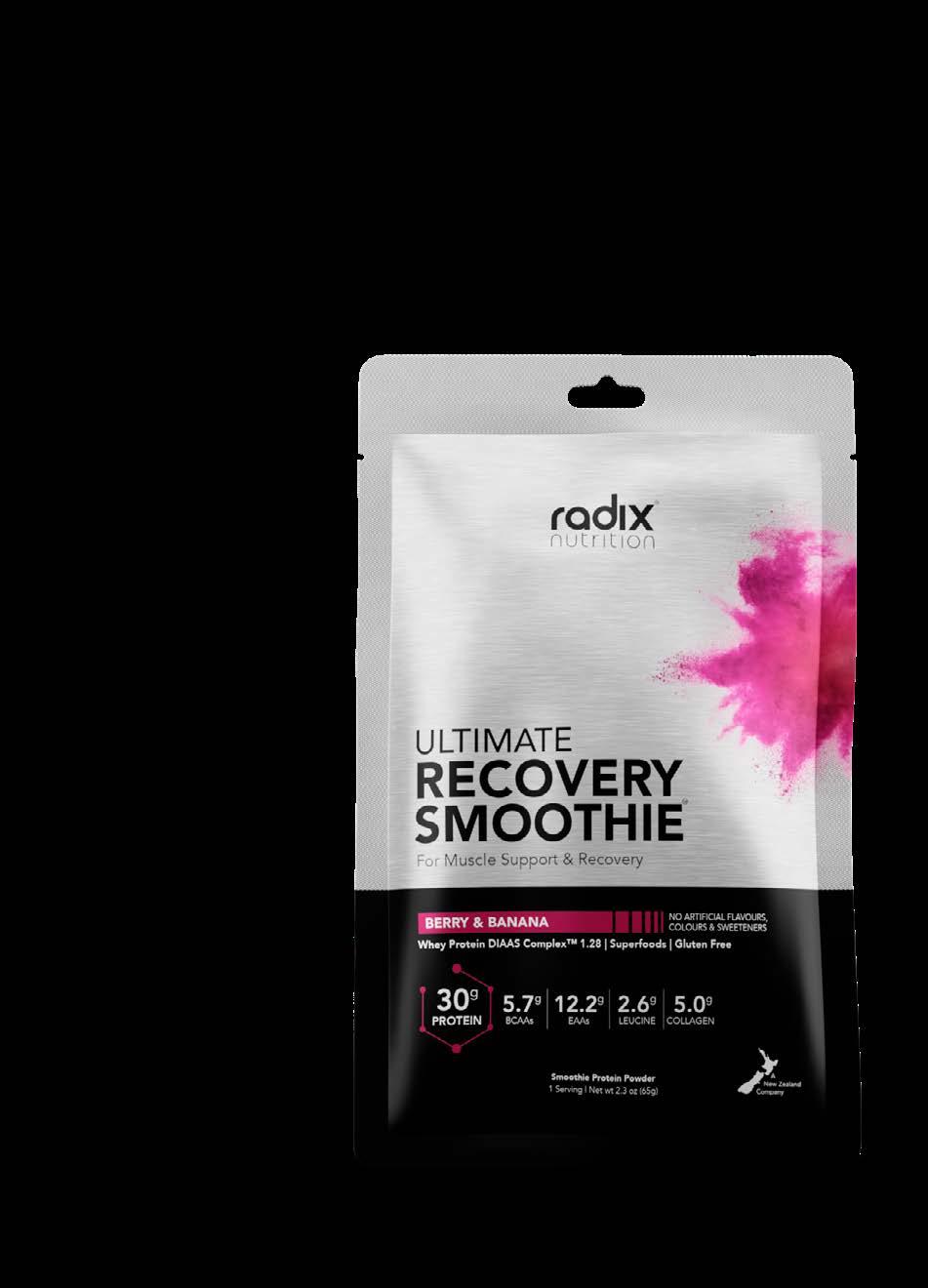
When a boat becomes part of the family 70
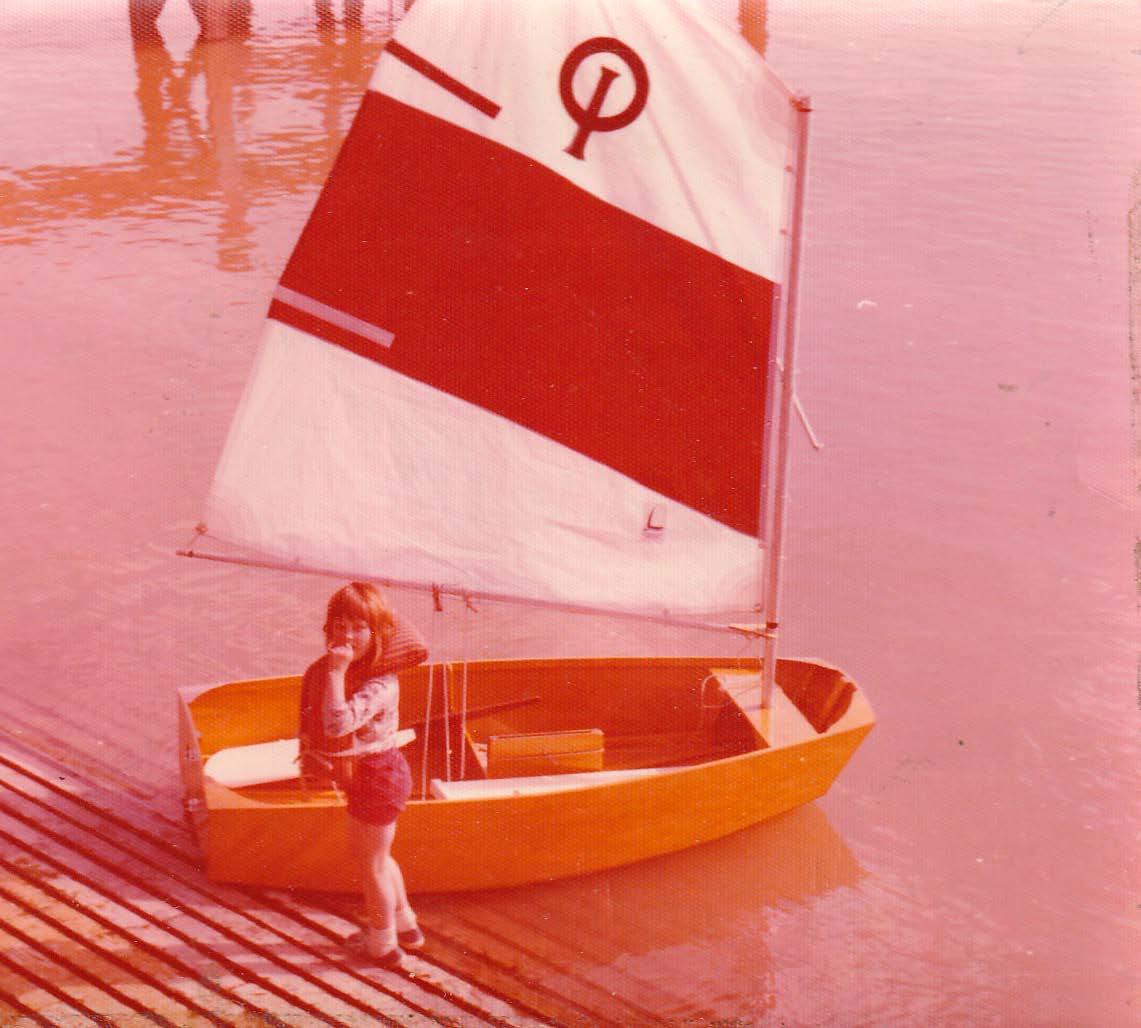
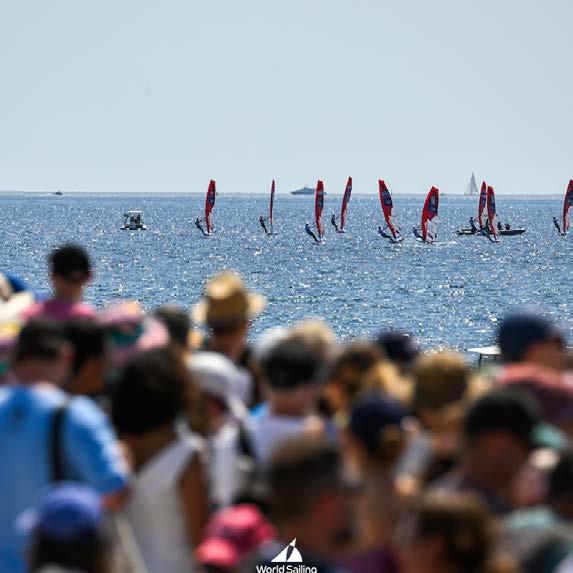
How to host a big regatta 64
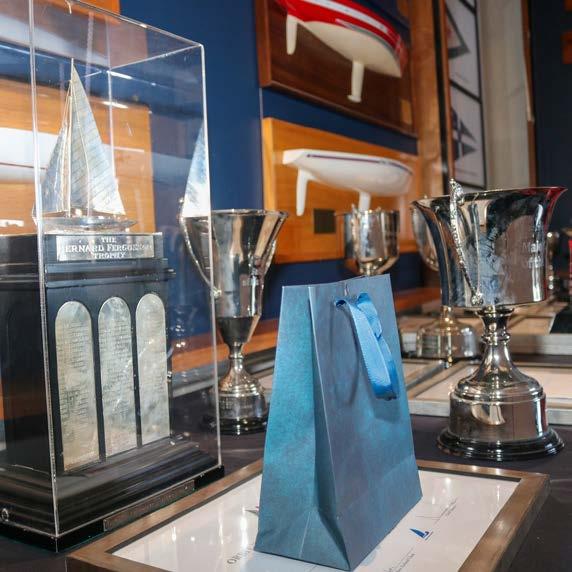
Early winners announced 66
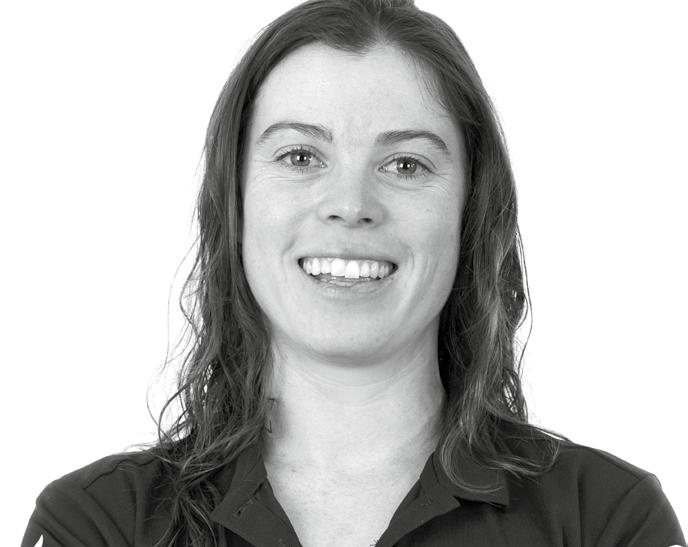
Erica Dawson FROM THE BOAT PARK
Inaugural event in Barcelona represents a new high in female sailing – now we have to
away from my own journey.
But how much has changed.
I’ve just returned from Barcelona after an unforgettable few months participating in the inaugural Women’s America’s Cup for Emirates Team New Zealand
We had high hopes that it would be a popular addition, but the atmosphere, the excitement, and the sheer support for the event surpassed anything I’d anticipated. We flew to Barcelona almost straight from the closing ceremony of the Paris Olympics Games, and the energy was electric.
Sailing the AC40s felt like a fresh start – a welcome shift that brought a sense of renewal. We were still riding the Olympic high but now channelling it into something entirely new, and that was
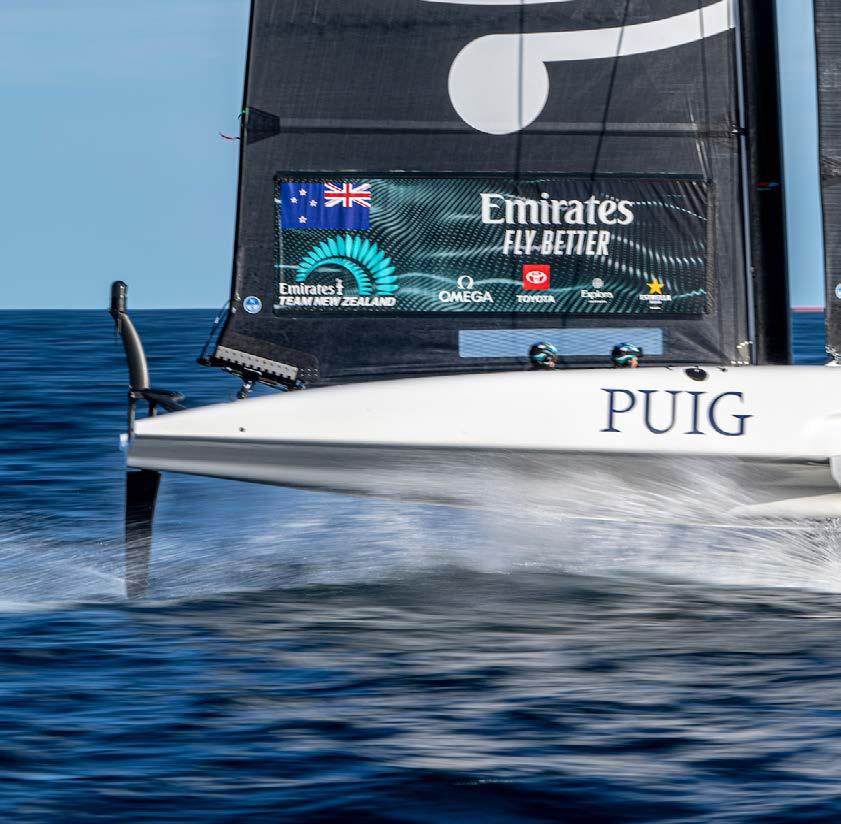
and I can see how this will influence the
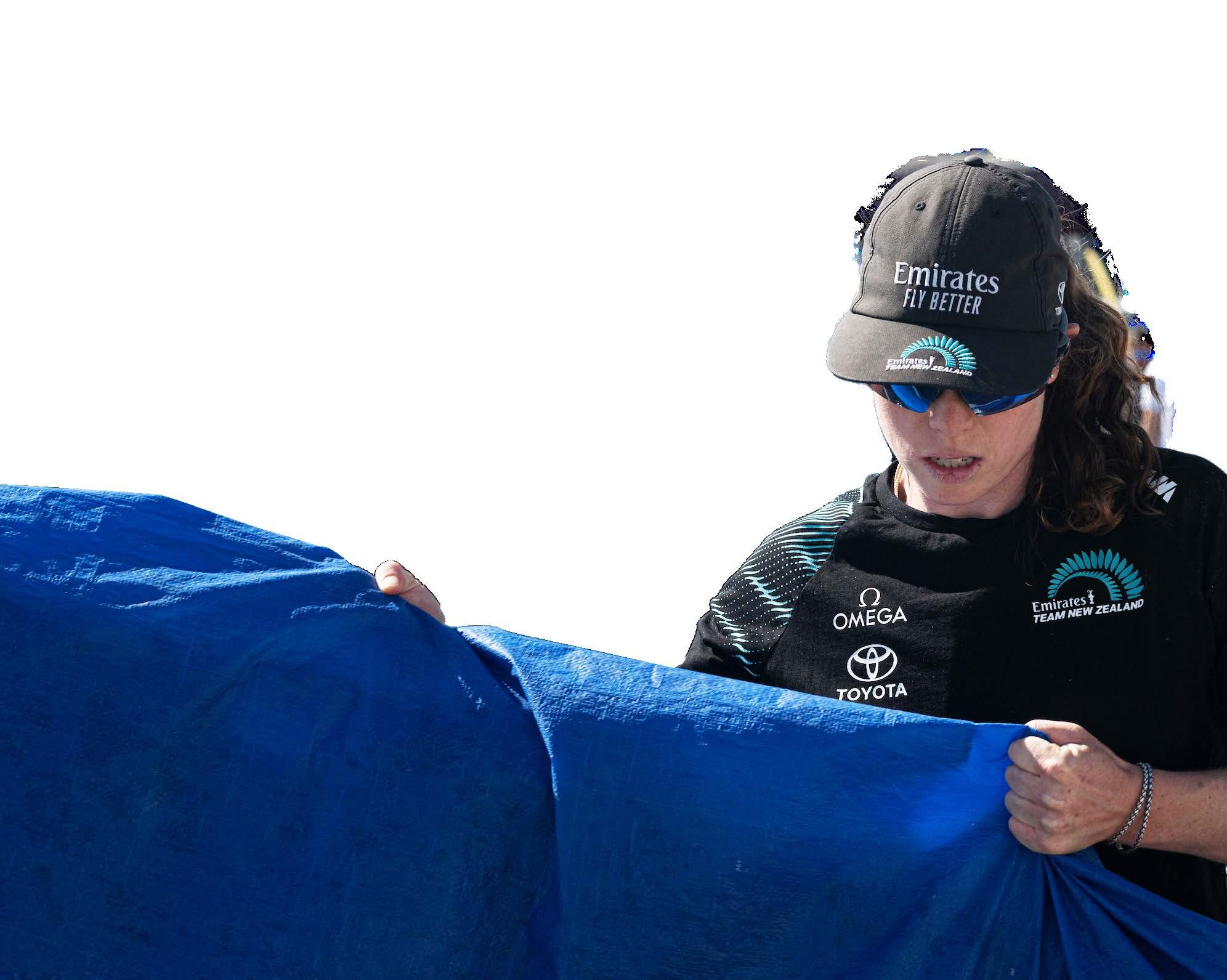
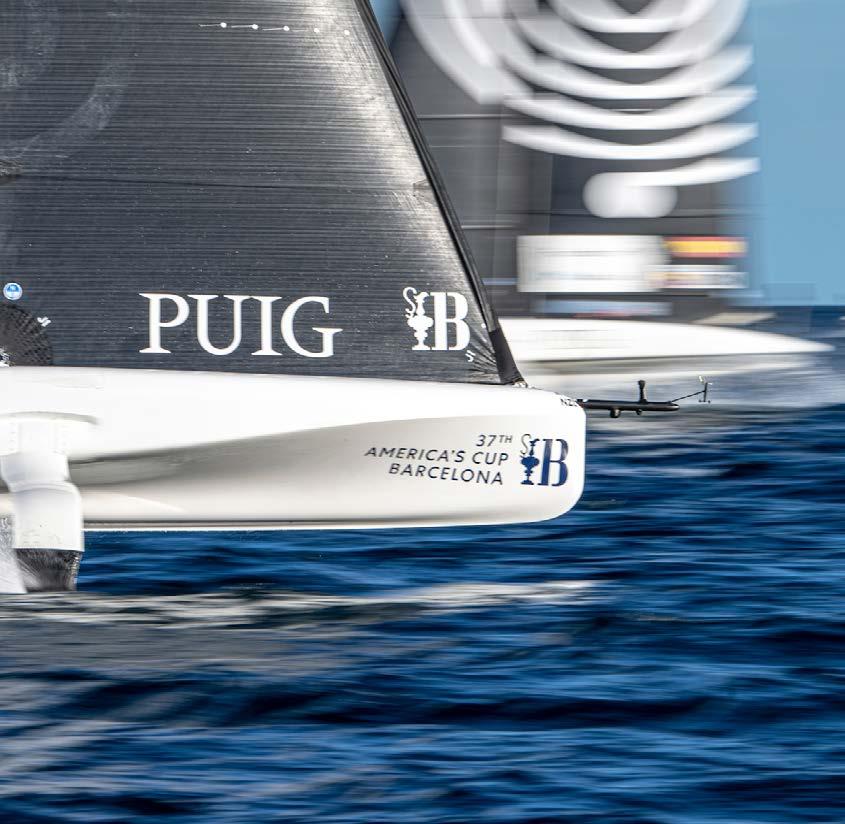

contributed to Yachting New Zealand’s Women and Girls in Sailing strategy back in 2019, but there’s something about the America’s Cup that stands apart. It’s a new level, a momentum that feels
And what’s especially exciting is that the America’s Cup isn’t just for sailors anymore. There are roles for people in tech, strategy, logistics, and so much more. I hope this is just the start of a sustained Women’s America’s Cup circuit in the AC40s, with bigger, better campaigns and more opportunities for women to gain experience in racing and training. If I had one message for Kiwi girls considering sailing as a career, it would be to never underestimate where this passion can lead you. Keep enjoying it. There are so many pathways available now, more than ever before, so if you haven’t found your niche, try something else. Find what excites you, and pursue it with everything
You may be surprised at just how
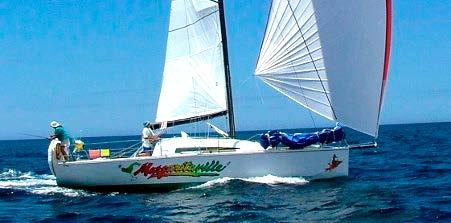
In the first of a new series on the origin of quirky boat names, Kathy Catton delves into the story behind ‘Margaritaville’.
At 84, seasoned sailor Garry Elliott reflects on a lifetime spent on the water. His sailing journey began in childhood, experimenting with “small Zeddies alongside my cousins”.
However, it was his involvement with a group from the M Class that transformed his casual pastime into a serious passion. In 1992, he decided to build a Ross 930 with one of his original crew: house builder-turnedboat builder Tom Jefferies.
“It was during that build that I was introduced to Jimmy Buffett’s music,” explains Elliott. “I thought Margaritaville was a really neat song, so we decided to name the first boat Wasted Away, after the first line of the chorus.”
When Elliott sold this boat five years later, he didn’t stray far from the theme. His next vessel, a Ross 1066 built by Craig Partridge, continued the homage with the name Wasted Away Again, reflecting the same laid-back, tropical vibe. She also lasted five years with Elliott.
But the story doesn’t end there. His third boat, fittingly renamed Margaritaville, completes the trifecta of Buffett-inspired names. This playful
naming tradition wasn’t just for show. Each boat launch was celebrated with a stuffed parrot as “guard bird” – one of which even travelled from Buffett’s bar in Key West, Florida to New Zealand, thanks to an airline pilot friend.
“Jimmy always referred to his fans as ‘parrot heads’ so that’s how that all started.”
To add to the charm, each boat was adorned with artwork of a reclining parrot enjoying a margarita cocktail. Good friend Colin Rickett even contributed to the boat’s memorabilia by designing T-shirts featuring this iconic imagery.
It also appears the unique parrot mascot has brought good luck and mischief along the way.
“I sold Wasted Away Again to friends, but they told me the parrot was getting in the way. They took it down and stuffed it in a locker. The next day the mast broke! The same thing happened with Wasted Away: unbeknownst to the crew the parrot fell off its perch and the same day the boat lost its rudder.”
While it may have taken Elliott 10 years of boat building to get through the first chorus of the Margaritaville song, these boats have brought many decades of joy to him and his crews. If you have any fun or quirky stories about your boat’s name, please send them through to eduan@yachtingnz.org.nz
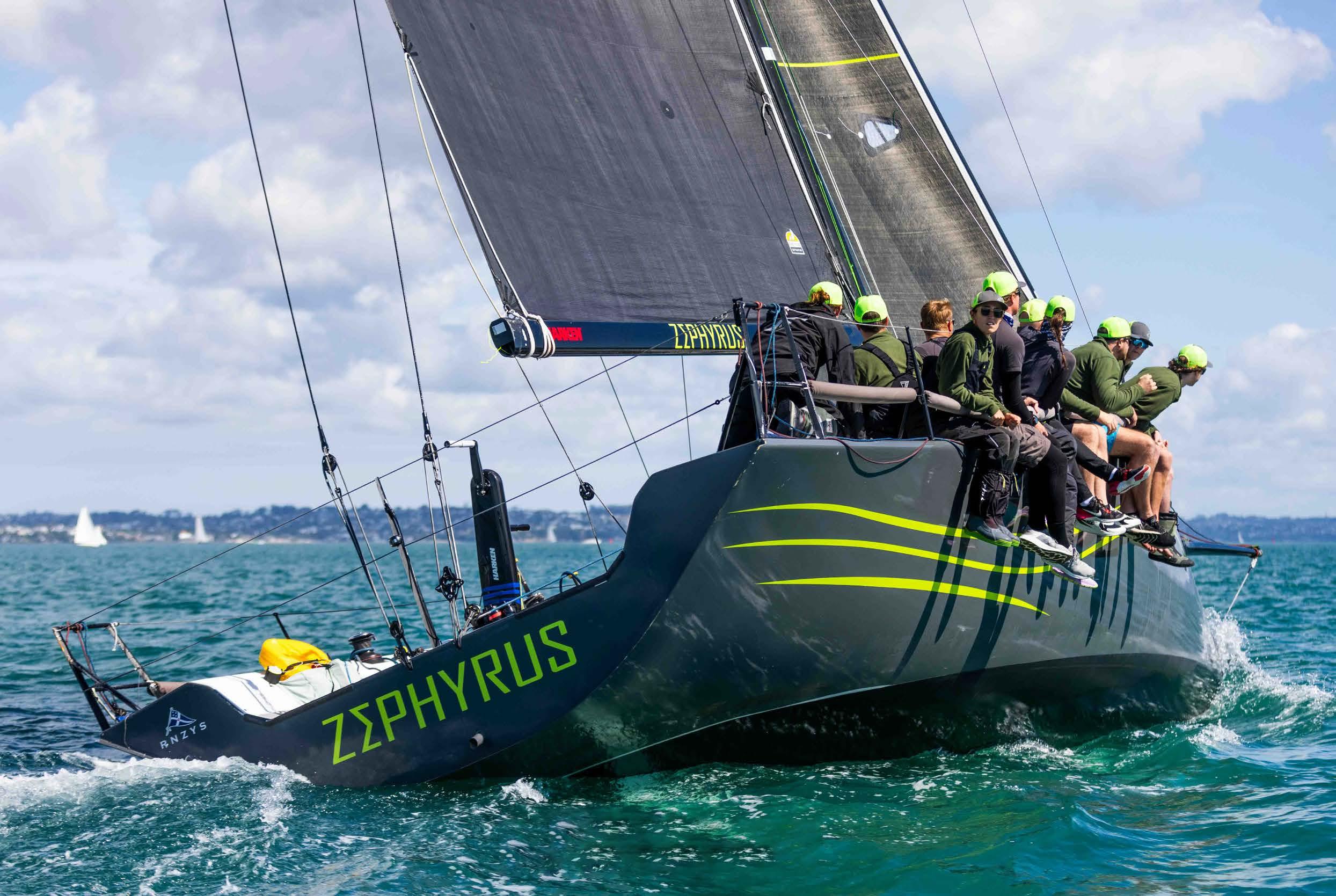
Romanza and Fez were two of the big winners in a challenging 2024 PIC Coastal Classic – the former taking out line honours and the latter first on handicap.
Romanza, an 18m trimaran skippered by Dougall Love, crossed the finish line at 01:46 for an elapsed time of 15 hours and 46 minutes, followed at 03:18 by Levity, and just a few seconds later by the first monohull, Graham Matthew’s Equilibrium
The trio used their size and performance to seal the top three places on line but soon after, the first of the smaller keelboats arrived: Clockwork at 03:59, Zephyrus at 04:20 and Vixen at 05:15.
Amid this bunch was Sir Peter Blake’s 1989 Whitbread-winning yacht Steinlager 2 – now owned by the New Zealand Sailing Trust and at 25m in length, likely the most comfortable boat in the fleet to undertake an upwind race on. Steinlager 2 finished at 04:47.
The navy-blue Warwick 50 Fez, owned by Justine and Casey Bellingham, was ninth on line but took out the coveted title of overall PHRF honours in the race.
Vixen was second, and Zephyrus third.
“We’d like to congratulate our handicap winners,” said Adrian Percival of the New
Zealand Multihull Yacht Club.
“It was tough out there, many boats withdrew before or in the early stages of the race, and those that went on to finish really put in the mahi.”
The last finishers took more than 24 hours, making it one of the longer events in the race’s history.
Just 39 of the 67 starters finished the upwind race.
The PIC Coastal Classic is the country’s pre-eminent fleet race and takes competitors 119 nautical miles from Devonport, Auckland to Russell Wharf in the Bay of Islands.
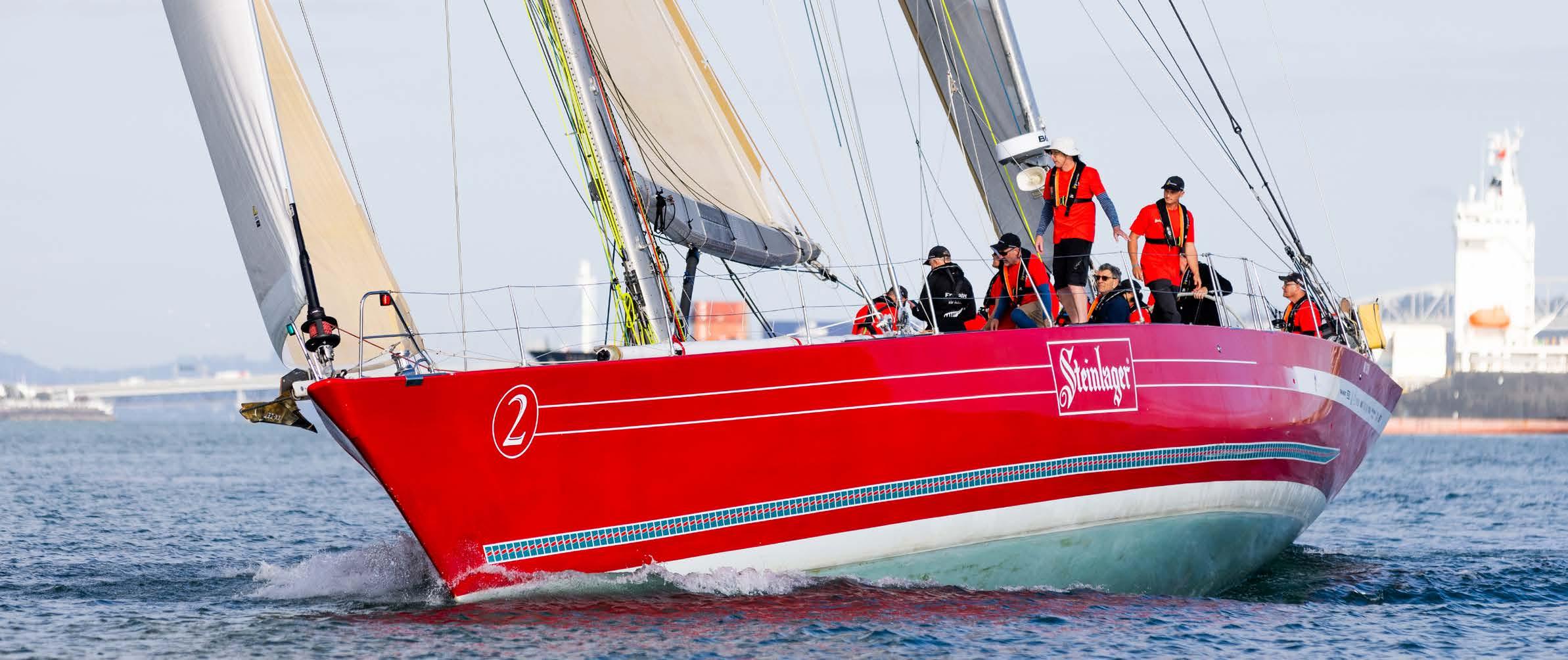
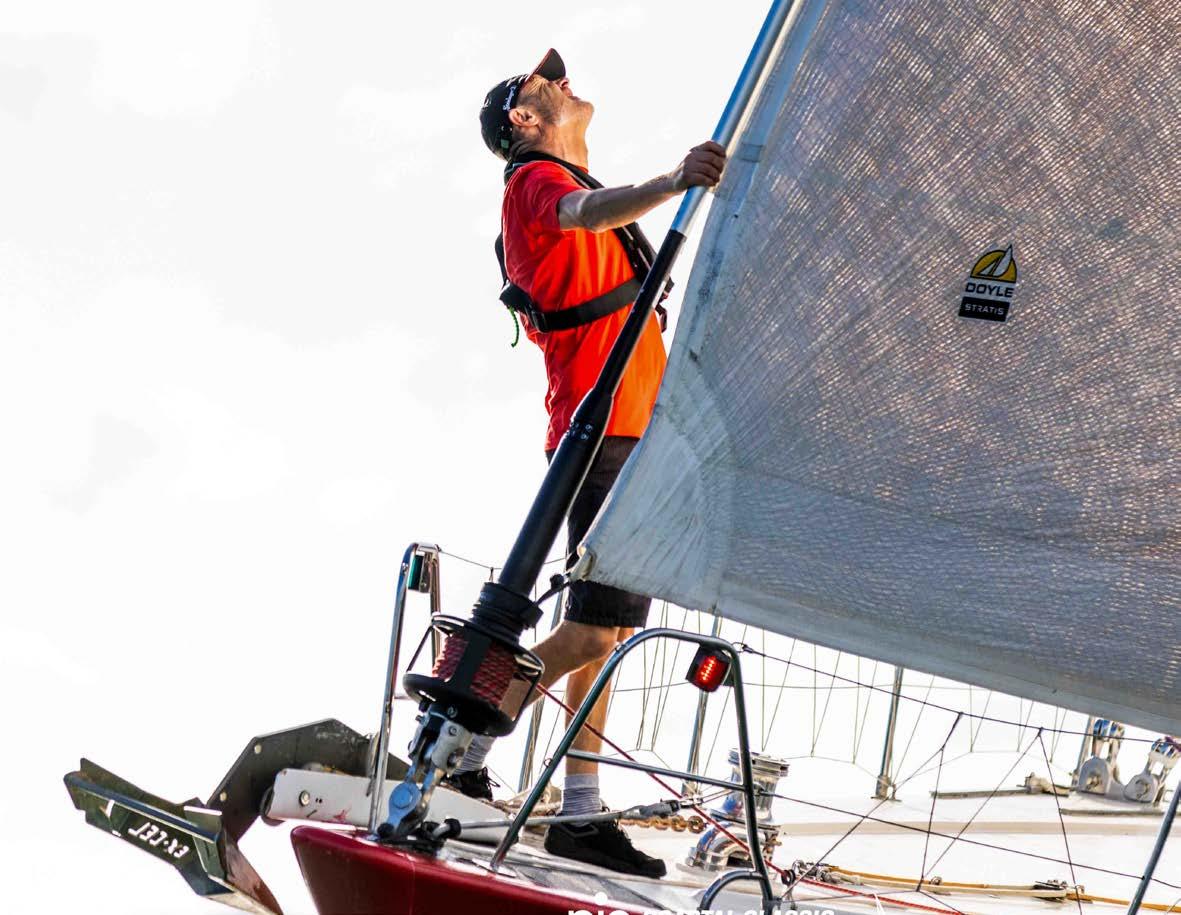
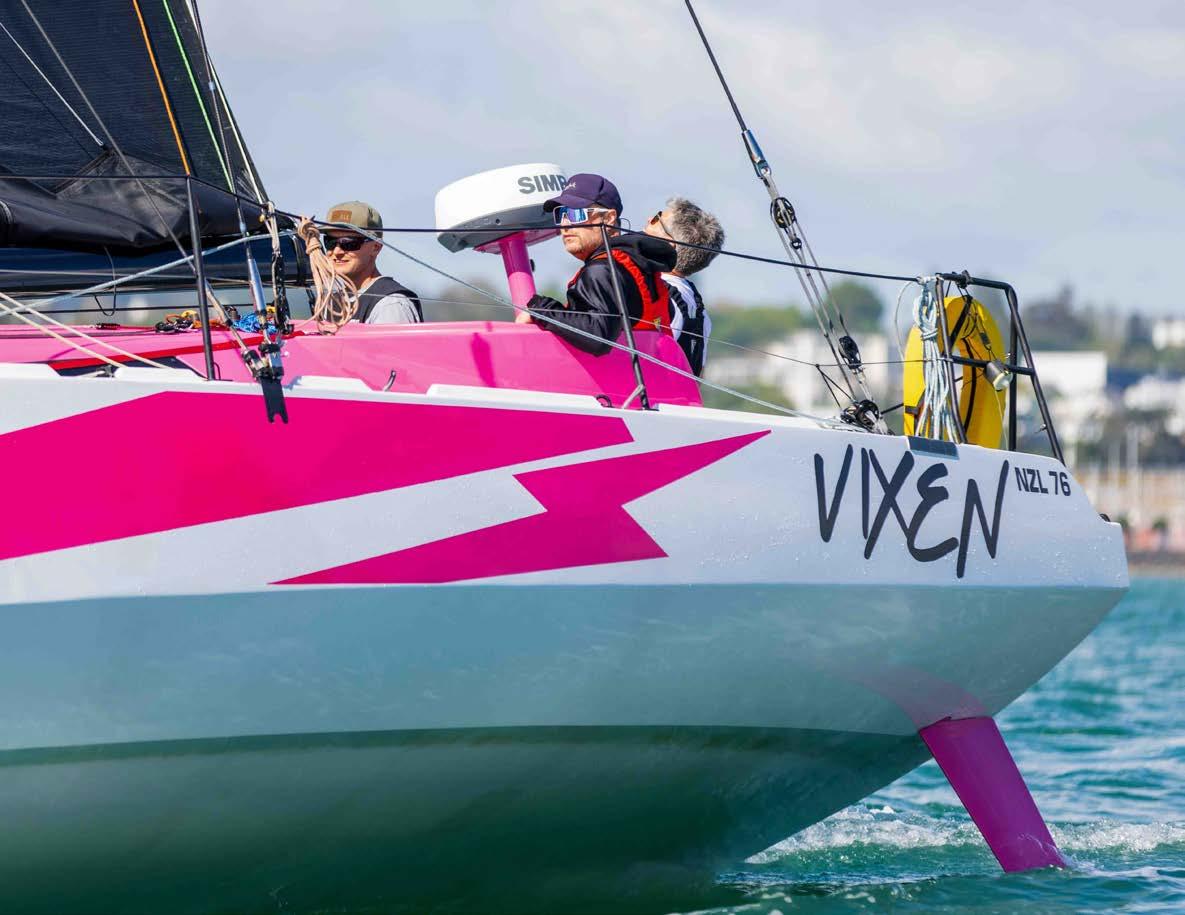
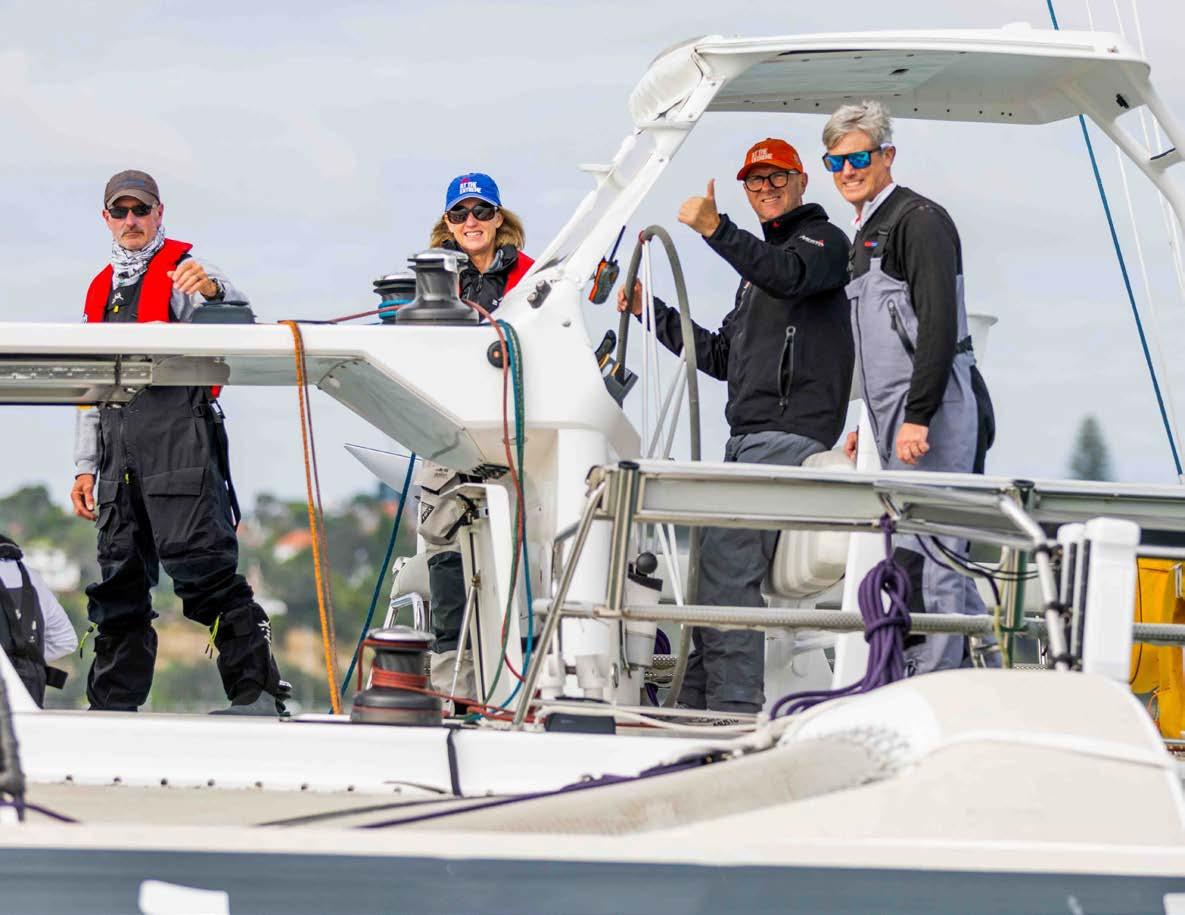
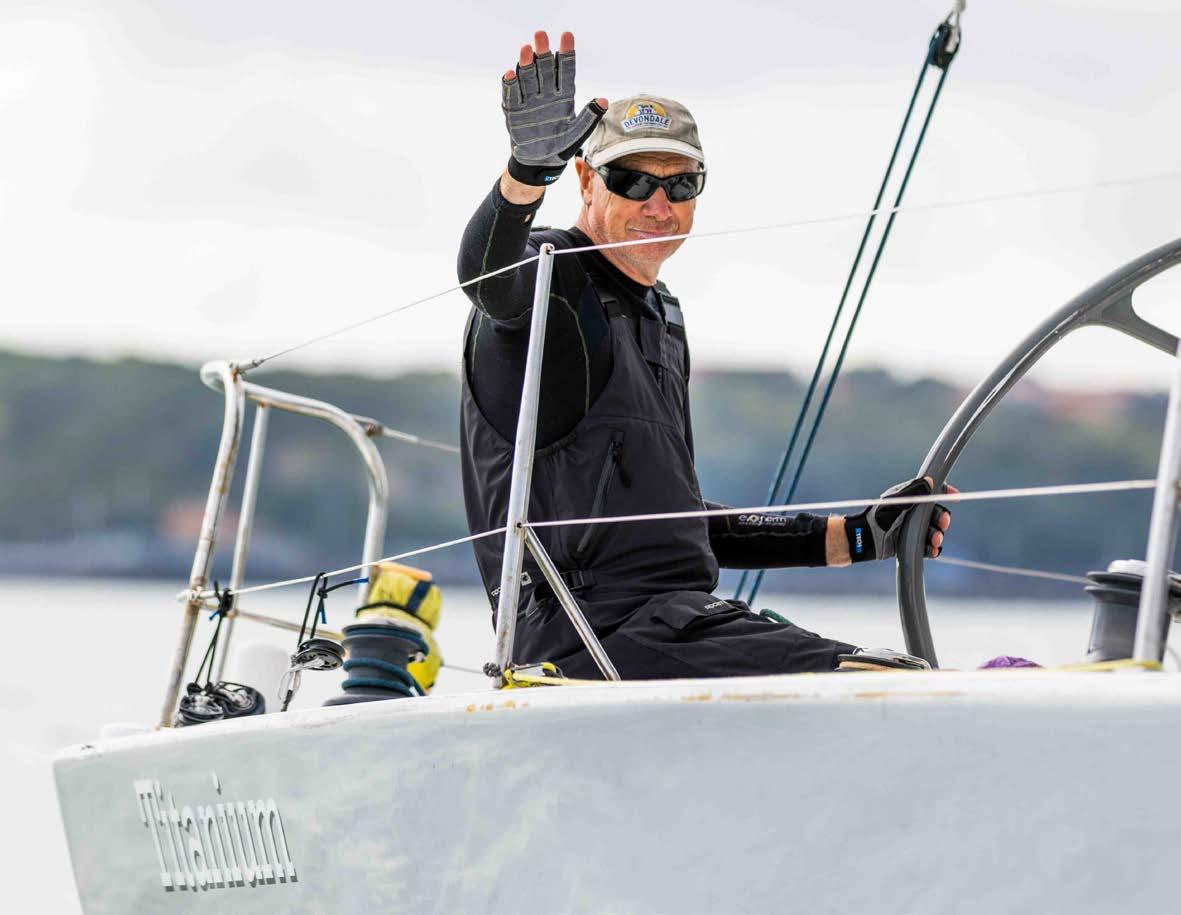
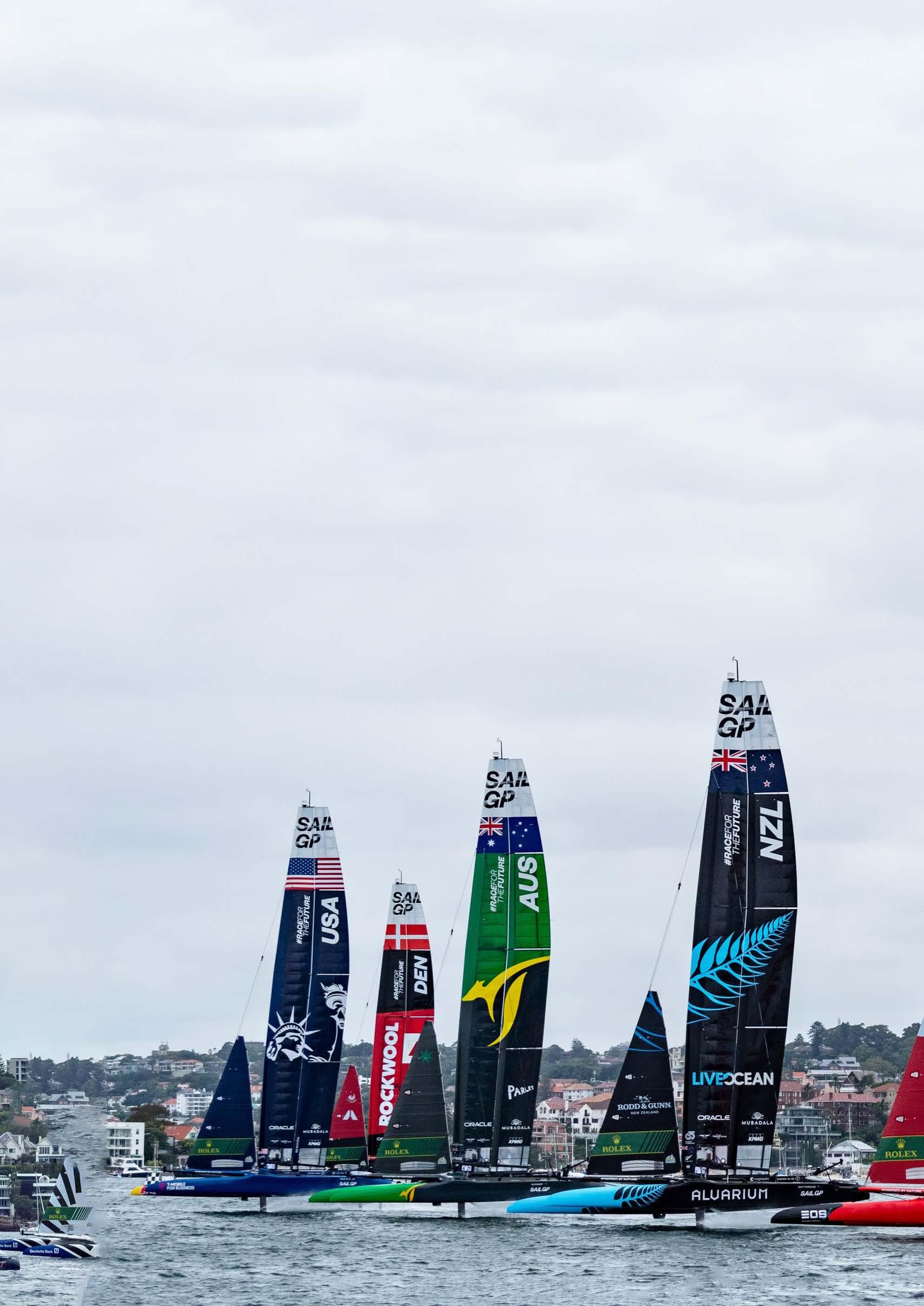
Sir Russell Coutts has learned a few valuable lessons from his time at the helm of SailGP’s runaway success. The most important is that, when it comes to growing its fan base, the sport has
Sailing has a fan problem, says Sir Russell Coutts.
They’re out there – that’s evident from the record number of eyeballs on the latest season of the Kiwi icon’s successful SailGP.
Rather, it’s that while other sports have embraced fans as essential to its success, sailing seems to still be reluctant to do the same.
topped again as early as the series opener in Dubai in a few weeks.
“I was at the Olympic Games in Marseille earlier this year and no spectators were allowed within 75 meters of the racecourse,” Coutts says. “Even the fan zone on shore was created almost as an afterthought instead of the whole thing being choreographed so that you’re engaging with the fans. It was as if the fans were an unwanted distraction.”
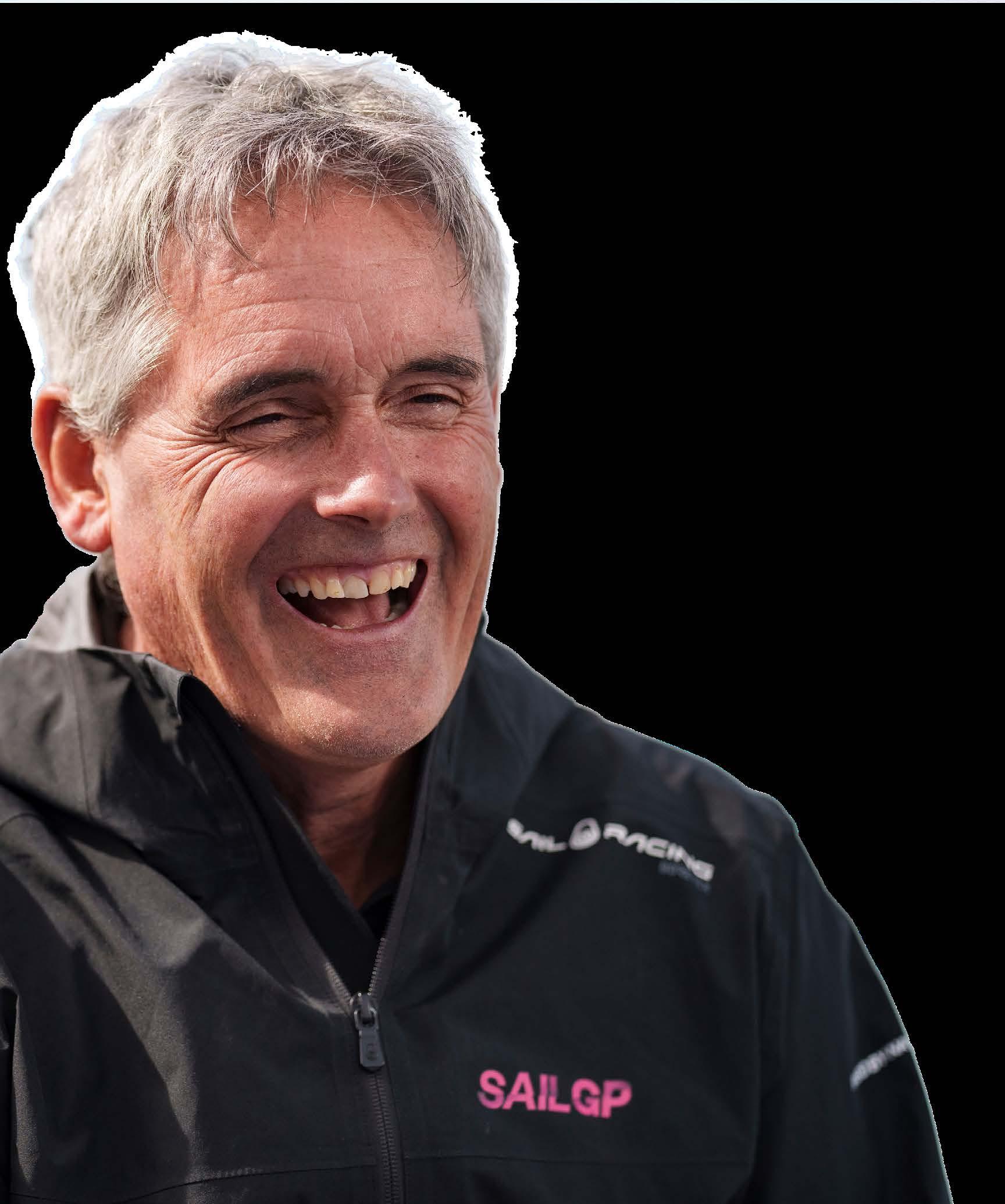
Olympic organisers aren’t the only ones missing a trick.
“Many of the other sailing properties and products seem to think that it’s a big show watching boats dock out and dock in,” he says. “Imagine if you’re watching motorsports and you only saw the car leaving the garage and
coming back into the garage. People would say, ‘Are you crazy?’”
Coutts pauses for a moment, then leans forward in his chair. It’s a wet spring afternoon, and the 62-year-old is about to leave for a well-earned break in the South Island.
He’s just announced Brazilian superstar Martine Grael as the league’s first female driver and Rio de Janeiro as the host for the country’s first SailGP event.
The double Olympic champion will be at the helm of the Mubadala Brazil SailGP Team, which will enter the league next season.
“It’s good that we’ve got the first female driver but the best thing about it is that she wasn’t selected because she was a female. She was the best choice in Brazil. Nobody else has won two Olympic golds and when we looked at the options, Martine was the clear winner,” Coutts says.
“It’s like hiring any role in your organisation. If they’re the best person for the job, it doesn’t matter whether they’re male or female. There’s no reason why that can’t be the case with the SailGP drivers or wing trimmers or flight controllers. As long as it engages the fans.”
Fan engagement has been central
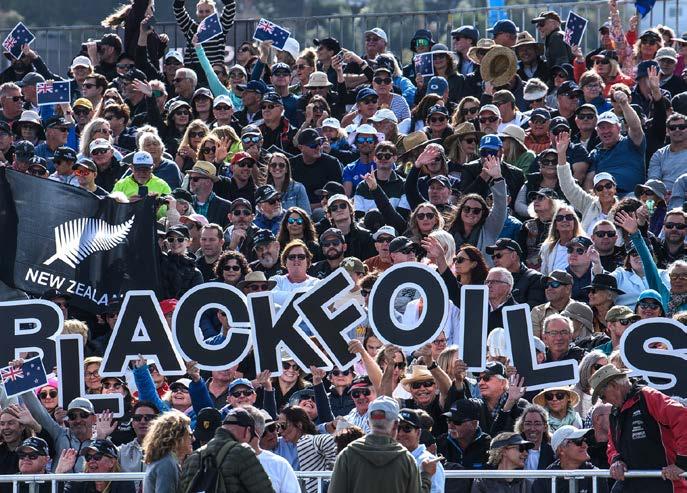
to the league since Coutts and Oracle founder Larry Ellison first launched the competition in 2019, to a healthy dose of scepticism.
Fast-forward five years and the recently completed season enjoyed live audience numbers of around 20 million dedicated television audiences for its events in New York and San Francisco.
“These are just the people watching the

actual race,” Coutts says.
“That’s by far the highest audience numbers I’ve ever seen in the sport, and they are not only avid sailing fans.”
They are racing fans.
“And that is how I would describe SailGP to people – it’s among the best in racing that just happens to be on water.”
One of the finest sailors New Zealand has produced, Coutts has never been far from the record books – or the headlines.
He won a gold medal in the Finn class at the 1984 Olympic Games, three world match racing championships, the America’s Cup five times and has been named World Sailing’s Sailor of the Year twice.
The America’s Cup hero turned villain when he joined Italian rivals Alinghi from Team New Zealand shortly after the successful 2000 Cup defence. It’s something many Kiwis still haven’t forgiven him for, Coutts acknowledges.
But over the last few years, SailGP has gone some way to endearing him to sporting fans at home.
The New Zealand debut event in Christchurch in March 2023 sold out in under 24 hours and this year it produced the (then) largest ticketed sailing event ever with 22,000 fans across the weekend.
Taking the series to Auckland in
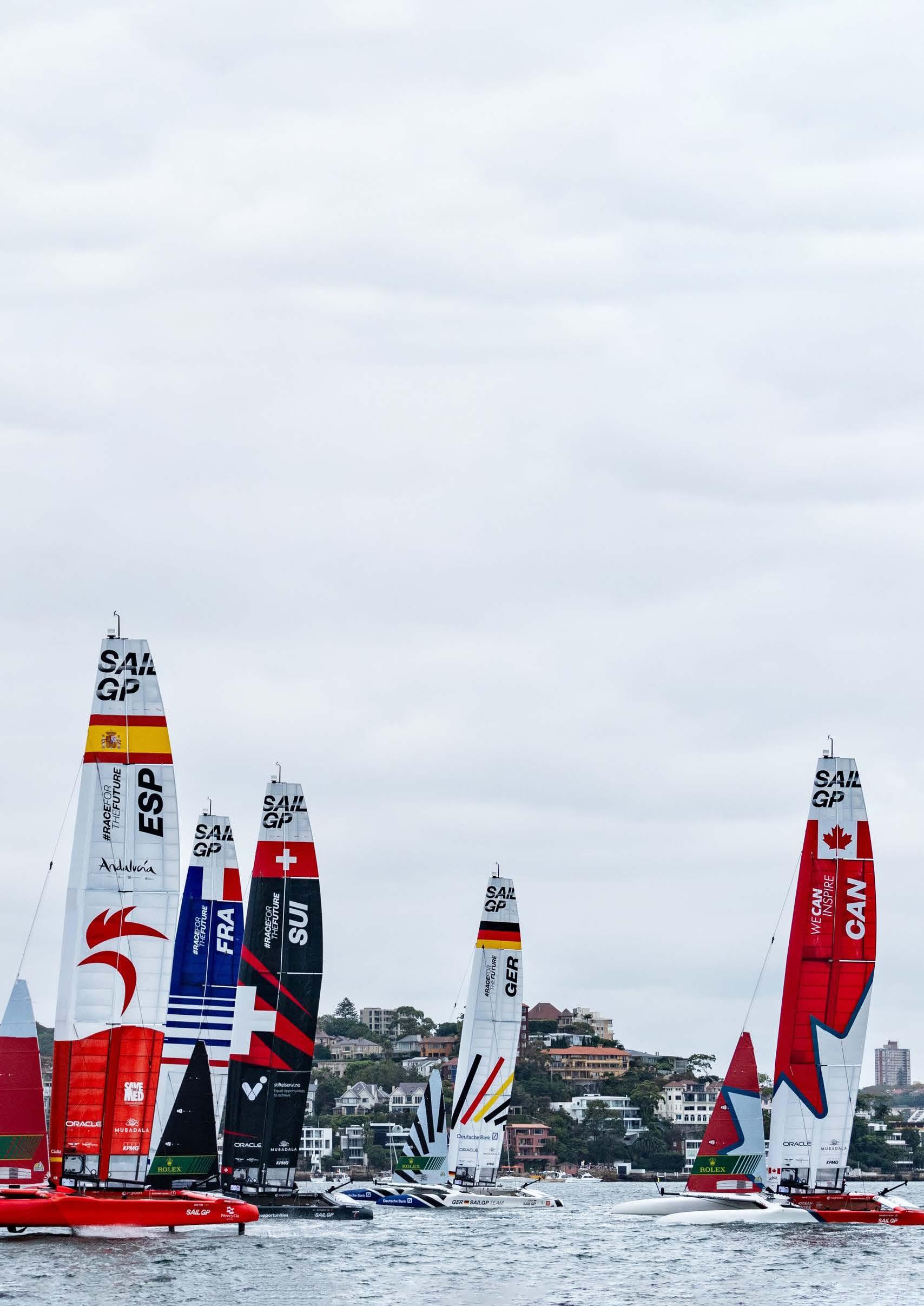
The recently completed season of SailGP had a record 20 million dedicated television audiences for its last two events.
Photos / SailGP
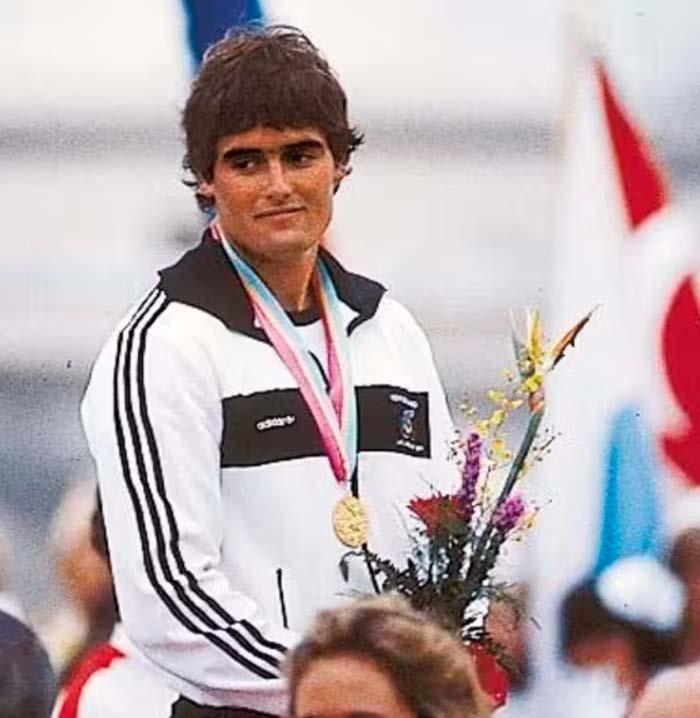
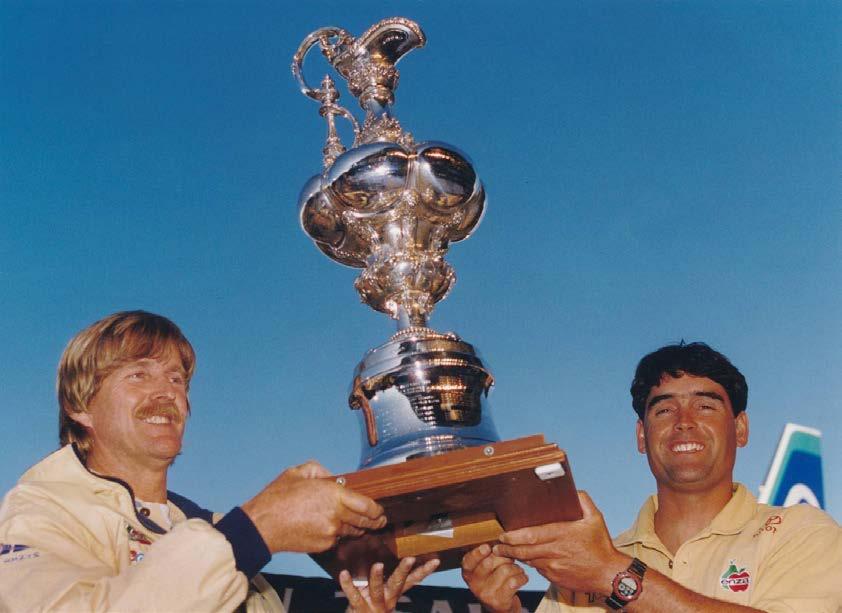
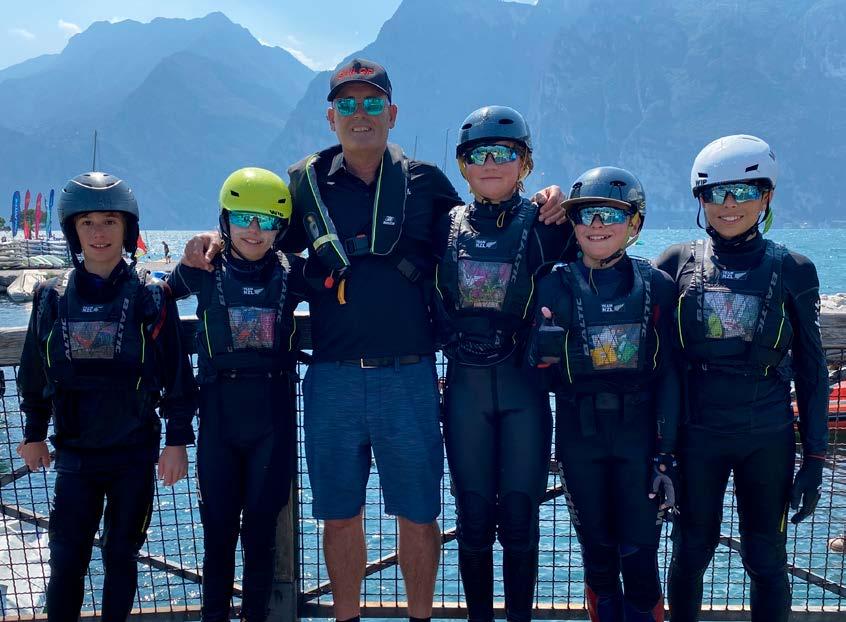
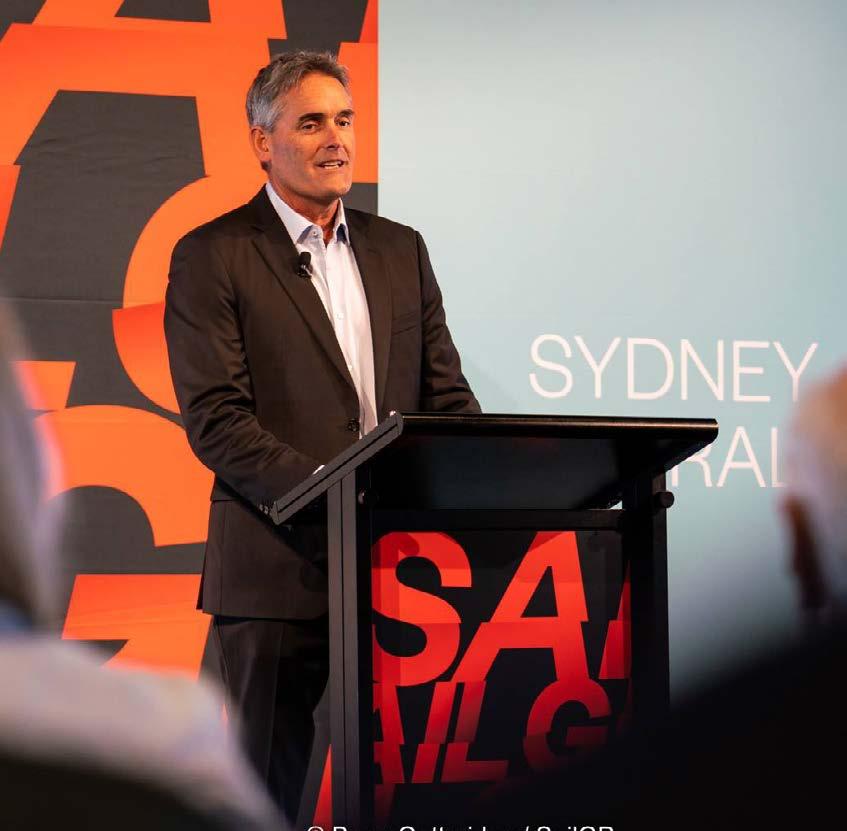
January 2025 was a logical next step – New Zealand’s biggest city is the second stop in the expansive calendar which spans five continets, including event debuts in Rio de Janeiro, Geneva, Sassnitz (Germany) and more. It will also see returns to favourite venues like New York, Los Angeles and Cadiz.
A second new team is expected to join Brazil for Season 5, taking the number of teams to 12.
Three teams have sold in recent months, with others planned to be announced ahead of the 2025 start.
It’s one of several firsts this season –including cutting-edge titanium foils that are set to be a “game-changer and will force teams to completely rewrite their racing playbooks”, according to Coutts.
The foils have been developed after extensive testing over the last 18 months and will bring faster speeds and even more competitive racing – crew members on board the Canada F50 set a new speed record of 101.98 km/h in winds of 32 km/h in July.
A second innovation is a light-wind foil programme, with details to be announced in due course, Coutts says.
“That’s the one I’m most excited about. Sure, the boats will go even faster with the high-speed foils but, honestly, I’m not even sure they need to go faster – the product is already spectacular in strong winds. It’s in the light stuff where we’re hoping to have a big impact, providing certainty of racing in all conditions.”
While innovations like these have become synonymous with SailGP, Coutts has been at pains to ensure the competition doesn’t become a “technology arms race” – the F50s are one-design with technical information openly shared between teams.
“Innovation is worth something, but it’s not what sailing should be about. Skill and ability should always determine the outcome, not a technological arms race that supersedes skill.
“That doesn’t mean it can’t be visually compelling. Quite the opposite. If the sport is produced and broadcast properly and the fan experience is the starting point, it can be visually compelling and showcase the sport to its fullest potential without compromising the competitiveness of the racing.
“In my opinion, sailing has had an
almost unwelcoming attitude toward fans – ‘keep those spectator boats away, keep them out of it. We don’t want them to see our race committee operations in any detail’.
“The reality is, the closer you are the better the content. It’s what people are interested in. The moment you try to fudge something... the fans see through that and that’s when they switch off.”
When he’s not signing contracts in London, or testing new developments in San Francisco, Coutts can be found in a coach boat off Big Manly Beach – getting back to the grassroots of the sport.
He set up the Russell Coutts Sailing Foundation in 2017, with its base at Manly Sailing Club.
Recently Coutts has been heavily involved with the O’pen Skiff class, coaching them in the build-up to and during the last two world championships in Italy where the Kiwi kids enjoyed a record number of entries and stellar results.
“I’m overseas most of the year but I organise my diary so I can dedicate at least one event per year to the young sailors, just so I can stay connected,” Coutts says.
“We set up the foundation and we fund it, but other people are doing a fabulous
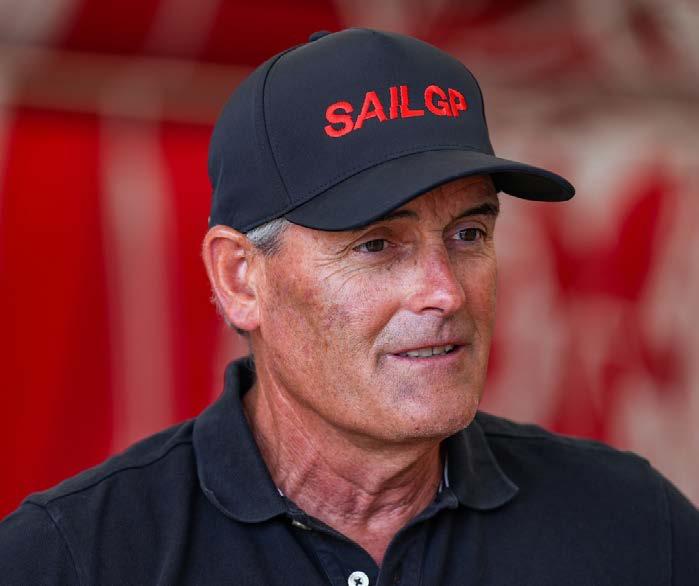
‘Kids develop differently. Some are late developers, and you might not see their true ability until they are 21 or 22. Yet, we are judging how someone is performing in an Optimist at 12 or 13.’
Sir Russell Coutts
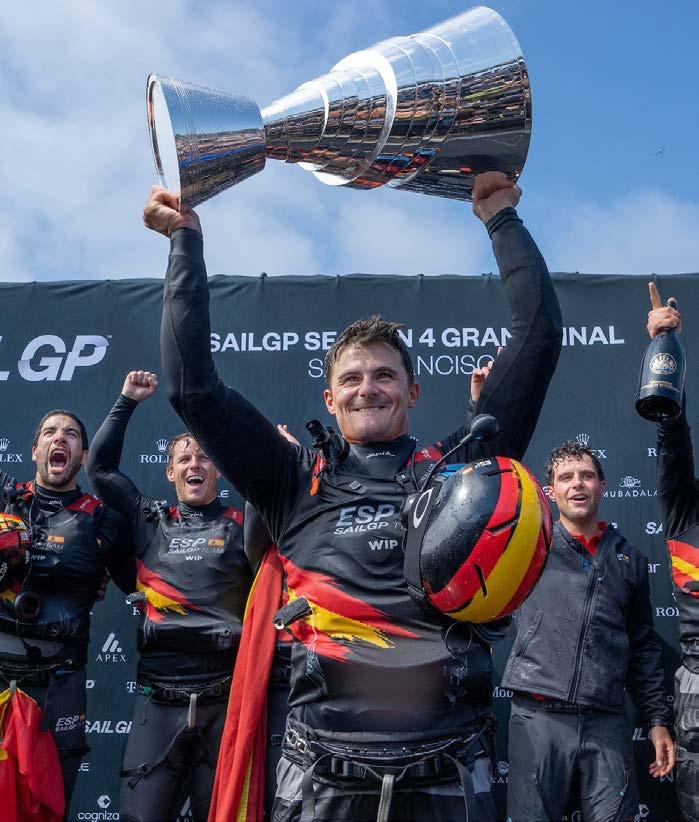
job running it. We’re quite proud of the fact that when we started it, the club had about 17 members; most of them social members. Now the club is thriving with roughly 200 kids a year going through its programmes and the club is about to host the Moth world champs.”
Finding solutions to dwindling fleets and declining membership numbers is another thing Coutts is increasingly passionate about.
“You have to recognise the barriers to participation and sailing is an expensive sport. Even at youth level, some of the boats cost $10,000 as a starting point and that’s a lot of money for most families. That’s what Manly Sailing Club has done well – they’ve identified those barriers, and they’ve had a shot at addressing them.”
Another obstacle is the notion that sailing programmes must follow a pathway of intense regattas from a very young age, Coutts says.
“Even if your club only wanted to train sailors for the Olympics or the elite side of the sport, the evidence supports the opposite of that view. There are so many people at the top of the sport today who weren’t prolific junior sailors. Many of them didn’t even start sailing before 13 or were competing seriously in other sports at that age.
“Kids develop differently. Some are late developers, and you might not see their true ability until they are 21 or 22. Yet, we are judging how someone is performing in an Optimist at 12 or 13...
“Perhaps the pathways should be a lot more about participation at a young age. Significant factors in the youth classes are
more about the size of the kid, their access to funding to buy new sails and new boats as opposed to whether the kid’s got some talent.”
There is no shortage of talented young sailors in the country, Coutts believes.
“The talent is there but some of our domestic fleets in the high-performance boats are struggling. In the past, we had very strong domestic fleets which resulted in very strong representation internationally. For example, 20 or 30 years ago we had 10 world-class 470 teams and any one of them could win races internationally,” he says.
“As the fleets have diminished, I think our level has dropped off. It’s just a straight numbers game.”
The explosion in popularity of foiling classes like the iQFOiL and wingfoiling could provide a lifeline to clubs who are struggling for numbers.
“It’s a relatively cheap way to get kids into the sport, it’s fun, it’s engaging, and you don’t need storage or trailers to get started,” Coutts says.
“If you’re a yacht club and you don’t have a wingfoiling programme, you’re not thinking about the future.”
That’s what Coutts will be over the coming weeks – looking for even more ways of improving SailGP as a spectator product.
“We can still do a lot better. I don’t think the sport is truly professional yet, at any level. Even the top SailGP teams don’t have a pathway and a squad of replacement athletes.
“Take a team like Manchester City or Manchester United in the English Premier League, or the NBA with the Golden State Warriors – if one of their top athletes goes down, they can still compete. If Pete Burling or Tom Slingsby got sick and couldn’t race, the New Zealand and Australia SailGP teams would be heavily compromised.
“We don’t yet have that true pathway to train new athletes and have that system in place.”
That’s likely to change over the coming years, Coutts adds.
“At least 10 out of the 12 teams in SailGP next year will be third-party owned with professional ownership. We’ve just had an athlete traded with a team for a transfer fee for the first time. So, eventually, you’ll have
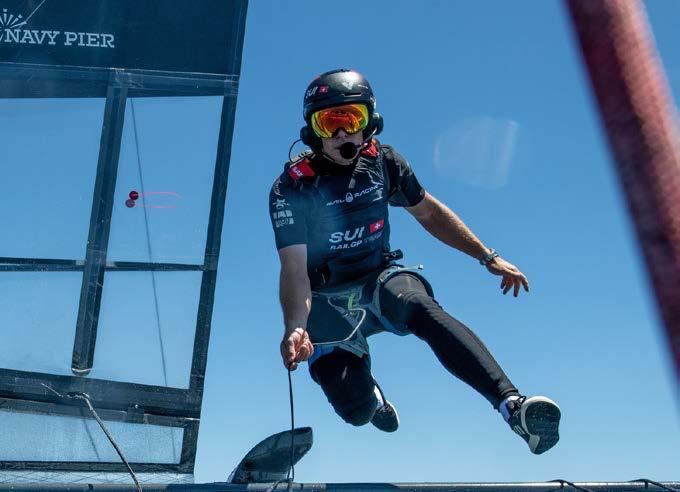

November 23-24: Dubai
January 18-19: Auckland
February 8-9: Sydney
March 15-16: Los Angeles
March 22-23: San Francisco
May 3-4: Rio de Janeiro
June 7-8: New York
July 19-20: Great Britain
August 16-17: Sassnitz
September 6-7: Taranto
September 20-21: Geneva
October 4-5: Cadiz
November 7-8: Middle East
November 29-30: Abu Dhabi
a squad of sailors rotating as we increase the number of events – just like they do in other major sports.
“Who knows, maybe we’ll even introduce transfer windows or a draft system.”
Before then, Coutts will enjoy a short break in Wānaka, followed by more announcements and ramping up of the preparation for the season-opener in the UAE.
“We’re fully into the production of the new foils and all the other equipment that’s changing on the boat, some driver and team ownership changes and a raft of other things before we get to Dubai.”
Where all eyes will again be on SailGP and what they come up with next.
And that’s exactly what Sir Russell Coutts wants.
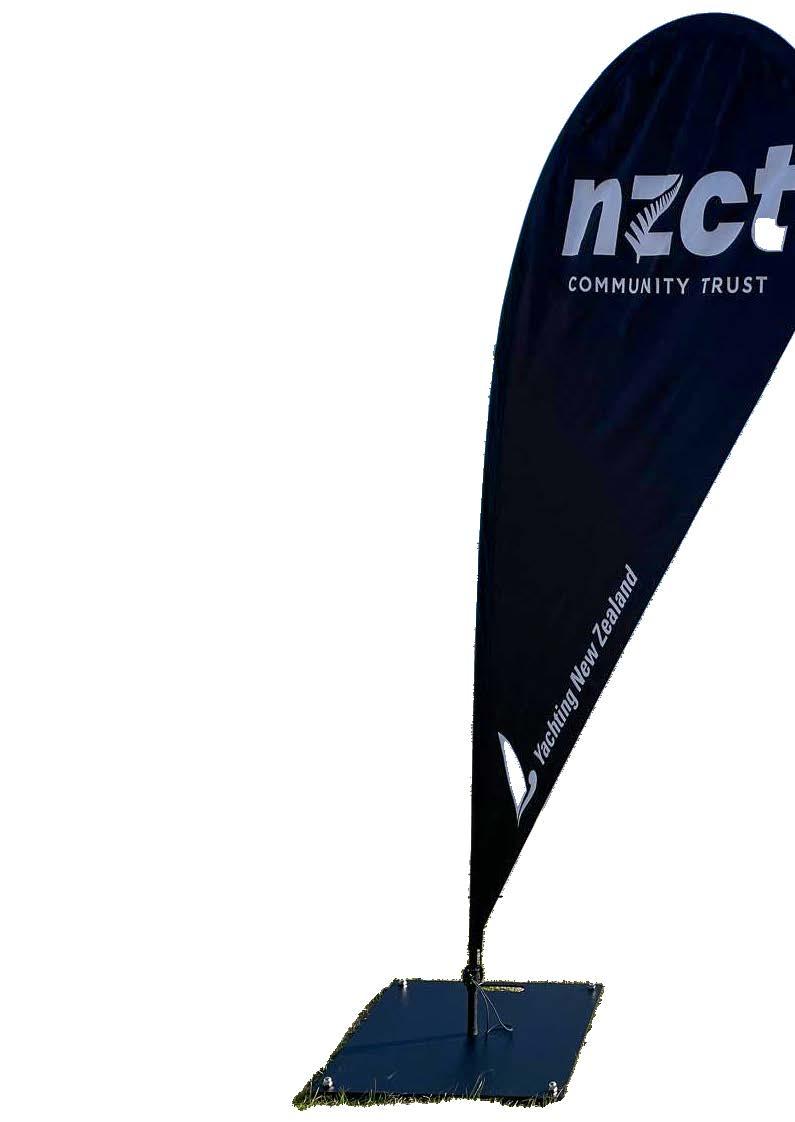
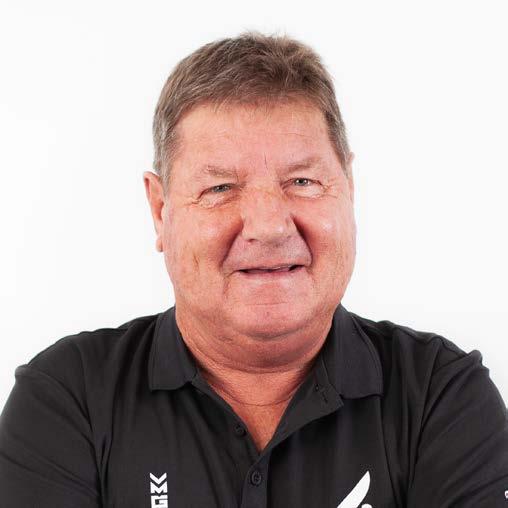
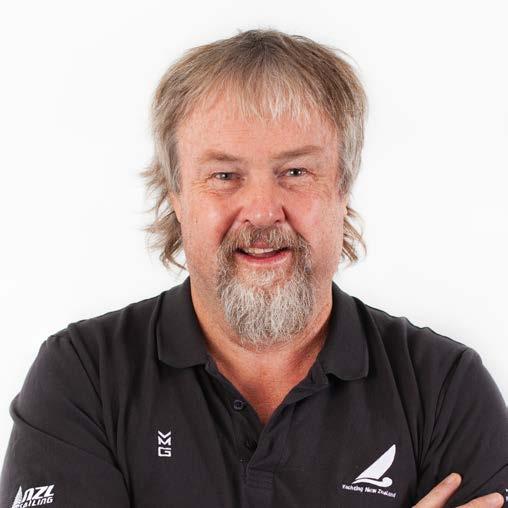
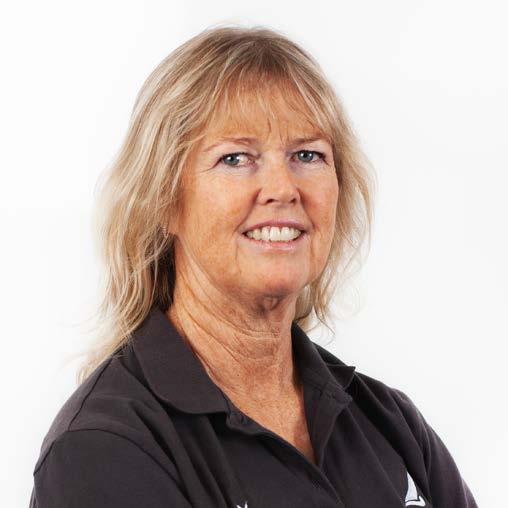

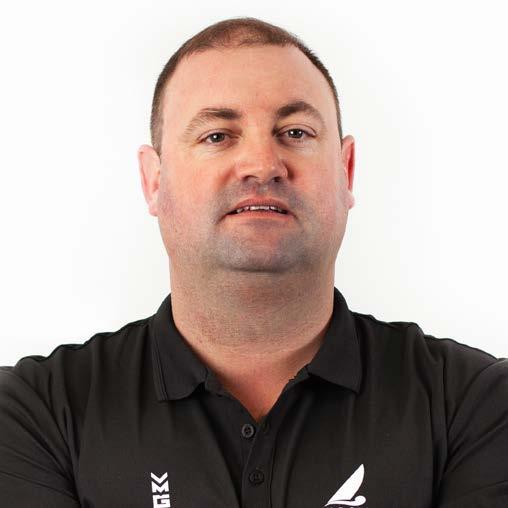
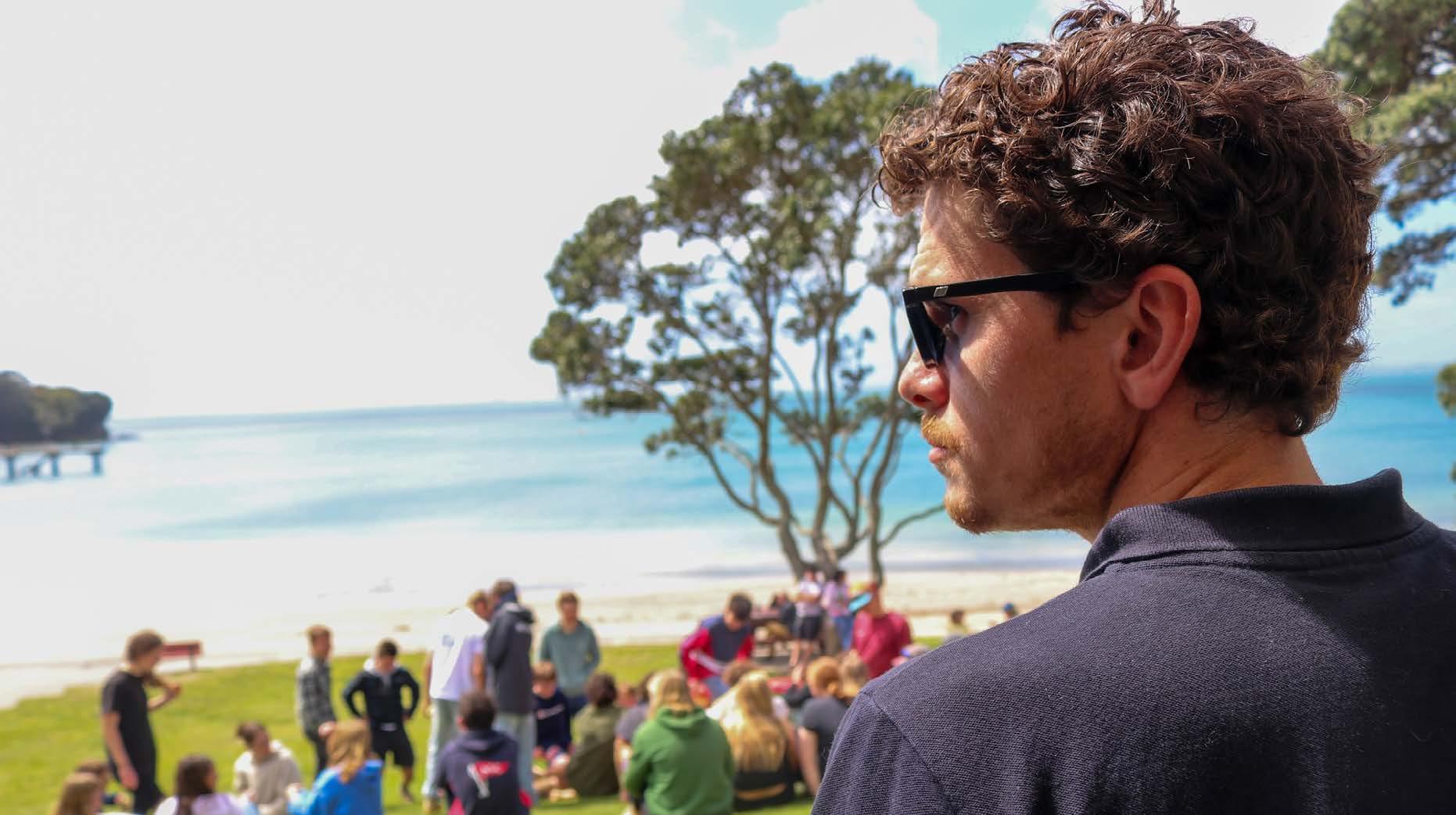
Careful planning, early collaboration and clear communication are key to hosting a major international regatta.
The 2024 Moth world championships at Manly Sailing Club will be the first class world championships hosted in New Zealand in some time. Several other clubs and class associations are also exploring the opportunity to host big international events in the coming seasons, and we check in with Yachting New Zealand’s youth and events manager Sam Mackay, who has been organising the annual Oceanbridge Sail Auckland Regatta and the New Zealand youth championships since 2019, about what it takes to pull off a big event.
What are the benefits of hosting a big event for a club or class association?
It has a massive impact for a class domestically. Having a world championships potentially opens up opportunities to people who have never had the chance to race against top-level international competition. Often the
training opportunities surrounding a worlds provide a big boost as well. It can significantly help the class grow when people know a big event is going to be held in New Zealand that they could compete in.
How closely do the class association and club need to work together to be successful?
Collaboration between these two is essential. The class association typically leads the bidding process, but the event can’t happen without the club’s support and resources. A successful partnership requires clear communication about responsibilities and goals.
What is the process from start to finish?
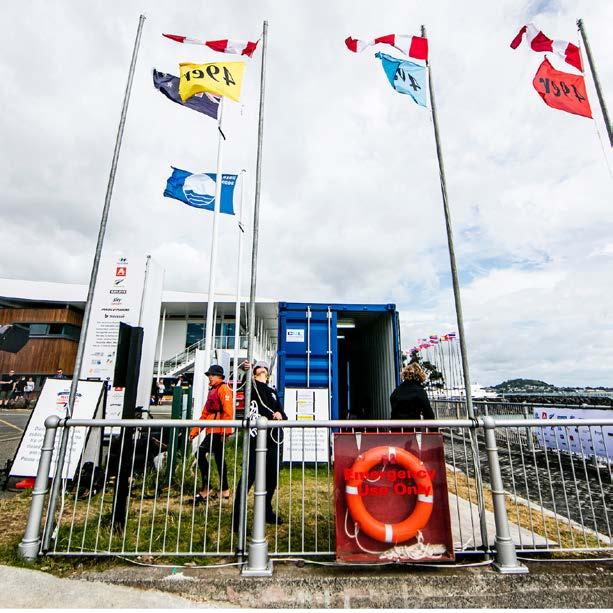
It starts with a preliminary discussion between the class association and potential host clubs. If they decide to proceed, they prepare a bid that includes logistics, budget estimates, and a preliminary schedule. Once the bid is accepted, the planning phase begins.
This involves coordination with local authorities, securing funding and sponsorships, and organising event logistics and volunteer recruitment. The final stage includes event execution, followed by a thorough debrief and financial wrap-up.
Why have we not seen as many international regattas hosted in NZ recently?
Covid-19 definitely played a big part. As we were locked up for so long, the first focus was getting back out to the world and participating again and checking in with international fleets. While clubs and class associations are now facing different pressures – including economic – I believe now that things have settled down, we can again try to attract some big events.
What are some of the biggest challenges and potential pitfalls to hosting one of these regattas successfully?
Funding is often the largest hurdle, as many costs need to be covered up front. Additionally, logistical challenges like securing quality race officials, accommodation, managing volunteers, and ensuring appropriate facilities can be challenging. Ensuring effective communication and alignment with all parties – club, class association, sponsors etc – is critical to avoid misunderstandings or mismanagement during the event.
What are the costs involved in bringing a big event to NZ?

Costs typically include venue fees, council permits, race management equipment, race management and safety boats, fuel,
travel and accommodation for officials, volunteer expenses, marketing, and insurance. There may also be costs for infrastructure improvements at the club for the event.
How important is sponsors and what can clubs do to attract them?
Sponsors are vital for the financial viability of a large event, as they often cover a significant portion of costs. To attract sponsors, clubs can highlight the visibility of the event, particularly to an international audience, and the media opportunities it presents. I would recommend clubs create custom sponsorship packages that align with sponsors’ branding and business objectives.
How many people does it take to run an event of this scale?
Typically, a core team of five to 10 experienced organisers working as a committee is required, under the leadership of an event manager. Then there is additional support from many volunteers, including race officials, for specific roles during the event.
How important is it to work with Yachting New Zealand during this process?
It is crucial to hosting a successful event, as we can not only provide guidance on event regulations, potential funding, and logistical support – but our endorsement can also add credibility to the event bid, which helps with potential funding and attracting sponsors. Yachting New Zealand can also assist with promotion and offer access to their network of officials, judges, and volunteers.
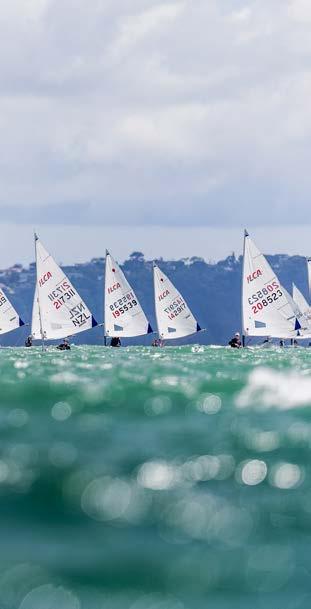
What advice would you share with any class association or club considering hosting a major regatta?
Start planning as early as possible and communicate clearly with all stakeholders. Secure funding before committing and have contingency plans for unforeseen issues. Be aligned with Yachting New Zealand from the start of this process and build a strong volunteer base, as this can make a huge difference in handling the logistical demands.
Yachting New Zealand is committed to attracting more international regattas to our shores in the coming years, says chief executive David Abercrombie.
“It has been five years since we last hosted an Olympic-class world championships – the 2019 49er, 49erFX and Nacra 17 world championships – and that is something we are determined to change,” Abercrombie said.
“Recent events like SailGP in Christchurch and the America’s Cup have shown how our nation can rally around elite sailing. With the disruption of Covid-19 now in our wake, I believe the time is ripe to again show the world what we can do in our
preparing for the next Olympic cycle, focusing on building excitement for the 2028 Los Angeles and 2032 Brisbane Olympics and bringing more worldclass sailors to our shores more often will help us achieve this.”
Abercrombie did, however, caution that running a successful event requires far more than ambition alone.
“Hosting Olympic or youth-class world championships can boost club revenues but it requires extremely careful planning and collaboration with Yachting New Zealand,” he said.
“We have the experience, expertise, and resources to work with clubs to ensure these events are planned and delivered successfully.”
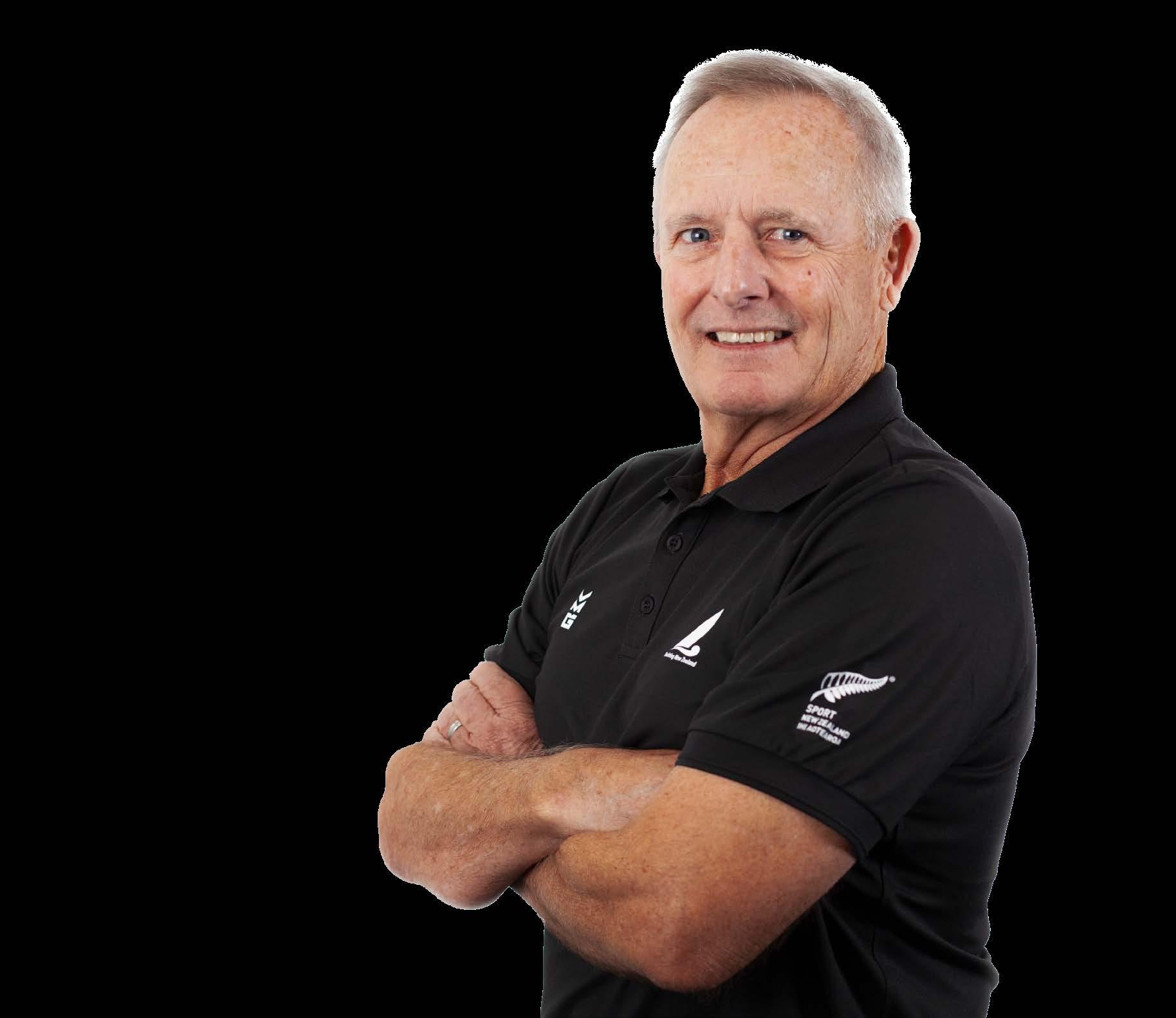
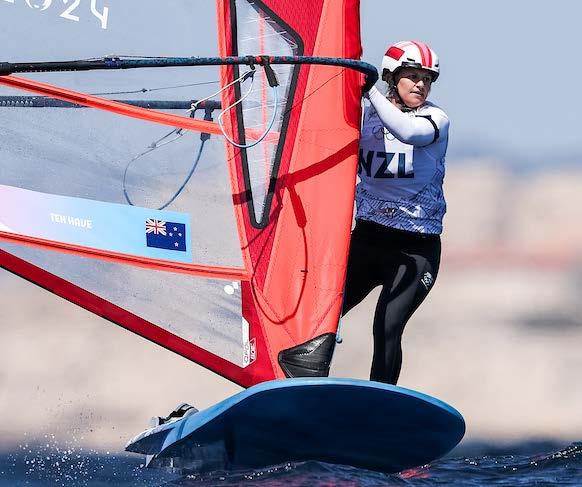
They are the cream of the crop from our sailing clubs from Bluff to Taipa – from club stalwarts and race committee members through to rising stars and international sailors.
And they are all among the early winners named in this year’s Barfoot & Thompson Yachting Excellence Awards.
As in previous years, winners in four categories have been unveiled early with the major awards to be handed out at a gala event at the Royal New Zealand Yacht Squadron on November 22.
The awards evening is a highlight on the annual sailing calendar and recognises achievements at all levels of the sport during the nomination period (September 1, 2023 - August 31, 2024).
As always, several awards will be handed out – including the prestigious Sir Bernard Fergusson Trophy for the Orbit World Travel Sailor of the Year, won last year by sailing world championship bronze medallist George Gautrey.
Previous winners of the award include Sir Peter Blake, Barbara Kendall, Peter Burling and Blair Tuke, Sir Russell Coutts, Jo Aleh and Polly Powrie, Bruce Farr, and Emirates Team New Zealand.
“This year’s event will be extra special, with the success of our NZL Sailing team sailors at the Olympic Games earlier this year, as well as Emirates Team New Zealand’s brilliant America’s Cup threepeat,” said Yachting New Zealand chief executive David Abercrombie.
“It’s been an exceptional year for many of our sailors on the world stage, but the Excellence Awards are about more than just high-performance sailing. It is also an opportunity to honour the often-unsung heroes of our community, those people making a difference every day at their clubs and class associations, through our service awards. We are looking forward to celebrating our many successes both on and off the water.”
The first winners in the 2024 Barfoot & Thompson Yachting Excellence Awards have been announced –celebrating our top performers on and off the water.

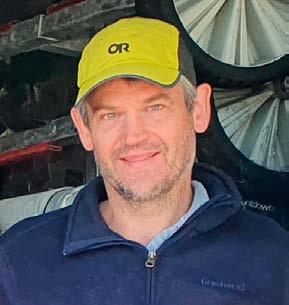
Hayden Bell
MacAndrew Bay
Boating Club
The rear commodore and duty manager of Macandrew Bay Boating Club, Bell is the driving force behind a significant increase in memberships and sailors through his efforts to improve efficiencies at the club. This includes establishing online membership registration. He has also identified 63 schools in the Dunedin area that could benefit from Yachting New Zealand’s RŪNĀ programme and has successfully worked with several of them to implement it this year.
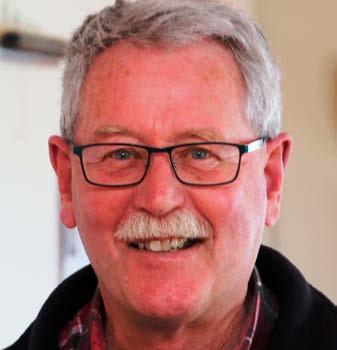
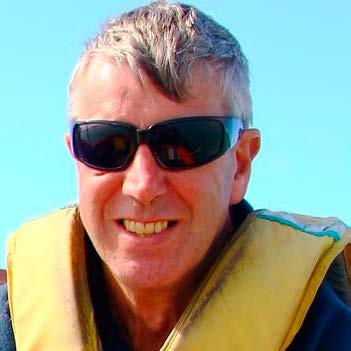
Warren Collingwood and Murray McDonald
Waimakariri Sailing Club
Few roles are more important than that of safety boat operator, and at Waimakariri Sailing Club, Collingwood and McDonald are two of the best. For the last 23 years, McDonald has been the first to arrive, check the fuel, launch, and run the engines. He also regularly serves as a race officer for club championships and other major regattas. Collingwood has held many important positions over the last 27 years, including club captain, secretary, and groundsman.
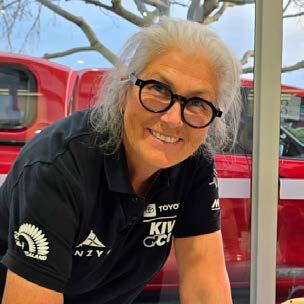
Delwyn Erceg
Royal New Zealand Yacht Squadron
Erceg is the Swiss Army Knife of the RNZYS – a race officer for the club’s winter and Wednesday night series, as well as a coach and mentor to the wider race management team under the guidance of Megan Kensington. She is also the lead volunteer looking after the patrol boat and a core member of the team for events such as Squadron Weekend, the secondary school championships, and the Toyota Kiwi Cup Tour, which stopped at over 40 locations across New Zealand.
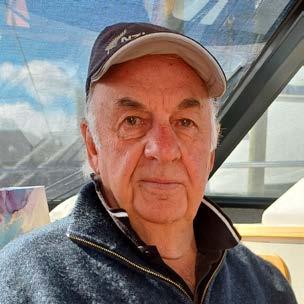
Peter Ganley
Thames Sailing Club
Ganley started sailing at the club at the age of nine and remains a member some 60 years later. He joined the committee at 19 and has held many executive positions, including youth training officer, handicapper, Waikato Thames representative, commodore, and president. He has managed the Thames Sailing Club Marina for the last 15 years and has been a life member since 2002. He is also an experienced yachtsman, having sailed a P Class, Cherub, Frostply, Farr 3.7, and several keelboats, including offshore.
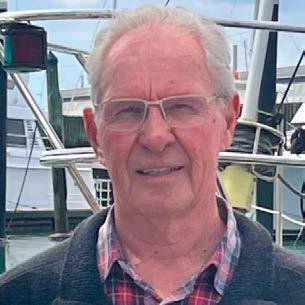
Ross Hebner
Bucklands Beach Yacht Club
In 2022, Hebner became one of only 23 people to receive life membership in the club’s 75-year history, and for good reason. He has been involved with the club since 1981 and started volunteering during the 2003 Louis Vuitton Cup series. Hebner has been a valued member of the
race management team ever since and still performs race officer duties for Friday rum races, the Winter Series, and mid-week races, and runs the Reactor races at the annual Auckland Anniversary Regatta.
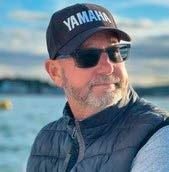
Mike Leyland
Young 88 Owners Association
Leyland is the face of Young 88 sailing in New Zealand and has spent the last five years as class president, growing the fleet. His efforts have seen the fleet in the South Island now rival Auckland’s, while core events like the national and regional championships have had record entry numbers. Leyland also established an online shop that stocks Young 88 parts that are not available off the shelf and has increased the class’s social media reach.
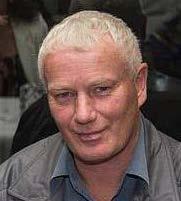
Mervyn Read
Vauxhall Yacht Club
If there’s a dinghy regatta in Otago, chances are Read is involved. Over the last four decades, ‘Merv’ has held various positions on the club committee, including commodore, and he has organised countless major events and club races. Over
in the club’s rebuild after the Christchurch earthquakes, as well as the development of the Wāhine on the Water Regatta.
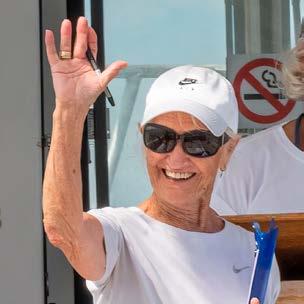
Joyce Talbot
Auckland Anniversary Regatta
She is one of the most sought-after sailing administrators in the country and has been heavily involved in several high-profile regattas, including 12 Coastal Classics (her last in 2002). Talbot helped run her first Auckland Anniversary Regatta in 2006 and has played key roles with the Classic Yacht Association and the NZ Sailing Foundation. Her tireless work in the sport was recognised in this year’s New Year Honours List when she became a Member of the New Zealand Order of Merit (MNZM).
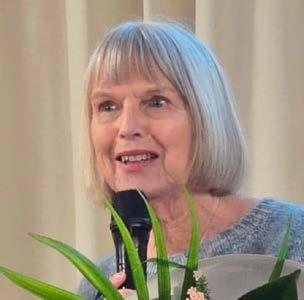
Gill Waite
Gulf Harbour
Yacht Club

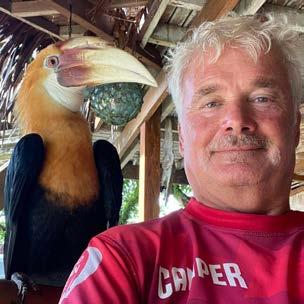
Don Salthouse
Opua Cruising Club
Salthouse was brought up in a wellknown boatbuilding and designing family and has been sailing offshore since his 20s. Known for venturing well off the beaten track, he has spent plenty of time in the South Pacific and, more recently, in Indonesia. He has assisted many local villages affected by adverse weather events – rebuilding damaged buildings and delivering gear to remote places. He enjoys fixing boats and motors and carries all his boatbuilding gear on board to help the locals get back out fishing and trading again.
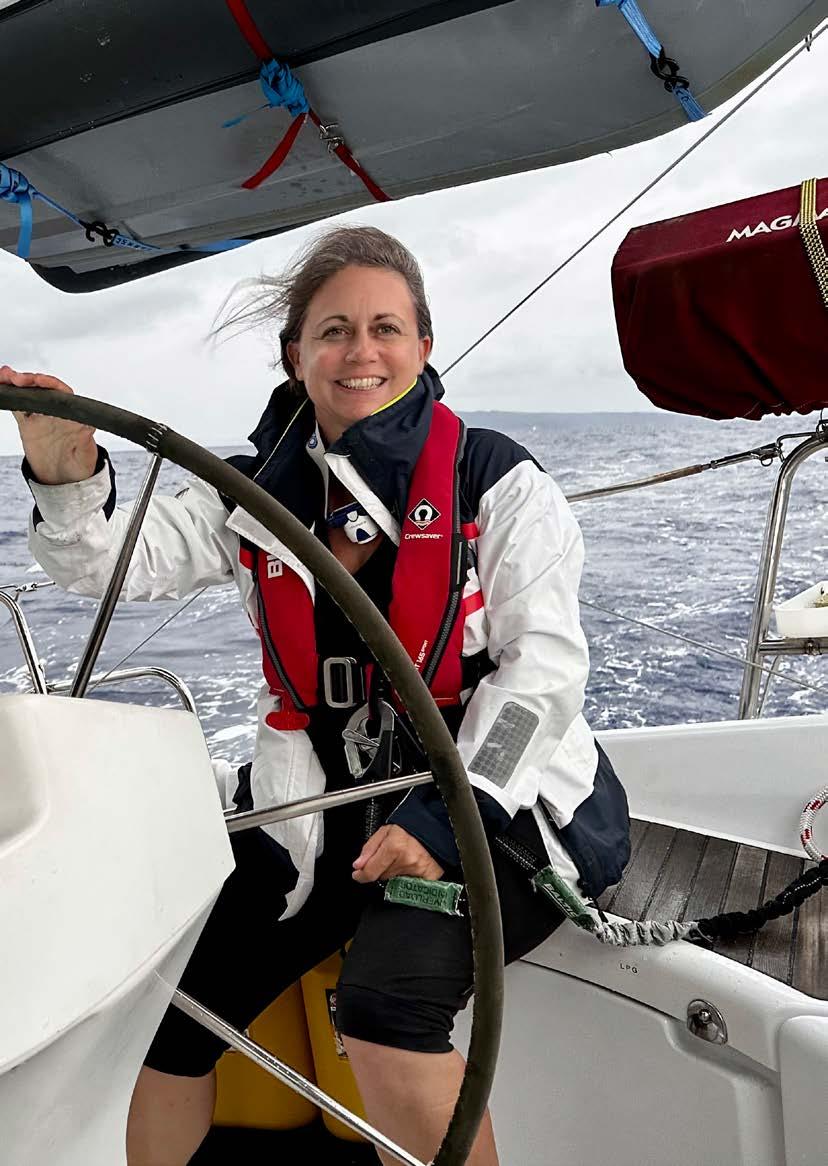
‘Auntie Gill’, as Waite is affectionately known by many, has become synonymous with Gulf Harbour Yacht Club since her first involvement in the late 1990s. She will retire this year after more than 20 years as club treasurer and general office administrator. Never one for the limelight, Waite has worked tirelessly in the background and has been a supportive, reliable, and generous part of the club.
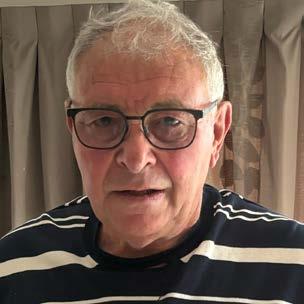
Gordon Wallis
Ngaroto Sailing Club

from Optimists and Firebugs to Zephyrs and Young 88s. Rutherford was also instrumental
When algal blooms threatened Ngaroto Sailing Club’s ability to sail dinghies on its peat lakes this season, the club decided to purchase three Elliott 5.9s. The only problem was the boats were located in Dunedin, 1200km away. Enter 73-year-old Wallis, who in just a few days managed to transport the vessels (with trailers) from one end of the country to the other using only his Toyota Land Cruiser and a trailer borrowed from a friend in exchange for two boxes of beer.

Caleb Armit Murrays Bay Sailing Club
Armit secured his first international success in the ILCA 7 (Laser) by claiming bronze against 114 competitors from 31 nations at the ILCA under-21 world championship in Morocco last October. Armit was 16th after the first day but earned six top-10 finishes in 11 races, including two thirds, to clinch his medal. He also won this year’s Oceanbridge Sail Auckland and received his club’s award for exceptional contribution as a sailor.
Continued on p68
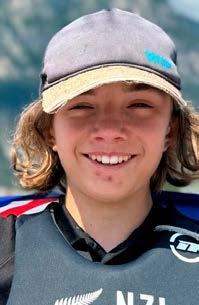
Ewan Brazle
Manly Sailing Club
Brazle continued to dominate the O’pen Skiff class both in New Zealand and internationally, winning his second consecutive under-15 world championship title at Lake Garda, Italy, where he triumphed in 10 of 11 races against 187 sailors. He also claimed his third straight national title, in addition to winning the Sir Peter Blake Regatta, Northland O’pen Cup, Wellington O’pen Cup, and O’pen Skiff North Island champs.
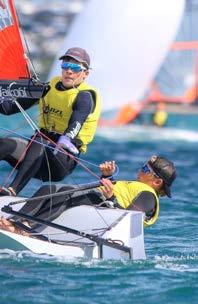
Will Leech and Sean Kensington
Charteris Bay Yacht Club and Kohimarama Yacht Club
Leech and Kensington teamed up in the 29er last season and immediately found success. They finished third at their first national championship together and matched that result at the 2024 Oceanbridge Sail Auckland. The duo also won Junior Sail Auckland, the Auckland championships, and the youth trials, securing a place at the 2024 youth sailing world championships, where they finished 10th after leading early in the regatta.
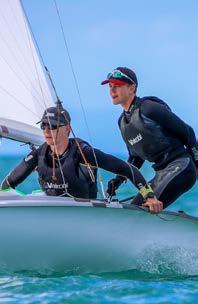
Joe Leith and Josh Ferrissey
Murrays Bay Sailing Club
This 420 crew reached a major milestone in January, winning bronze at the world championships in Rio de Janeiro, their first world medal in a fleet of nearly 80 boats. Leith and Ferrissey were also the highestplaced Kiwis at the youth sailing world champs in Buzios last December, finishing fifth. They’ve also won consecutive class national and Sir Peter Blake Regatta titles.
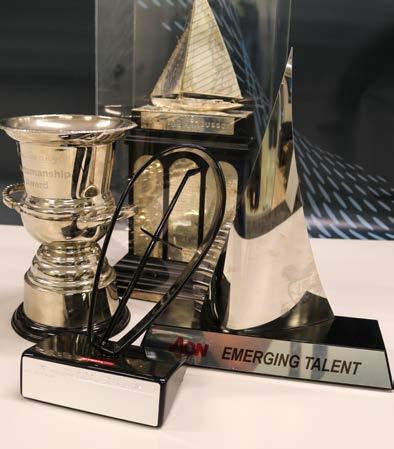
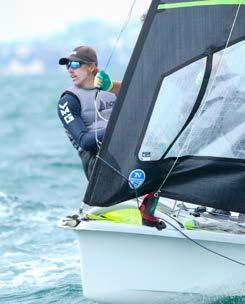
Seb Menzies and George Lee Rush
Murrays Bay Sailing Club and Wakatere Boating Club
Menzies and Rush have made significant strides in the men’s skiff over the past 12 months. They narrowly missed a medal at the 2024 49er junior world championships in Galicia, Spain, after leading early in the event. In May, they achieved a top-20 finish at the Princess Sofia Regatta in Palma, racing against many of the Paris 2024 Olympic contenders.
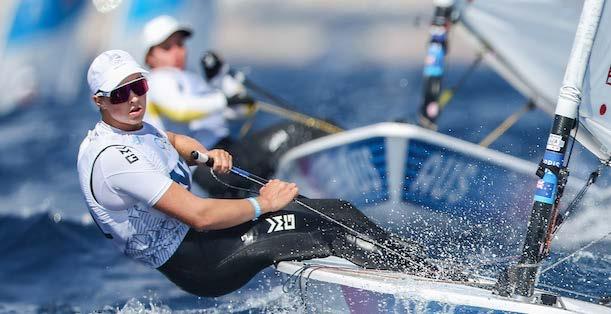
Greta Pilkington
Royal New Zealand Yacht Squadron Pilkington secured two top-10 finishes (at Sail Melbourne and Sail Sydney) during her first full season of international competition in the ILCA 6 (Laser Radial). She qualified for the gold fleet at the French Olympic Week regatta in Hyeres and won consecutive Oceanbridge Sail Auckland titles in 2023 and 2024. She earned Olympic selection, becoming the first Kiwi in the ILCA 6 class to qualify since 2012, while also completing her architecture degree at Auckland University.
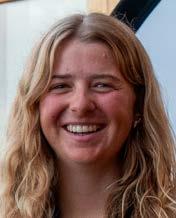
Helena Sanderson Wakatere Boating Club
Sanderson delivered a strong performance at the 2023 Waszp World Games, finishing second female and first under-17 female in a fleet of over 90 sailors. She was also recently appointed as a coach at Wakatere Boating Club, where she has impressed with her commitment, organisation, and broad skill set.
Winners of the following awards will be announced on November 22: Orbit World Travel Sailor of the Year Barfoot & Thompson
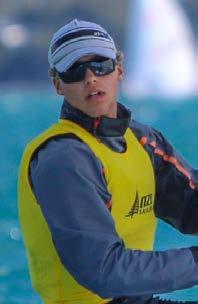
Zach Stibbe
Otago Yacht Club
Stibbe stood out at the 2024 youth sailing world championships at Lake Garda, Italy, finishing fifth in the boys’ ILCA 6 after contending for a podium place until the final race. This followed his silver medal in the open fleet at Kiel Week and fourth overall at the Europa Cup Germany in Warnemünde.
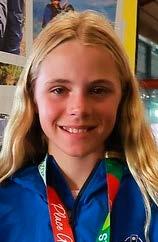
Zofia Wells
Glendowie Boating Club
Already one of New Zealand’s top Optimist sailors, Wells excelled on the international stage this year. She finished second girl and eighth overall at the Australian national championships in January and won the girls’ title at the New Zealand event in March. At the European Championships in Carrara, Italy, Wells placed an impressive seventh after leading early in the regatta and finishing third in a gold-fleet race.
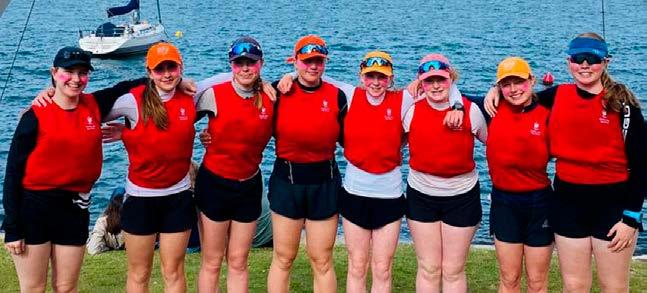
Girls High School sailing team
The team, comprising Daniella Wooldridge, Emma Reid, Jessica Handley, Gretel Satterthwaite, Danielle Robertson, Bella Jenkins, Emily Turner, Zara Latimer, Charlotte Handley and Julia Nguyen, cemented their status as New Zealand’s top girls’ school sailing team. In October 2023, they became only the third Kiwi women’s team to win the prestigious Interdominion Championship abroad. They also won back-to-back titles at the NZ secondary schools team sailing and keelboat national championships, as well as the Auckland Cup regional team sailing crown for the third consecutive year.
B&G Performance Coach of the Year
Yachting New Zealand Emerging Coach of the Year
Hotels & Resorts NZ Official of the Year
Aon New Zealand Emerging Talent Award Lawson’s Dry Hills Outstanding Contribution Award MAST Academy Young Leadership Award North Sails Sportsmanship Award Evocean Sustainability Award

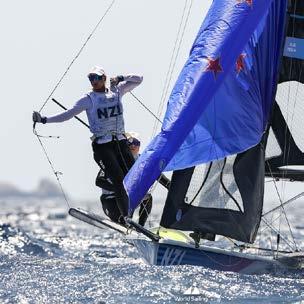
Jo Aleh and Molly Meech
Torbay Sailing Club and Royal Akarana Yacht Club
Aleh and Meech
made good progress in their third season as a 49er FX team, following up their first medal race together at the sailing world championships in The Hague in late 2023 with their first international podium place this year. They were third overall at the French Olympic Week in April and fought back well after a slow start in light conditions at the Olympic Games in Marseille, eventually ending their campaign with a seventh place.
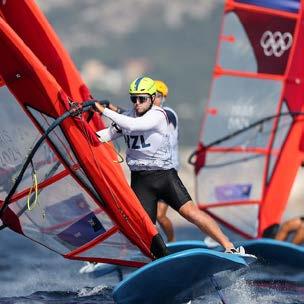
Josh Armit Wakatere Boating Club
Armit underlined why he is regarded as one of the most talented sailors in the country with an exceptional year. Still only 22, he claimed top-10 results at the Princess Sofia and the French Olympic Week regattas in March and April before narrowly missing out on the windfoiling bronze medal at the Paris 2024 Olympics in Marseille. He also represented Emirates Team New Zealand at the Youth America’s Cup in Barcelona and finished fourth at the wingfoil World Cup in Italy.
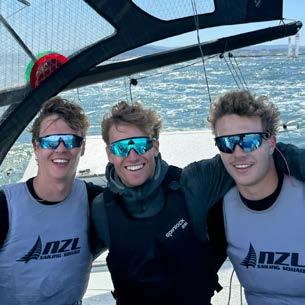
Francesco
Kayrouz and Hamish McLaren
Torbay Sailing Club and Royal Akarana Yacht Club
The pair achieved their proudest sailing moment as a crew with the silver medal at the 2024 49er junior world championships in Galicia, Spain, in July, capping a consistent regatta with a sensational final day. In fourth place heading into the last three races, the young Auckland duo scored 2, 2, and 5 to secure second place, finishing 12 points behind winners Richard Schultheis and Youenn Bertin of Malta.
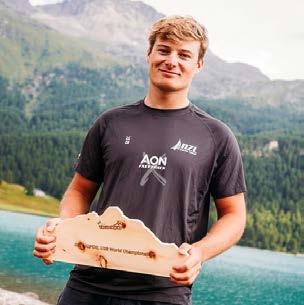
Eli Liefting
Royal Akarana
Yacht Club
Liefting added his name to the growing list of Kiwi windfoilers making waves on the world stage by winning the bronze medal at the under-23 world championships in Switzerland in August. The 22-year-old, who is part of Yachting New Zealand’s Aon Fast Track program, achieved the best result of his iQFOiL career so far on Lake Silvaplana after qualifying for the final of the men’s medal series, which was ultimately abandoned due to a lack of breeze.
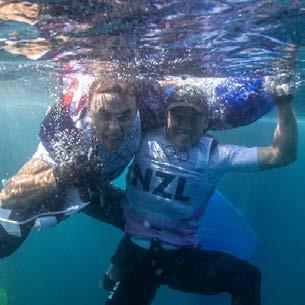
Isaac McHardie and Will McKenzie
Torbay Sailing Club
McHardie and McKenzie won Olympic silver at their first attempt in August, sailing a brilliant regatta against a quality men’s skiff (49er) fleet. The result secured New Zealand a fourth podium spot in the class in the last four Olympics – with Peter Burling and Blair Tuke’s gold in Rio de Janeiro in 2016 bookended by silvers in London and Tokyo.
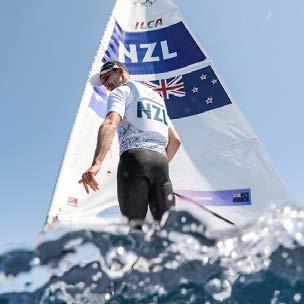
Tom Saunders
Tauranga Yacht and Powerboat Club
The veteran ILCA 7 sailor and former class world champion lined up in Marseille brimming with confidence after a strong start to 2024. He booked his spot at the Games with a fifth-place finish at the world championships in Adelaide in January and followed it up with top 10s at major regattas in Spain and France. Saunders finished seventh at Paris 2024, with light conditions badly affecting the men’s dinghy fleet as several races were cancelled.
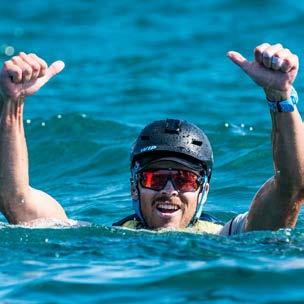
Sam Street
New Plymouth Yacht Club
In December, the versatile sailor made history with back-to-back titles at the Waszp World Games in Sorrento, Australia, before winning the Hartley 16 national title in Waiuku in February. To top it off, he was crowned 2024 Male Sailor of the Year at the annual Foiling Awards in April – only the second Kiwi to win the top honour and the first since Burling in 2018. Street also placed third at the NZ Moth national championships.
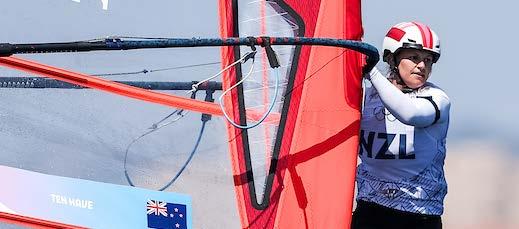
Veerle ten Have
Royal New Zealand Yacht Squadron
Ten Have advanced to the medal series of the women’s windfoil at Paris 2024 after showing plenty of promise in qualifying. Untimely mistakes ultimately proved costly, however, as she was eliminated in the quarterfinal to finish 10th overall. Her speed and accuracy off the start line, coupled with strong results elsewhere in Europe, have ensured that the 23-year-old from Tauranga will be among the windsurfers to watch next season and beyond.

Thomson 2.0 Racing Team
Thomson secured the highest-ever finish by a female skipper at a World Match Racing Tour final when she helmed the 2.0 Racing Team to third place in Shenzhen, China, in December. They also finished third on the Women’s World Match Racing Tour leaderboard before returning home to win the 2023 Women’s Match Racing championships. Thomson is the number one female match racer in the world and has consistently been near the top 10 on the open world rankings this year.
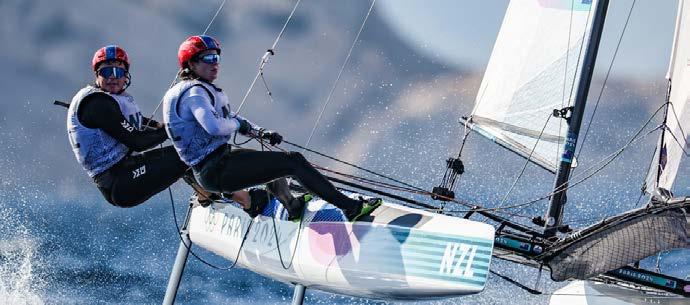
Micah Wilkinson and Erica Dawson Ngaroto Sailing Club and Murrays Bay Sailing Club
Wilkinson and Dawson claimed New Zealand’s second sailing medal of the Paris 2024 Olympic Games and broke a 36-year drought when they won bronze in the mixed multihull (Nacra 17). It’s the second time they’ve made an international podium together – after their silver at the European championships in 2022 – and it is the first time since Rex Sellers and Chris Timms in Seoul in 1988 that a Kiwi crew has managed to win an Olympic medal in the catamaran class.
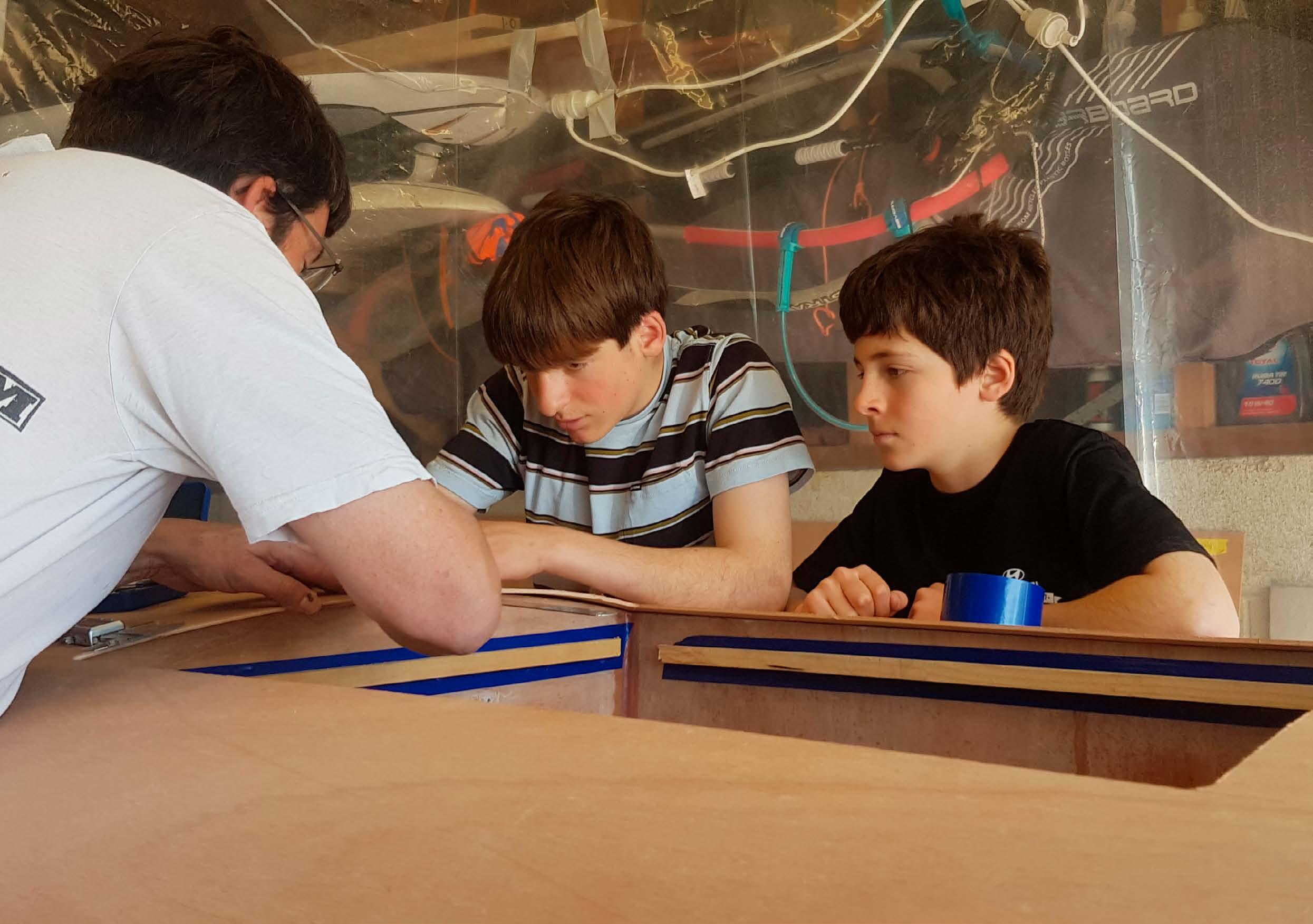
Kathy Catton talks to sailors who have had a special bond with their dinghies – often through many generations.
Andy Kensington was around P Class boats at the place of their origin – Tauranga Yacht and Powerboat Club. Since then, he has seen all three of his children sail the P Class and remains active in the class today.
“When I learnt to sail, the Optimist dinghy was just making its mark, and P Class boats were the true local staple. I
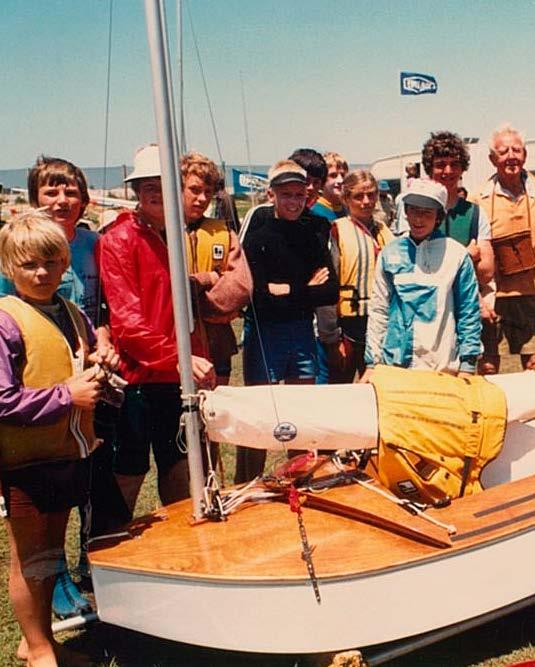
started my P Class journey at around age 11 or 12 and stayed sailing them until around 15. I loved the thrill of these small but mighty boats. My first P Class was a fibreglass model, and my final boat, P3 Superdocious, was a prized acquisition my parents bought off a Kawerau family, in the Bay of Plenty. Sadly, I don’t know what’s happened to either of them now.
“During the Covid lockdown, I decided with my three sons, Rowan (now 19), Sean (now 17) and Hugh (now 13), to build a new P Class boat, Eazy Peazy, from a Dan Leech kitset. The boat achieved great success, with Sean winning the 2021 Tanner and Tauranga Cups and Oli Stone coming second in the 2022 Tauranga Cup and winning the 2023 Tanner and Tauranga Cups. We managed to give it the P3 number, so that’s a nice honouring of
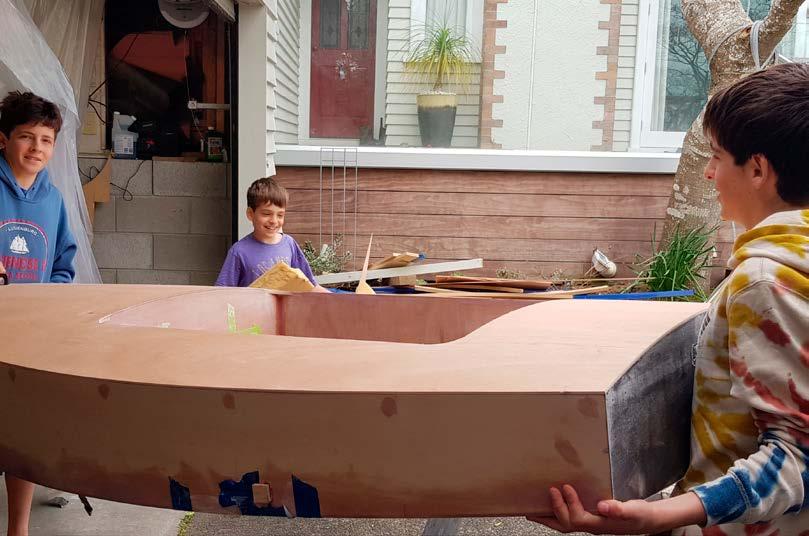
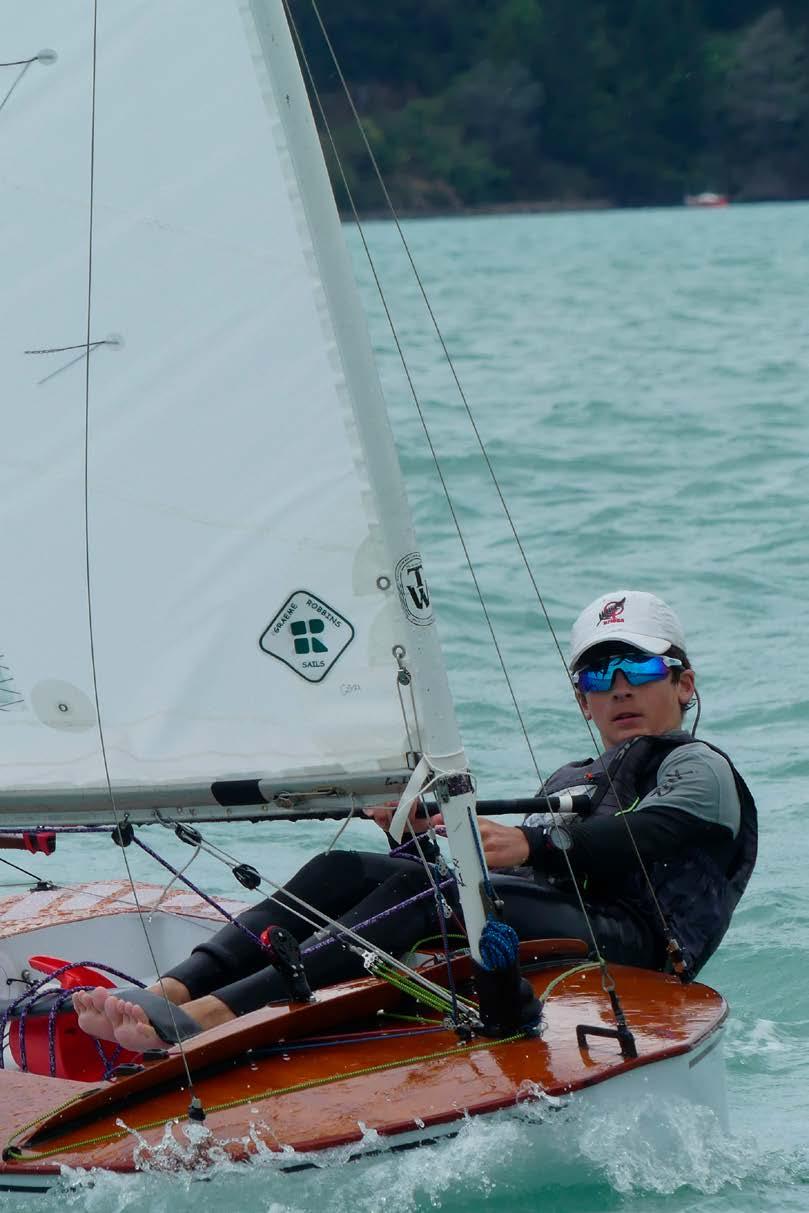
my old boat.
“Unlike the Optimist, which primarily focuses on basic sailing skills, the P Class demands a higher level of technical prowess. I really think the P Class has shaped sailing in New Zealand. Rowan and Sean are now sailing the 49ers, and they’re convinced their time in the P has helped them become proficient in the more demanding youth classes. It’s a tough boat, but that’s what makes it rewarding. You learn resilience, and it prepares you for whatever comes next.
“It remains to be seen what will happen to Eazy Peazy. There’s something about them that means they’re pretty hard to part with. But once Hugh has finished with it, I need to remember that they are not pieces of furniture and are better used by more up-and-coming sailors.”
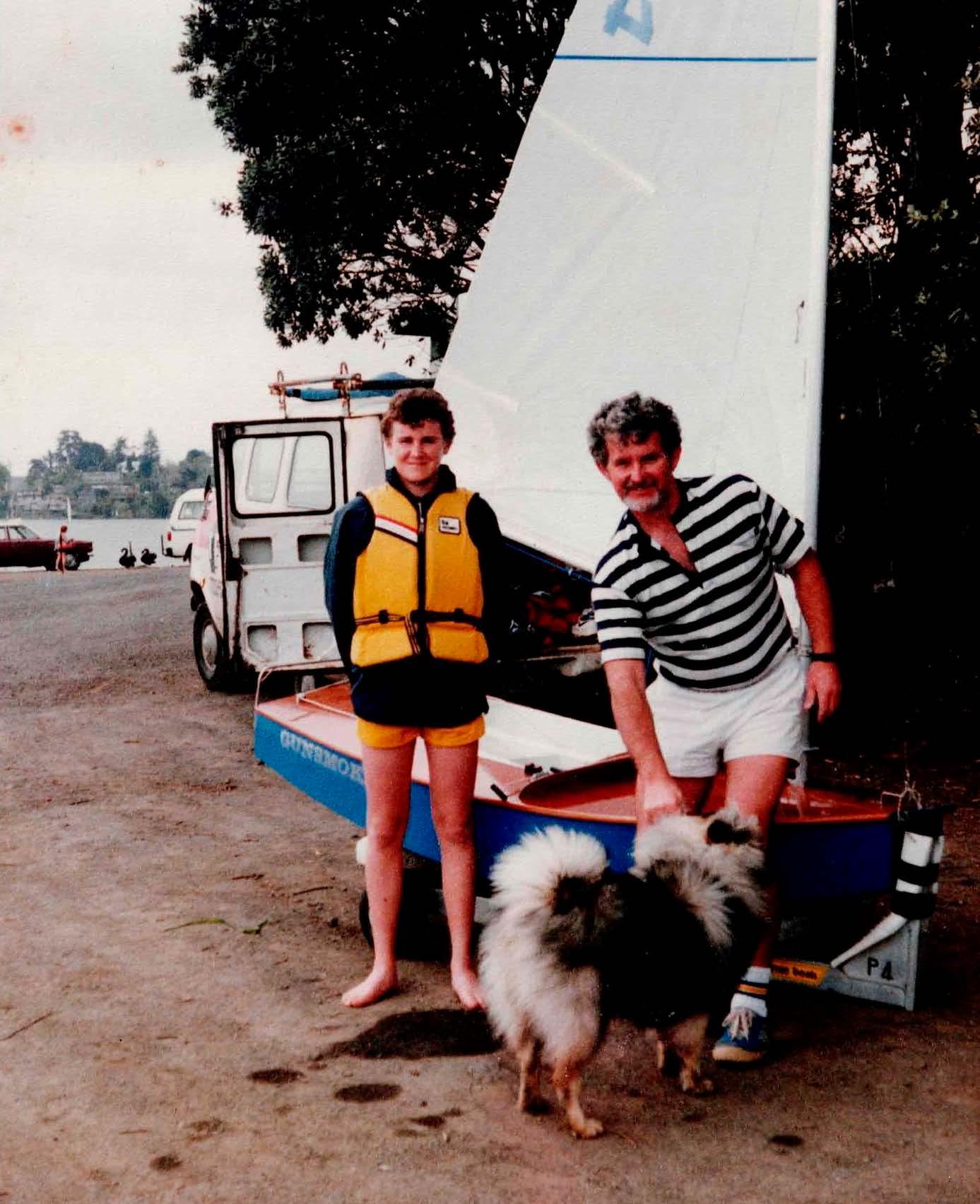
Keith Elliott was very much a part of the fabric of dinghy sailing in New Zealand and was known as a true craftsman and builder of racing yachts. Scott Elliott recounts memories of the boats his father built for him.
“In 1986 my dad was one of those P Class fathers who had binoculars stuck to his eyes every weekend! I had graduated from a fibreglass Optimist that my dad built. He scoured the country for a cheap P that he could do up. He found two and proceeded to proudly strip, paint and refit. Unfortunately, the first one was a lemon. The second was a better boat but still needed to be redecked and refitted. I was delighted to finish 10th in my second nationals at Kohimarama. Dad said he
would build me a new boat if I finished in the top 12, so I was pretty excited to see what would happen next.
“He built me P4 Gunsmoke and P404 Vengeance and from this grew orders for eight in the first year (all from the garage of our house). And so began the DWR (Dinghy Workshop Racing) boats. Of course, I needed a Starling next, so he built me 1044 Integrale, and so began the DWR Starling.
“When he passed away in July this year, I started pulling together a spreadsheet of all the boats he had built and where they are now. Since 1988, Dad built 47 wooden P Class, around 25 fibreglass P Class and as many wooden and glass Starlings. A lot of these boats have won numerous Tanner and Tauranga Cups, Starling nationals and match racing events. I’ve tracked down most of them – but not all.”
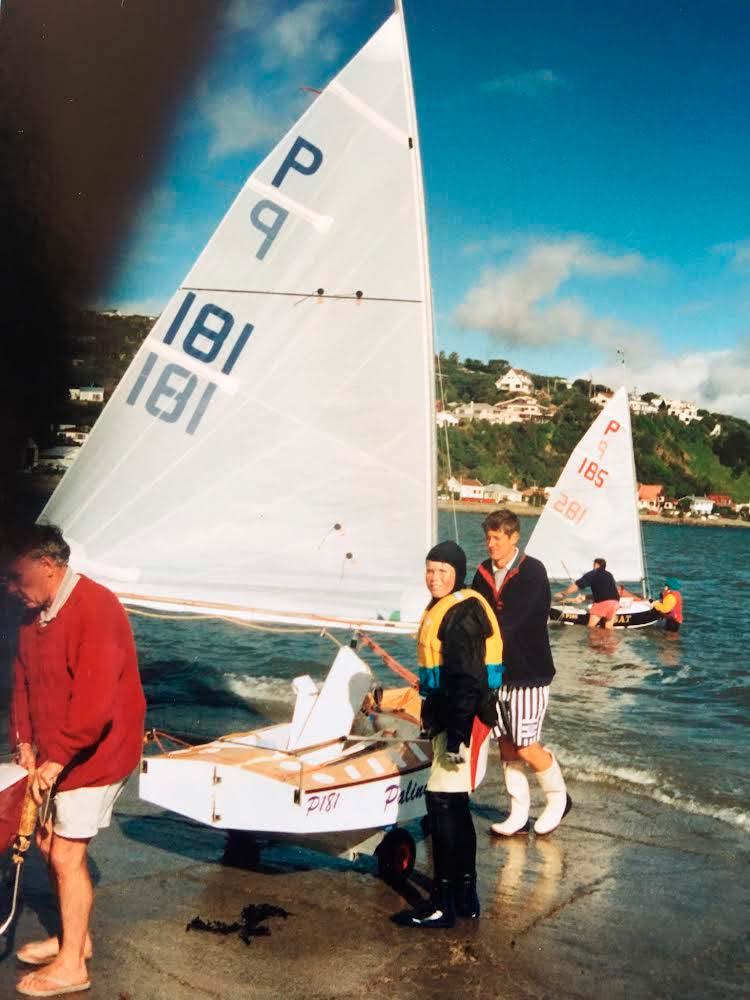
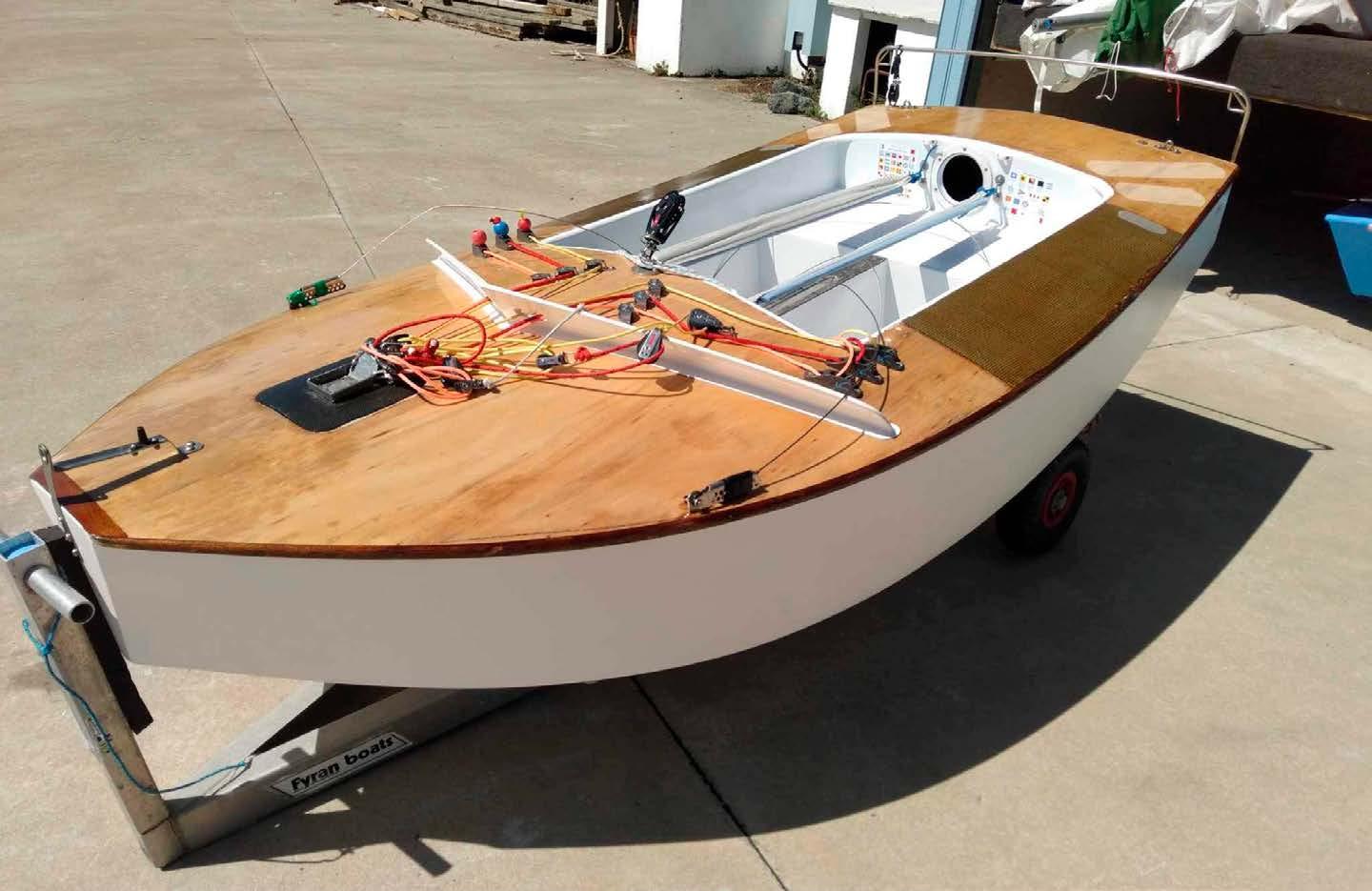
Tom Parrish sailed his P Class Palindromic between 1995 to 1997, aged 13 to 16, from Murrays Bay Sailing Club. For him, re-discovering it was about more than just the boat.
“When I was made redundant in my 30s, I realised I needed to reconnect with my past. I was inspired to dive back into dinghy sailing. I’d always cherished my time sailing a P Class. I believe it’s one of New Zealand’s best-kept secrets for teaching young sailors the basics of boat handling. These boats are so overpowered and unbalanced that even mid-pack skippers gain exceptional sailing skills. My parents had told me about working with the previous owner of P181 Palindromic, so I knew it was still around. When I saw her for sale again earlier this year following the P Class nationals in Tauranga, I jumped at the chance to own her once more. I was lucky enough to secure the sail number 181 when we commissioned the build by the late Keith Elliott. It matches my birthdate of 18/11/81, so you can see there is a lot of sentimentality to owning her again.
“Restoring this boat and many others is more than a project; for me, it’s about celebrating New Zealand’s sailing heritage and creating lasting family memories. For my wife, I was fortunate to find my old Starling, Prime Number 1163, being sold on TradeMe. Yes, another play on the mathematical. Again, sentimentality stepped in, and I caved, and added her to our growing fleet of small boats.
“I’m involving my children in the restoration process, teaching them the value of craftsmanship, even if sanding isn’t their favourite task. My daughter will be taking on the P in the next few years, and my wife will enjoy my old Starling for a few years to come, I’m sure.”
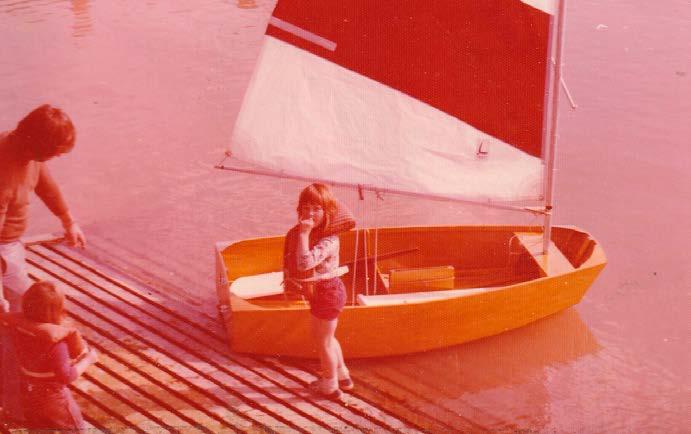
Paul Pritchett, from Charteris Bay Yacht Club, is one of the sailors responsible for bringing the Optimist to New Zealand and fostering the class in this country from the 1970s. He tells the story of the first Optimist in the country.
“It was my friend Clive Roberts [former OK Dinghy world champion and Finn sailor] who brought the Optimist to New Zealand. He’d been travelling through Europe in the early 1970s and came across the boat. It was designed to be a simple, manageable craft for young sailors to learn to sail in. It was a refreshing contrast to the more challenging P Class boats. As luck would have it, Clive was also the chairman of the youth committee for the [then] New Zealand Yachting Federation, so he had the perfect platform to bring this boat to New Zealand.
“We started to envision a future where every child could learn to sail at low cost. Tragically, Clive was killed in a road accident on 10 May 1975, so I decided to honour Clive’s vision, and I built the first New Zealand Optimist in our spare bedroom at home in Christchurch. It cost me $120 in materials, and we called her Muffin
“We launched her on 14 September 1975 at Charteris Bay Yacht Club, much to the amusement of some locals who were painting the club at the time. They were surprised that Barry Craw and Tanja Pritchett, both novice sailors, could navigate her with ease. This was the start of it. By the end of the first season, 45 building fees had been sold, and by 1979, over 1400 Optimists had been registered in New Zealand. Today I think it’s over 4000.
“I’ve still got Muffin in my garage at home. I’m not sure what I’m going to do with her. My children and grandchildren have all sailed her. She’s still got the yellow and red KZ 1 sail, too.”
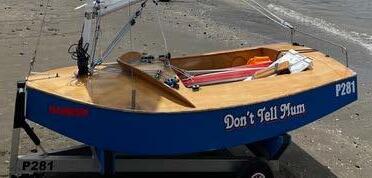
Gary Smith and his father Colin, the Onerahi P Class champion in 1947, have been involved in the evolution of the P Class dinghy for many decades.
Here he recounts some of the stories of these treasured relics.
“One of the significant milestones in P Class history happened in 1977 when the first fibreglass boats were introduced, and at the same time the class introduced aluminium masts.
“I was lucky enough to sail the first one at the 1977 Murrays Bay Tanner Cup. This boat, P431 Glabo, represented a new era in dinghy construction.
“The early fibreglass prototypes, including one dubbed Fibo, have left a lasting legacy. Today, Fibo remains a floating garden ornament in Tauranga. You can still see it on Beach Road, Tauranga.
“The P Class fleet’s evolution is also marked by iconic boats like P15 Staccato and P69 Mintie. Staccato is owned by Craig Monk, and is looked after by Murrays Bay Sailing Club, who loan the boat to their top-performing Optimist sailor each year.
“Similarly, Mintie, built in 1968 and known for its distinctive light blue colour, has a storied past with notable sailors such as Ray Davies and his brother Mike.
“Another cherished boat, P281 Don’t Tell Mum, is particularly significant to me. Built by Jack Williams in 1995, it was the last plywood boat constructed by Jack, who also built my fibreglass boat in 1977. My son Phillip went on to sail the boat in 2005.”
Amy Mulcahy and her family are continuing the P Class tradition with pride, and with great success.
“My dad, Chris Waring, built my Optimist and three of our family’s P Classes. All from the garage at home. I’ve got three younger brothers, and we all sailed in them at one time or another. They were great boats, and our P Class boats were very successful. I won the Naiomi James Trophy (for female national champion) at the P Class nationals in 1989 in Napier, sailing P18 Illusion. My brother Peter was a top sailor, and he won the Tanner Cup and placed second in the Tauranga Cup in 1991 in Dunedin, sailing P969 Stratus
“Over the years, we’ve managed to buy all three of them back for our own children. Two are still in the family. My son Mason Mulcahy came second in the Tanner Cup in 2019 in Evans Bay, Wellington sailing Illusion. It was re-registered from P18 to P6 somewhere along the line.
“I’ve sold my one now, but Peter’s got the other two. There’s quite a history to them.”
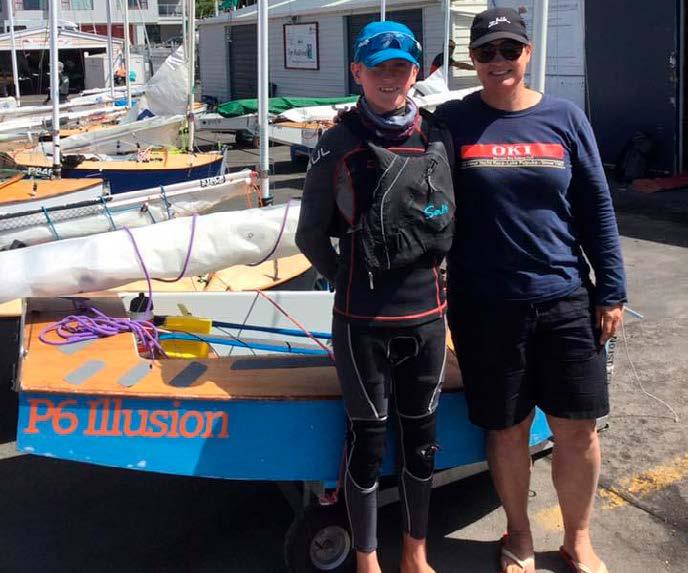
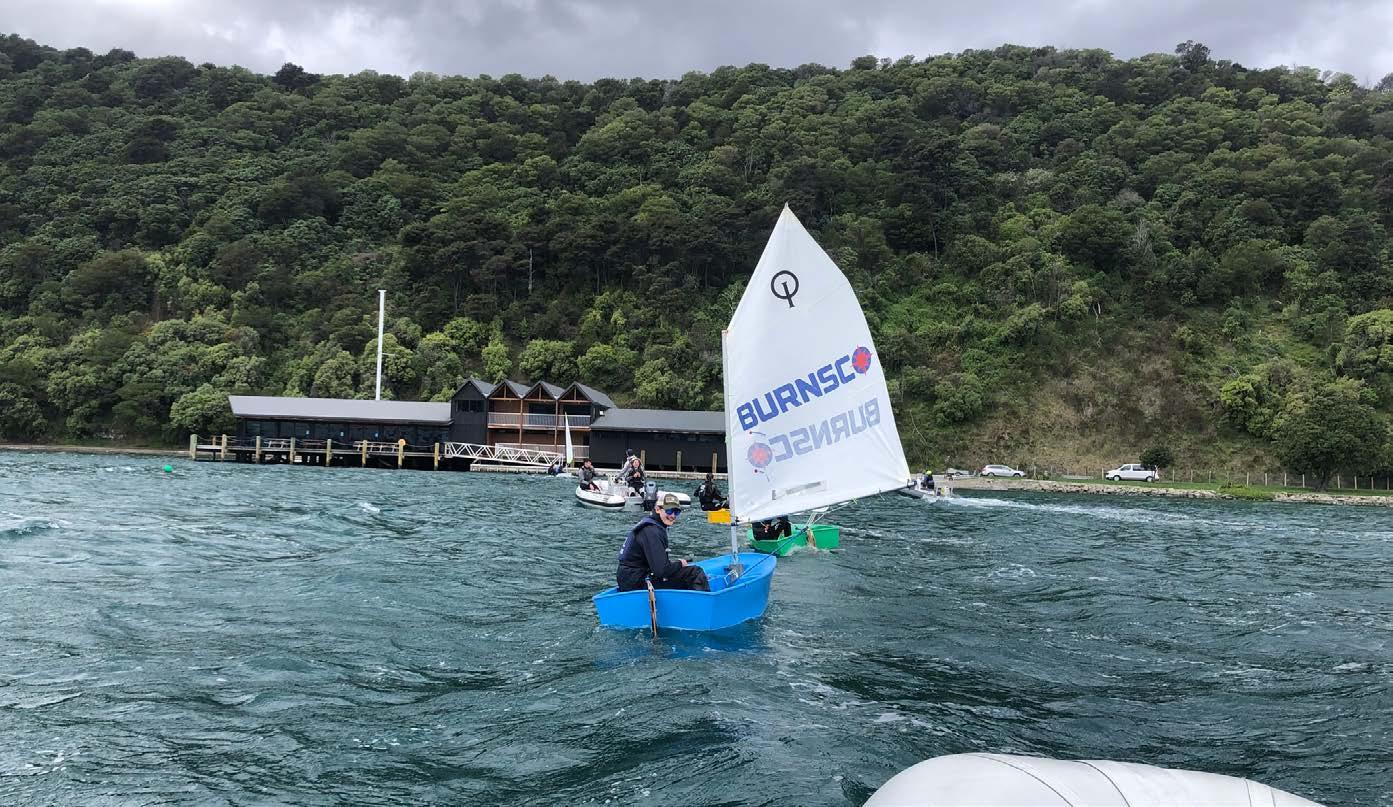
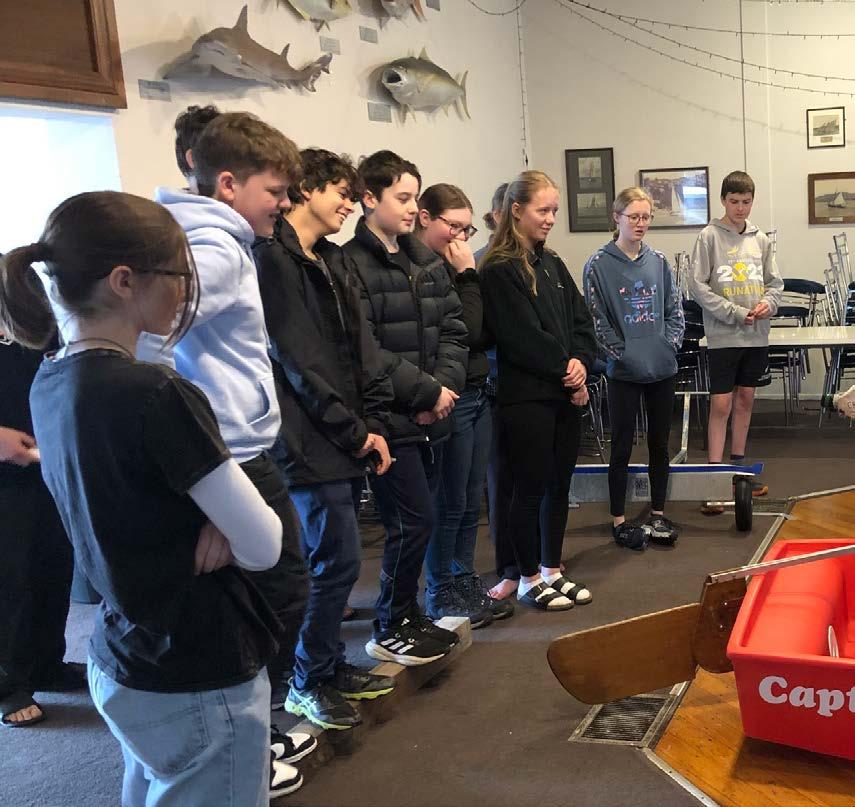
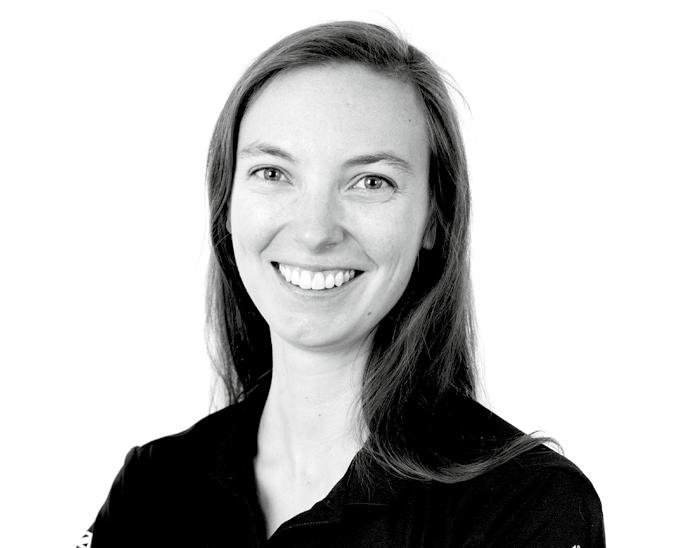
2024 has delivered 140 new sailing coaches across NZ but several challenges remain for yacht clubs.
One good thing about the winter and spending less time on the water, is that I get to connect with coaches – experienced and aspiring – from around the country.
This winter was no exception: I visited several regions and ran coaching forums in Wellington, Whangārei, and Christchurch.
A total of 40 coaches attended these forums, hosted the day prior to the coaching courses. The forums were aimed at providing a space for coaches to interact and find practical solutions to their challenges and I was pleasantly surprised with the insightful discussions and the ideas for strengthening club programmes this summer.
While all the sessions were unique in their own ways, a few themes emerged – with some common problems that many yacht clubs face.
Creating your own sailing games is a good way to freshen up your programmes – identifying a sailing skill you want to teach and finding a way to make it fun. Constantly including feedback from your sailors on how to make it more fun for next time is important. Check out our online resources or visit our Facebook and Instagram pages for the Game of the Week, posted throughout summer.
This topic often leads to the paid vs volunteer coach debate. Many clubs find that paying their coaches leads to better retention as their coaches are then less likely to be lost to other paid employment, while providing opportunities for coaches to upskill and grow are also important.
Celebrate Your End of Year Function with Us!
With
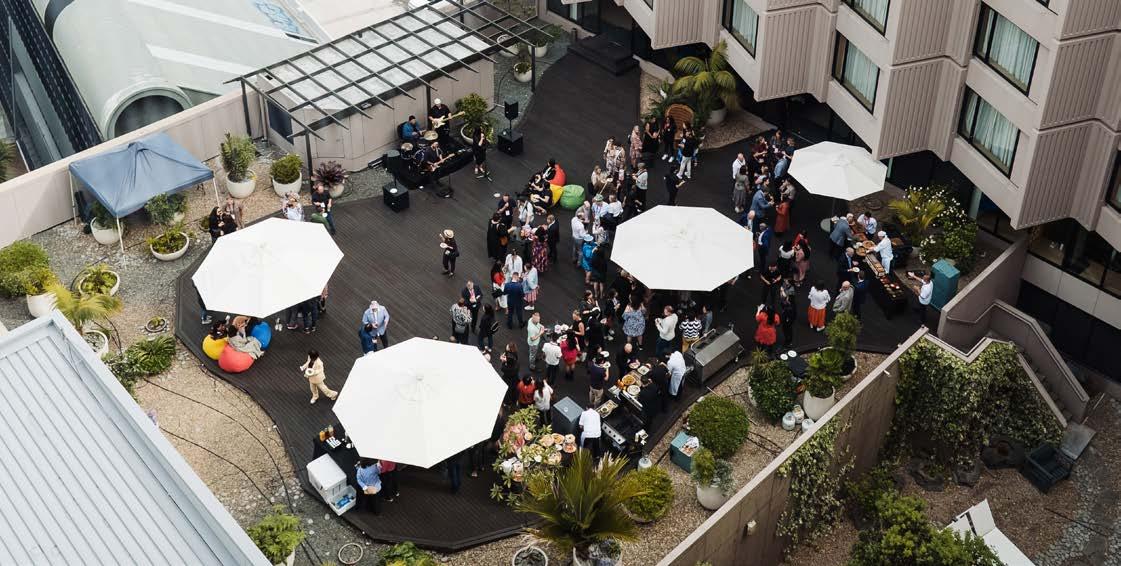

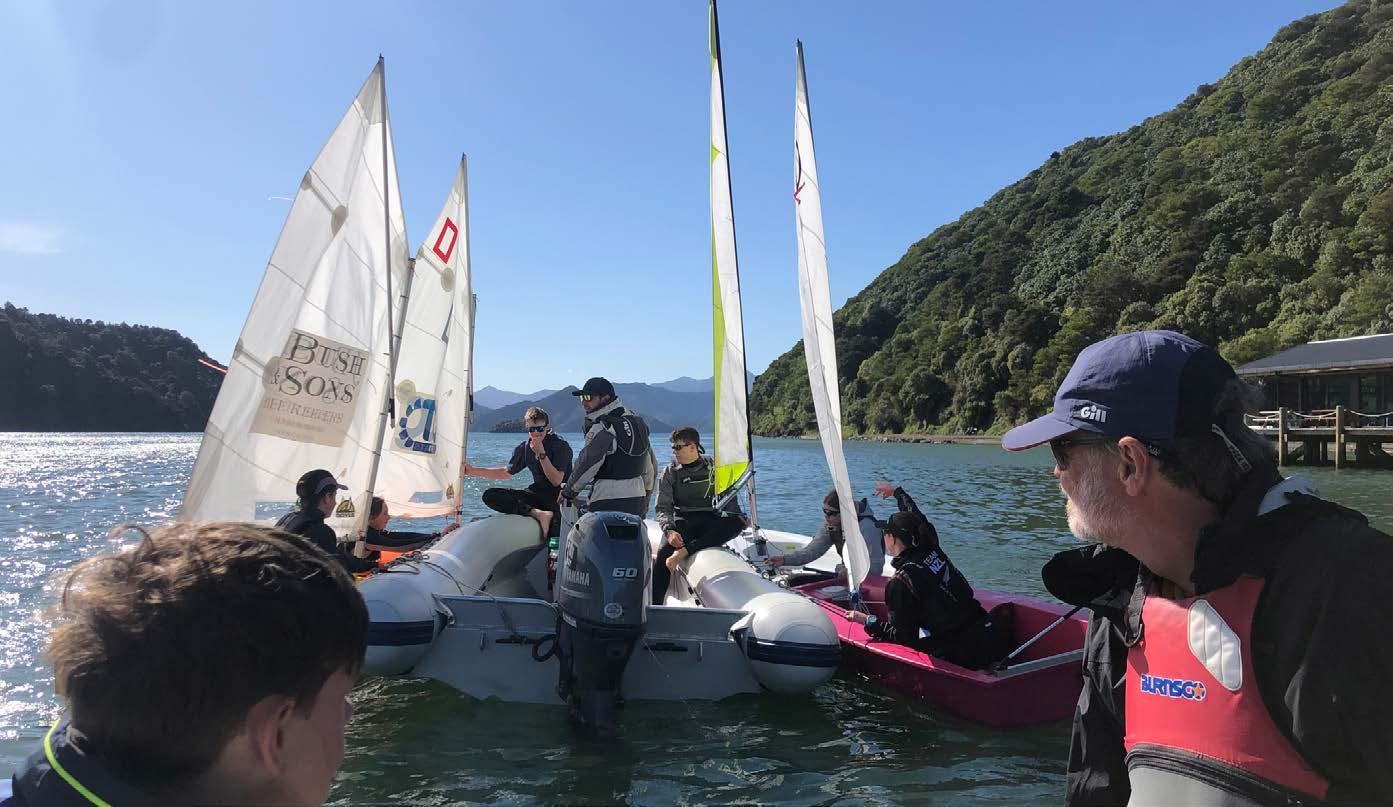
Getting (and keeping) more sailors into club days and involved in the yacht club was a recurring theme and there are several reasons clubs may be struggling with this. A few basic questions can help to narrow it down: Is your yacht club a place where all young people of different genders and backgrounds – feel like they belong? How competitive is the atmosphere? And how much time are you asking from those who attend?
Young sailors need to see themselves at the club, having fun. Many kids may not be looking for intense competition or may not want to race. Are there alternatives you can provide so everyone can have fun on the water, and is your club racing or event an all-day occasion, or can people duck in and out and only spend an hour or two there? Many people are looking for more flexibility in programmes as their lives are becoming increasingly busy.
4
If you have taken a Learn to Sail (Dinghy) coach course and have received your buddy or assistant coach qualification, you can apply to upgrade online once you meet the age requirements. Or, if you’ve been coaching for a few years, try out the race coach course – it will help you develop your reflective skills and learn more about coaching and learning styles. This is an online course that anyone in New Zealand can do. You can click here for more information or get in touch at kirsten@ yachtingnz.org.nz if you have something specific you want to upskill in.
Parents’ involvement in the programmes is invaluable to retaining sailors. They want to help, and your job is to find the right avenue to direct that energy. You could run an information session on launching/rigging and washing down/derigging ribs so that parents can help with that while you assist your sailors. You could also get parents to give sailors a hot drink and a snack when they come in from shore. It’s important to make them feel valued, involved and appreciated.
This year has been a productive one for our coaches around the country – around
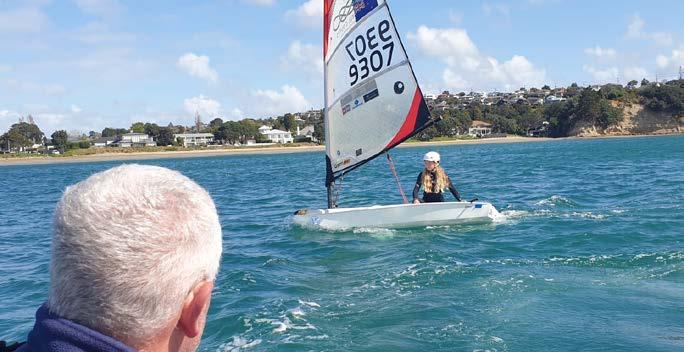
140 new coaches have completed either their assistant coach, buddy coach or Learn to Sail coaching qualifications since the start of 2024.
It’s encouraging to see that, despite the challenges highlighted at these winter forums, interest in becoming a sailing coach is as healthy as ever.
Equally heartening is the creative solutions our groups came up with at these sessions. It all bodes well for an exciting season of sailing, and I can’t wait to see our new coaches in action.
We’ll delve into each of these areas with greater depth in future editions of YBQ, and if you have any questions or additional comments, don’t hesitate to get in touch.
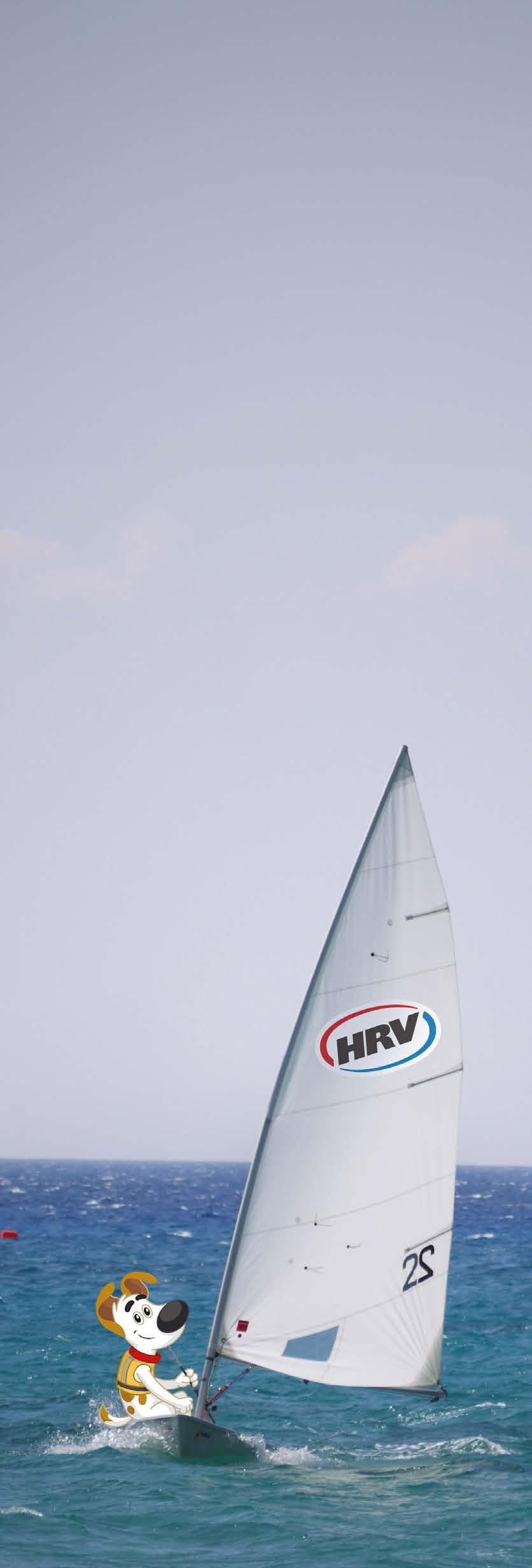
Choose HRV whole‑home water filtration and yachting wins too!
HRV whole-home water filtration reduces sediment, chlorine and other contaminants before a drop enters your home. So you’ll enjoy cleaner, filtered water from every tap, shower head and appliance.
Plus, we’ll make a donation to both your club and Yachting NZ for every qualifying purchase in November!
Nelson Yacht Club’s alignment with RŪNĀ ‘key to club’s long-term success’.
Yachting New Zealand’s groundbreaking RŪNĀ schools framework has played a big role in helping one of the country’s sailing clubs evolve into a true asset for its local community.
And says Nelson Yacht Club manager Tim Fraser-Harris, building relationships with schools and raising awareness of the programme have been vital steps on this journey.
Last season, more than 700 students from seven local schools participated in both onshore and sailing
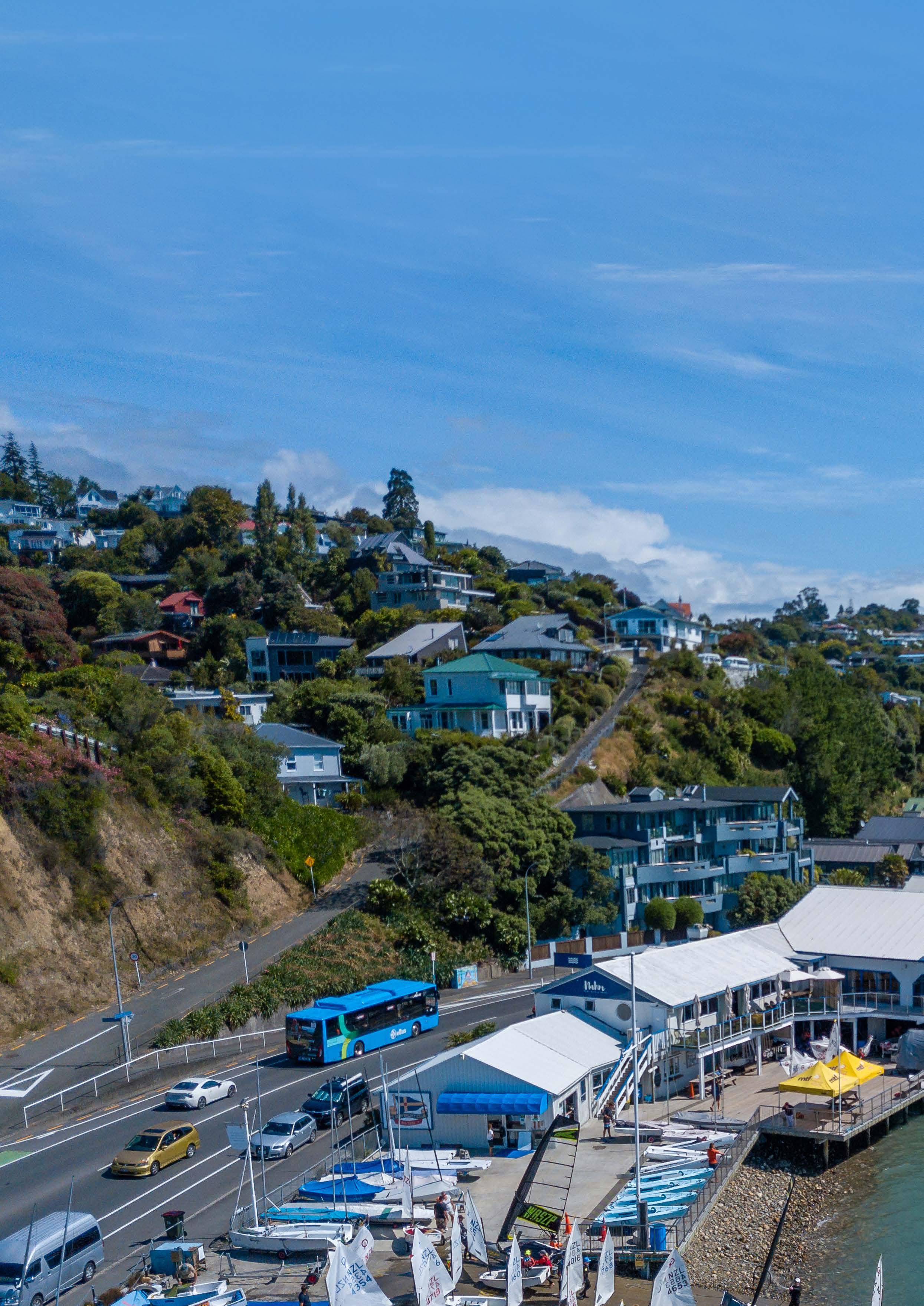
activities at the club, through RŪNĀ’s Kōkōkaha and Kōrinorino modules.
“We’ve been fortunate to establish strong relationships with several local schools over the years, with more than 200 additional students taking part in sailing experiences beyond the RŪNĀ programme,” Fraser-Harris said.
Securing support from Port Nelson Limited has enabled the club to offer free Kōkōkaha sailing experiences to tamariki from six local low-decile schools, reaching approximately 500 students.
While finding the right contacts within schools often comes down to “who you know,” last year’s Yachting New Zealand RŪNĀ hui and Moanamana teacher development day, hosted by the club,
helped raise awareness among educators.
The club’s engagement has further expanded with the Kōrinorino module, which includes shore-based activities, making sailing more accessible to a wider range of students. These activities were developed collaboratively with local teachers and Yachting New Zealand’s education lead, Alisa Torgersen.
“It’s inspiring to see teachers actively involved in shaping this programme,” Fraser-Harris said.
“We’re excited for what’s next and have some exciting ideas in the pipeline.”
A central aim of RŪNĀ is to increase diversity in sailing. Fraser-Harris feels sailing resonates strongly with New Zealanders, as “so many can trace their family history back to those who navigated the ocean under sail”.
“It’s early days, but RŪNĀ is
beginning to make a difference.”
As the club’s outreach grows, the challenge of finding and retaining qualified coaches persists. “We rely on both experienced international coaches and our ‘Leaders in Training’ programme, where young sailors, around 14 or 15, volunteer to support seasoned instructors,”
Fraser-Harris explained. This programme also offers formal training, including powerboat handling, marine VHF operation, first aid, and Yachting New Zealand’s Learn to Sail Coach course.
The club’s funding relies significantly on local sponsorship and user fees.
“Port Nelson Limited’s support is crucial in helping to make sailing more accessible, whilst wider programmes operate on a user-pays basis,” Fraser-Harris said.
The club has also developed a valuable partnership with the local Mitre 10 franchise, which sponsors sails, aided by the owner’s history with the club.
With Moanamana (the third and final RŪNĀ module) and
Yachting New Zealand’s Clean Club programme included in its Strategic Plan, the club aims to become a hub for connecting tamariki and rangatahi to the marine environment.
Fraser-Harris believes Nelson Yacht Club’s alignment with RŪNĀ is key to its long-term success.
“RŪNĀ will look very different for different clubs. While our Sailing School structure supports a large programme, I’d encourage other clubs to consider RŪNĀ’s benefits for both club and community.”
“While there’s still work to be done, the club is evolving beyond a typical sailing club — it’s becoming a true community asset.”
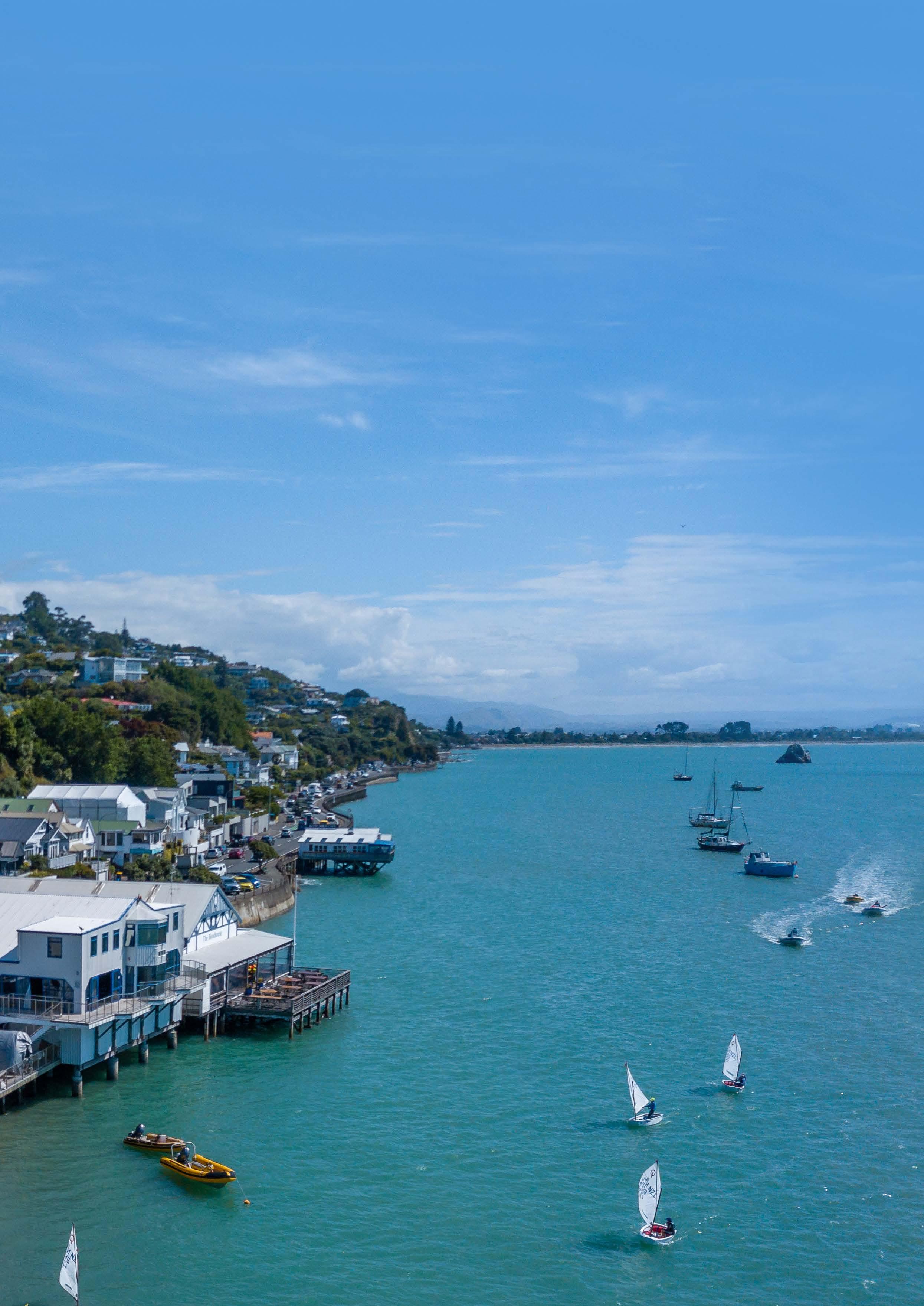
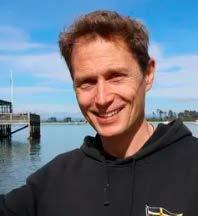
Nelson Intermediate School teacher
When and how did you first hear about RŪNĀ?
In mid-2023 when Yachting New Zealand and Tim from the Nelson Yacht Club, visited Nelson Intermediate. They shared an inspiring vision to partner with schools and create a flexible programme where students could get on the water, explore STEAM (science, technology, engineering, arts and mathematics), connect with local stories, and, as Sir Peter Blake envisioned, fall in love with the marine ecosystem enough to want to protect it.
Would you recommend other teachers and clubs get involved?
What we enjoy most about being connected to the sailing club is that

we’ve offered a learn-to-sail programme for several years, and it’s always been a positive experience for our learners. It gives them a chance to try something new and broaden their experiences. With the addition of the RŪNĀ modules, there’s now a deeper, real-world connection that extends into multiple areas of the curriculum, making learning more engaging.
How did the RŪNĀ lessons support your teaching goals?
It has aligned perfectly with our teaching goals by providing clear links to the curriculum and opportunities to create differentiated experiences for learners. The classroom activities encourage discovery-based learning and are offered at various levels, making it easy to revisit the programme in consecutive years. In Term 1, our school’s focus was on exploring our cultural narrative, place, and whanaungatanga, and engaging with RŪNĀ lessons alongside a day at the local yacht club really brought those themes to life for the students.
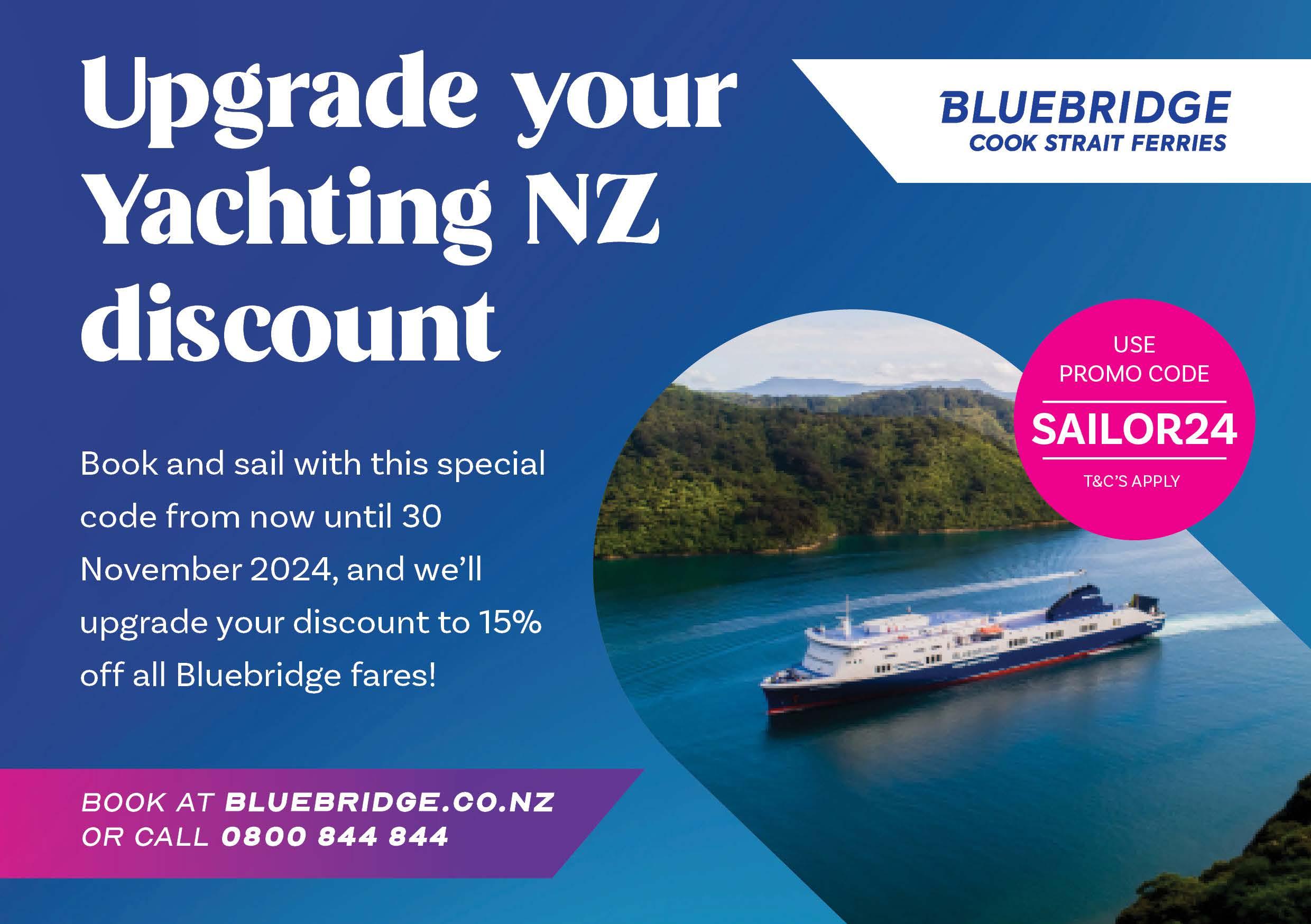
What specific elements of the RŪNĀ programme are most effective in promoting student learning?
The flexibility of the RŪNĀ programme is one of its greatest strengths. You can tailor it to your learners’ needs and your school’s context, using the resources to plan lessons leading up to the sailing experience, choose land-based activities at the club, and design follow-up tasks back at school. This adaptability is especially useful for working around tides and the nature of your group. In 2024, our students loved the activities that helped them explore sailing and connect with Kāpehu Whetū, the star compass used by early navigators. We’re also excited to engage with Monanamana in 2025.
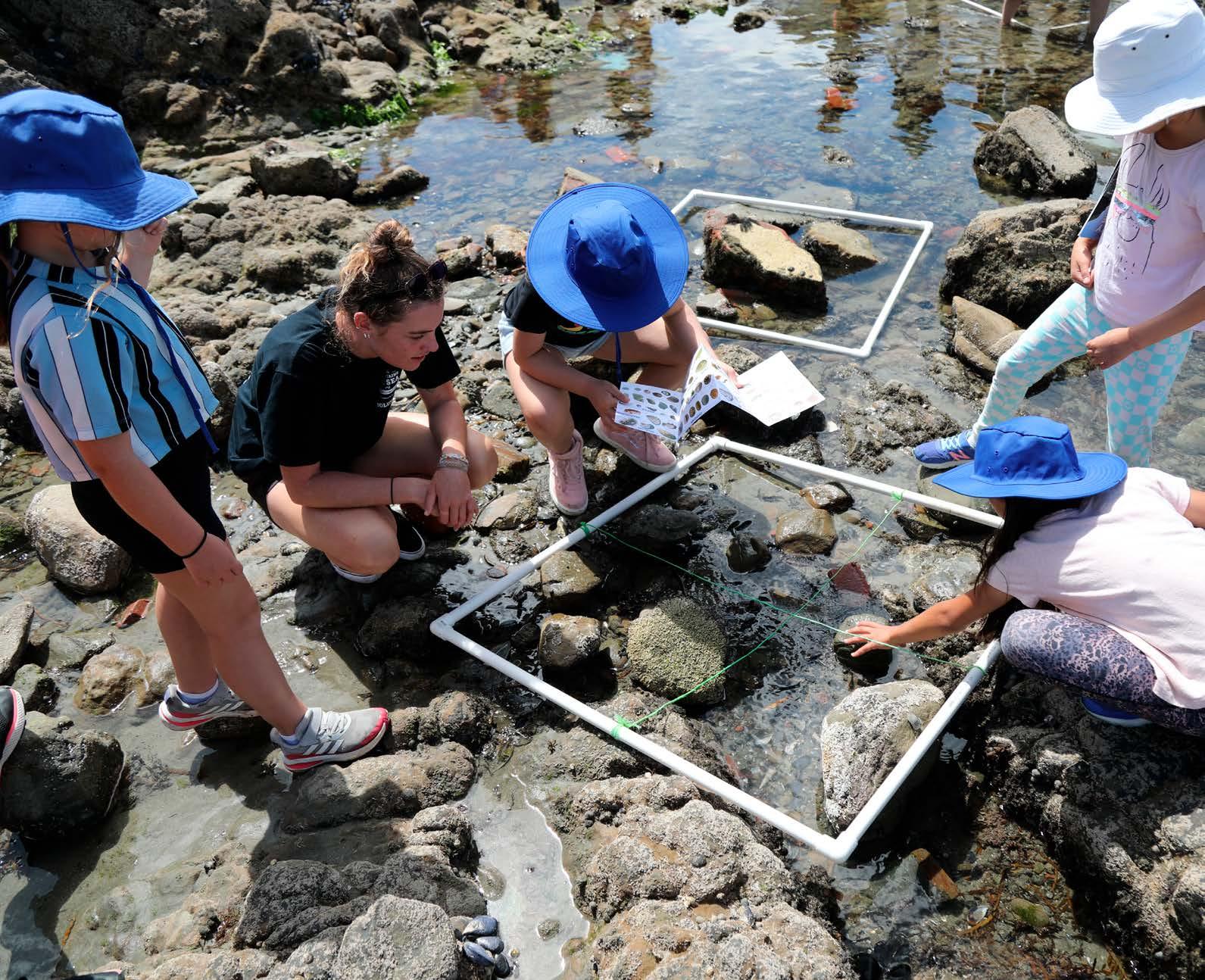
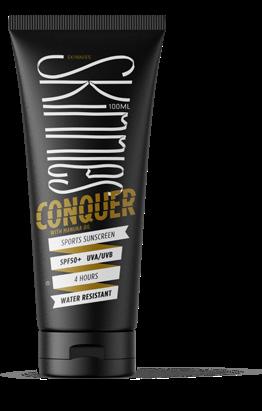
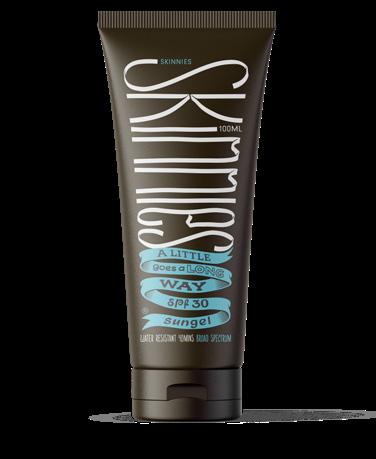

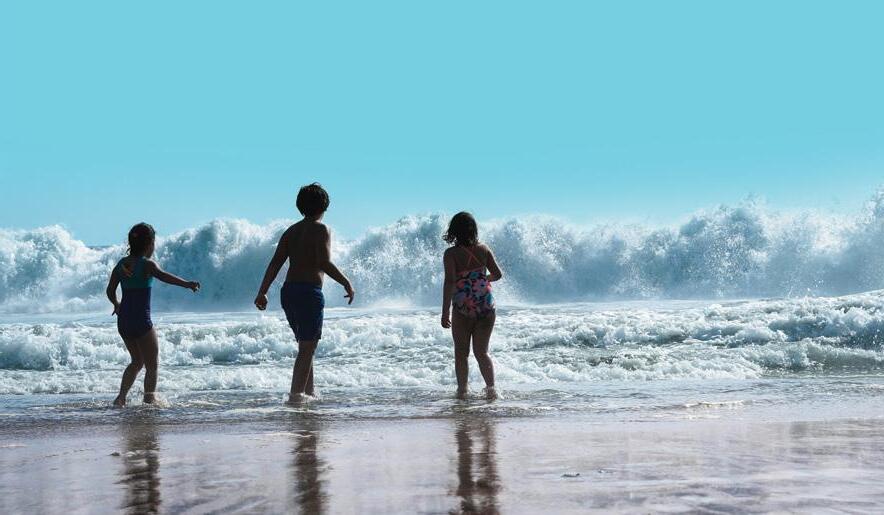
Record number of vessels heading home after six months exploring – and helping – in the Pacific.
After six months exploring the tropics, the Island Cruising Pacific Rally has set sail on the final leg of the rally from Tonga, Fiji, Vanuatu and New Caledonia, bound for New Zealand or Australia.
“Thank you so much to all the many communities, businesses and organisations who have supported and welcomed us throughout our voyage,” said rally director Viki Moore.
This year’s rally has been the biggest ever, with over 160 vessels – both yachts and powerboats – navigating the stunning waters of the Pacific and exploring some of the most beautiful destinations in the world.
The rally runs each year from May through to the end of October.
Cruisers mainly depart from the Bay of Islands in New Zealand or Southport in Australia and sail up to Tonga, Fiji, Vanuatu or New Caledonia. With flexible dates and
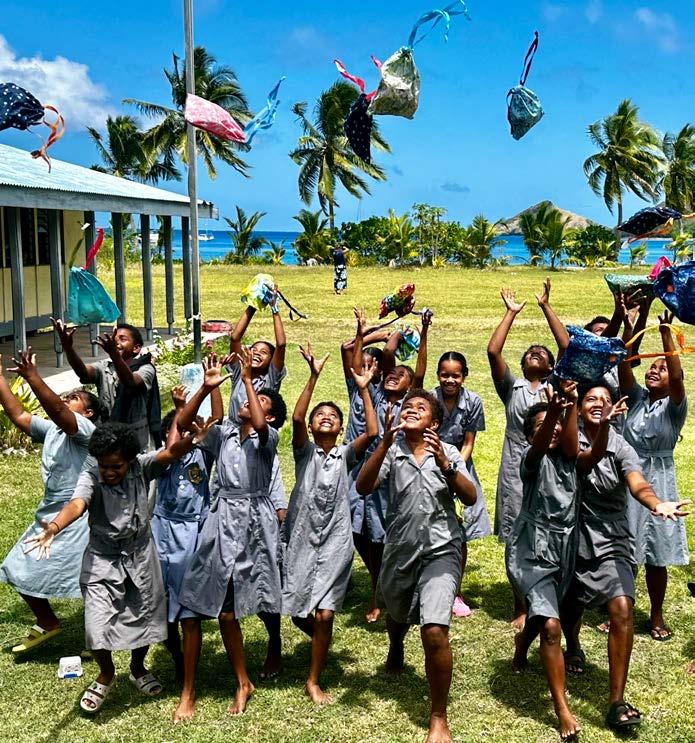
destinations, cruisers can choose their own schedule and itinerary to suit their interests and cruising style.
“The Island Cruising Pacific Rally is not just about sailing; it’s about creating a community of passionate adventurers,” Moore said.
“We aim to provide a supportive and enriching experience that allows sailors to share their love for the ocean, to connect with different cultures and explore the incredible landscapes of the Southwest Pacific together.”
The rally welcomes sailors and powerboat owners of all experience levels to join in and vessels range from 26 ft yachts to 100 ft powerboats. Over the course of the journey, participants get thorough pre-departure preparation training and regular updates. They can connect with fellow cruisers, discover hidden gems along the route, and immerse themselves in the rich cultures of
the South Pacific.
The rally is also excited to participate with a number of environmental and social projects, Moore said.
This year, in conjunction with Citizens of the Sea and with new digital tools and state-of-the-art devices, sailors were trained to collect and upload Ocean eDNA samples which were sent back for scientists to process and analyse. The goal is to build a platform that provides insights into shifting patterns of life in our oceans.
Cruisers collect environmental DNA, create 3D models of reefs, record biogeochemical data, maintain loggers and send richer data in a more cost-effective way than before.
Citizens of the Sea will contribute valuable information for climate-related impact assessments and strategies to protect vulnerable marine ecosystems.
The rally also helps the charity Days for Girls to transport sanitary kits to Fiji –which are hand-made by volunteers in New Zealand – and participates in beach cleans, delivers clothing for Rotary, and spends time and money in remote communities that regular tourists can’t get to.
There are also regular social events and get-togethers throughout the Pacific: the annual Musket Cove Regatta is always a favourite, as well as the Vava’u Sailing Festival in Tonga.
Registration for the 2025 Island Cruising Pacific Rally is now open and interested cruisers are encouraged to click here for more information.
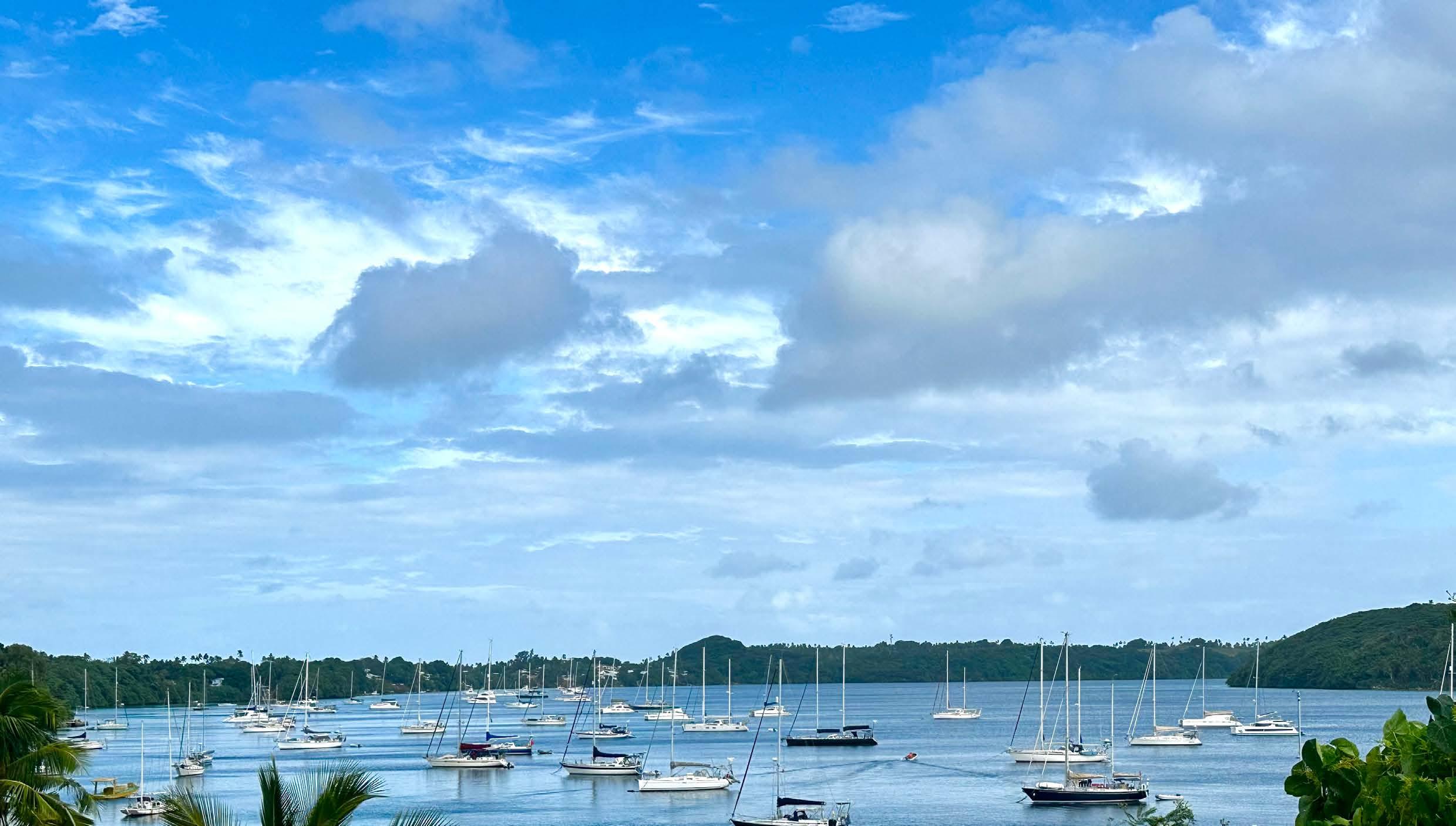
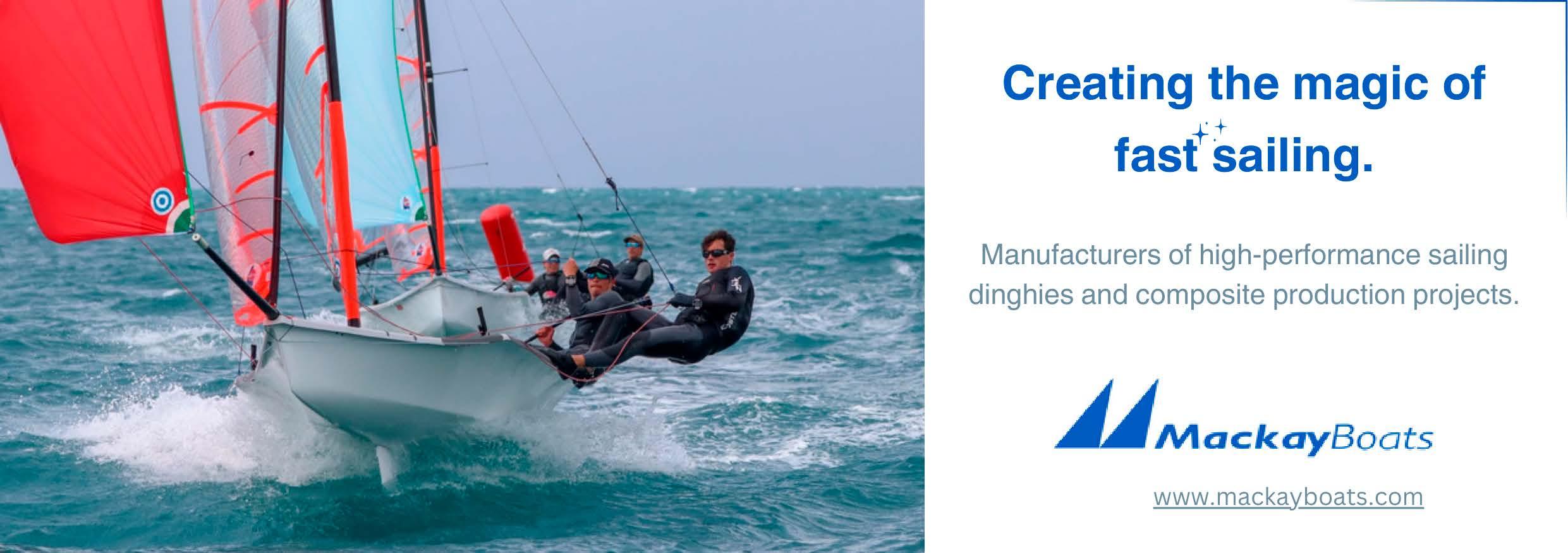
Aon’s 11-year partnership with Yachting New Zealand has focused on providing sailing programmes that accelerate talented youth sailors to achieve their goals.
Aon also provides risk and insurance solutions to affiliated clubs and members, ensuring appropriate coverage is in place for unexpected events and effectively managing insurance premium costs.
Aon delves into the current state of New Zealand’s marine insurance market, highlighting key trends and challenges, to help boat owners and clubs make better decisions when it comes to their insurance and risk management.
Market trends and challenges to watch
In 2023, the Auckland Anniversary floods and Cyclone Gabrielle caused over $3.8 billion in insured losses, marking them as the largest non-earthquake natural disaster events in New Zealand’s history. In the same year, global economic losses from natural disasters, including weatherrelated events, reached US $194 billion, far surpassing the 21st-century average of US $128 billion.
These events have led insurers to adopt a more conservative stance, focusing on flood risk exposure and storm damage, resulting in price increases, capacity contraction, reduced coverage, or even withdrawal for certain risks.
This is the case for QBE, who have withdrawn from supporting certain schemes, such as the Yachting New Zealand-affiliated club scheme, due to their decreased appetite for coastal and waterfront property insurance.
Overall, in New Zealand, the hard
insurance market persists, with little new capacity or competitive tension to mitigate rising costs.
a new insurer for Yachting New Zealand
Following QBE’s withdrawal, Aon has leveraged its strong partnerships with other insurers to secure a new insurance partner for Yachting New Zealand members and affiliated clubs. This effort has been pivotal in providing continued support and coverage to clubs that have recently renewed their programs through Aon.
Here to support members and clubs
Aon exists to shape decisions for the better – to protect and enrich the lives of people in Aotearoa New Zealand, and around the world.
Navigating the insurance market with its complexities and challenges, especially in the wake of natural disasters and evolving market conditions, can be daunting. Aon’s expertise and strong industry partnerships ensure that members and clubs have the clarity and confidence they need to make better decisions when it comes to insurance coverage.
Visit the Yachting New Zealand website to find out how Aon can support you with insurance for your club, boat, other personal assets, or business – Aon brokers are real humans who are passionate about ensuring you are properly protected.
Say hello to the Aon team today: Email nz.boating@aon.com or visit aon.co.nz
We offer the following insurance solutions for clubs associated with Yachting New Zealand:
• Material damage and business interruption
• Marine hull and marine liability
• Club liability package
• Commercial motor (Cover for tractor and vehicles owned by the club)
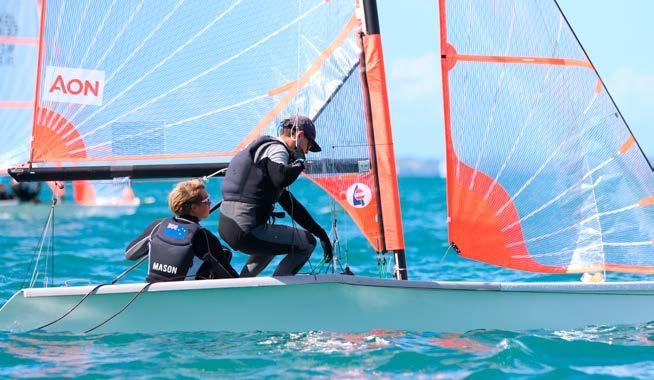
• Dinghy, tender and racing boat insurance
• Overseas regatta and transit insurance
• Travel insurance

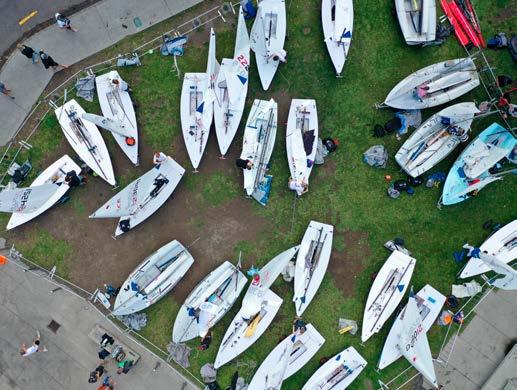
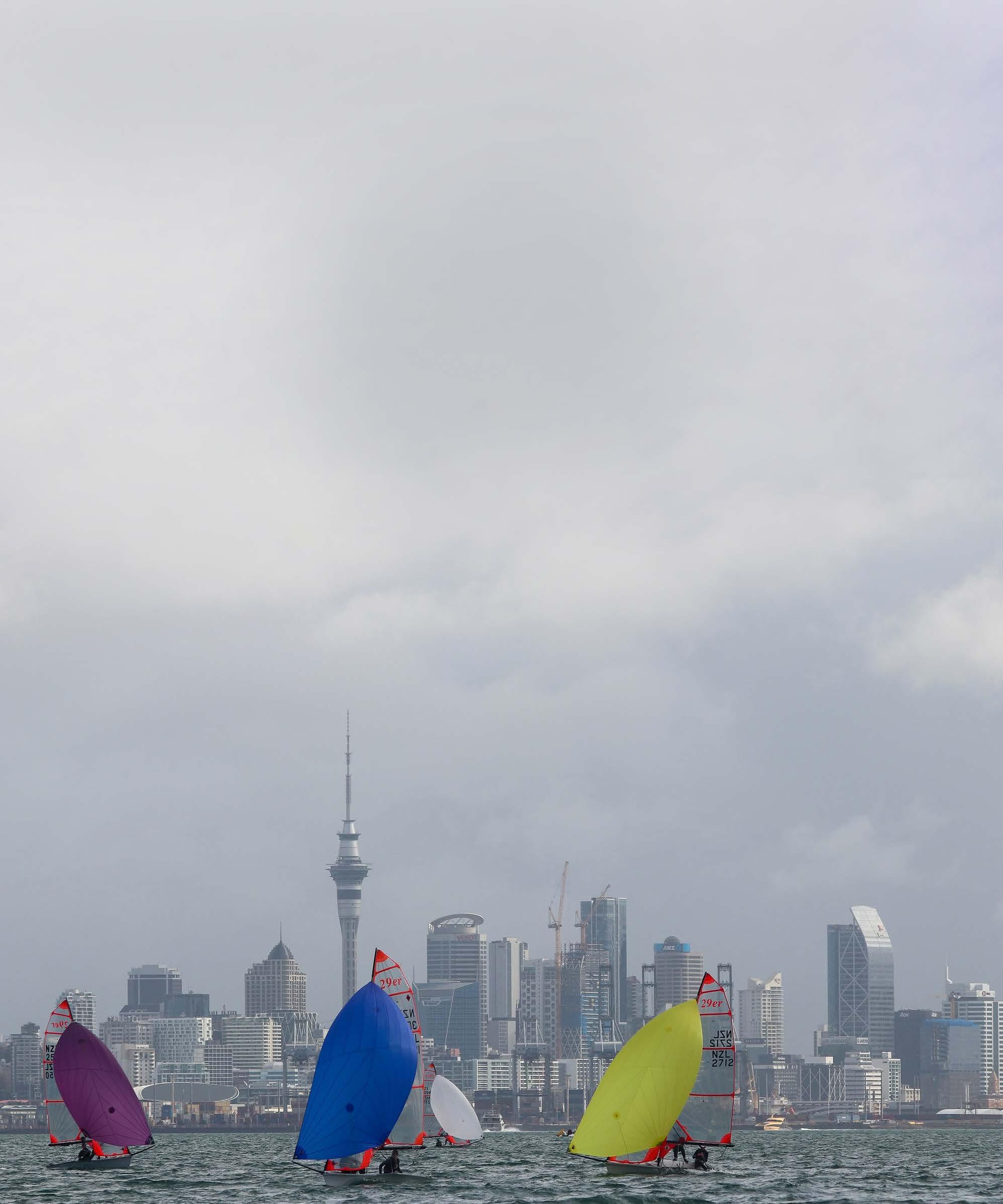
1
The Whangārei Maritime Festival returned on October 12-13 to celebrate the city’s rich maritime history. The festival, now in its second year, once again welcomed the legendary tall ship R. Tucker Thompson. Highlights included displays from the Royal New Zealand Navy, career pathways presented by MAST Academy, discussions on topics like boat building and marine ecology, as well as interactive flare and life raft demonstrations.
2 Marsden Yacht and Boat Club celebrated its 50th anniversary in style last month. Club secretary Warren Daniel said that festivities included a reunion on 27 October, sailing activities, and a celebratory dinner. MYBC was formed in October 1974 when a small group of residents in the Bream Bay area decided to establish a local yacht club. Initially sailing off Marsden Point, the club built its clubhouse near the One Tree Point boat ramp in 1990, where it still stands today.
3 Sandspit Yacht Club provided the perfect setting for the final regatta in the Burnsco Elliott 5.9 Traveller Series over the weekend of October 5-6. A strong turnout ensured competitive racing, with five different boats taking wins across the 10 races. R+R rebounded from a tough first day to edge out Slam Dunk for the overall series title, despite Shapeshifter winning the regatta.
4 Gulf Harbour Yacht Club (below) hosted the World Sailing race management seminar in late September, marking the first time the event had been held in this country in several years.
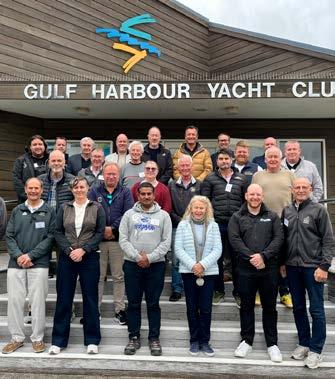
Organised by Yachting New Zealand, the seminar welcomed 23 participants from New Zealand, Australia, and India to advance their race management skills. Led by two highly experienced international race officers, Belgium’s Bruno
De Wannemaeker and Kiwi John Parrish, attendees underwent rigorous training over three days, culminating in the international race officer exam.
5
Wakatere Boating Club officially welcomed two of its newest “members” during the club’s opening day last month. Ngahiwi Walker of the Royal New Zealand Navy led a blessing ceremony for the club’s two new RS Quests, Pia and Ripi (above) The event was followed by two seasonopening points races, with sailors from all classes enjoying refreshing southwest conditions.
6
Bucklands Beach Yacht Club (right) celebrated its 75th anniversary on September 21 with an evening of laughter, memories, and camaraderie. Members and guests, dressed in their finest, gathered to share stories
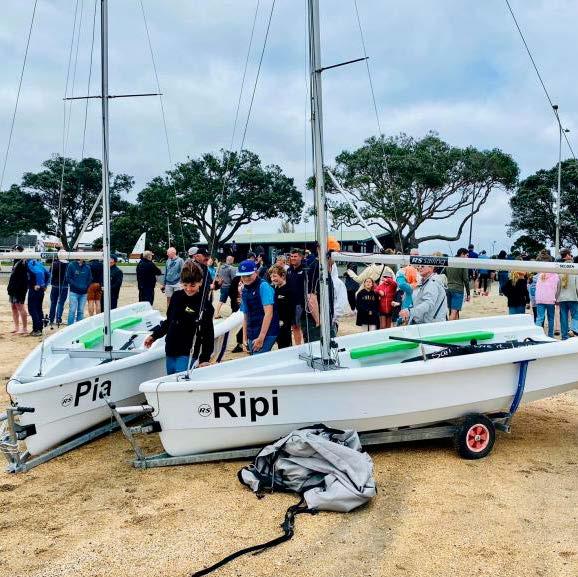
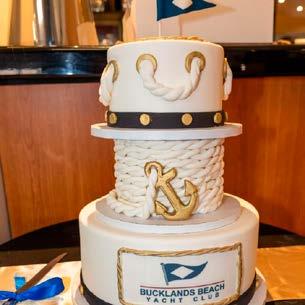
15 16 17 18 19
and reflect on the club’s rich history. In a Facebook post, the club thanked those who had contributed.
7
Glendowie Boating Club hosted 25 P Class sailors (right) for the North Island championships over
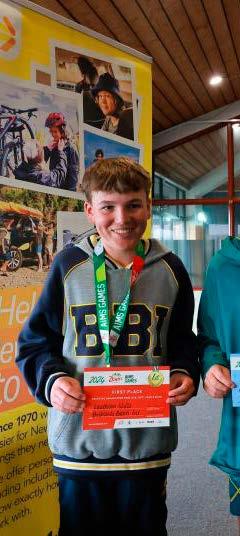
Labour Weekend, including 10 sailors from Kohimarama Yacht Club. Although the first day’s racing was cancelled due to strong northerly winds, conditions improved the following day, allowing six races to take place.
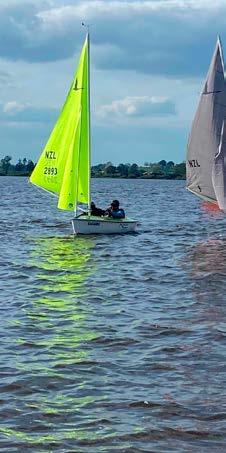
Murrays Bay Sailing Club’s Finloe Gaites took first place with three race wins, followed by Callum Hyde and Arthur Rebbeck. Greta Hutton, ninth overall, was the top female sailor, with Amber Hughes (10th) and Charlotte Handley (11th) close behind.
8
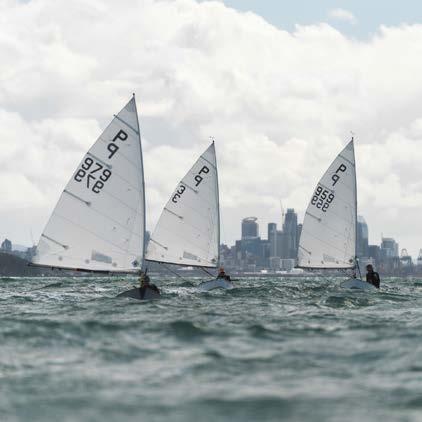
Manukau Yacht and Motorboat Club will host its inaugural two-day trailer yacht regatta on November 16-17. Club commodore Ric Turner said the Burnsco Manukau Trailer Yacht Regatta aims to bring together trailer yachts from five active yacht clubs around Manukau Harbour. With prevailing southwesterly winds, the Wairopa Channel offers well-sheltered, relatively flat water two hours either side of high tide, with excellent viewing from the
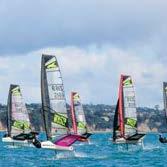
southern shoreline.
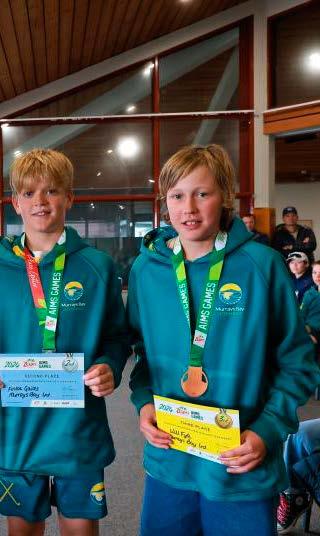
9 Murrays Bay Intermediate was crowned top school at the 2024 Zespri AIMS Games for the third consecutive year, though their sailors were narrowly defeated for the overall win. Bucklands Beach Intermediate’s Lauchlan Wills (left) won the overall title, finishing as the top Year 8 boy at the event hosted by Tauranga Yacht and Powerboat Club last month. Finloe Gaites and Will Fyfe finished second and third overall, securing the AIMS Cup for Murrays Bay Intermediate, while Sofia Turner won the Year 8 girls’ category.
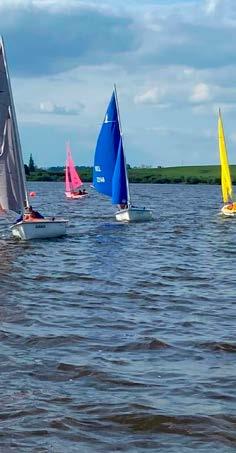
10 The Hansa 303 North Island championships took place at Ngaroto Sailing Club (left) in late October, drawing a strong turnout. Jack Horner from Taranaki won the singles title on countback from Tauranga’s Paulien Chamberlain, while Angus and Richard Bates, also from Tauranga, triumphed in the doubles, winning all their races. The next event is the Hansa Liberty national championships in Auckland from November 8-10.
11
Send your club or class association news to eduan@yachtingnz.org.nz
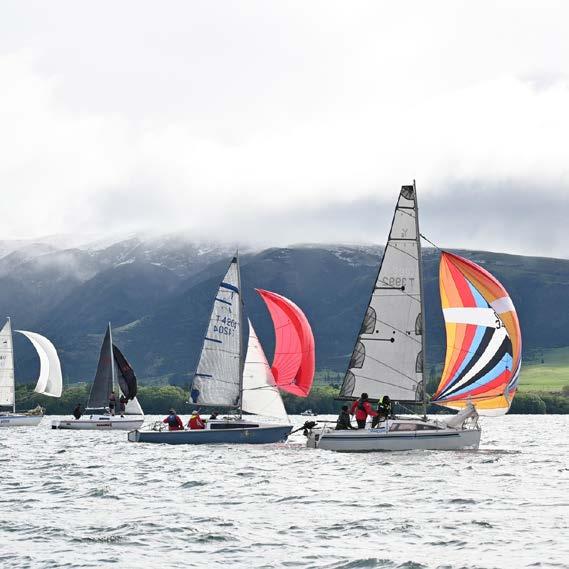
Wingfoil Festival over the weekend of January 31, 2025. The club is seeking enthusiastic volunteers to assist with event setup, race coordination, safety and first aid, and media roles. For more details, contact Dion Mead at dion@outlook.co.nz or Matt Appleby at beerehavensteps@gmail.com
13
The Tasman District Council found Mediterranean fanworm (below) on vessels in Abel Tasman National Park and Port Tarakohe. The infected vessels were treated, with one being wrapped in impermeable plastic to destroy the invasive fanworm.
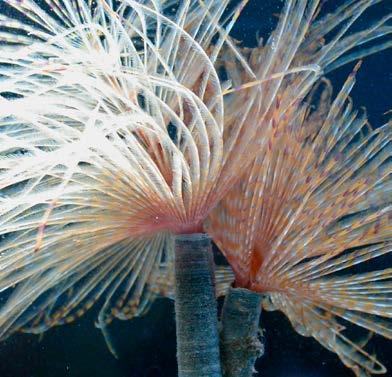
14 Waikawa Boating Club’s Rob Carpenter (bottom) has been shortlisted for the International Maritime Rescue Awards, which highlight excellence in search and rescue. Carpenter also won the Volunteer of the Year and Outstanding Leadership awards at the 2023 Coastguard Awards of Excellence. Winners of the IMR awards will be announced on November 8.
local community members, including young sailors from Lyttelton Primary School, the sculptures will be installed starting late November.
17
The 2024 Trust Aoraki Aviemore Classic concluded with ideal sailing conditions on October 27. Tristan Ornsby took first place on corrected time with Noelex 22 Hardcore Pawn, followed by Jamie Neill on 44 Forty and John Stalker on Unhinged This annual event is hosted by Timaru Yacht and Powerboat Club (top) and attracts competitors from across New Zealand.
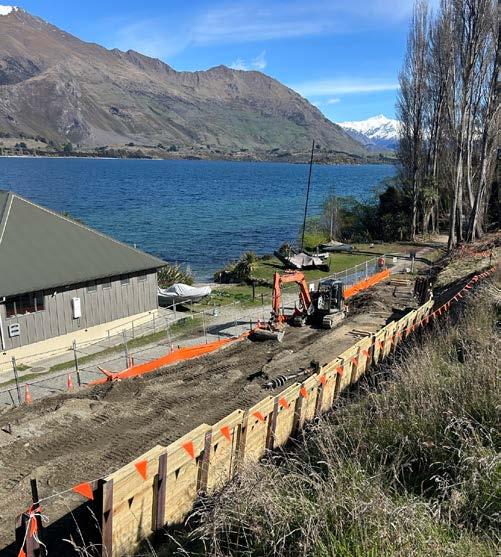
A successful Wellington interclub keelboat series wrapped up last month as Royal Port Nicholson Yacht Club opened its sailing season. A great race in 10-15 knots of breeze and sunshine concluded the series, which featured boats also competing in earlier rounds at Evans Bay Yacht and Motorboat Club and Lowry Bay Yacht Club
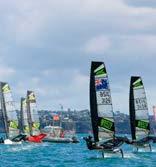
12 Worser Bay Boating Club (left) will incorporate the 2025 Waszp North Island Championships with the inaugural Wellington
15 The Canterbury Yachting Association hosted a well-received race officials forum in September, gathering officials from across the region. Facilitated by Ross May and supported by Yachting New Zealand, the event focused on skill refreshment and recent rule changes through interactive mock trials and scenario practice.
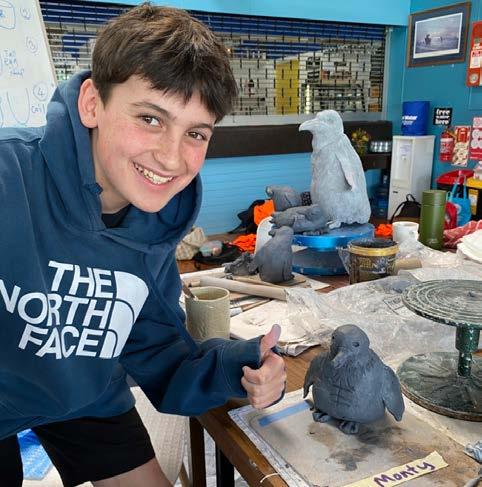

16 Naval Point Club Lyttelton (above right) is spearheading a community art installation of over 100 ceramic kororā (white-flippered penguins) along the rocky ocean wall. Created by
18 Stage five of the foreshore redevelopment project near Wānaka Yacht Club (right) is set to be completed this week, promises to end yacht parking disruptions. The project includes a new retaining wall, and public access is expected to be reinstated by November 8.
19 Marakura Yacht Club (below) has had a busy month, with a boat operator course led by instructor Verity Lawrence covering essential skills like launching and on-water manoeuvres. A dinghy coaching session with Erik Stibbe also saw 13 sailors of all levels honing their skills.
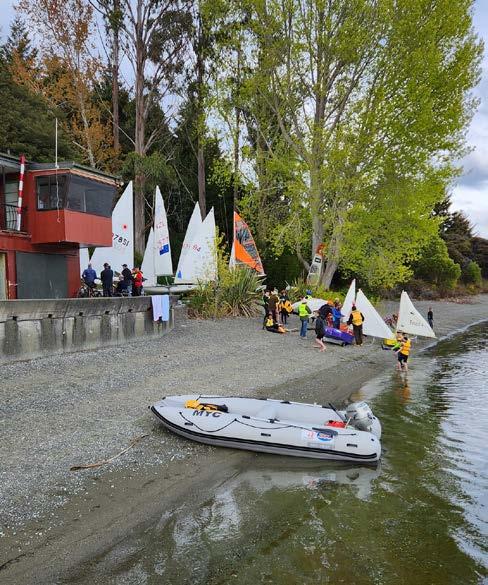
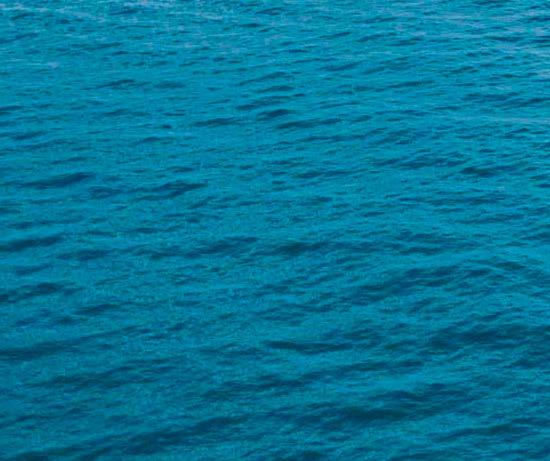
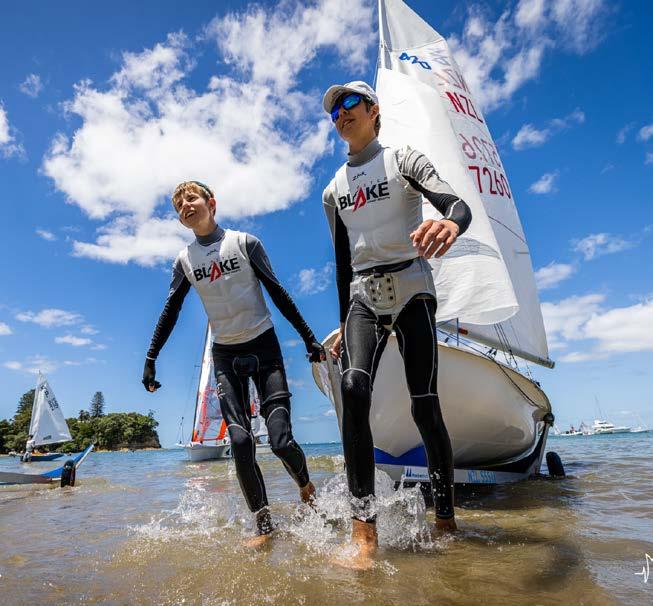
Hansa Liberty national championships
Royal Akarana Yacht Club
November 7-10
NZ match racing championship
Royal New Zealand Yacht Squadron
November 13-17
Starling Traveller Series
Wānaka Yacht Club
November 16-17
Manukau Trailer Yacht Regatta
Manukau Yacht and Motorboat Club
November 16-17
Europe Dinghy national championship Napier Sailing Club
November 22-24
Double Trouble Multihull Regatta
Mercury Bay Boating Club
November 23-24
Sir Peter Blake Regatta
Torbay Sailing Club
November 29-December 1
Nelson & Marlborough regional championships
Nelson Yacht Club
November 30-December 1
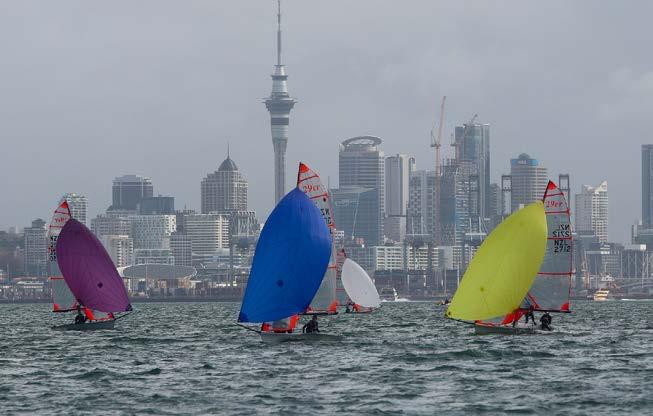
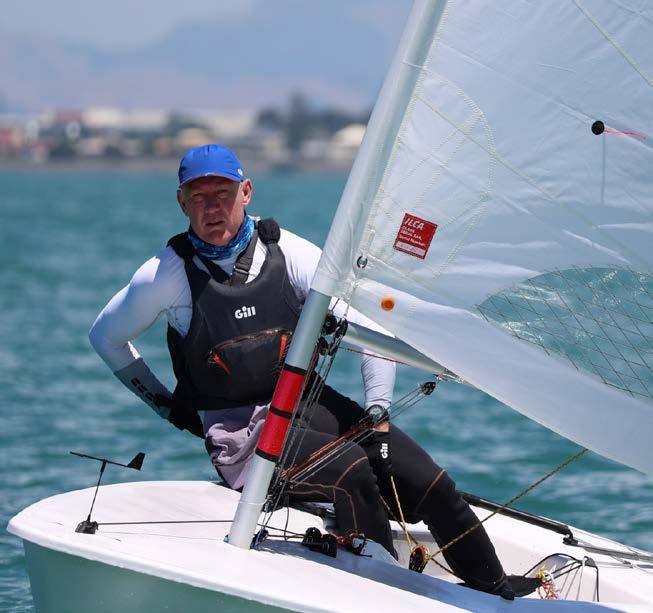
Auckland P Class trials
Kohimarama Yacht Club
December 7-8
Moth world championships
Manly Sailing Club
December 30-January 9
Tanner Cup Charteris Bay Yacht Club
January 6-8
ILCA national championships
Nelson Yacht Club
January 15-19
Nelson Regatta
Tasman Bay Cruising Club
January 17-21
29er Auckland championships
Kohimarama Yacht Club
January 25-27
Auckland Anniversary Day Regatta
Auckland
January 27
Hartley 16 national championships
New Plymouth Yacht Club
January 30-February 1
Noelex 22 national championships
New Plymouth Yacht Club
January 30-February 1
OK Dinghy and Paper Tiger national championships
Queen Charlotte Yacht Club
February 5-8
Starling match racing nationals
Glendowie Boating Club
February 6-9

Flying Dutchman national championships
Nelson Yacht Club
February 7-9
Noelex 25 national championships
Naval Point Club Lyttelton
February 7-9
Junior Sail Auckland Kohimarama Yacht Club
February 15-16
A-Class catamaran and Tornado national championships Milford Cruising Club
February 20-23
FOIL Bay of Islands Bay of Islands Yacht Club
February 20-23
Tauranga Centreboard Regatta Tauranga Yacht and Powerboat Club
February 22-23
O’pen Skiff national championships Plimmerton Boating Club February 27-March 2
Oceanbridge Sail Auckland Torbay Sailing Club
February 28-March 2
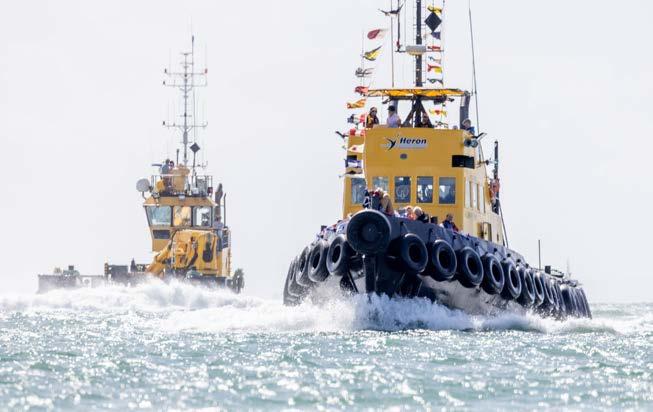

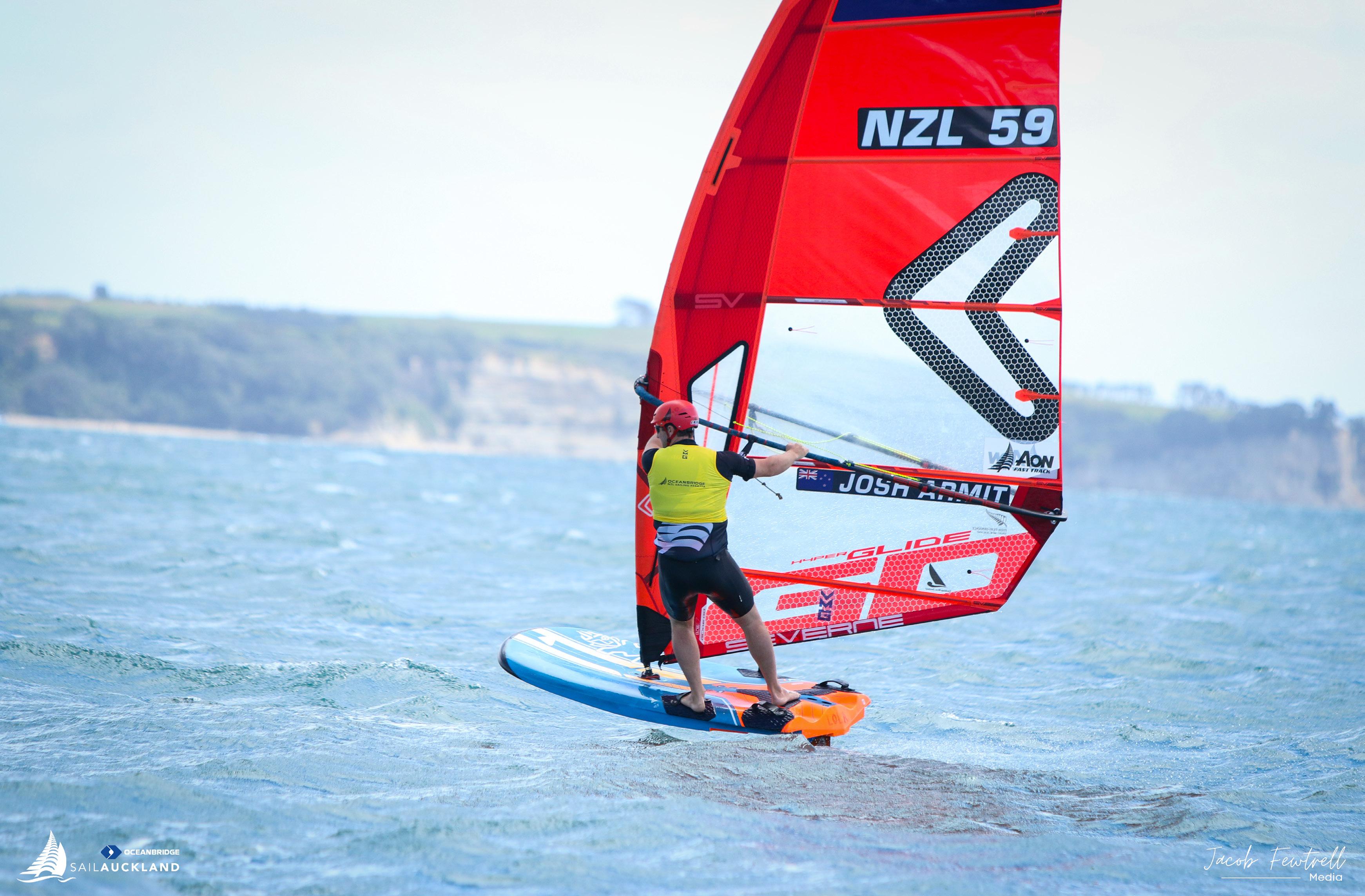


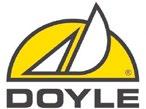
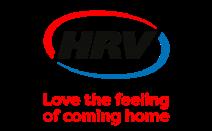
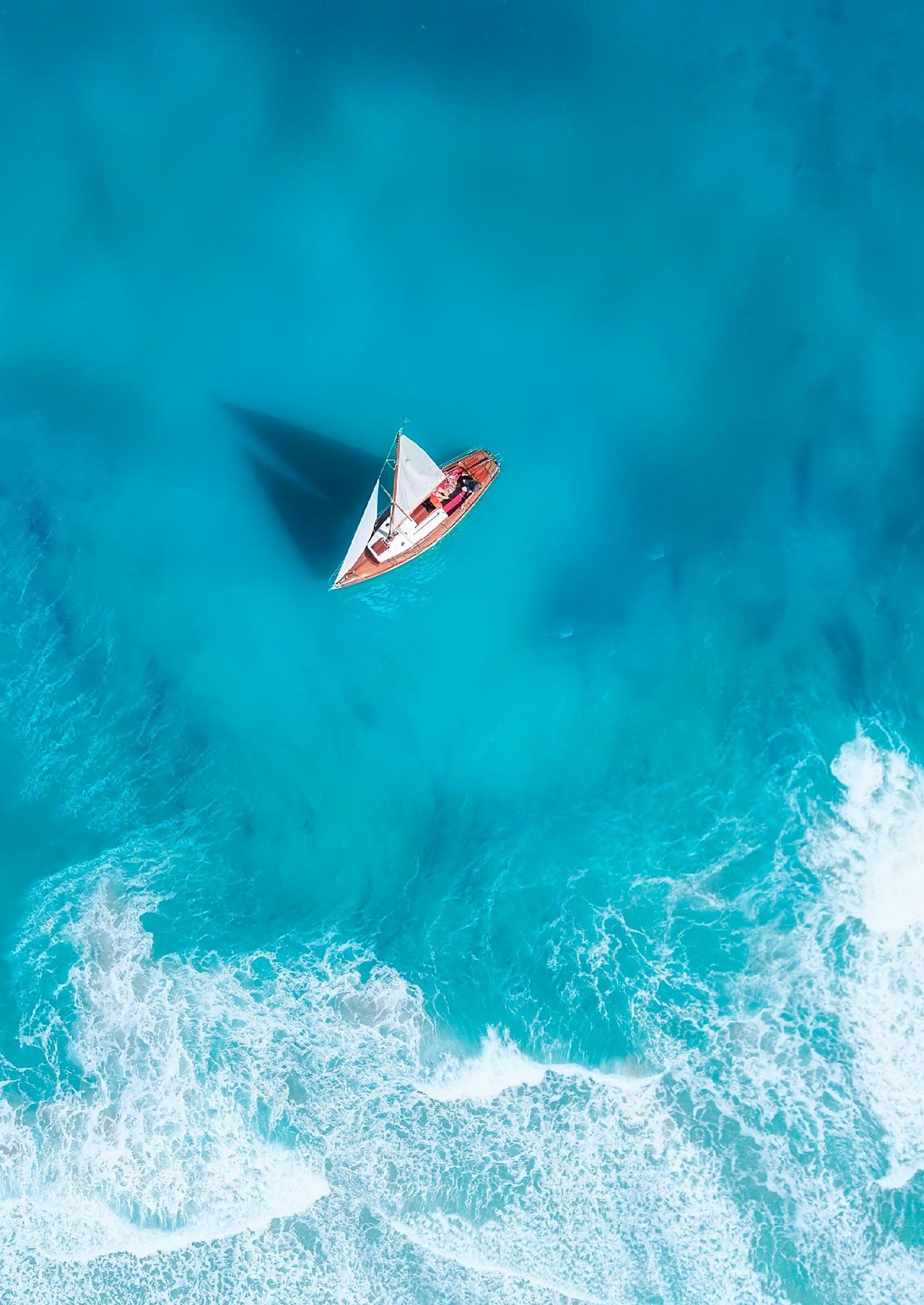
Click on the logo for the latest exclusive member benefits from Yachting New Zealand’s partners.

